Publications

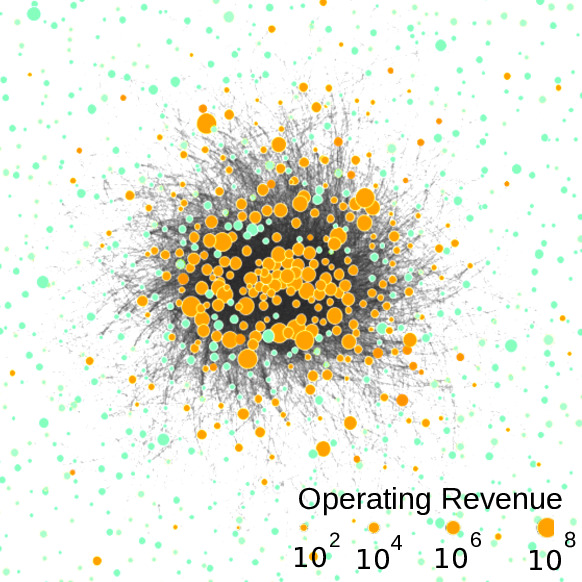
Quantifying the importance of firms by means of reputation and network control
|
[2021]
|
|
Zhang, Yan;
Schweitzer, Frank
|
Frontiers in Big Data,
pages: (submitted),
volume: XXX
|
more» «less
|
Abstract
The reputation of firms is largely channeled through their ownership structure. We use this relation to determine reputation spillovers between transnational companies and their participated companies in an ownership network core of 1318 firms. We then apply concepts of network controllability to identify minimum sets of driver nodes (MDS) of 314 firms in this network. The importance of these driver nodes is classified regarding their control contribution, their operating revenue, and their reputation. The latter two are also taken as proxies for the access costs when utilizing firms as driver nodes. Using an enrichment analysis, we find that firms with high reputation maintain the controllability of the network, but rarely become top drivers, whereas firms with medium reputation most likely become top driver nodes. We further show that MDSs with lower access costs can be used to control the reputation dynamics in the whole network.


Should the government reward cooperation? Insights from an agent-based model of wealth redistribution
|
[2021]
|
|
Schweitzer, Frank;
Verginer, Luca;
Vaccario, Giacomo
|
Advances in Complex Systems,
pages: (submitted),
volume: XXX
|
more» «less
|
Abstract
In our multi-agent model agents generate wealth from repeated interactions for which a prisoner's dilemma payoff matrix is assumed. Their gains are taxed by a government at a rate α. The resulting budget is spent to cover administrative costs and to pay a bonus to cooperative agents, which can be identified correctly only with a probability p. Agents decide at each time step to choose either cooperation or defection based on different information. In the local scenario, they compare their potential gains from both strategies. In the global scenario, they compare the gains of the cooperative and defective subpopulations. We derive analytical expressions for the critical bonus needed to make cooperation as attractive as defection. We show that for the local scenario the government can establish only a medium level of cooperation, because the critical bonus increases with the level of cooperation. In the global scenario instead full cooperation can be achieved once the cold-start problem is solved, because the critical bonus decreases with the level of cooperation. This allows to lower the tax rate, while maintaining high cooperation.

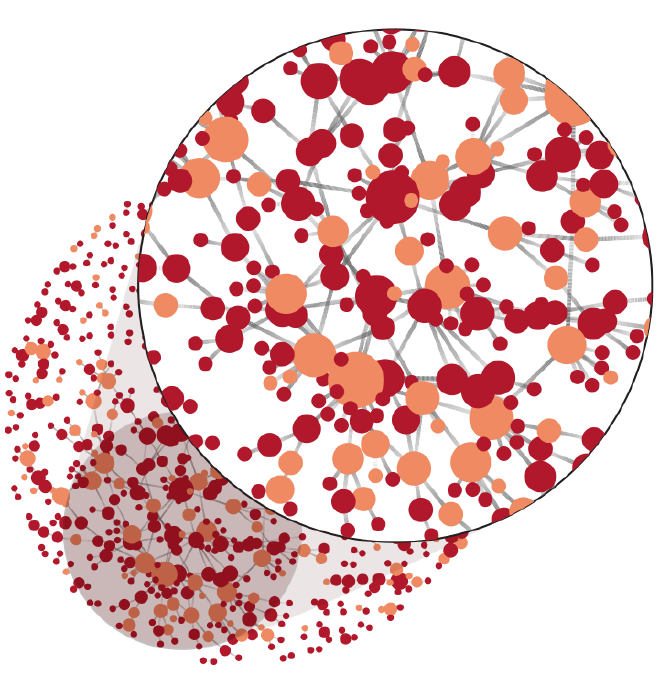
Fragile, yet resilient: Adaptive decline in a collaboration network of firms
|
[2021]
|
|
Schweitzer, Frank;
Casiraghi, Giona;
Tomasello, Mario Vincenzo;
Garcia, David
|
Frontiers in Applied Mathematics,
pages: 634006,
volume: 7
|
more» «less
|
Abstract
The dynamics of collaboration networks of firms follow a life-cycle of growth and decline. That does not imply they also become less resilient. Instead, declining collaboration networks may still have the ability to mitigate shocks from firms leaving, and to recover from these losses by adapting to new partners. To demonstrate this, we analyze 21.500 R&D collaborations of 14.500 firms in six different industrial sectors over 25 years. We calculate time-dependent probabilities of firms leaving the network and simulate drop-out cascades, to determine the expected dynamics of decline. We then show that deviations from these expectations result from the adaptivity of the network, which mitigates the decline. These deviations can be used as a measure of network resilience.


Higher-order models capture changes in controllability of temporal networks
|
[2021]
|
|
Zhang, Yan;
Garas, Antonios;
Scholtes, Ingo
|
Journal of Physics: Complexity,
pages: 015007,
volume: 2
|
more» «less
|
Abstract
In many complex systems, elements interact via time-varying network topologies.Recent research shows that temporal correlations in the chronological ordering of interactions crucially influence network properties and dynamical processes.How these correlations affect our ability to control systems with time-varying interactions remains unclear. In this work, we use higher-order network models to extend the framework of structural controllability to temporal networks, where the chronological ordering of interactions gives rise to time-respecting paths with non-Markovian characteristics.We study six empirical data sets and show that non-Markovian characteristics of real systems can both increase or decrease the minimum time needed to control the whole system.With both empirical data and synthetic models, we further show that spectral properties of generalisations of graph Laplacians to higher-order networks can be used to analytically capture the effect of temporal correlations on controllability. Our work highlights that (i) correlations in the chronological ordering of interactions are an important source of complexity that significantly influences the controllability of temporal networks, and (ii) higher-order network models are a powerful tool to understand the temporal-topological characteristics of empirical systems.

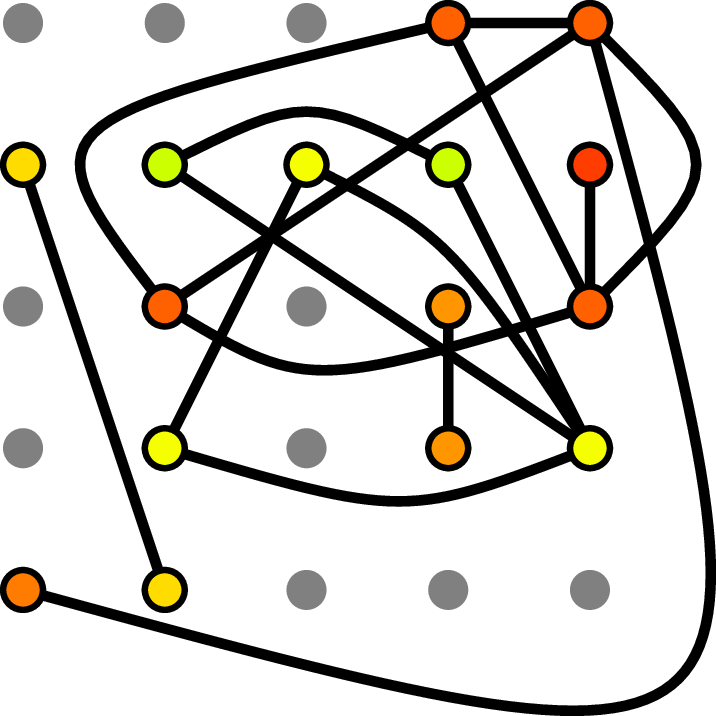
Social percolation revisited: From 2d lattices to adaptive network
|
[2021]
|
|
Schweitzer, Frank
|
Physica A,
pages: 125687,
volume: 570
|
more» «less
|
Abstract
The social percolation model (Solomon et al., 2000} considers a 2-dimensional regular lattice. Each site is occupied by an agent with a preference $x_{i}$ sampled from a uniform distribution $U[0,1]$. Agents transfer the information about the quality $q$ of a movie to their neighbors only if $x_{i}\leq q$. Information percolates through the lattice if $q=q_{c}=0.593$. -- From a network perspective the percolating cluster can be seen as a random-regular network with $n_{c}$ nodes and a mean degree that depends on $q_{c}$. Preserving these quantities of the random-regular network, a true random network can be generated from the $G(n,p)$ model after determining the link probability $p$. I then demonstrate how this random network can be transformed into a threshold network, where agents create links dependent on their $x_{i}$ values. Assuming a dynamics of the $x_{i}$ and a mechanism of group formation, I further extend the model toward an adaptive social network model.

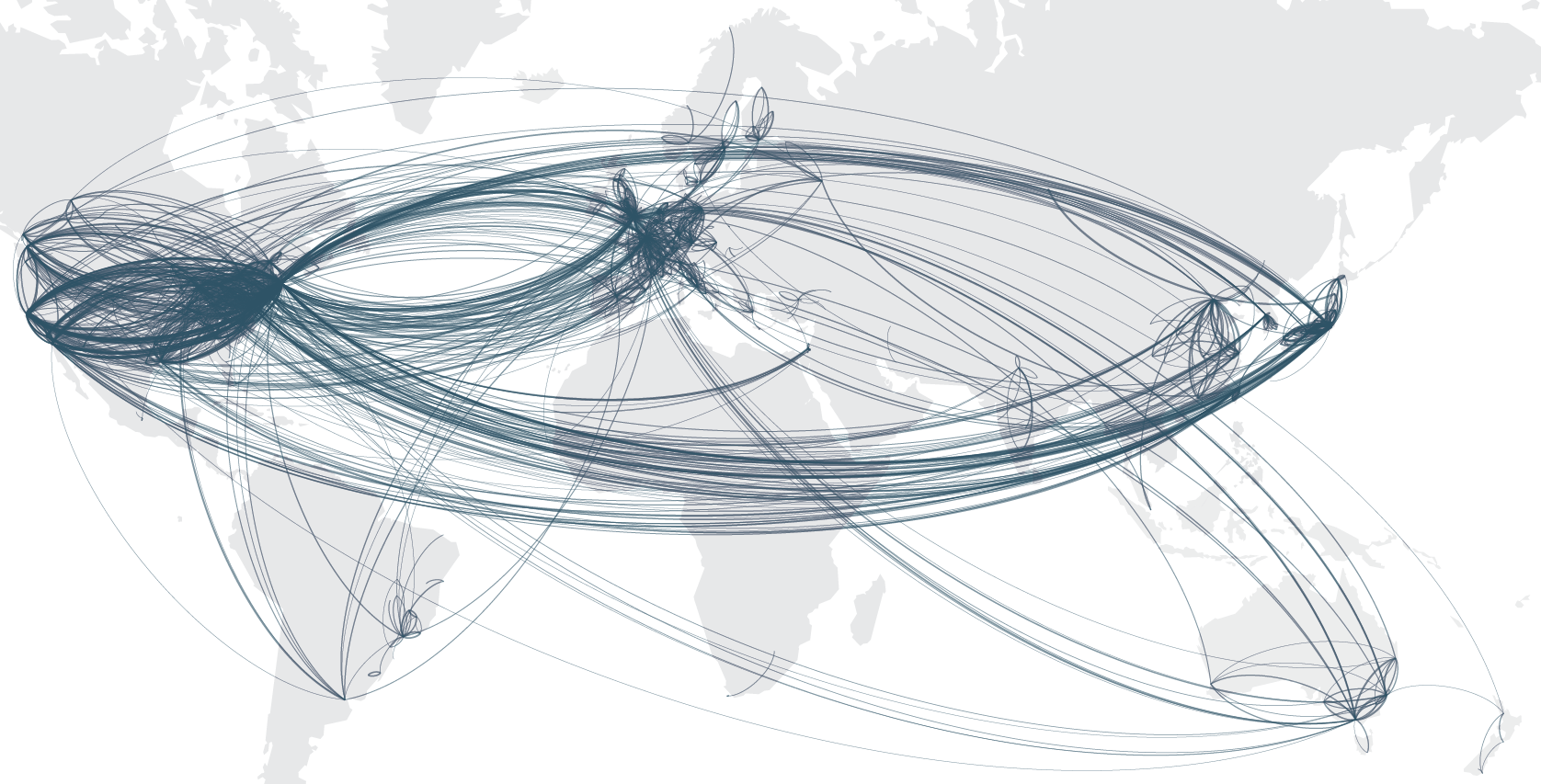
Talent Goes to Global Cities: The World Network of Scientists’ Mobility
|
[2021]
|
|
Verginer, Luca;
Riccaboni, Massimo
|
Research Policy,
pages: 104127,
volume: 50,
number: 1
|
more» «less
|
Abstract
Global cities boast higher rates of innovation as measured through patent and scientific production. However, the source of the location advantage of innovation hubs is still debated in the literature, with arguments ranging from localized knowledge spillovers to network effects. Thanks to an extensive data set of individual scientist career paths, we shed new light on the role of scientist location choices in determining the superior innovative performance of global cities. We analyze the career paths of around two million researchers over a decade across more than two thousand cities around the globe. First, we show that scientists active in global cities are more productive in terms of citation weighted publications. We then show that this superior performance is in part driven by highly prolific scientists moving and remaining preferentially in global cities, i.e., central cities in the international scientist mobility network. The overall picture that emerges is that global cities are better positioned to attract and retain prolific scientists than more peripheral cities.


Quantifying individual influence in leading-following behavior of Bechstein's bats
|
[2021]
|
|
Mavrodiev, Pavlin;
Fleischmann, Daniela;
Kerth, Gerald;
Schweitzer, Frank
|
Scientific Reports,
volume: 11
|
more» «less
|
Abstract
Leading-following behavior as a way of transferring information about the location of resources is widespread in different animal societies. However, it cannot always be observed directly. Here, we develop a general method to infer leading-following events from observational data if only the discrete appearance of individuals is recorded. Our method further allows to distinguish such events from local enhancement at the resource, such as swarming behavior in case of bats, which is another widespread way of transferring information among animals. To test our methodology, we analyze longitudinal data about the roosting behavior of Bechstein's bats from two different colonies and different years. The detection of leading-following events allows us, in a second step, to construct social networks in which nodes represent individual bats and directed and weighted links the leading-following events. We analyze the topology of these networks on the level of the colony, to see whether all individuals participate in leading-following behavior. Further, based on the leading-following network we measure the importance of individuals in this leading-following behavior by calculating different centrality measures. We find that individuals can be consistently ranked regarding their influence on others. Moreover, we identify a small set of individuals that play a central role in leading other bats to roosts. Our methodology can be used to understand the leading-following behavior and the individual impact of group members on the spread of information in animal groups in general.

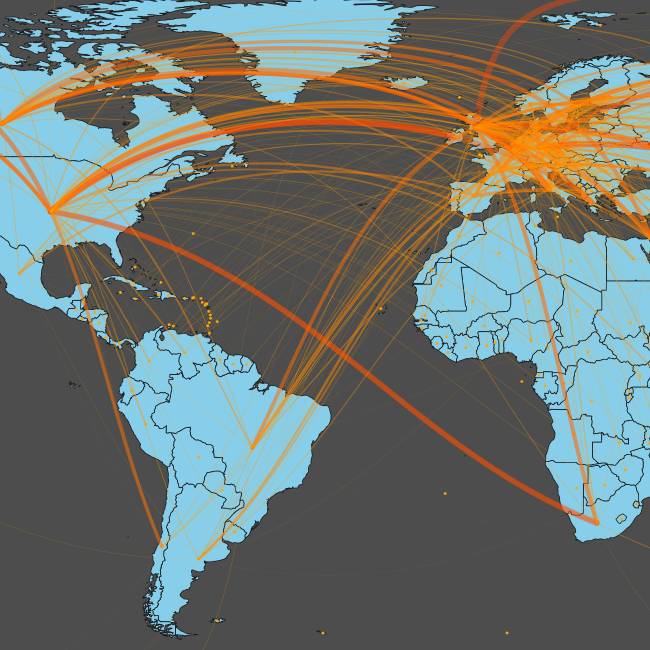
Reproducing scientists' mobility: A data-driven model
|
[2020]
|
|
Vaccario, Giacomo;
Luca, Verginer;
Schweitzer, Frank
|
arXiv:1811.07229
|
more» «less
|
Abstract
High skill labour is an important factor underpinning the competitive advantage of modern economies. Therefore, attracting and retaining scientists has become a major concern for migration policy. In this work, we study the migration of scientists on a global scale, by combining two large data sets covering the publications of 3.5 Mio scientists over 60 years. We analyse their geographical distances moved for a new affiliation and their age when moving, this way reconstructing their geographical ``career paths''. These paths are used to derive the world network of scientists mobility between cities and to analyse its topological properties. We further develop and calibrate an agent-based model, such that it reproduces the empirical findings both at the level of scientists and of the global network. Our model takes into account that the academic hiring process is largely demand-driven and demonstrates that
the probability of scientists to relocate decreases both with age and with distance. Our results allow interpreting the model assumptions as micro-based decision rules that can explain the observed mobility patterns of scientists.


Enhanced or distorted wisdom of crowds? An agent-based model of opinion formation under social influence
|
[2020]
|
|
Mavrodiev, Pavlin;
Schweitzer, Frank
|
Swarm Intelligence,
pages: (submitted),
volume: xx
|
more» «less
|
Abstract
We propose an agent-based model of collective opinion formation to study the wisdom of crowds under social influence. The opinion of an agent is a continuous positive value, denoting its subjective answer to a factual question. The wisdom of crowds states that the average of all opinions is close to the truth, i.e. the correct answer. But if agents have the chance to adjust their opinion in response to the opinions of others, this effect can be destroyed. Our model investigates this scenario by evaluating two competing effects: (i) agents tend to keep their own opinion (individual conviction β), (ii) they tend to adjust their opinion if they have information about the opinions of others (social influence α). For the latter, two different regimes (full information vs. aggregated information) are compared. Our simulations show that social influence only in rare cases enhances the wisdom of crowds. Most often, we find that agents converge to a collective opinion that is even farther away from the true answer. So, under social influence the wisdom of crowds can be systematically wrong.

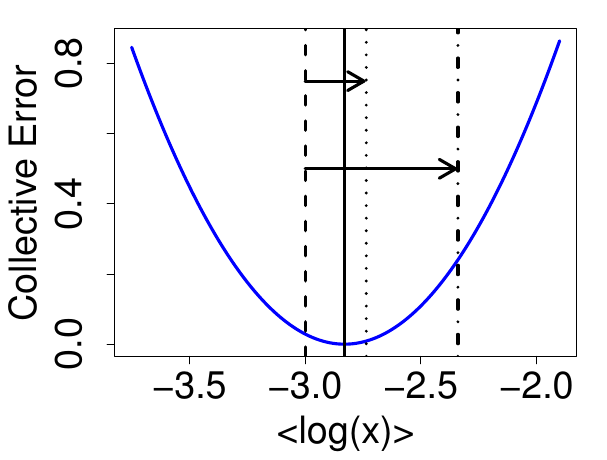
The ambiguous role of social influence on the wisdom of crowds: An analytic approach
|
[2020]
|
|
Mavrodiev, Pavlin;
Schweitzer, Frank
|
Physica A: Statistical Mechanics and its Applications,
pages: 125624
|
more» «less
|
Abstract
"Wisdom of crowds" refers to the phenomenon that the average opinion of a group of individuals on a given question can be very close to the true answer. It requires a large group diversity of opinions, but the collective error, the difference between the average opinion and the true value, has to be small. We consider a stochastic opinion dynamics where individuals can change their opinion based on the opinions of others (social influence α), but to some degree also stick to their initial opinion (individual conviction β). We then derive analytic expressions for the dynamics of the collective error and the group diversity. We analyze their long-term behavior to determine the impact of the two parameters (α,β) and the initial opinion distribution on the wisdom of crowds. This allows us to quantify the ambiguous role of social influence: only if the initial collective error is large, it helps to improve the wisdom of crowds, but in most cases it deteriorates the outcome. In these cases, individual conviction still improves the wisdom of crowds because it mitigates the impact of social influence.

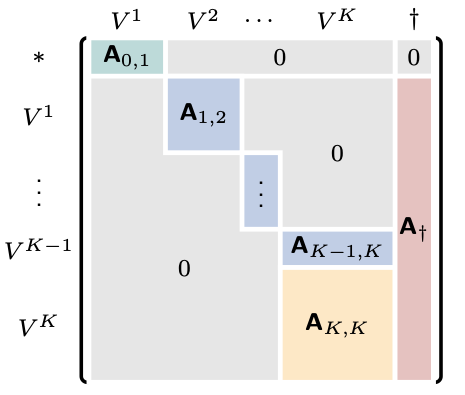
Predicting Sequences of Traversed Nodes in Graphs using Network Models with Multiple Higher Orders
|
[2020]
|
|
Gote, Christoph;
Casiraghi, Giona;
Schweitzer, Frank;
Scholtes, Ingo
|
arXiv preprint arXiv:2007.06662
|
more» «less
|
Abstract
We propose a novel sequence prediction method for sequential data capturing node traversals in graphs. Our method builds on a statistical modelling framework that combines multiple higher-order network models into a single multi-order model. We develop a technique to fit such multi-order models in empirical sequential data and to select the optimal maximum order. Our framework facilitates both next-element and full sequence prediction given a sequence-prefix of any length. We evaluate our model based on six empirical data sets containing sequences from website navigation as well as public transport systems. The results show that our method out-performs state-of-the-art algorithms for next-element prediction. We further demonstrate the accuracy of our method during out-of-sample sequence prediction and validate that our method can scale to data sets with millions of sequences.

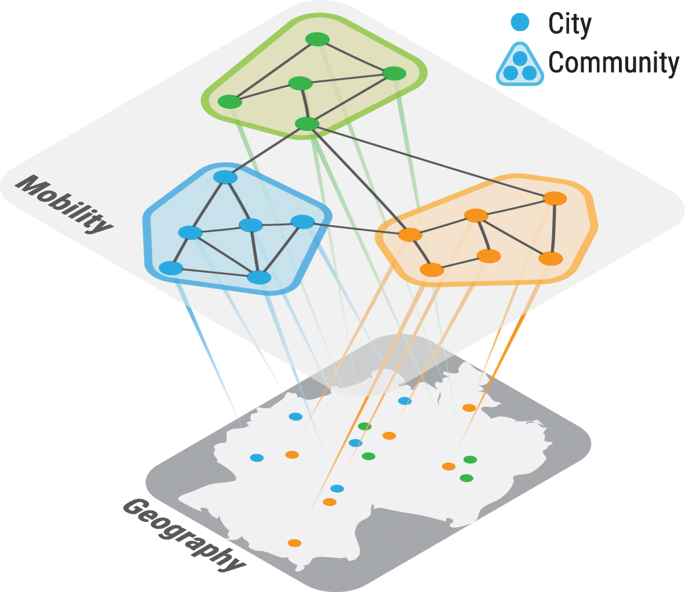
Cities and countries in the global scientist mobility network
|
[2020]
|
|
Verginer, Luca;
Riccaboni, Massimo
|
Applied Network Science,
pages: 38,
volume: 5,
number: 1
|
more» «less
|
Abstract
Global mobility and migration of scientists is an important modern phenomenon with economic and political implications. As scientists become ever more footloose it is important to identify general patterns and regularities at a global scale and how it impacts a country's scientific output. The analysis of mobility and brain circulation patterns at global scale remains challenging, due to difficulties in obtaining individual level mobility data. In this work we trace intercity and international mobility through bibliographic records. We reconstruct the intercity and international mobility network of 3.7 million life scientists moving between 5 thousand cities and 189 Countries. In this exploratory analysis we offer evidence that international scientist mobility is marked by national borders and show that international mobility boosts the scientific output of selected countries.

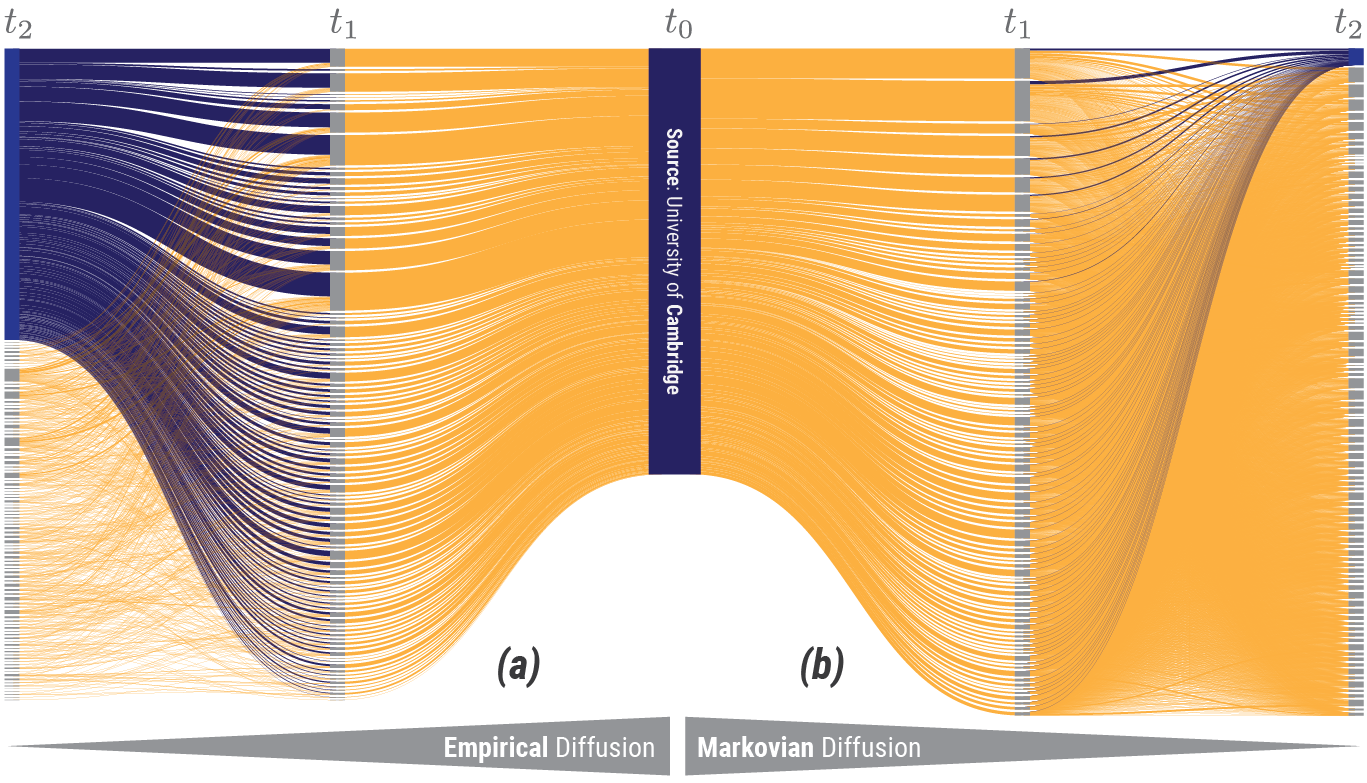
The mobility network of scientists: Analyzing temporal correlations in scientific careers
|
[2020]
|
|
Vaccario, Giacomo;
Verginer, Luca;
Schweitzer, Frank
|
Applied Network Science,
pages: 36,
volume: 5,
number: 1
|
more» «less
|
Abstract
The mobility of scientists between different universities and countries is important to foster knowledge exchange. At the same time, the potential mobility is restricted by geographic and institutional constraints, which leads to temporal correlations in the career trajectories of scientists. To quantify this effect, we extract 3.5 million career trajectories of scientists from two large scale bibliographic data sets and analyze them applying a novel method of higher-order networks. We study the effect of temporal correlations at three different levels of aggregation, universities, cities and countries. We find strong evidence for such correlations for the top 100 universities, i.e. scientists move likely between specific institutions. These correlations also exist at the level of countries, but cannot be found for cities. Our results allow to draw conclusions about the institutional path dependence of scientific careers and the efficiency of mobility programs.

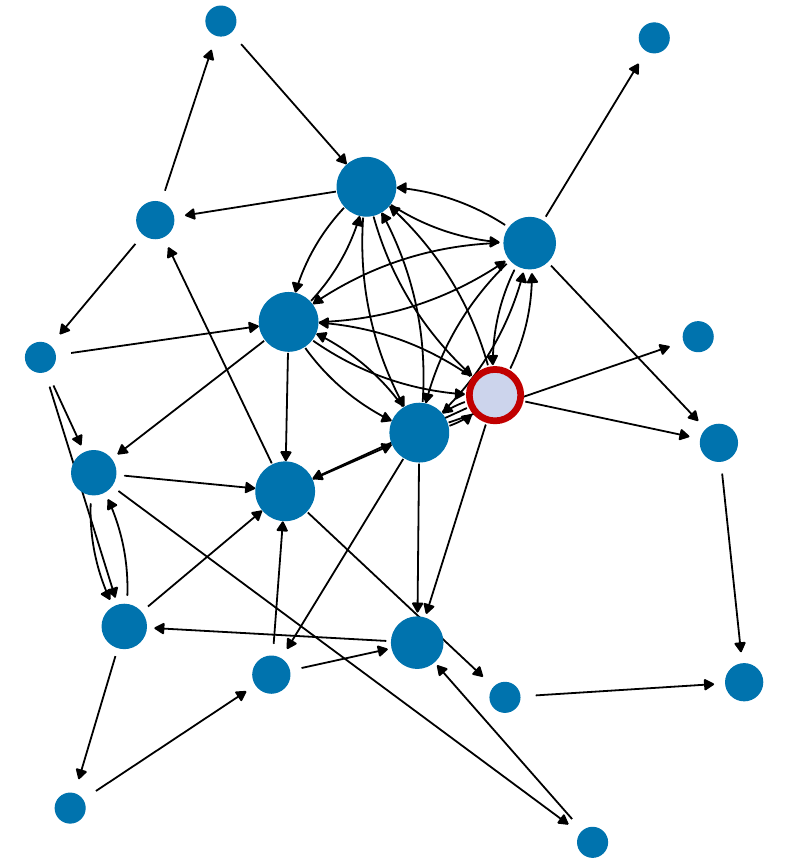
Intervention scenarios to enhance knowledge transfer in a network of firms
|
[2020]
|
|
Casiraghi, Giona;
Schweitzer, Frank;
Zhang, Yan
|
Frontiers in Physics,
pages: 382,
volume: 8
|
more» «less
|
Abstract
We investigate a multi-agent model of firms in a Research & Development (R&D) network. Each firm is characterized by its knowledge stock xi(t), which follows a non-linear dynamics. xi(t) grows with the input from other firms, i.e., by knowledge transfer, and decays otherwise. However, maintaining the interactions that increase knowledge stock is costly for all partners involved. Because of this, firms leave the network whenever their expected knowledge growth is not realized. This, in turn, may cause other firms also to leave the network. The paper discusses two bottom-up intervention scenarios to prevent, reduce, or delay such cascades of firms leaving. The first one is based on the formalism of network controllability, in which driver nodes are identified and subsequently incentivized, by reducing their costs. The second one combines node interventions and network interventions. It proposes the controlled removal of a single firm and the random replacement of firms leaving. This allows to generate small cascades, which prevents the occurrence of large cascades. We find that both approaches successfully mitigate cascades and thus improve the resilience of the R&D network.


An agent-based model of multi-dimensional opinion dynamics and opinion alignment
|
[2020]
|
|
Schweighofer, Simon;
Garcia, David;
Schweitzer, Frank
|
Chaos,
volume: 30,
number: 9
|
more» «less
|
Abstract
It is known that individual opinions on different policy issues often align to a dominant ideological dimension (e.g. ``left'' vs. ``right'') and become increasingly polarized. We provide an agent-based model that reproduces these two stylized facts as emergent properties of an opinion dynamics in a multi-dimensional space of continuous opinions. The mechanisms for the change of agents' opinions in this multi-dimensional space are derived from cognitive dissonance theory and structural balance theory. We test assumptions from proximity voting and from directional voting regarding their ability to reproduce the expected emerging properties. We further study how the emotional involvement of agents, i.e. their individual resistance to change opinions, impacts the dynamics. We identify two regimes for the global and the individual alignment of opinions. If the affective involvement is high and shows a large variance across agents, this fosters the emergence of a dominant ideological dimension. Agents align their opinions along this dimension in opposite directions, i.e. create a state of polarization.

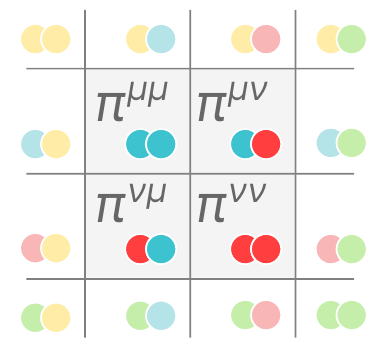
Multi-layer network approach to modelling authorship influence on citation dynamics in physics journals
|
[2020]
|
|
Schweitzer, Frank;
Nanumyan, Vahan;
Gote, Christoph
|
Physical Review E,
pages: 032303,
volume: 102,
number: 3
|
more» «less
|
Abstract
We provide a general framework to model the growth of networks consisting of different coupled layers. Our aim is to estimate the impact of one such layer on the dynamics of the others. As an application, we study a scientometric network, where one layer consists of publications as nodes and citations as links, whereas the second layer represents the authors. This allows to address the question how characteristics of authors, such as their number of publications or number of previous co-authors, impacts the citation dynamics of a new publication. To test different hypotheses about this impact, our model combines citation constituents and social constituents in different ways. We then evaluate their performance in reproducing the citation dynamics in nine different physics journals. For this, we develop a general method for statistical parameter estimation and model selection that is applicable to growing multi-layer networks. It takes both the parameter errors and the model complexity into account and is computationally efficient and scalable to large networks.
HYPA: Efficient Detection of Path Anomalies in Time Series Data on Networks
|
[2020]
|
|
LaRock, Timothy;
Nanumyan, Vahan;
Scholtes, Ingo;
Casiraghi, Giona;
Eliassi - Rad, Tina;
Schweitzer, Frank
|
SIAM International Conference on Data Mining,
pages: 460-468
|
more» «less
|
Abstract
The unsupervised detection of anomalies in time series data has important applications in user behavioral modeling, fraud detection, and cybersecurity. Anomaly detection has, in fact, been extensively studied in categorical sequences. However, we often have access to time series data that represent paths through networks. Examples include transaction sequences in financial networks, click streams of users in networks of cross-referenced documents, or travel itineraries in transportation networks. To reliably detect anomalies, we must account for the fact that such data contain a large number of independent observations of paths constrained by a graph topology. Moreover, the heterogeneity of real systems rules out frequency-based anomaly detection techniques, which do not account for highly skewed edge and degree statistics. To address this problem, we introduce HYPA, a novel framework for the unsupervised detection of anomalies in large corpora of variable-length temporal paths in a graph. HYPA provides an efficient analytical method to detect paths with anomalous frequencies that result from nodes being traversed in unexpected chronological order.

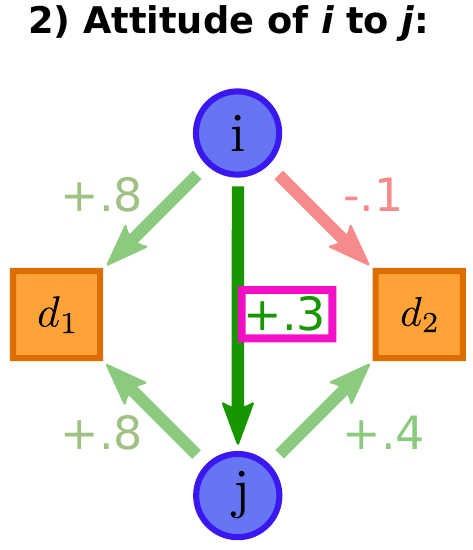
A Weighted Balance Model of Opinion Hyperpolarization
|
[2020]
|
|
Schweighofer, Simon;
Schweitzer, Frank;
Garcia, David
|
Journal of Artificial Societies and Social Simulation,
volume: 23,
number: 3
|
more» «less
|
Abstract
Polarization is threatening the stability of democratic societies. Until now, polarization research has focused on opinion extremeness, overlooking the correlation between different policy issues. We explain the emergence of hyperpolarization, i.e. the combination of extremeness and correlation between issues, by developing Weighted Balance Theory (WBT), a new theory of opinion formation. WBT extends Heider’s cognitive balance theory to encompass multiple weighted attitudes. We validate WBT on empirical data from the 2016 National Election Survey. Furthermore, we develop an opinion dynamics model based on WBT, which, for the first time, is able to generate hyperpolarization and to explain the link between affective and opinion polarization. In addition, our theory encompasses other phenomena of opinion dynamics, including mono-polarization and backfire effects.

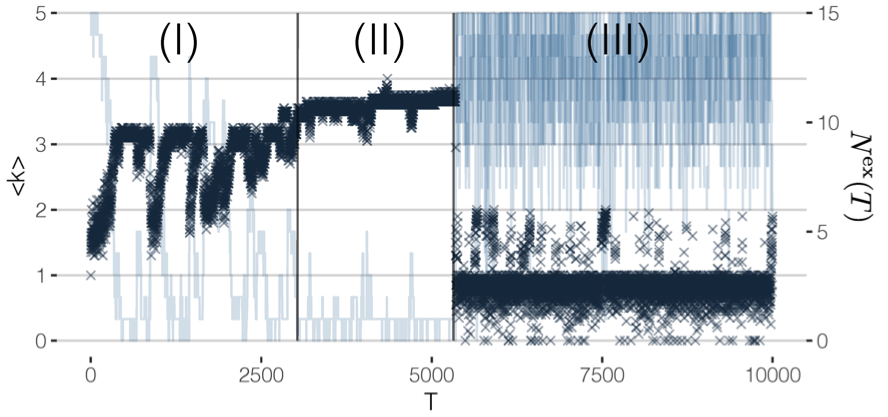
Improving the robustness of online social networks: A simulation approach of network interventions
|
[2020]
|
|
Casiraghi, Giona;
Schweitzer, Frank
|
Frontiers in Robotics and AI,
pages: 57,
volume: 7
|
more» «less
|
Abstract
Online social networks (OSN) are prime examples of socio-technical systems in which individuals interact via a technical platform. OSN are very volatile because users enter and exit and frequently change their interactions. This makes the robustness of such systems difficult to measure and to control. To quantify robustness, we propose a coreness value obtained from the directed interaction network. We study the emergence of large drop-out cascades of users leaving the OSN by means of an agent-based model. For agents, we define a utility function that depends on their relative reputation and their costs for interactions. The decision of agents to leave the OSN depends on this utility. Our aim is to prevent drop-out cascades by influencing specific agents with low utility. We identify strategies to control agents in the core and the periphery of the OSN such that drop-out cascades are significantly reduced, and the robustness of the OSN is increased.

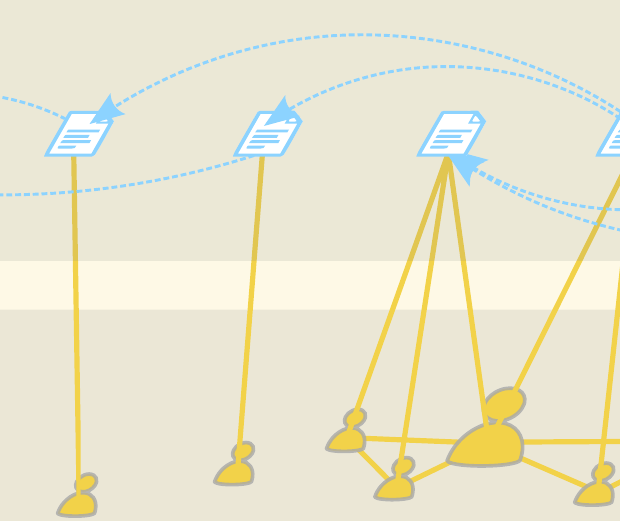
Citations Driven by Social Connections? A Multi-Layer Representation of Coauthorship Networks
|
[2020]
|
|
Nanumyan, Vahan;
Zingg, Christian;
Schweitzer, Frank
|
Quantitative Science Studies,
pages: 1493-1509,
volume: 1,
number: 4
|
more» «less
|
Abstract
To what extent is the citation rate of new papers influenced by the past social relations of their authors? To answer this question, we present a data-driven analysis of nine different physics journals. Our analysis is based on a two-layer network representation constructed from two large-scale data sets, INSPIREHEP and APS. The social layer contains authors as nodes and coauthorship relations as links. This allows us to quantify the social relations of each author, prior to the publication of a new paper. The publication layer contains papers as nodes and citations between papers as links. This layer allows us to quantify scientific attention as measured by the change of the citation rate over time. We particularly study how this change correlates with the social relations of their authors, prior to publication. We find that on average the maximum value of the citation rate is reached sooner for authors who have either published more papers or who have had more coauthors in previous papers. We also find that for these authors the decay in the citation rate is faster, meaning that their papers are forgotten sooner.

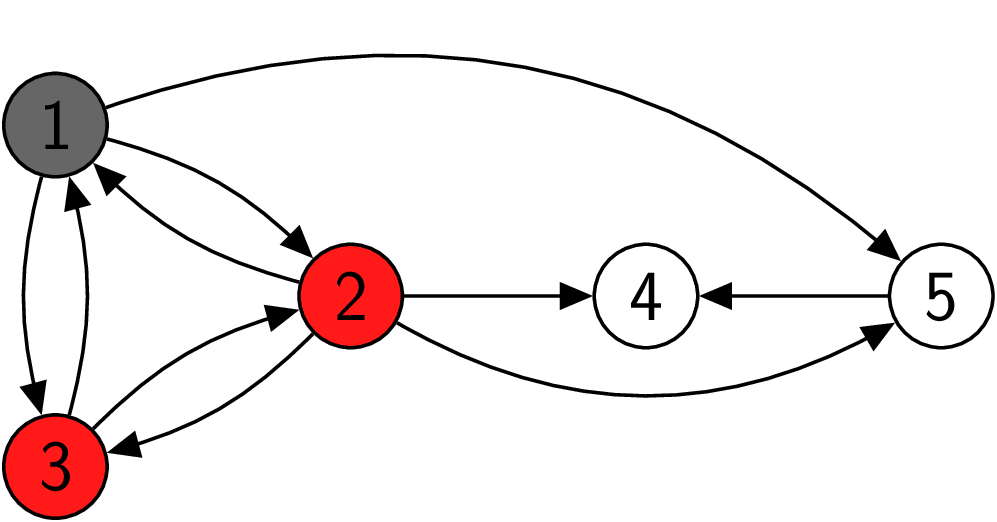
Modeling User Reputation in Online Social Networks: The Role of Costs, Benefits, and Reciprocity
|
[2020]
|
|
Schweitzer, Frank;
Mavrodiev, Pavlin;
Seufert, A. M.;
Garcia, David
|
Entropy,
pages: 1073,
volume: 22,
number: 10
|
more» «less
|
Abstract
We analyze an agent-based model to estimate how the costs and benefits of users in an online social network (OSN) impact the robustness of the OSN. Benefits are measured in terms of relative reputation that users receives from their followers. They can be increased by direct and indirect reciprocity in following each other, which leads to a core-periphery structure of the OSN. Costs relate to the effort to login, to maintain the profile, etc. and are assumed as constant for all users. The robustness of the OSN depends on the entry and exit of users over time. Intuitively, one would expect that higher costs lead to more users leaving and hence to a less robust OSN. We demonstrate that an optimal cost level exists, which maximizes both the performance of the OSN, measured by means of the long-term average benefit of its users, and the robustness of the OSN, measured by means of the life-time of the core of the OSN. Our mathematical and computational analyses unfold how changes in the cost level impact reciprocity and subsequently the core-periphery structure of the OSN, to explain the optimal cost level.

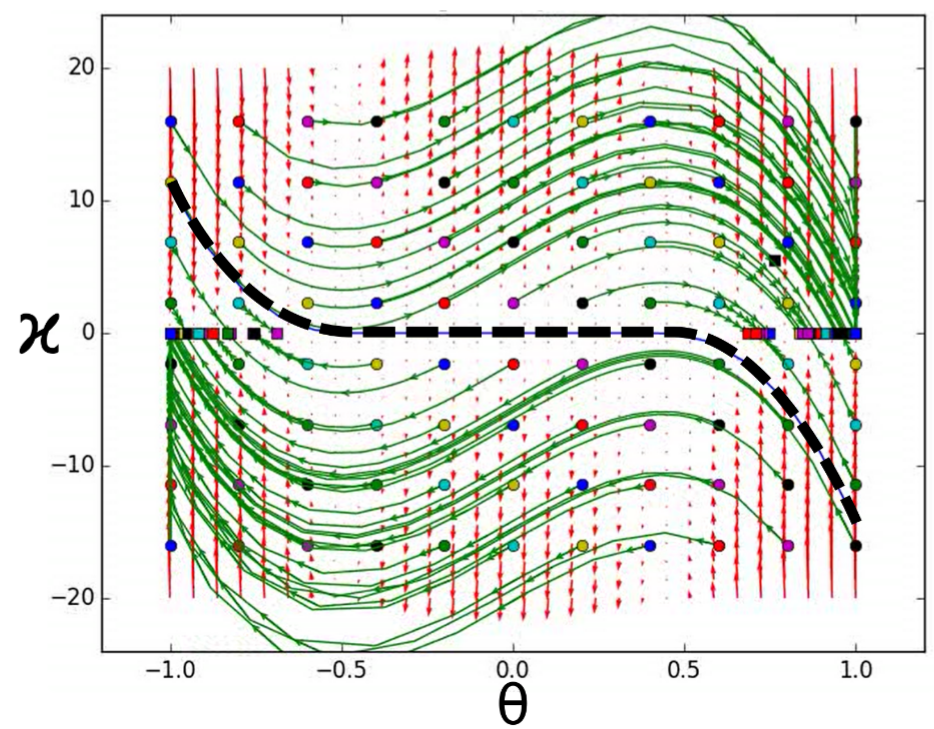
An Agent-Based Model of Opinion Polarization Driven by Emotions
|
[2020]
|
|
Schweitzer, Frank;
Krivachy, Tamas;
Garcia, David
|
Complexity,
volume: 2020
|
more» «less
|
Abstract
We provide an agent-based model to explain the emergence of collective opinions not based on feedback between different opinions, but based on emotional interactions between agents. The driving variable is the emotional state of agents, characterized by their valence, quantifying the emotion from unpleasant to pleasant, and their arousal, quantifying the degree of activity associated with the emotion. Both determine their emotional expression, from which collective emotional information is generated. This information feeds back on the dynamics of emotional states and individual opinions in a nonlinear manner. We derive the critical conditions for emotional interactions to obtain either consensus or polarization of opinions. Stochastic agent-based simulations and formal analyses of the model explain our results. Possible ways to validate the model are discussed.

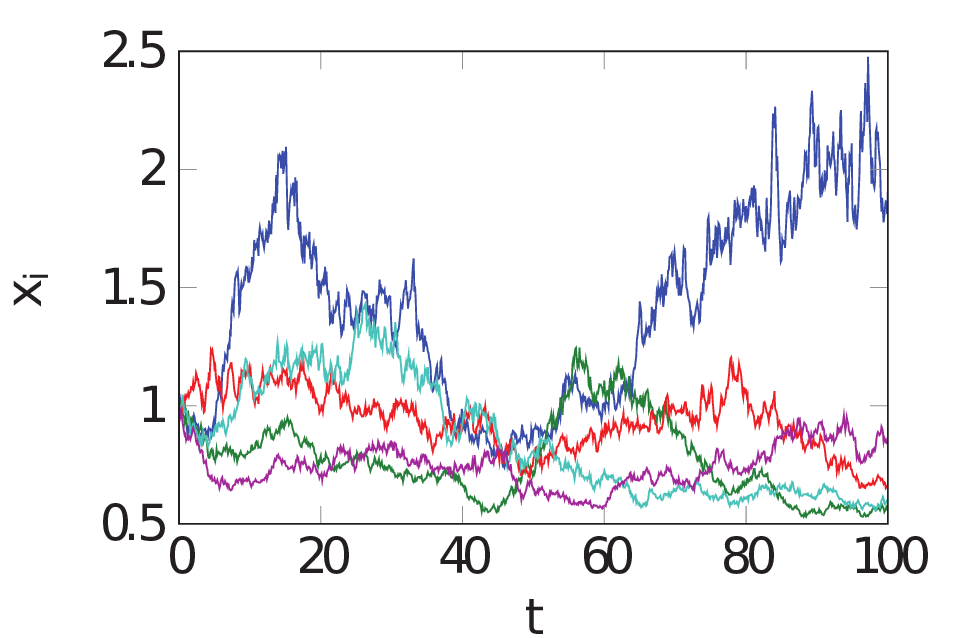
The law of proportionate growth and its siblings: Applications in agent-based modeling of socio-economic systems
|
[2020]
|
|
Schweitzer, Frank
|
Complexity, Heterogeneity, and the Methods of Statistical Physics in Economics
|
more» «less
|
Abstract
The law of proportionate growth simply states that the time dependent change of a quantity $x$ is proportional to $x$. Its applicability to a wide range of dynamic phenomena is based on various assumptions for the proportionality factor, which can be random or deterministic, constant or time dependent. Further, the dynamics can be combined with additional additive growth terms, which can be constants, aggregated quantities, or interaction terms. This allows to extent the core dynamics into an agent-based modeling framework with vast applications in social and economic systems. The paper adopts this overarching perspective to discuss phenomena as diverse as saturated growth, competition, stochastic growth, investments in random environments, wealth redistribution, opinion dynamics and the wisdom of crowds, reputation dynamics, knowledge growth, and the combination with network dynamics.
Analysing Time-Stamped Co-Editing Networks in Software Development Teams using git2net
|
[2019]
|
|
Gote, Christoph;
Scholtes, Ingo;
Schweitzer, Frank
|
arXiv:1911.09484
|
more» «less
|
Abstract
Data from software repositories have become an important foundation for the empirical study of software engineering processes. A recurring theme in the repository mining literature is the inference of developer networks capturing e.g. collaboration, coordination, or communication from the commit history of projects. Most of the studied networks are based on the co-authorship of software artefacts. Because this neglects detailed information on code changes and code ownership we introduce git2net, a scalable python software that facilitates the extraction of fine-grained co-editing networks in large git repositories. It uses text mining techniques to analyse the detailed history of textual modifications within files. We apply our tool in two case studies using GitHub repositories of multiple Open Source as well as a commercial software project. Specifically, we use data on more than 1.2 million commits and more than 25'000 developers to test a hypothesis on the relation between developer productivity and co-editing patterns in software teams. We argue that git2net opens up a massive new source of high-resolution data on human collaboration patterns that can be used to advance theory in empirical software engineering, computational social science, and organisational studies.

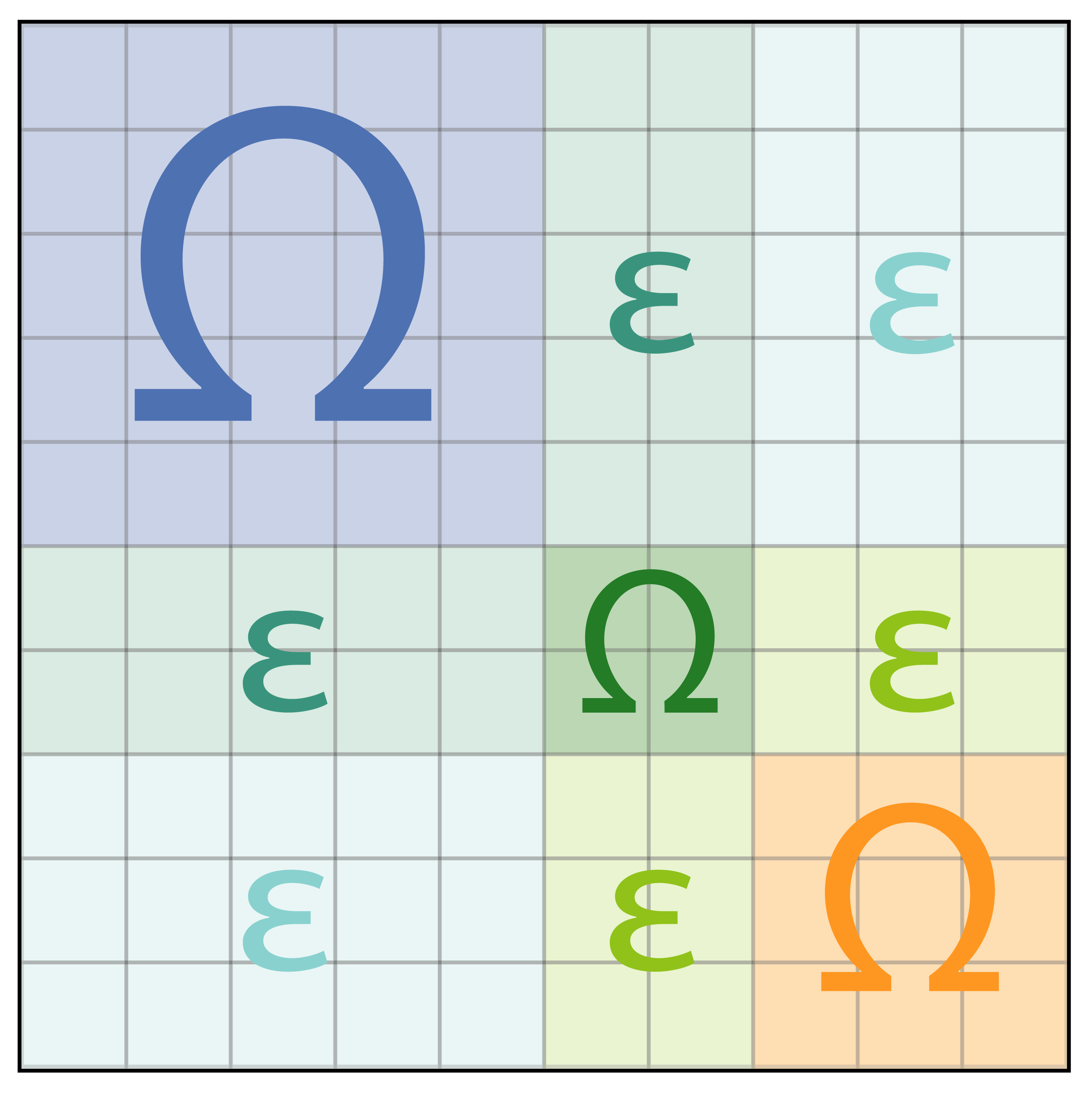
The block-constrained configuration model
|
[2019]
|
|
Casiraghi, Giona
|
Applied Network Science,
volume: 4,
number: 123
|
more» «less
|
Abstract
We provide a novel family of generative block-models for random graphs that naturally incorporates degree distributions: the block-constrained configuration model. Block-constrained configuration models build on the generalized hypergeometric ensemble of random graphs and extend the well-known configuration model by enforcing block-constraints on the edge-generating process. The resulting models are practical to fit even to large networks. These models provide a new, flexible tool for the study of community structure and for network science in general, where modeling networks with heterogeneous degree distributions is of central importance.

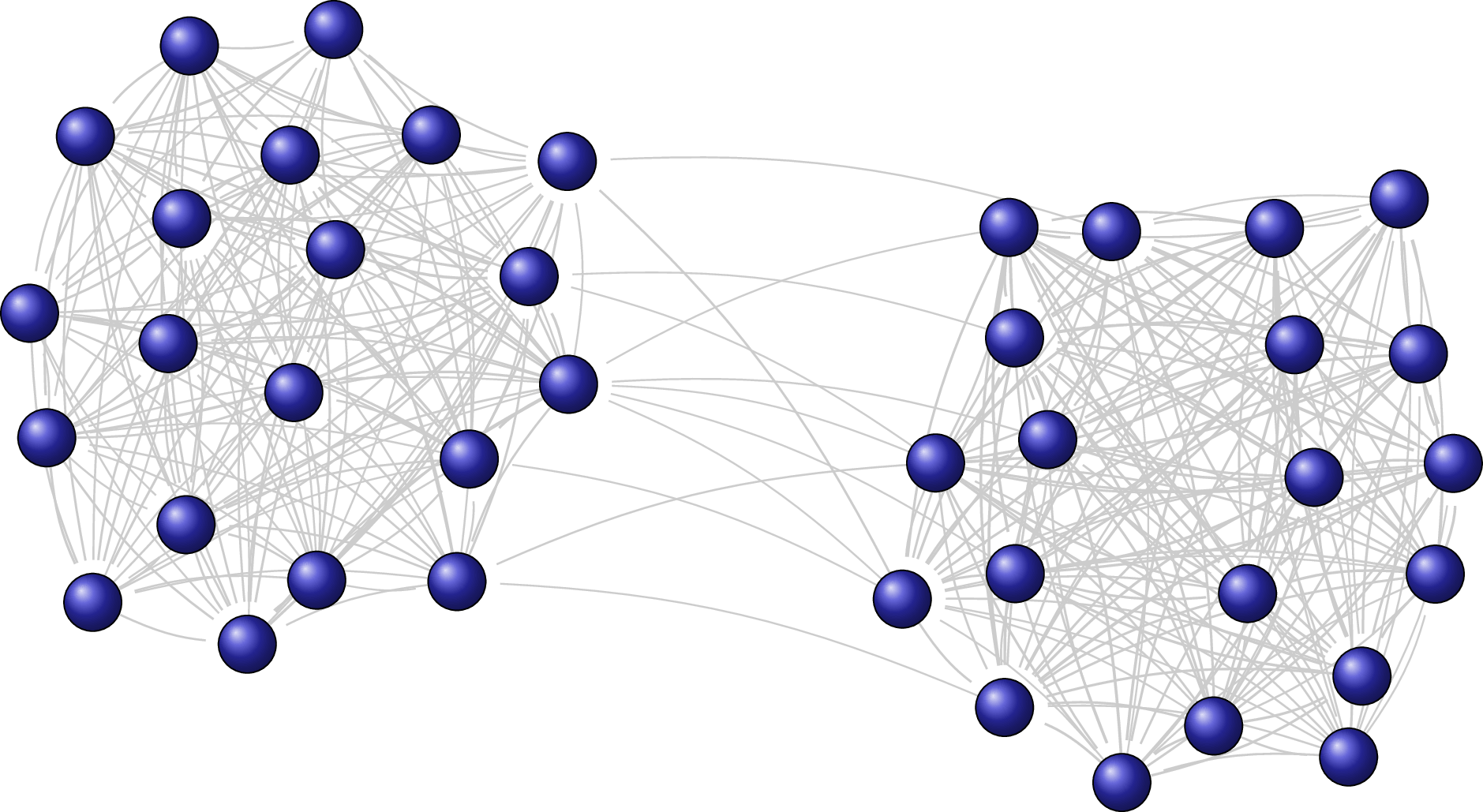
Data-driven modeling of group formation in the fission-fusion dynamics of Bechstein's bats
|
[2019]
|
|
Perony, Nicolas;
Kerth, Gerald;
Schweitzer, Frank
|
Journal of the Royal Society Interface,
pages: (submitted)
|
more» «less
|
Abstract
Communal roosting in Bechstein's bat colonies is characterized by the formation of several groups that use different day roosts and that regularly dissolve and re-merge (fission-fusion dynamics). Analyzing data from two colonies of different size over many years, we find that (i) the number of days bats stay in the same roost before changing follows an exponential distribution that is independent of the colony size, and (ii) the number and size of groups bats formed for roosting depend on the size of the colony such that above a critical colony size two to six groups of different sizes are formed. To model these two observations, we propose an agent-based model in which agents make their decisions about roosts based on both random and social influences. For the latter, they copy the roost preference of another agent which models the transfer of the respective information. Our model is able to reproduce both the distribution of stay length in the same roost and the emergence of groups of different sizes dependent on the colony size. Moreover, we are able to predict the critical system size at which the formation of different groups emerges without global coordination. We further comment on dynamics that bridge the roosting decisions on short time scale (less than one day) with the social structures observed at long time scales (more than one year).

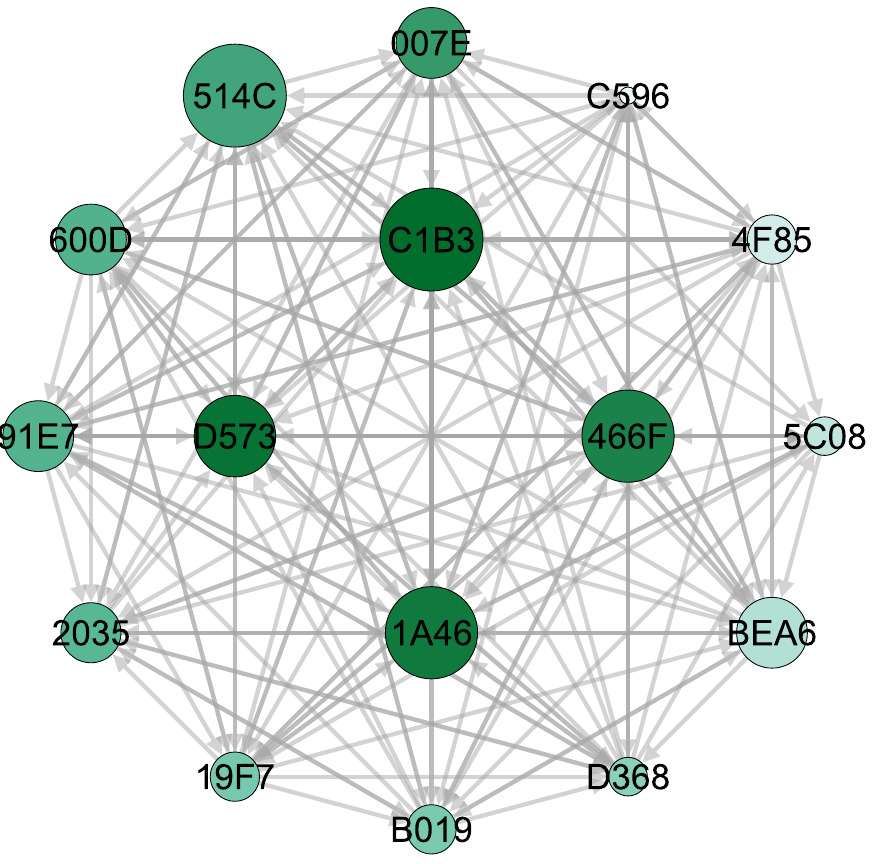
Data-driven modeling of leading-following behavior in Bechstein's bats
|
[2019]
|
|
Mavrodiev, Pavlin;
Fleischmann, Daniela;
Kerth, Gerald;
Schweitzer, Frank
|
PLOS Computational Biology,
pages: (submitted)
|
more» «less
|
Abstract
Leading-following behaviour in Bechstein's bats transfers information about suitable roost sites from experienced to inexperienced individuals, and thus ensures communal roosting. We analyze 9 empirical data sets about individualized leading-following (L/F) events, to infer rules that likely determine the formation of L/F pairs. To test these rules, we propose five models that differ regarding the empirical information taken into account to form L/F pairs: activity of a bat in exploring possible roosts, tendency to lead and to follow. The comparison with empirical data was done by constructing social networks from the observed L/F events, on which centralities were calculated to quantify the importance of individuals in these L/F networks. The centralities from the empirical network are then compared for statistical differences with the model-generated centralities obtained from $10^{5}$ model realizations. We find that two models perform well in comparison with the empirical data: One model assumes an individual tendency to lead, but chooses followers at random. The other model assumes an individual tendency to follow and chooses leaders according to their overall activity. We note that neither individual preferences for specific individuals, nor other influences such as kinship or reciprocity, are taken into account to reproduce the empirical findings.

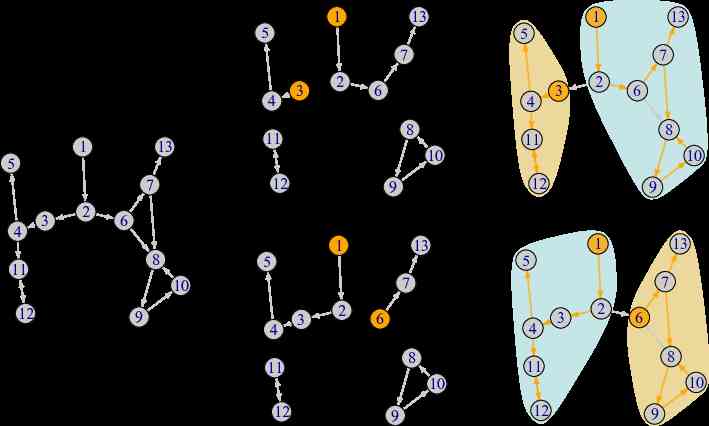
Control contribution identifies top driver nodes in complex networks
|
[2019]
|
|
Zhang, Yan;
Garas, Antonios;
Schweitzer, Frank
|
ACS-Advances in Complex Systems,
pages: 1950014,
volume: 22,
number: 7-8
|
more» «less
|
Abstract
We propose a new measure to quantify the impact of a node $i$ in controlling a directed network. This measure, called ``control contribution'' $_(i)$, combines the probability for node $i$ to appear in a set of driver nodes and the probability for other nodes to be controlled by $i$. To calculate $_(i)$, we propose an optimization method based on random samples of minimum sets of drivers. Using real-world and synthetic networks, we find very broad distributions of $C_(i)$. Ranking nodes according to their $C_(i)$ values allows us to identify the top driver nodes that can control most of the network. We show that this ranking is superior to rankings based on other control-based measures. We find that control contribution indeed contains new information that cannot be traced back to degree, control capacity or control range of a node.

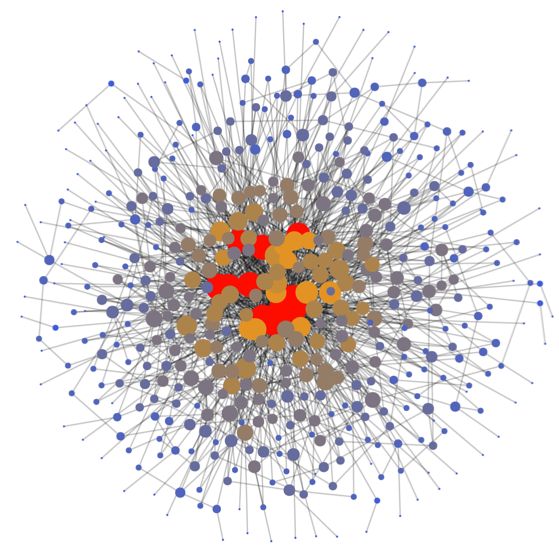
Probing the robustness of nested multi-layer networks
|
[2019]
|
|
Casiraghi, Giona;
Garas, Antonios;
Schweitzer, Frank
|
arXiv:1911.03277
|
more» «less
|
Abstract
We consider a multi-layer network with two layers, $\_1\$, $\_2\$. Their intra-layer topology shows a scale-free degree distribution and a core-periphery structure. A nested structure describes the inter-layer topology, i.e., some nodes from $\_1\$, the generalists, have many links to nodes in $\_2\$, specialists only have a few. This structure is verified by analyzing two empirical networks from ecology and economics. To probe the robustness of the multi-layer network, we remove nodes from $\_1\$ with their inter-and intra-layer links and measure the impact on the size of the largest connected component, $F_2\$, in $\_2\$, which we take as a robustness measure. We test different attack scenarios by preferably removing peripheral or core nodes. We also vary the intra-layer coupling between generalists and specialists, to study their impact on the robustness of the multi-layer network. We find that some combinations of attack scenario and intra-layer coupling lead to very low robustness values, whereas others demonstrate high robustness of the multi-layer network because of the intra-layer links. Our results shed new light on the robustness of bipartite networks, which consider only inter-layer, but no intra-layer links.

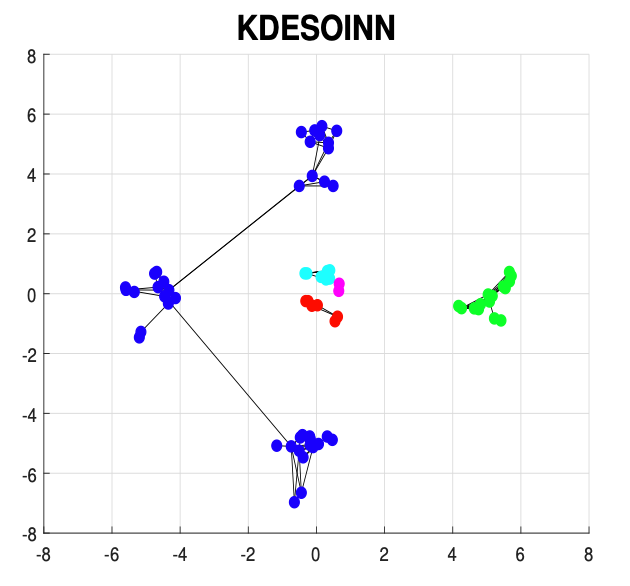
A Gaussian Process-based Self-Organizing Incremental Neural Network
|
[2019]
|
|
Wang, X.;
Casiraghi, Giona;
Zhang, Yan;
Imura, J.
|
2019 International Joint Conference on Neural Networks (IJCNN),
pages: 1-8
|
more» «less
|
Abstract
This paper proposes a Gaussian process-based self-organizing incremental neural network (GPINN) to address the density estimation problem of online unsupervised learning. First, we adopt Gaussian process models with adaptive kernels that map the distribution of the neighbors of each node to its link relationship. Second, combining GPINN and kernel density estimation, we derive the bandwidth matrix updating rule for adapting to the generated network. We theoretically analyze the advantages of the proposed approach in determining threshold regions over using distance measures. The experimental results on both synthetic data sets and real-world data sets show that our method achieves remarkable improvement in density estimation accuracy for large noisy data.

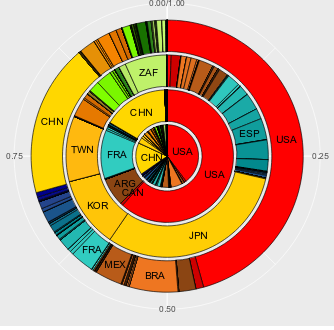
International crop trade networks: The impact of shocks and cascades
|
[2019]
|
|
Burkholz, Rebekka;
Schweitzer, Frank
|
Environmental Research Letters,
pages: 114013,
volume: 14
|
more» «less
|
Abstract
Analyzing available FAO data from 176 countries over 21 years, we observe an increase of complexity in the international trade of maize, rice, soy, and wheat. A larger number of countries play a role as producers or intermediaries, either for trade or food processing. In consequence, we find that the trade networks become more prone to failure cascades caused by exogenous shocks. In our model, countries compensate for demand deficits by imposing export restrictions. To capture these, we construct higher-order trade dependency networks for the different crops and years. These networks reveal hidden dependencies between countries and provide an estimate of necessary stock reserves to protect countries from cascading export restrictions. They differ substantially from first order networks that do not take cascading effects into account. We find rice trade most prone to cascading export restrictions. A great number of Asian and African countries are most exposed to cascades. Noticeably, the main suppliers are similar for most of the crops: USA, Canada, Argentina, Brazil, and India. While shocks in the USA mainly affect South America and several Asian countries, the south of Africa is primarily dependent on American and Asian exporters. The north of Africa depends strongly on Europe, in particular via wheat imports.


Predicting Network Events to Assess Goodness of Fit of Relational Event Models
|
[2019]
|
|
Brandenberger, Laurence
|
Political Analysis,
pages: 556-571,
volume: 27,
number: 4
|
more» «less
|
Abstract
Relational event models are becoming increasingly popular in modeling temporal dynamics of social networks. Due to their nature of combining survival analysis with network model terms, standard methods of assessing model fit are not suitable to determine if the models are specified sufficiently to prevent biased estimates. This paper tackles this problem by presenting a simple procedure for model-based simulations of relational events. Predictions are made based on survival probabilities and can be used to simulate new event sequences. Comparing these simulated event sequences to the original event sequence allows for in depth model comparisons (including parameter as well as model specifications) and testing of whether the model can replicate network characteristics sufficiently to allow for unbiased estimates.

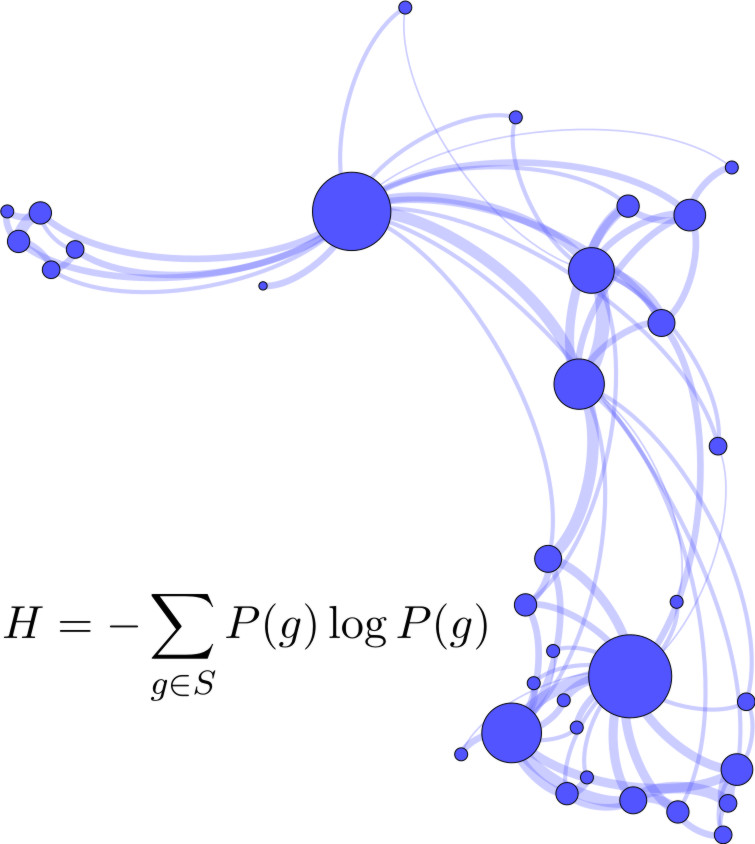
What is the Entropy of a Social Organization?
|
[2019]
|
|
Zingg, Christian;
Casiraghi, Giona;
Vaccario, Giacomo;
Schweitzer, Frank
|
Entropy,
volume: 21,
number: 9
|
more» «less
|
Abstract
We quantify a social organization's potentiality, that is its ability to attain different configurations. The organization is represented as a network in which nodes correspond to individuals and (multi-)edges to their multiple interactions. Attainable configurations are treated as realizations from a network ensemble. To encode interaction preferences between individuals, we choose the generalized hypergeometric ensemble of random graphs, which is described by a closed-form probability distribution. From this distribution we calculate Shannon entropy as a measure of potentiality. This allows us to compare different organizations as well different stages in the development of a given organization. The feasibility of the approach is demonstrated using data from 3 empirical and 2 synthetic systems.


Quantifying Triadic Closure in Multi-Edge Social Networks
|
[2019]
|
|
Brandenberger, Laurence;
Casiraghi, Giona;
Nanumyan, Vahan;
Schweitzer, Frank
|
ASONAM '19: Proceedings of the 2019 IEEE/ACM International Conference on Advances in Social Networks Analysis and Mining
|
more» «less
|
Abstract
Multi-edge networks capture repeated interactions between individuals. In social networks, such edges often form closed triangles, or triads. Standard approaches to measure this triadic closure, however, fail for multi-edge networks, because they do not consider that triads can be formed by edges of different multiplicity. We propose a novel measure of triadic closure for multi-edge networks of social interactions based on a shared partner statistic. We demonstrate that our operalization is able to detect meaningful closure in synthetic and empirical multi-edge networks, where common approaches fail. This is a cornerstone in driving inferential network analyses from the analysis of binary networks towards the analyses of multi-edge and weighted networks, which offer a more realistic representation of social interactions and relations.
git2net - An Open Source Package to Mine Time-Stamped Collaboration Networks from Large git Repositories
|
[2019]
|
|
Schweitzer, Frank;
Gote, Christoph;
Scholtes, Ingo
|
Proceedings of the 16th International Conference on Mining Software Repositories,
pages: 433-444
|
more» «less
|
Abstract
Data from software repositories have become an important foundation for the empirical study of software engineering processes. A recurring theme in the repository mining literature is the inference of developer networks capturing e.g. collaboration, coordination, or communication from the commit history of projects. Most of the studied networks are based on the co-authorship of software artefacts defined at the level of files, modules, or packages. While this approach has led to insights into the social aspects of software development, it neglects detailed information on code changes and code ownership, e.g. which exact lines of code have been authored by which developers, that is contained in the commit log of software projects.
Addressing this issue, we introduce git2net, a scalable python software that facilitates the extraction of fine-grained co-editing networks in large git repositories. It uses text mining techniques to analyse the detailed history of textual modifications within files. This information allows us to construct directed, weighted, and time-stamped networks, where a link signifies that one developer has edited a block of source code originally written by another developer. Our tool is applied in case studies of an Open Source and a commercial software project. We argue that it opens up a massive new source of high-resolution data on human collaboration patterns.


Efficient message passing for cascade size distributions
|
[2019]
|
|
Burkholz, Rebekka
|
Scientific Reports,
volume: 9,
number: 6561
|
more» «less
|
Abstract
How big is the risk that a few initial failures of networked nodes amplify to large cascades that endanger the functioning of the system? Common answers refer to the average final cascade size. Two analytic approaches allow its computation: a) (heterogeneous) mean field approximation and b) belief propagation. The former applies to (infinitely) large locally tree-like networks, while the latter is exact on finite trees. Yet, cascade sizes can have broad and multi-modal distributions that are not well represented by their average. Full distribution information is essential to identify likely events and to estimate the tail risk, i.e. the probability of extreme events. We therefore present an efficient message passing algorithm that calculates the cascade size distribution in finite networks. It is exact on finite trees and for a large class of cascade processes. An approximate version applies to any network
structure and performs well on locally tree-like networks, as we show with several examples.

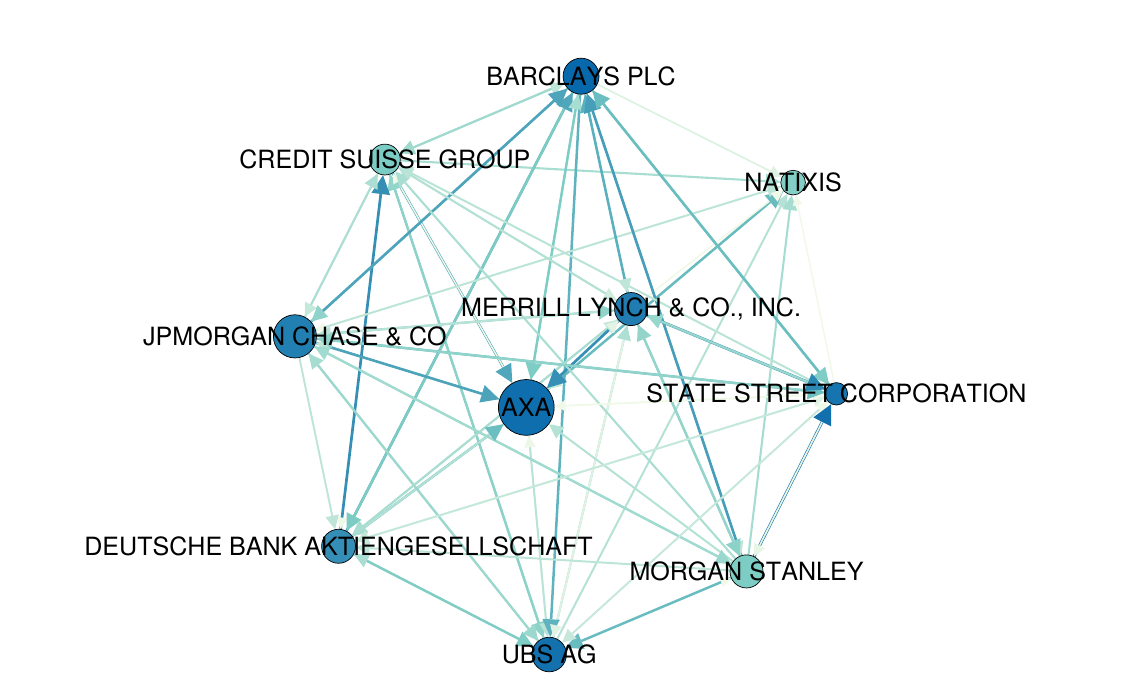
The interdependence of corporate reputation and ownership: A network approach to quantify reputation
|
[2019]
|
|
Zhang, Dr. Yan;
Schweitzer, Frank
|
Royal Society Open Science,
pages: 190570,
volume: 6
|
more» «less
|
Abstract
We propose a novel way to measure the reputation of firms by using information about their ownership structure. Supported by the signaling theory, we argue that ownership relations channel reputation spillovers between shareholders and their invested companies. We model such reputation spillovers by means of a simple dynamics that runs on the ownership network, constructed from available data bases. We focus on the core of the global ownership network with 1'300 firms and 12'100 ownership links. Our method assigns a ownership-based reputation value to each firm, used to provide a quantitative reputation ranking. We compare our ranking with alternative rankings, to confirm that the top ranked firms are correctly identified. We also demonstrate that our reputation measure does not correlate substantially with operating revenue or control and thus provides additional information about firms.


The Bigger Picture: Complexity Meets Systems Design
|
[2019]
|
|
Schweitzer, Frank
|
Design. Tales of Science and Innovation
|
more» «less
|
Abstract
System design – the term immediately evokes associations with the freedoms of a divine creator. However, it is precisely this idea that already describes the problem: like any other design, system design must respect certain boundaries, but the complexity of the design is far greater. Before we can even formulate systems design questions, we must first clarify what we want to mean by a system, which approach we choose to system modelling, and how we validate these models. This addresses the methodological-technical aspects of systems design. The methodological-critical perspective focuses on the limits of systems design. What do we actually want to achieve with systems design? It doesn't take long to draw up a wish list. But how meaningful or feasible are these wishes? Here, we must critically question our expectations.

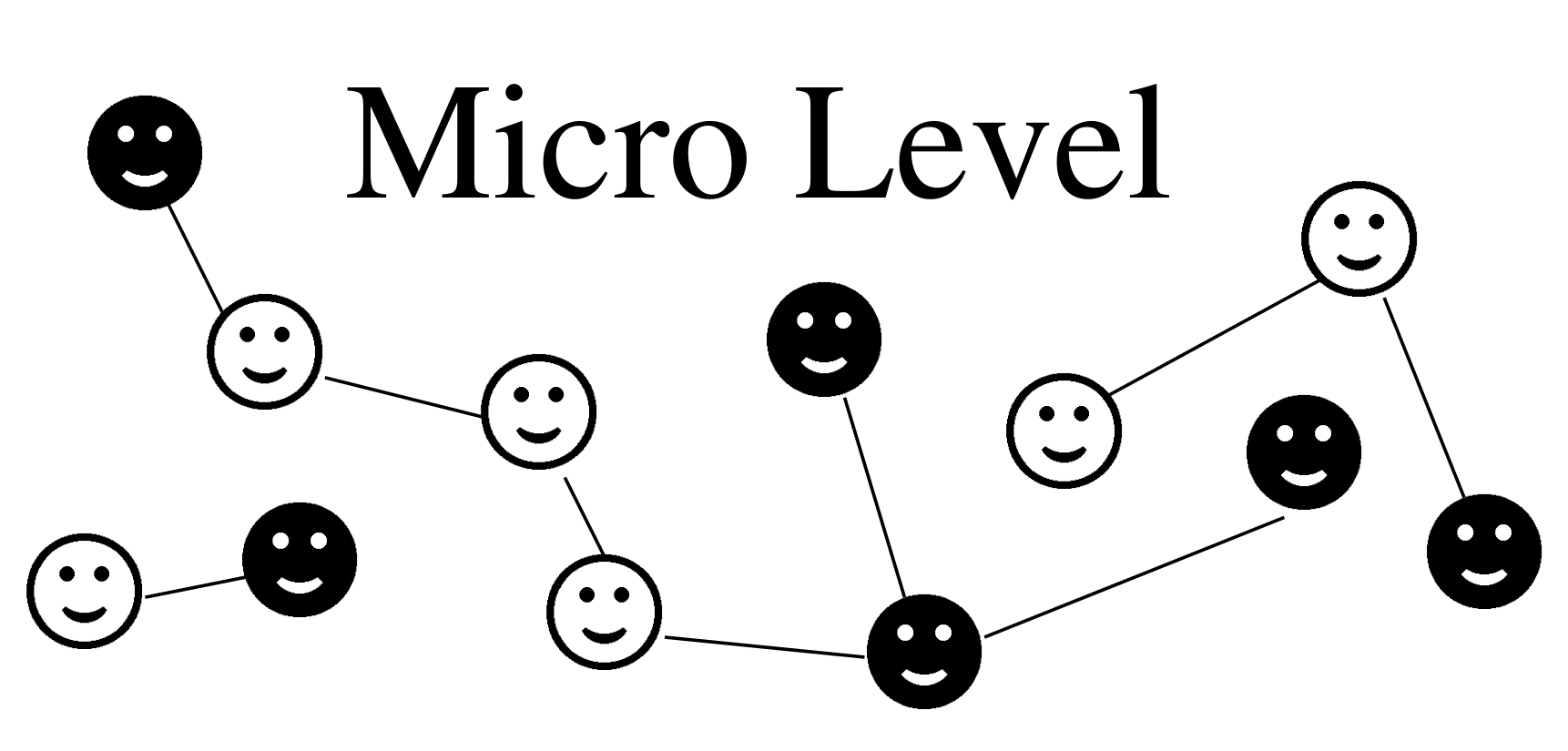
An agent-based framework of active matter with applications in biological and social systems
|
[2019]
|
|
Schweitzer, Frank
|
European Journal of Physics,
volume: 40,
number: 1
|
more» «less
|
Abstract
Active matter, as other types of self-organizing systems, relies on the take-up of energy that can be used for different actions, such as active motion or structure formation. Here we provide an agent-based framework to model these processes at different levels of organization, physical, biological and social, using the same dynamic approach. Driving variables describe the take-up, storage and conversion of energy, whereas driven variables describe the energy consuming activities. The stochastic dynamics of both types of variables follow a modified Langevin equation. Additional non-linear functions allow to encode system-specific hypotheses about the relation between driving and driven variables. To demonstrate the applicability of this framework, we recast a number of existing models of Brownian agents and Active Brownian Particles. Specifically, active motion, clustering and self-wiring of networks based on chemotactic interactions, online communication and polarization of opinions based on emotional influence are discussed. The framework allows to obtain critical parameters for active motion and the emergence of collective phenomena. This highlights the role of energy take-up and dissipation in obtaining different dynamic regimes.

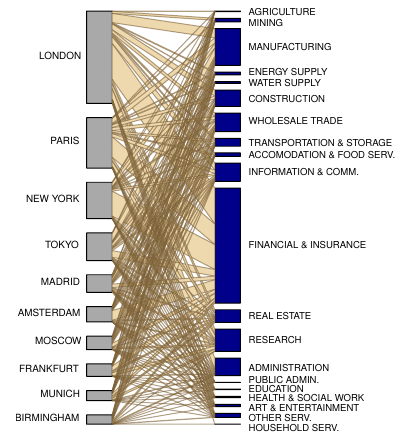
Economic Specialization and the Nested Bipartite Network of City-Firm Relations
|
[2019]
|
|
Garas, Antonios;
Rozenblat, C'eline;
Schweitzer, Frank
|
Multiplex and Multilevel Networks
|
more» «less
|
Abstract
How are economic activities linked to geographic locations? To answer this question, we use a data-driven approach that builds on the information about location, ownership and economic activities of the world's 3,000 largest firms and their almost one million subsidiaries. From this information we generate a bipartite network of cities linked to economic activities. Analysing the structure of this network, we find striking similarities with nested networks observed in ecology, where links represent mutualistic interactions between species. This motivates us to apply ecological indicators to identify the unbalanced deployment of economic activities. Such deployment can lead to an over-representation of specific economic sectors in a given city, and poses a significant thread for the city's future especially in times when the over-represented activities face economic uncertainties. If we compare our analysis with external rankings about the quality of life in a city, we find that the nested structure of the city-firm network also reflects such information about the quality of life, which can usually be assessed only via dedicated survey-based indicators.


Multiplex and Multilevel Networks
|
[2018]
|
|
Caldarelli, Guido;
Garas, Antonios;
Battiston, Stefano
|
Multiplex and Multilevel Networks
|
more» «less
|
Abstract
Multiplex and Multilayer Networks is a collection of some of the results obtained in the new field of complex networks theory with respect to multilevel, multiplex, and interacting networks. The ever-increasing availability of data in fields ranging from computer science to urban systems, medicine, economics, and finance shows that networks that were usually perceived as distinct and isolated are, in reality, interacting with other networks. While this sounds like a trivial observation, the interactions in multilevel complex networks can lead to unexpected behaviors and allow systemic vulnerabilities to emerge. The research activities of many different laboratories and groups in this field have been financed by the EU MULTIPLEX project (http://www.multiplexproject.eu). This project utilized 23 distinct research teams across Europe and, from 2012 to 2016, explored this new area of research. The results, presented in this volume, range from the theory of static multinetworks to dynamical process on them, to their percolating properties, and, finally, to applications in the case of social systems.
Physikalische Aspekte der Evolutorischen Ökonomik
|
[2018]
|
|
Schweitzer, Frank
|
Handbuch zur Evolutorischen Ökonomik
|
more» «less
|


Generalised hypergeometric ensembles of random graphs: The configuration model as an urn problem
|
[2018]
|
|
Casiraghi, Giona;
Nanumyan, Vahan
|
arXiv:1810.06495
|
more» «less
|
Abstract
We introduce a broad class of random graph models: the generalised hypergeometric ensemble (GHypEG). This class enables to solve some long-standing problems in random graph theory. First, GHypEG provides an elegant and compact formulation of the well-known configuration model in terms of an urn problem. Second, GHypEG allows incorporating arbitrary tendencies to connect different vertex pairs. Third, we present the closed-form expressions of the associated probability distribution ensures the analytical tractability of our formulation. This is in stark contrast with the previous state-of-the-art, which is to implement the configuration model by means of computationally expensive procedures.

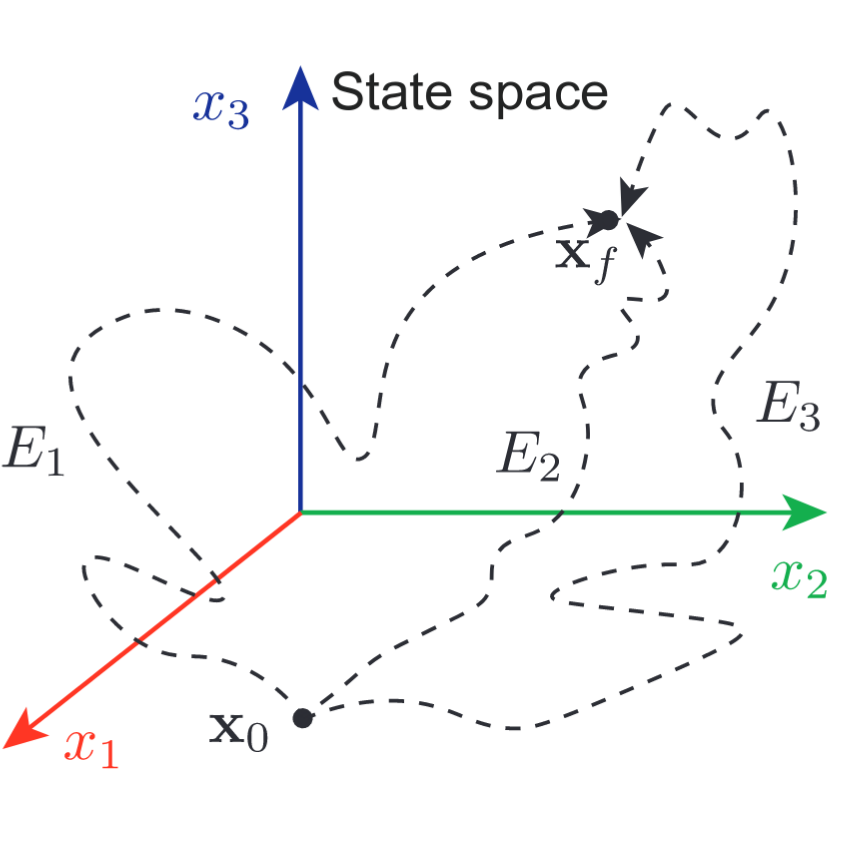
The optimal trajectory to control complex networks
|
[2018]
|
|
Li, Aming;
Wang, Long;
Schweitzer, Frank
|
arXiv: 1806.04229v1,
pages: 1-- 15
|
more» «less
|
Abstract
Controllability, a basic property of various networked systems, has gained profound theoretical applications in complex social, technological, biological, and brain networks. Yet, little attention has been given to the control trajectory (route), along which a controllable system can be controlled from any initial to any final state, hampering the implementation of practical control. Here we systematically uncover the fundamental relations between control trajectory and several other key factors, such as the control distance between initial and final states ($\delta$), number of driver nodes, and the control time. The length ($\mathcal{L}$) and maximum distance to the initial state ($\mathcal{R}$) are employed to quantify the locality and globality of control trajectories. We analyze how the scaling behavior of the averaged $\mathcal{L}$ and $\mathcal{R}$ changes with increasing $\delta$ for different initial states. After showing the scaling behavior for each trajectory, we also provide the distributions of $\mathcal{L}$ and $\mathcal{R}$. Further attention is given to the control time $t_f$ and its influence on $\mathcal{L}$ and $\mathcal{R}$. Our results provide comprehensive insights in understanding control trajectories for complex networks, and pave the way to achieve practical control in various real systems.

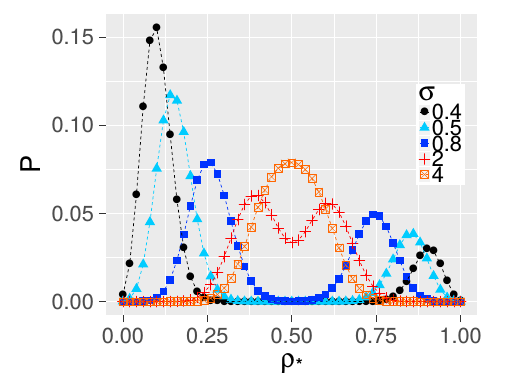
Explicit size distributions of failure cascades redefine systemic risk on finite networks
|
[2018]
|
|
Burkholz, Rebekka;
Herrmann, H. J.;
Schweitzer, Frank
|
Scientific Reports,
pages: 1--8
|
more» «less
|
Abstract
How big is the risk that a few initial failures of nodes in a network amplify to large cascades that span a substantial share of all
nodes? Predicting the final cascade size is critical to ensure the functioning of a system as a whole. Yet, this task is hampered
by uncertain or changing parameters and missing information. In infinitely large networks, the average cascade size can often
be well estimated by established approaches building on local tree approximations and mean field approximations. Yet, as
we demonstrate, in finite networks, this average does not even need to be a likely outcome. Instead, we find broad and even
bimodal cascade size distributions. This phenomenon persists for system sizes up to
10
7
and different cascade models, i.e. it is
relevant for most real systems. To show this, we derive explicit closed-form solutions for the full probability distribution of the
final cascade size. We focus on two topological limit cases, the complete network representing a dense network with a very
narrow degree distribution, and the star network representing a sparse network with a inhomogeneous degree distribution.
Those topologies are of great interest, as they either minimize or maximize the average cascade size and are common motifs
in many real world networks.


Sociophysics
|
[2018]
|
|
Schweitzer, Frank
|
Physics Today,
pages: 40-46,
volume: 71,
number: 2
|
more» «less
|
Abstract
To the extent that individuals interact with each other in prescribed ways, their collective social behavior can be modeled and analyzed.
Twenty-four years ago Paul Krugman, who went on to receive the 2008 Nobel Prize in Economic Sciences, wrote, “Economics is harder than physics; luckily it is not quite as hard as sociology.”1 Thirteen years ago Doyne Farmer, Martin Shubik, and Eric Smith posed the question, Is economics the next physical science? (see Physics Today, September 2005, page 37). If you were skeptical then about sociology as the next physical science, you may be even more skeptical now.

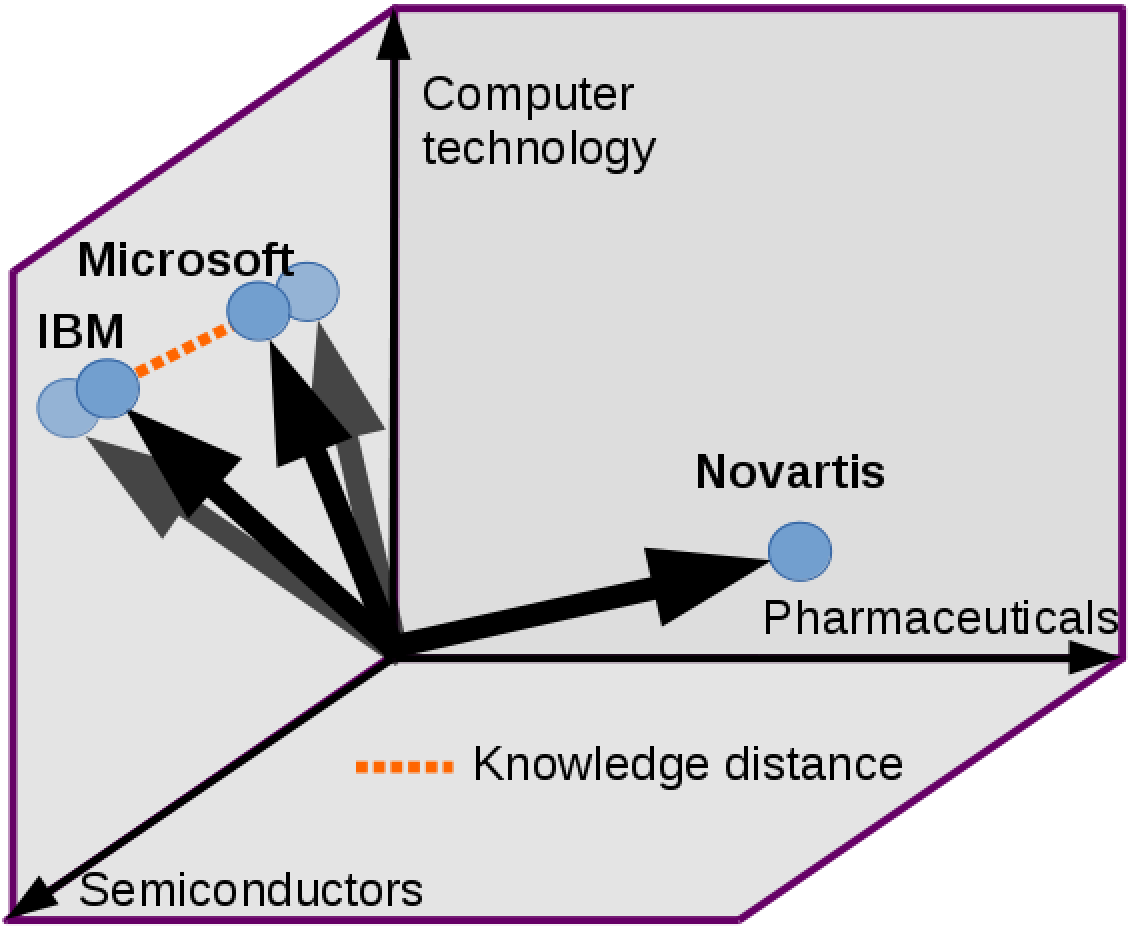
Quantifying knowledge exchange in R&D networks: A data-driven model
|
[2018]
|
|
Vaccario, Giacomo;
Tomasello, Mario Vincenzo;
Tessone, Claudio Juan;
Schweitzer, Frank
|
Journal of Evolutionary Economics,
pages: 461-493,
volume: 28,
number: 3
|
more» «less
|
Abstract
We propose a model that reflects two important processes in R&D activities of firms, the formation of R&D alliances and the exchange of knowledge as a result of these collaborations. In a data-driven approach, we analyze two large-scale data sets extracting unique information about 7500 R&D alliances and 5200 patent portfolios of firms. This data is used to calibrate the model parameters for network formation and knowledge exchange. We obtain probabilities for incumbent and newcomer firms to link to other incumbents or newcomers which are able to reproduce the topology of the empirical R&D network. The position of firms in a knowledge space is obtained from their patents using two different classification schemes, IPC in 8 dimensions and ISI-OST-INPI in 35 dimensions. Our dynamics of knowledge exchange assumes that collaborating firms approach each other in knowledge space at a rate $μ$ for an alliance duration $τ$. Both parameters are obtained in two different ways, by comparing knowledge distances from simulations and empirics and by analyzing the collaboration efficiency $\hat{C}_n$. This is a new measure, that takes also in account the effort of firms to maintain concurrent alliances, and is evaluated via extensive computer simulations. We find that R&D alliances have a duration of around two years and that the subsequent knowledge exchange occurs at a very low rate. Hence, a firm's position in the knowledge space is rather a determinant than a consequence of its R&D alliances. From our data-driven approach we also find model configurations that can be both realistic and optimized with respect to the collaboration efficiency $\hat{C}_n$. Effective policies, as suggested by our model, would incentivize shorter R&D alliances and higher knowledge exchange rates.


Correlations between thresholds and degrees: An analytic approach to model attacks and failure cascades
|
[2018]
|
|
Burkholz, Rebekka;
Schweitzer, Frank
|
Phys. Rev. E,
volume: 98,
number: 2
|
more» «less
|
Abstract
Two node variables determine the evolution of cascades in random networks: a node's degree and threshold. Correlations between both fundamentally change the robustness of a network, yet, they are disregarded in standard analytic methods as local tree or heterogeneous mean field approximations because of the bad tractability of order statistics. We show how they become tractable in the thermodynamic limit of infinite network size. This enables the analytic description of node attacks that are characterized by threshold allocations based on node degree. Using two examples, we discuss possible implications of irregular phase transitions and different speeds of cascade evolution for the control of cascades.

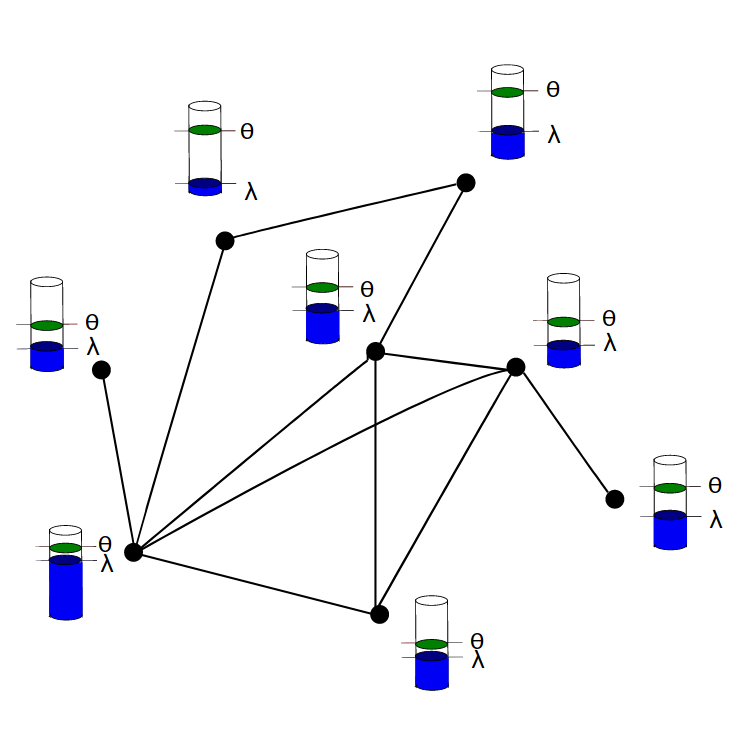
A framework for cascade size calculations on random networks
|
[2018]
|
|
Burkholz, Rebekka;
Schweitzer, Frank
|
Physical Review E,
volume: 97,
number: 4
|
more» «less
|
Abstract
We present a framework to calculate the cascade size evolution for a large class of cascade models
on random network ensembles in the limit of infinite network size. Our method is exact and applies
to network ensembles with almost arbitrary degree distribution, degree-degree correlations and, in
case of threshold models, for arbitrary threshold distribution. With our approach, we shift the
perspective from the known branching process approximations to the iterative update of suitable
probability distributions. Such distributions are key to capture cascade dynamics that involve
possibly continuous quantities and that depend on the cascade history, e.g. if load is accumulated
over time. As a proof of concept, we provide two examples: (a) Constant load models that cover
many of the analytically tractable casacade models, and, as a highlight, (b) a fiber bundle model
that was not tractable by branching process approximations before. Our derivations cover the whole
cascade dynamics, not only their steady state. This allows to include interventions in time or further
model complexity in the analysis.

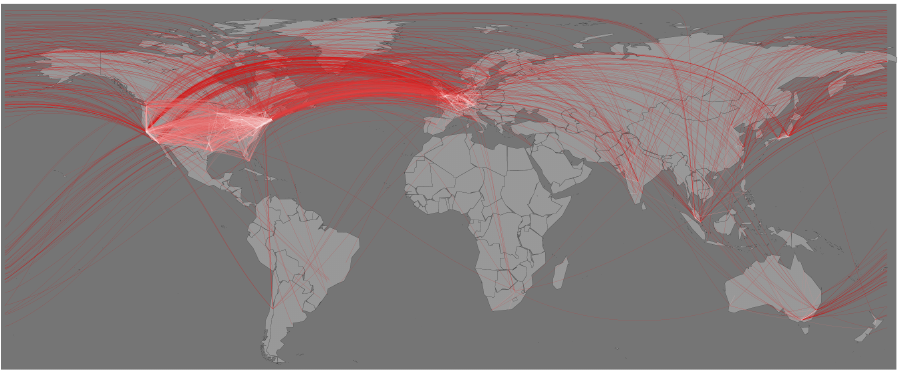
The spatial component of R&D networks
|
[2018]
|
|
Scholl, Tobias;
Garas, Antonios;
Schweitzer, Frank
|
Journal of Evolutionary Economics,
pages: 417-436,
volume: 28,
number: 2
|
more» «less
|
Abstract
We study the role of geography in R&D networks by means of a quantitative, micro-geographic approach. Using a large database that covers international R&D collaborations from 1984 to 2009, we localize each actor precisely in space through its latitude and longitude. This allows us to analyze the R&D network at all geographic scales simultaneously. Our empirical results show that despite the high importance of the city level, transnational R&D collaborations at large distances are much more frequent than expected from similar networks. This provides evidence for the ambiguity of distance in economic cooperation which is also suggested by the existing literature. In addition we test whether the hypothesis of local buzz and global pipelines applies to the observed R&D network by calculating well-defined metrics from network theory.

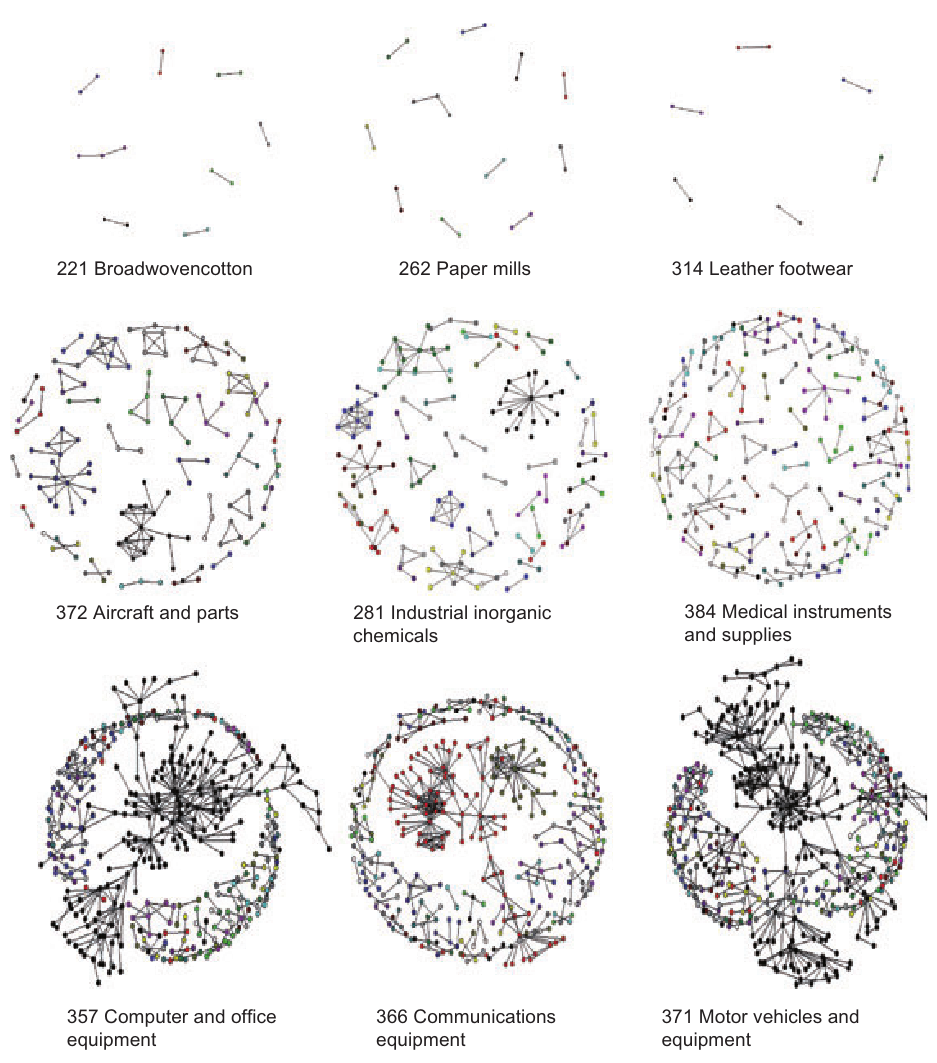
Innovator Networks
|
[2018]
|
|
Tomasello, Mario Vincenzo;
Mueller, Moritz;
Schweitzer, Frank
|
Encyclopedia of Social Network Analysis and Mining
|
more» «less
|
Abstract
From the perspective of innovation economics evolving institutions, innovating entrepreneurs, technological change, and creative destruction are the driving force of economic growth (Schumpeter, 1942). To mitigate the uncertainty involved in the creation of new processes, products, or business models, innovation exhibits an intrinsic collaborative nature. Innovator networks form through formal and informal collaborations between different agents, including firms, institutions, universities, state agencies, inventors, and other stakeholders of the innovation system. Being embedded in a network enables these agents to coordinate innovative efforts, as well as to pool and jointly create knowledge.

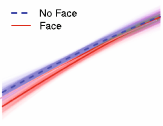
Evaluative Patterns and Incentives in YouTube
|
[2017]
|
|
Abisheva, Adiya;
Garcia, David;
Schweitzer, Frank
|
Social Informatics
|
more» «less
|
Abstract
Users of social media are not only producers and consumers of online content, they also evaluate each other’s content. Some social media include the possibility to down vote or dislike the content posted by other users, posing the risk that users who receive dislikes might be more likely to become inactive, especially if the disliked content is about a person. We analyzed the data on more than 150,000 YouTube videos to understand how video impact and user incentives can be related to the possibility to dislike user content. We processed images related to videos to identify faces and quantify if evaluating content related to people is connected to disliking patterns. We found that videos with faces on their images tend to have less dislikes if they are posted by male users, but the effect is not present for female users. On the contrary, videos with faces and posted by female users attract more views and likes. Analyzing the probability of users to become inactive, we find that receiving dislikes is associated with users becoming inactive. This pattern is stronger when dislikes are given to videos with faces, showing that negative evaluations about people have a stronger association with user inactivity. Our results show that user evaluations in social media are a multi-faceted phenomenon that requires large-scale quantitative analyses, identifying under which conditions users disencourage other users from being active in social media.

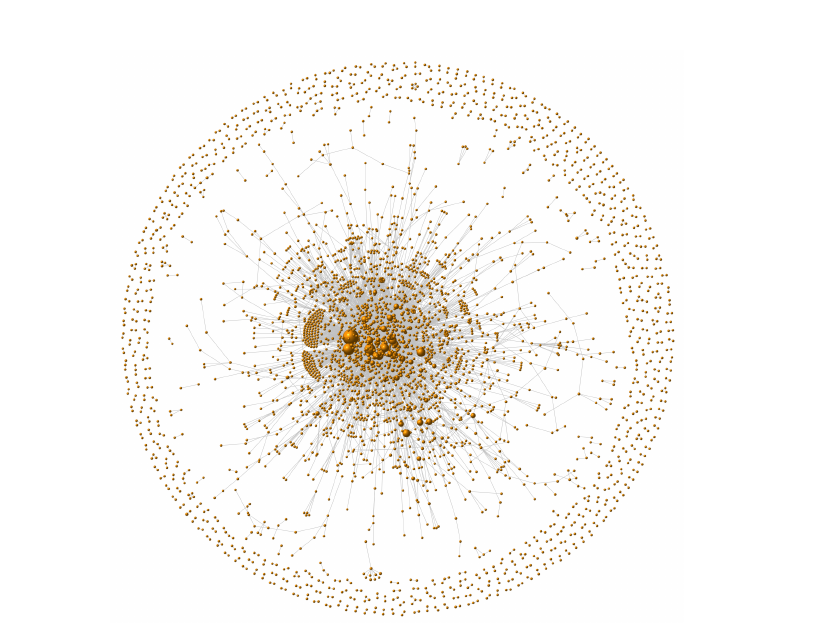
Modeling the formation of R&D alliances: An agent-based model with empirical validation
|
[2017]
|
|
Tomasello, Mario Vincenzo;
Burkholz, Rebekka;
Schweitzer, Frank
|
Economics,
number: 2017-107
|
more» «less
|
Abstract
The authors develop an agent-based model to reproduce the size distribution of R&D alliances of firms. Agents are uniformly selected to initiate an alliance and to invite collaboration partners. These decide about acceptance based on an individual threshold that is compared with the utility expected from joining the current alliance. The benefit of alliances results from the fitness of the agents involved. Fitness is obtained from an empirical distribution of agent's activities. The cost of an alliance reflects its coordination effort. Two free parameters ac and a1 scale the costs and the individual threshold. If initiators receive R rejections of invitations, the alliance formation stops and another initiator is selected. The three free parameters (ac; a1; R) are calibrated against a large scale data set of about 15,000 firms engaging in about 15,000 R&D alliances over 26 years. For the validation of the model the authors compare the empirical size distribution with the theoretical one, using confidence bands, to find a very good agreement. As an asset of our agent-based model, they provide an analytical solution that allows to reduce the simulation effort considerably. The analytical solution applies to general forms of the utility of alliances. Hence, the model can be extended to other cases of alliance formation. While no information about the initiators of an alliance is available, the results indicate that mostly firms with high fitness are able to attract newcomers and to establish larger alliances.

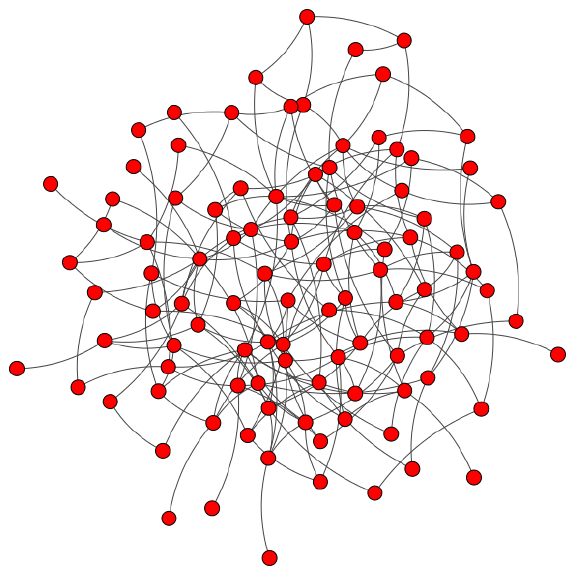
Limits to Scaling – and How to Move beyond Them
|
[2017]
|
|
Schweitzer, Frank
|
Too Big to Scale-On Scaling Space, Number, Time and Energy
|
more» «less
|
Abstract
In engineering, the term "scaling" may be used to describe a relation between objects and their models. In the exact sciences, however, scaling is a systemic property, i.e. it relates to the system itself and not to our perception of it. Scaling describes how certain system properties change conditional on others, most notably the system size.
Certain systems are characterized by a natural scale which remains constant even if the system size increases. Such systems are often described by the so-called normal distribution and are very predictable with respect to that scale, or quantity.
Other systems are scale-free in the sense that no characteristic scale exists. Such systems are characterised by very broad distributions. This means everything can happen with a non-negligible probability.
Such considerations imply that the system properties do not change with scale other than the way defined by the distributions. But complex systems, i.e. systems consisting of a large number of interacting elements (usually denoted as agents), also have the property of emergence. This describes the sudden occurrence of new system qualities once certain critical parameters are reached. This means, above a certain system size the system behaves completely different. Sometimes, it is very difficult to predict when this critical size is reached.
Most real complex systems are characterized both by emergent properties and by scaling laws that do not simply follow a power-law behavior. Economic systems, for example, are often described by decreasing returns to scale.
Conclusion: there are several limits to scaling: (i) natural scales, which are system immanent, (ii) critical parameters at which system properties change in a discontinuous manner, i.e. new system qualities emerge, (iii) decreasing returns to scale, which render any further growth unprofitable.

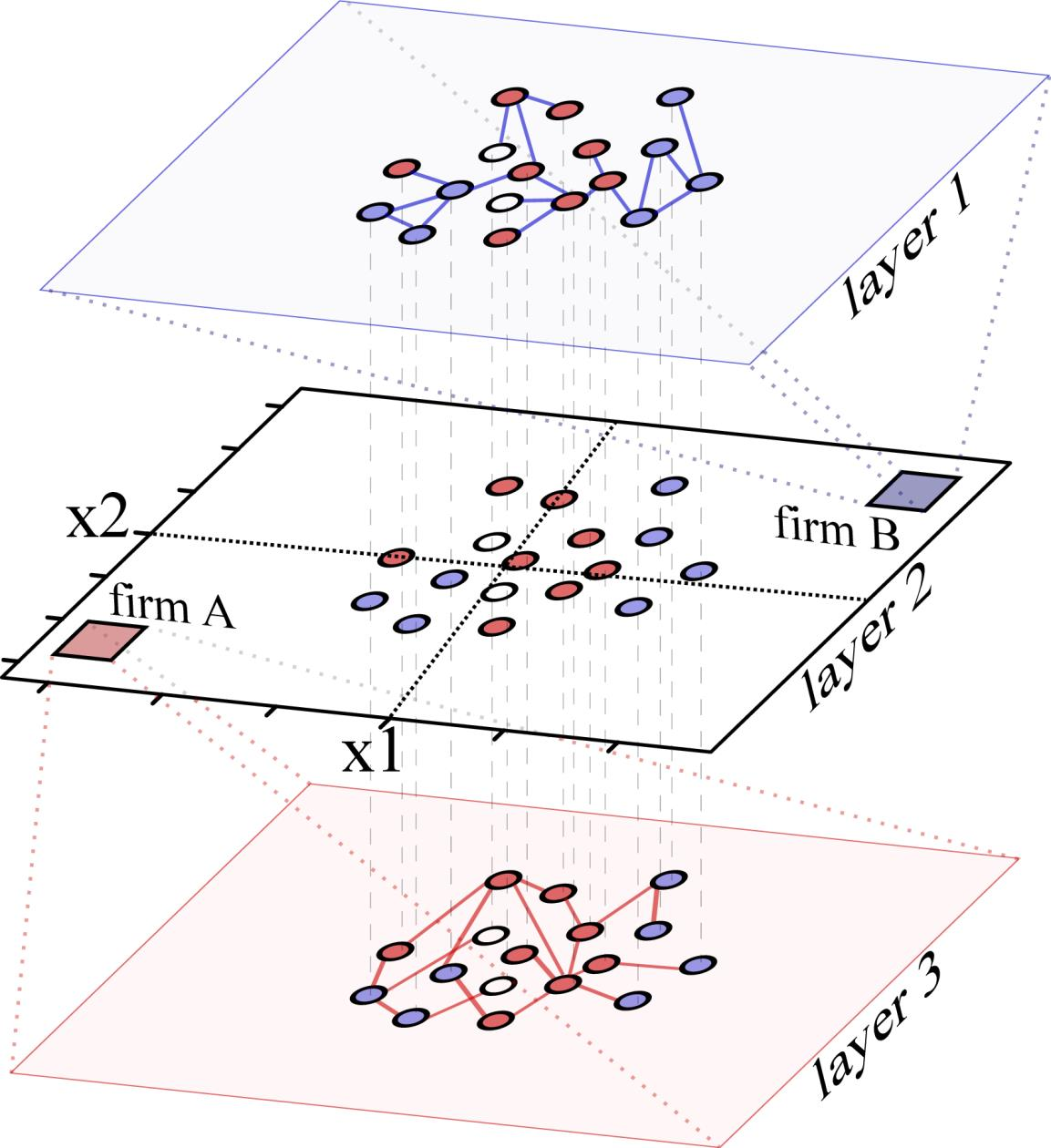
The role of consumer networks in firms’ multi-characteristics competition and market-share inequality
|
[2017]
|
|
Garas, Antonios;
Lapatinas, Athanasios
|
Structural Change and Economic Dynamics,
pages: 76-86,
volume: 43
|
more» «less
|
Abstract
We develop a location analysis spatial model of firms' competition in multi-characteristics space, where consumers' opinions about the firms' products are distributed on multilayered networks. Firms do not compete on price but only on location upon the products' multi-characteristics space, and they aim to attract the maximum number of consumers. Boundedly rational consumers have distinct ideal points/tastes over the possible available firm locations but, crucially, they are affected by the opinions of their neighbors. Proposing a dynamic agent-based analysis on firms' location choice we characterize multi-dimensional product differentiation competition as adaptive learning by firms' managers and we argue that such a complex systems approach advances the analysis in alternative ways, beyond game-theoretic calculations.

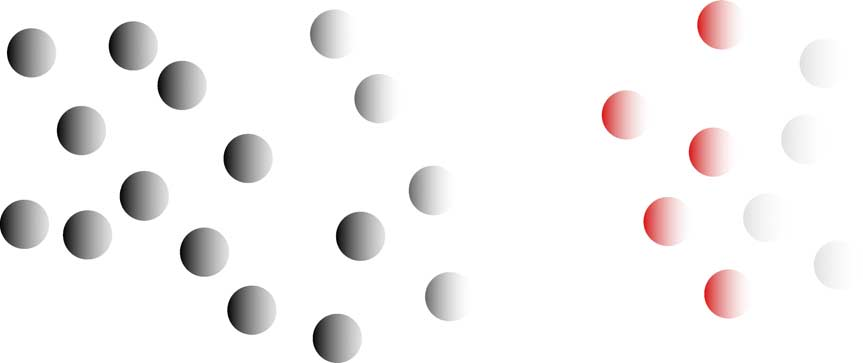
Leaking privacy and shadow profiles in online social networks
|
[2017]
|
|
Garcia, David
|
Science Advances,
volume: 3,
number: 8
|
more» «less
|
Abstract
Social interaction and data integration in the digital society can affect the control that individuals have on their privacy. Social networking sites can access data from other services, including user contact lists where nonusers are listed too. Although most research on online privacy has focused on inference of personal information of users, this data integration poses the question of whether it is possible to predict personal information of nonusers. This article tests the shadow profile hypothesis, which postulates that the data given by the users of an online service predict personal information of nonusers. Using data from a disappeared social networking site, we perform a historical audit to evaluate whether personal data of nonusers could have been predicted with the personal data and contact lists shared by the users of the site. We analyze personal information of sexual orientation and relationship status, which follow regular mixing patterns in the social network. Going back in time over the growth of the network, we measure predictor performance as a function of network size and tendency of users to disclose their contact lists. This article presents robust evidence supporting the shadow profile hypothesis and reveals a multiplicative effect of network size and disclosure tendencies that accelerates the performance of predictors. These results call for new privacy paradigms that take into account the fact that individual privacy decisions do not happen in isolation and are mediated by the decisions of others.

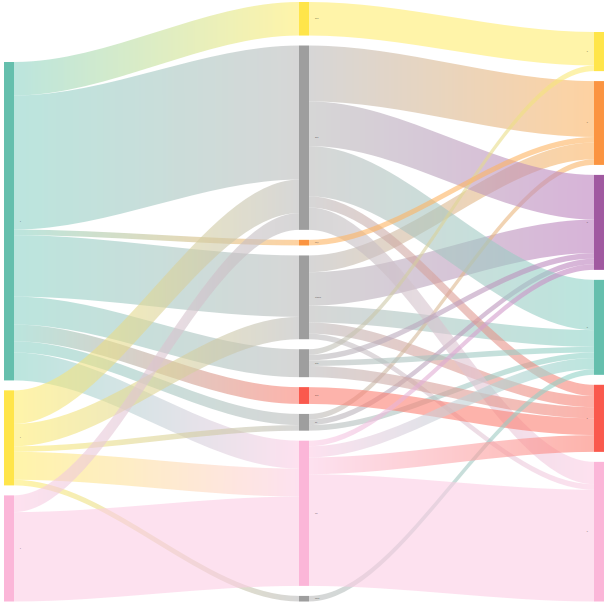
From Relational Data to Graphs: Inferring Significant Links Using Generalized Hypergeometric Ensembles
|
[2017]
|
|
Casiraghi, Giona;
Nanumyan, Vahan;
Scholtes, Ingo;
Schweitzer, Frank
|
SocInfo 2017,
pages: 111--120
|
more» «less
|
Abstract
The inference of network topologies from relational data is an important problem in data analysis. Exemplary applications include the reconstruction of social ties from data on human interactions, the inference of gene co-expression networks from DNA microarray data, or the learning of semantic relationships based on co-occurrences of words in documents. Solving these problems requires techniques to infer significant links in noisy relational data. In this short paper, we propose a new statistical modeling framework to address this challenge. It builds on generalized hypergeometric ensembles, a class of generative stochastic models that give rise to analytically tractable probability spaces of directed, multi-edge graphs. We show how this framework can be used to assess the significance of links in noisy relational data. We illustrate our method in two data sets capturing spatio-temporal proximity relations between actors in a social system. The results show that our analytical framework provides a new approach to infer significant links from relational data, with interesting perspectives for the mining of data on social systems.


Data-driven modeling of collaboration networks: A cross-domain analysis
|
[2017]
|
|
Tomasello, Mario Vincenzo;
Vaccario, Giacomo;
Schweitzer, Frank
|
EPJ Data Sci.,
pages: 22,
volume: 6
|
more» «less
|
Abstract
We analyze large-scale data sets about collaborations from two different domains: economics, specifically 22.000 R&D alliances between 14.500 firms, and science, specifically 300.000 co-authorship relations between 95.000 scientists. Considering the different domains of the data sets, we address two questions: (a) to what extent do the collaboration networks reconstructed from the data share common structural features, and (b) can their structure be reproduced by the same agent-based model. In our data-driven modeling approach we use aggregated network data to calibrate the probabilities at which agents establish collaborations with either newcomers or established agents. The model is then validated by its ability to reproduce network features not used for calibration, including distributions of degrees, path lengths, local clustering coefficients and sizes of disconnected components. Emphasis is put on comparing domains, but also sub-domains (economic sectors, scientific specializations). Interpreting the link probabilities as strategies for link formation, we find that in R&D collaborations newcomers prefer links with established agents, while in co-authorship relations newcomers prefer links with other newcomers. Our results shed new light on the long-standing question about the role of endogenous and exogenous factors (i.e., different information available to the initiator of a collaboration) in network formation.


Quantifying and suppressing ranking bias in a large citation network
|
[2017]
|
|
Vaccario, Giacomo;
Medo, Matus;
Wider, Nicolas;
Mariani, Manuel S.
|
Journal of Informetrics,
pages: 766-782,
volume: 11,
number: 3
|
more» «less
|
Abstract
It is widely recognized that citation counts for papers from different fields cannot be directly compared because different scientific fields adopt different citation practices. Citation counts are also strongly biased by paper age since older papers had more time to attract citations. Various procedures aim at suppressing these biases and give rise to new normalized indicators, such as the relative citation count. We use a large citation dataset from Microsoft Academic Graph and a new statistical framework based on the Mahalanobis distance to show that the rankings by well known indicators, including the relative citation count and Google's PageRank score, are significantly biased by paper field and age. Our statistical framework to assess ranking bias allows us to exactly quantify the contributions of each individual field to the overall bias of a given ranking. We propose a general normalization procedure motivated by the z-score which produces much less biased rankings when applied to citation count and PageRank score.


Controllability of temporal networks: An analysis using higher-order networks
|
[2017]
|
|
Zhang, Yan;
Garas, Antonios;
Scholtes, Ingo
|
arXiv:1701.06331
|
more» «less
|
Abstract
In this manuscript, we show how higher-order graphical models can be applied to study the controllability of networked systems with dynamic topologies. Studying empirical data on temporal networks, we specifically show that the order correlations in the activation sequence of links can both increase or reduce the time needed to achieve full controllability. We then demonstrate how spectral properties of higher-order graphical models can be used to analytically explain the effect of order correlations on controllability in temporal networks.

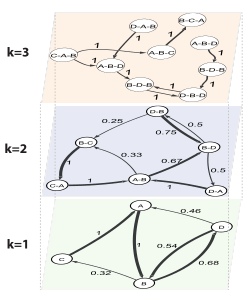
When is a Network a Network? Multi-Order Graphical Model Selection in Pathways and Temporal Networks
|
[2017]
|
|
Scholtes, Ingo
|
Proceedings of the 23rd ACM SIGKDD International Conference on Knowledge Discovery and Data Mining, Halifax, Nova Scotia, Canada
|
more» «less
|
Abstract
We introduce a framework for the modeling of sequential data capturing pathways of varying lengths observed in a network. Such data are important, e.g., when studying click streams in information networks, travel patterns in transportation systems, information cascades in social networks, biological pathways or time-stamped social interactions. While it is common to apply graph analytics and network analysis to such data, recent works have shown that temporal correlations can invalidate the results of such methods. This raises a fundamental question: when is a network abstraction of sequential data justified? Addressing this open question, we propose a framework which combines Markov chains of multiple, higher orders into a multi-layer graphical model that captures temporal correlations in pathways at multiple length scales simultaneously. We develop a model selection technique to infer the optimal number of layers of such a model and show that it outperforms previously used Markov order detection techniques. An application to eight real-world data sets on pathways and temporal networks shows that it allows to infer graphical models which capture both topological and temporal characteristics of such data. Our work highlights fallacies of network abstractions and provides a principled answer to the open question when they are justified. Generalizing network representations to multi-order graphical models, it opens perspectives for new data mining and knowledge discovery algorithms.

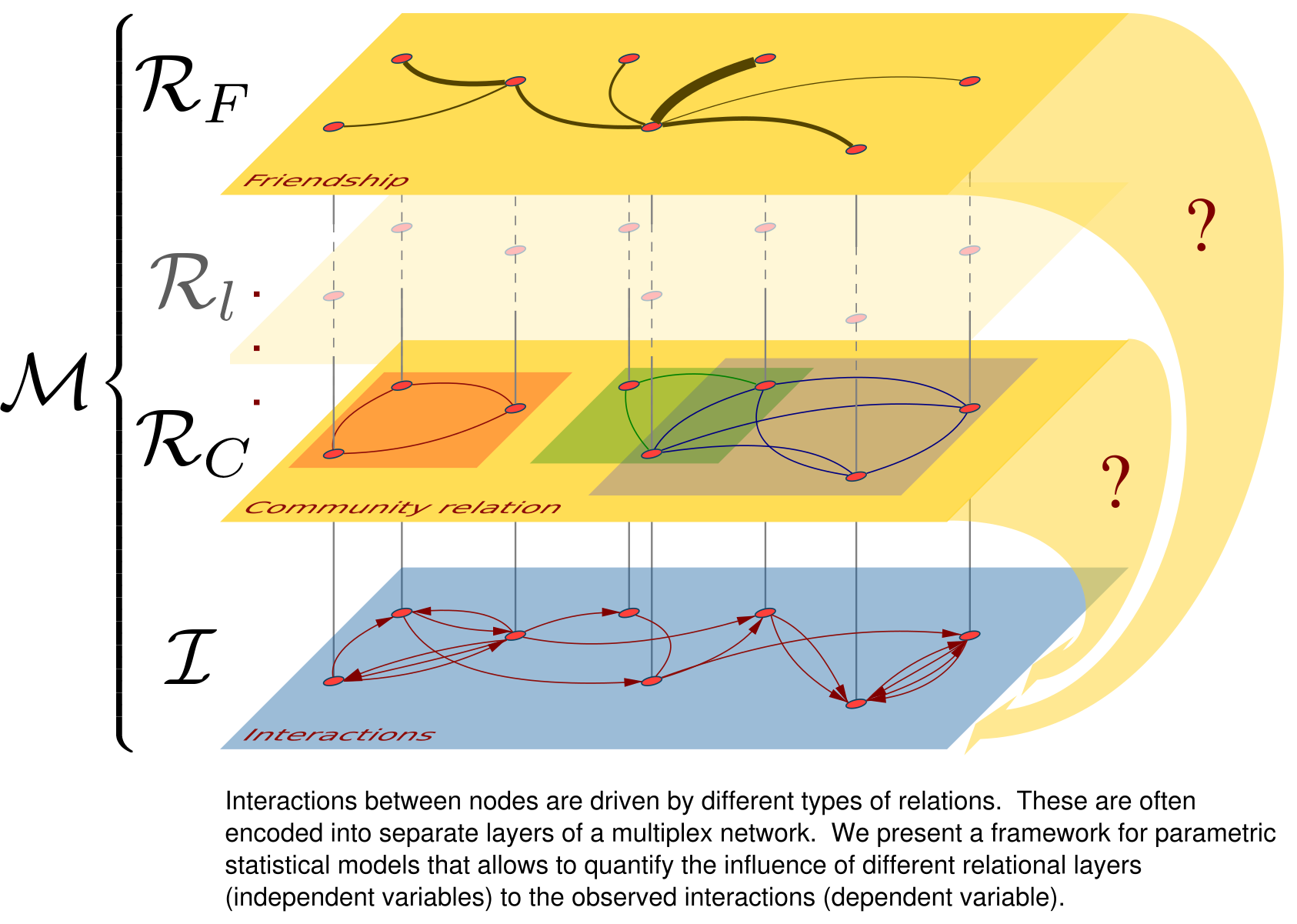
Multiplex Network Regression: How do relations drive interactions?
|
[2017]
|
|
Casiraghi, Giona
|
arXiv e-print,
pages: 1-- 17
|
more» «less
|
Abstract
We introduce a statistical method to investigate the impact of dyadic relations on complex networks generated from repeated interactions. It is based on generalised hypergeometric ensembles, a class of statistical network ensembles developed recently. We represent different types of known relations between system elements by weighted graphs, separated in the different layers of a multiplex network. With our method we can regress the influence of each relational layer, the independent variables, on the interaction counts, the dependent variables. Moreover, we can test the statistical significance of the relations as explanatory variables for the observed interactions. To demonstrate the power of our approach and its broad applicability, we will present examples based on synthetic and empirical data.

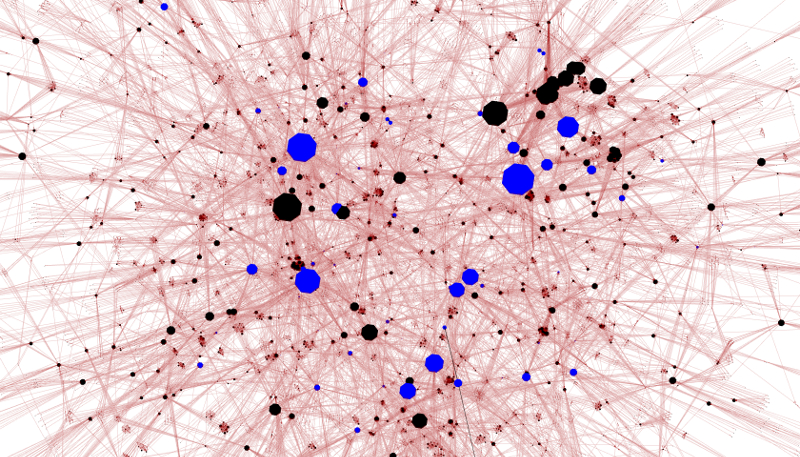
Quantifying the effect of editor-author relations on manuscript handling times
|
[2017]
|
|
Sarigol, Emre;
Garcia, David;
Scholtes, Ingo;
Schweitzer, Frank
|
Scientometrics,
pages: 609–631,
volume: 113,
number: 1
|
more» «less
|
Abstract
In this article we study to what extent the academic peer review pro-cess is influenced by social relations between the authors of a manuscript and the editor handling the manuscript. Taking the Open Access journal PlosOne as a case study, our analysis is based on a data set of more than 100,000 articles pub-lished between 2007 and 2015. Using available data on handling editor, submission and acceptance time of manuscripts, we study the question whether co-authorship relations between authors and the handling editor affect the manuscript handling time, i.e. the time taken between the submission and acceptance of a manuscript. Our analysis reveals (i) that editors handle papers co-authored by previous col-laborators significantly more often than expected at random, and (ii) that such prior co-author relations are significantly related to faster manuscript handling. Addressing the question whether these shorter manuscript handling times can be explained by the quality of publications, we study the number of citations and downloads which accepted papers eventually accumulate. Moreover, we consider the influence of additional (social) factors, such as the editor’s experience, the top-ical similarity between authors and editors, as well as reciprocal citation relations between authors and editors. Our findings show that, even when correcting for other factors like time, experience, and performance, prior co-authorship relations have a large and significant influence on manuscript handling times, speeding up the editorial decision on average by 19 days.

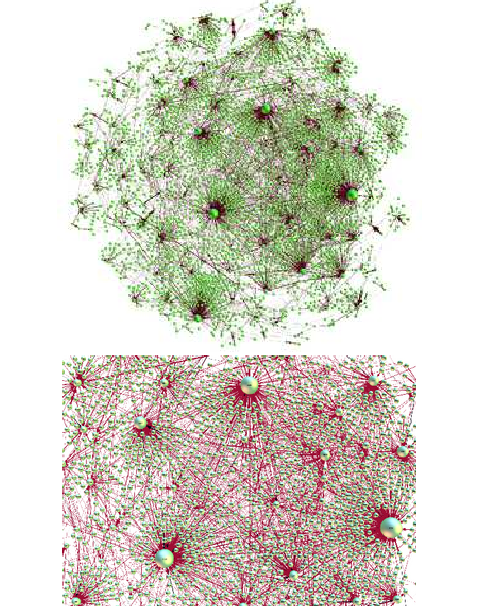
Agent-Based Simulations of Emotional Dialogs in the Online Social Network MySpace
|
[2017]
|
|
Tadic, Bosiljka;
Suvakov, Milovan;
Garcia, David;
Schweitzer, Frank
|
Cyberemotions: Collective Emotions in Cyberspace
|
more» «less
|
Abstract
Quantitative analysis of the empirical data from online social networks reveals the occurrence of group dynamics in which the user’s emotions are involved. Full understanding of the underlying mechanisms, however, remains a challenging task. Using agent-based computer simulations, in this work we study the dynamics of emotional communications in online social networks. The rules that guide how the agents interact, are motivated by actual online social systems. The realistic network structure and some key parameters are inferred from the empirical dataset compiled from the MySpace social network. An agent’s emotional state is characterized by two variables representing emotional arousal—reactivity to stimuli, and valence—attractiveness or averseness, by which a commonly known emotion can be identified. Elevated arousal triggers an agent’s action. In the simulations, each message is identified as carrying an agent’s emotion along a network link; an aggregated and continuously aging impact of these messages on the recipient agent is considered. Our results indicate that group behavior may arise from individual emotional actions of agents; the collective states appear, which are characterized by temporal correlations and predominantly positive emotions, in analogy to the empirical system; the driving signal—rate of the user stepping into the online world—has a profound effect on building the coherent behaviors that are observed in online social networks. Moreover, our simulations suggest that spreading patterns may differ for the emotions with the entirely different positive and negative emotional content.

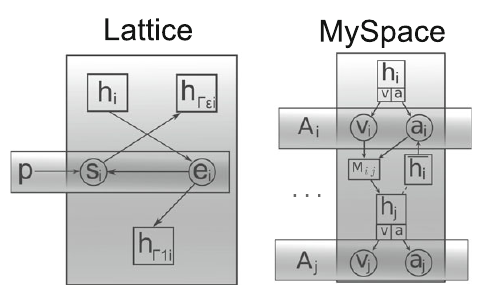
An Agent-Based Modeling Framework for Online Collective Emotions
|
[2017]
|
|
Garcia, David;
Garas, Antonios;
Schweitzer, Frank
|
Cyberemotions: Collective Emotions in Cyberspace
|
more» «less
|
Abstract
Online communication takes a variety of shapes in the different technological media that allow users interact with each other, with their friends, or with arbitrarily large groups. These serve as breeding grounds for collective emotions, in which large amounts of users share emotional states through time. We present our modeling framework for collective emotions in online communities, which can be adapted for the different kinds of online interaction present in the cyberspace. This framework allows the design of agent-based models, in which agents’ emotional states are represented according to psychological theories. This approach aims at a unification of modeling efforts, connecting the sentiment analysis of big data with psychological experiments, through tractable agent-based models. We illustrate the applications of this framework to different online communities, including product reviews, chatrooms, virtual realities, and social networking sites. We show how our model reproduces properties of collective emotions in the reviews of Amazon, and the group discussions of IRC channels. We comment the applications of this framework for data-driven simulation of emotions, and how we formulate testable hypotheses of emotion dynamics for future research on the field.

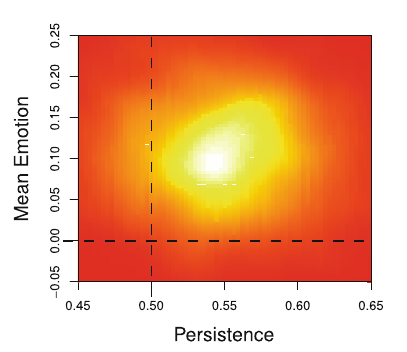
Zooming in: Studying Collective Emotions with Interactive Affective Systems
|
[2017]
|
|
Skowron, Marcin;
Rank, Stefan;
Garcia, David;
Hoyst, Janusz A.
|
Cyberemotions: Collective Emotions in Cyberspace
|
more» «less
|
Abstract
Computer-mediated communication between humans is at the center of the formation of collective emotions on the Internet. This chapter presents how interactive affective systems can be applied in order to study the role of emotion in online communication at the micro-scale, i.e. between individual users or between users and artificial communication partners. Specifically, we report on the effect of a simulated conversational partner’s affective profile, the use of fine-grained communication scenarios and social interaction context on changes in emotional states and expressed affect of users as well as their communication patterns. Based on these findings, we propose applications for such systems focused on supporting different e-communities with real-time information and discuss ethical implications of such systems.

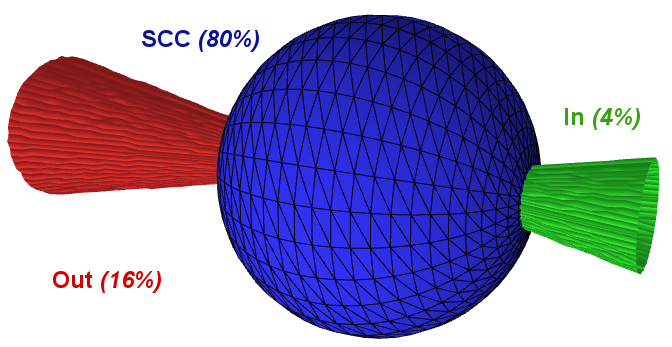
Understanding Popularity, Reputation, and Social Influence in the Twitter Society
|
[2017]
|
|
Garcia, David;
Mavrodiev, Pavlin;
Casati, Daniele;
Schweitzer, Frank
|
Policy & Internet
|
more» «less
|
Abstract
The pervasive presence of online media in our society has transferred a significant part of political deliberation to online forums and social networking sites. This article examines popularity, reputation, and social influence on Twitter using large-scale digital traces from 2009 to 2016. We process network information on more than 40 million users, calculating new global measures of reputation that build on the D-core decomposition and the bow-tie structure of the Twitter follower network. We integrate our measurements of popularity, reputation, and social influence to evaluate what keeps users active, what makes them more popular, and what determines their influence. We find that there is a range of values in which the risk of a user becoming inactive grows with popularity and reputation. Popularity in Twitter resembles a proportional growth process that is faster in its strongly connected component, and that can be accelerated by reputation when users are already popular. We find that social influence on Twitter is mainly related to popularity rather than reputation, but that this growth of influence with popularity is sublinear. The explanatory and predictive power of our method shows that global network metrics are better predictors of inactivity and social influence, calling for analyses that go beyond local metrics like the number of followers.


The Rise and Fall of R&D Networks
|
[2017]
|
|
Tomasello, Mario Vincenzo;
Napoletano, Mauro;
Garas, Antonios;
Schweitzer, Frank
|
ICC - Industrial and Corporate Change,
pages: 617-646,
volume: 26,
number: 4
|
more» «less
|
Abstract
Drawing on a large database of publicly announced R&D alliances, we empirically investigate the evolution of R&D networks and the process of alliance formation in several manufacturing sectors over a 24-year period (1986-2009). Our goal is to empirically evaluate the temporal and sectoral robustness of a large set of network indicators, thus providing a more complete description of R&D networks with respect to the existing literature. We find that most network properties are not only invariant across sectors, but also independent of the scale of aggregation at which they are observed, and we highlight the presence of core-periphery architectures in explaining some properties emphasized in previous empirical studies (e.g. asymmetric degree distributions and small worlds). In addition, we show that many properties of R&D networks are characterized by a rise-and-fall dynamics with a peak in the mid-nineties. We find that such dynamics is driven by mechanisms of accumulative advantage, structural homophily and multiconnectivity. In particular, the change from the "rise" to the "fall" phase is associated to a structural break in the importance of multiconnectivity.


Newcomers vs. incumbents: How firms select their partners for R&D collaborations
|
[2017]
|
|
Garas, Antonios;
Tomasello, Mario Vincenzo;
Schweitzer, Frank
|
arXiv:1403.3298
|
more» «less
|
Abstract
This paper studies the selection of partners for R&D collaborations of firms both empirically, by analyzing a large data set of R&D alliances over 25 years, and theoretically, by utilizing an agent-based model of alliance formation. We quantify the topological position of a firm in the R&D network by means of the weighted k-core decomposition which assigns a coreness value to each firm. The evolution of these coreness values over time reconstructs the career path of individual firms, where lower coreness indicates a better integration of firms in an evolving R&D network. Using a large patent dataset, we demonstrate that coreness values strongly correlate with the number of patents of a firm. Analyzing coreness differences between firms and their partners, we identify a change in selecting partners: less integrated firms choose partners of similar coreness until they reach their best network position. After that, well integrated firms (with low coreness) choose preferably partners with high coreness, either newcomers or firms from the periphery. We use the agent-based model to test whether this change in behavior needs to be explained by means of strategic considerations, i.e. firms switching their strategy in choosing partners dependent on their network position. We find that the observed behavior can be well reproduced without such strategic considerations, this way challenging the role of strategies in explaining macro patterns of collaborations.
Interconnected Networks
|
[2016]
|
|
Garas, Antonios
|
|
|
more» «less
|
Abstract
This volume provides an introduction to and overview of the emerging field of interconnected networks which include multilayer or multiplex networks, as well as networks of networks. Such networks present structural and dynamical features quite different from those observed in isolated networks. The presence of links between different networks or layers of a network typically alters the way such interconnected networks behave – understanding the role of interconnecting links is therefore a crucial step towards a more accurate description of real-world systems. While examples of such dissimilar properties are becoming more abundant – for example regarding diffusion, robustness and competition – the root of such differences remains to be elucidated.
Each chapter in this topical collection is self-contained and can be read on its own, thus making it also suitable as reference for experienced researchers wishing to focus on a particular topic.

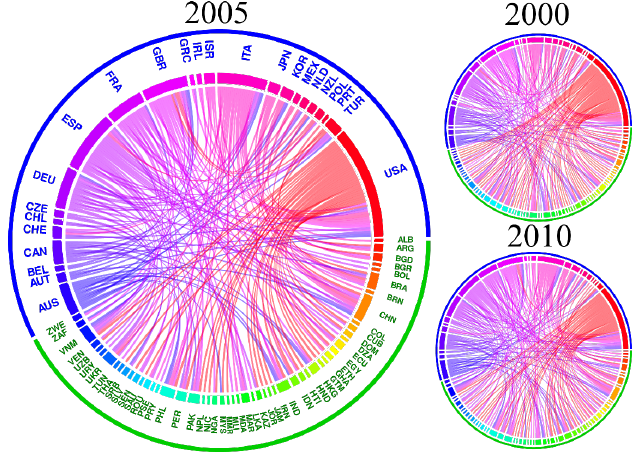
The relation between migration and FDI in the OECD from a complex network perspective
|
[2016]
|
|
Garas, Antonios;
Lapatinas, Athanasios;
Poulios, Konstantinos
|
Advances in Complex Systems,
pages: 1650009
|
more» «less
|
Abstract
We explore the relationship between human migration and OECD’s Foreign Direct Investment
(FDI) using a gravity equation enriched with variables that account for complex-network effects.
Based on a panel data analysis, we find a strong positive correlation between the migration network
and the FDI network, which can be mostly explained by countries’ economic/demographic sizes
and geographical distance. We highlight the existence of a stronger positive FDI relationship in
pairs of countries that are more central in the migration network. Both intensive and extensive
forms of centrality are FDI enhancing. Illuminating this result, we show that bilateral FDI between
any two countries is further affected positively by the complex web of 'third party'
corridors/migration stocks of the international migration network. Our findings are consistent
whether we consider bilateral FDI and bilateral migration figures, or we focus on the outward FDI
and the respective inward migration of the OECD countries.


Anticipated Shocks in Online Activity: Response Functions of Attention and Word-of-mouth Processes
|
[2016]
|
|
Stommel, Sebastian;
Garcia, David;
Abisheva, Adiya;
Schweitzer, Frank
|
Proceedings of the 8th ACM Conference on Web Science
|
more» «less
|
Abstract
We test the existence of anticipated shocks in online activity, a class of collective dynamics that does not fit in the state of the art theory on social response functions. We use data on shares and views to Youtube videos, measuring their time series to classify them according to their dynamical class. We find evidence of the existence of anticipated shocks, and that they are more likely to appear in word-of-mouth interaction than in attention dynamics. Our results show that not all exogenous events in online activity are unexpected, calling for new models that differentiate social interaction and attention dynamics.

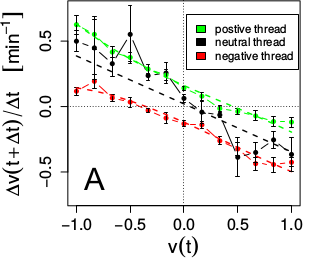
The Dynamics of Emotions in Online Interaction
|
[2016]
|
|
Garcia, David;
Kappas, Arvid;
Kuster, Dennis;
Schweitzer, Frank
|
Royal Society Open Science,
volume: 3,
number: 160059
|
more» «less
|
Abstract
We study the changes in emotional states induced by reading and participating in online discussions, empirically testing a computational model of online emotional interaction. Using principles of dynamical systems, we quantify changes in valence and arousal through subjective reports, as recorded in three independent studies including 207 participants (110 female). In the context of online discussions, the dynamics of valence and arousal are composed of two forces: an internal relaxation towards baseline values independent of the emotional charge of the discussion, and a driving force of emotional states that depends on the content of the discussion. The dynamics of valence show the existence of positive and negative tendencies, while arousal increases when reading emotional content regardless of its polarity. The tendency of participants to take part in the discussion increases with positive arousal. When participating in an online discussion, the content of participants' expression depends on their valence, and their arousal significantly decreases afterwards as a regulation mechanism. We illustrate how these results allow the design of agent-based models to reproduce and analyze emotions in online communities. Our work empirically validates the microdynamics of a model of online collective emotions, bridging online data analysis with research in the laboratory.

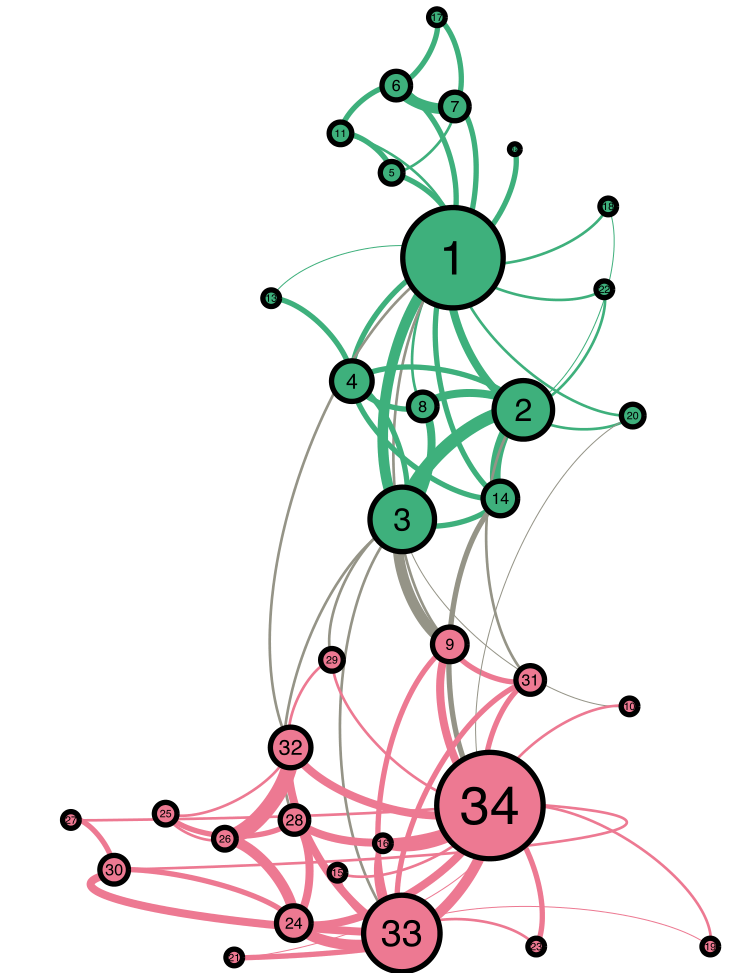
Generalized Hypergeometric Ensembles: Statistical Hypothesis Testing in Complex Networks
|
[2016]
|
|
Casiraghi, Giona;
Nanumyan, Vahan;
Scholtes, Ingo;
Schweitzer, Frank
|
ArXiv e-prints
|
more» «less
|
Abstract
Statistical ensembles define probability spaces of all networks consistent with given aggregate statistics and have become instrumental in the analysis of relational data on networked systems. Their numerical and analytical study provides the foundation for the inference of topological patterns, the definition of network-analytic measures, as well as for model selection and statistical hypothesis testing. Contributing to the foundation of these important data science techniques, in this article we introduce generalized hypergeometric ensembles, a framework of analytically tractable statistical ensembles of finite, directed and weighted networks. This framework can be interpreted as a generalization of the classical configuration model, which is commonly used to randomly generate networks with a given degree sequence or distribution. Our generalization rests on the introduction of dyadic link propensities, which capture the degree-corrected tendencies of pairs of nodes to form edges between each other. Studying empirical and synthetic data, we show that our approach provides broad perspectives for community detection, model selection and statistical hypothesis testing.

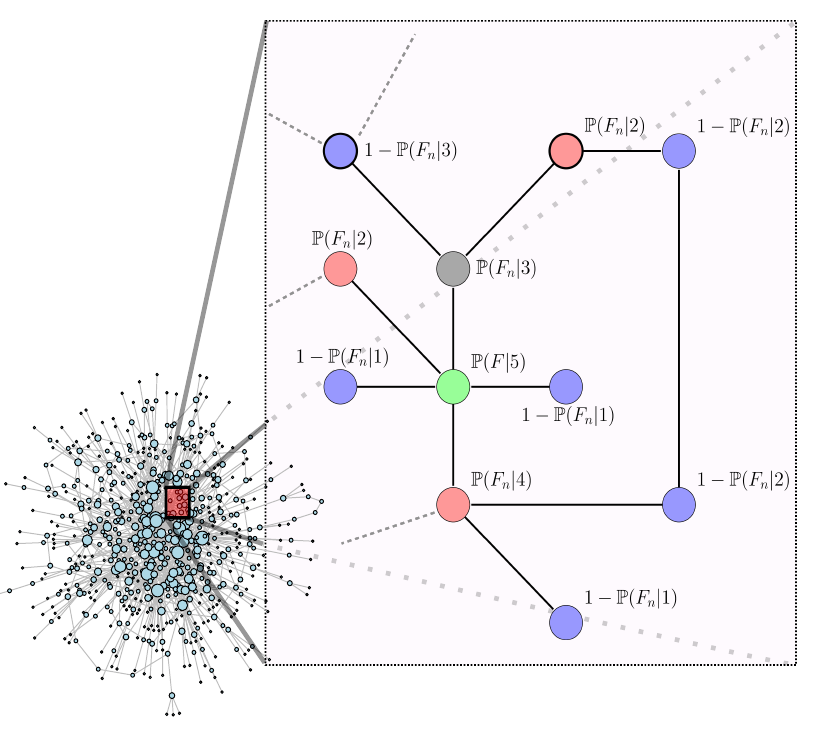
How damage diversification can reduce systemic risk
|
[2016]
|
|
Burkholz, Rebekka;
Garas, Antonios;
Schweitzer, Frank
|
Physical Review E,
pages: 042313,
volume: 93
|
more» «less
|
Abstract
We study the influence of risk diversification on cascading failures in weighted complex networks, where weighted directed links represent exposures between nodes. These weights result from different diversification strategies and their adjustment allows us to reduce systemic risk significantly by topological means. As an example, we contrast a classical exposure diversification (ED) approach with a damage diversification (DD) variant. The latter reduces the loss that the failure of high degree nodes generally inflict to their network neighbors and thus hampers the cascade amplification. To quantify the final cascade size and obtain our results, we develop a branching process approximation taking into account that inflicted losses cannot only depend on properties of the exposed, but also of the failing node. This analytic extension is a natural consequence of the paradigm shift from individual to system safety. To deepen our understanding of the cascade process, we complement this systemic perspective by a mesoscopic one: an analysis of the failure risk of nodes dependent on their degree. Additionally, we ask for the role of these failures in the cascade amplification.


Women Through the Glass-Ceiling: Gender Asymmetries in Wikipedia
|
[2016]
|
|
Wagner, Claudia;
Graells - Garrido, Eduardo;
Garcia, David
|
EPJ Data Science,
volume: 5,
number: 5
|
more» «less
|
Abstract
Contributing to the writing of history has never been as easy as it is today thanks to Wikipedia, a community-created encyclopedia that aims to document the world's knowledge from a neutral point of view. Though everyone can participate it is well known that the editor community has a narrow diversity, with a majority of white male editors. While this participatory gender gap has been studied extensively in the literature, this work sets out to assess potential gender inequalities in Wikipedia articles along different dimensions: notability, topical focus, linguistic bias, structural properties and meta-data presentation. We find that (i) women in Wikipedia are more notable than men which we interpret as the outcome of a subtle glass ceiling effect; (ii) family-, gender-and relationship-related topics are more present in biographies about women; (iii) linguistic biases manifest in Wikipedia since abstract terms tend to be used to describe positive aspects in the biographies of men and negative aspects in the biographies of women; and (iv) there are structural differences in terms of meta-data and hyperlinks, which have consequences for information-seeking activities. While some differences are expected, due to historical and social contexts, other differences are attributable to Wikipedia editors. The implications of such differences are discussed, specially having Wikipedia contribution policies in mind. We hope that our work contributes to increase awareness about, first, gender issues in the content of Wikipedia, and second, the different levels on which gender biases can manifest on the Web.

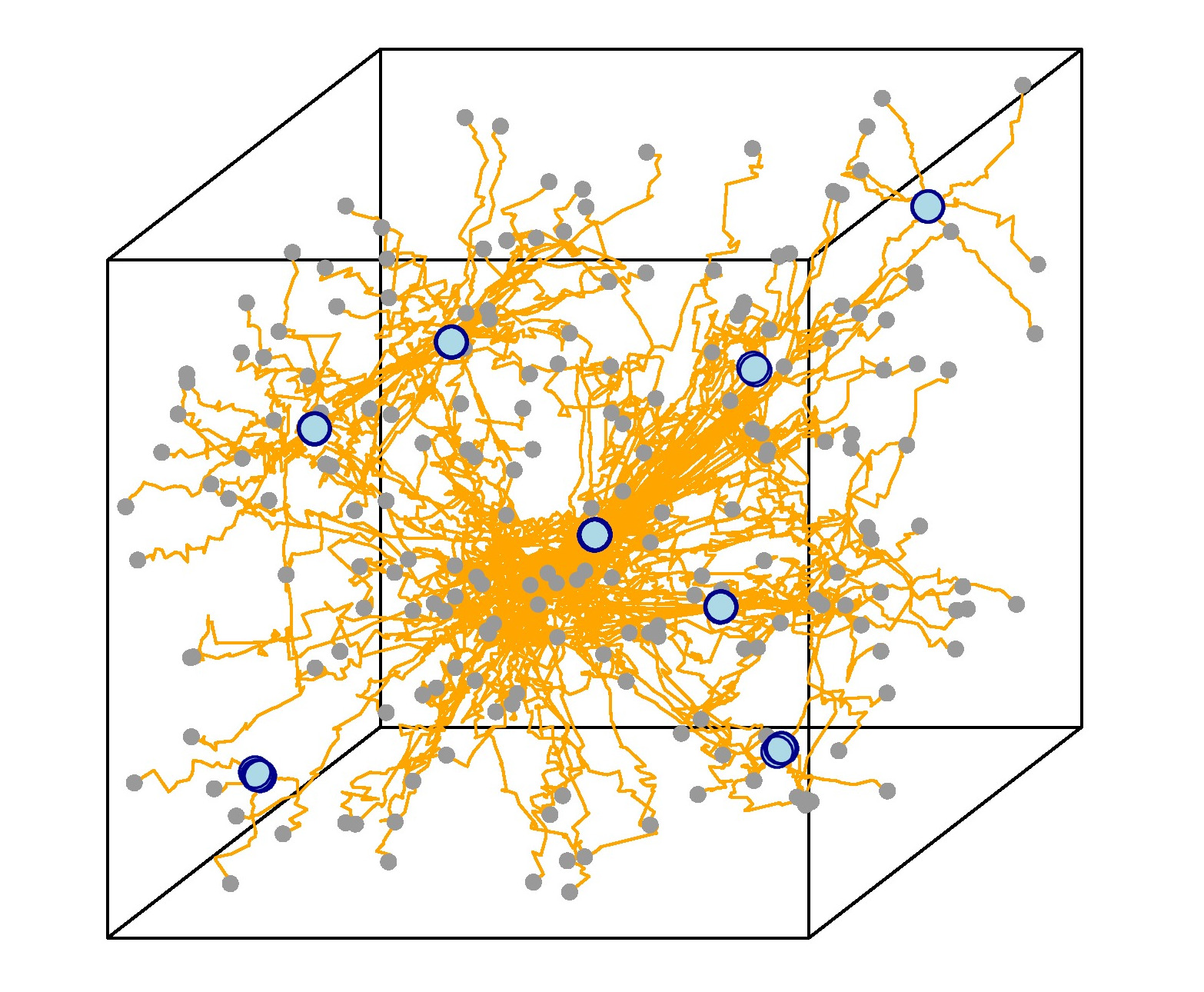
A model of dynamic rewiring and knowledge exchange in R&D networks
|
[2016]
|
|
Tomasello, Mario Vincenzo;
Tessone, Claudio Juan;
Schweitzer, Frank
|
Advances in Complex Systems,
volume: 19,
number: 1 - 2
|
more» «less
|
Abstract
This paper investigates the process of knowledge exchange in inter-firm Research and Development (R&D) alliances by means of an agent-based model. Extant research has pointed out that firms select alliance partners considering both network-related and network-unrelated features (e.g., social capital versus complementary knowledge stocks). In our agent-based model, firms are located in a metric knowledge space. The interaction rules incorporate an exploration phase and a knowledge transfer phase, during which firms search for a new partner and then evaluate whether they can establish an alliance to exchange their knowledge stocks. The model parameters determining the overall system properties are the rate at which alliances form and dissolve and the agents' interaction radius. Next, we define a novel indicator of performance, based on the distance traveled by the firms in the knowledge space. Remarkably, we find that - depending on the alliance formation rate and the interaction radius - firms tend to cluster around one or more attractors in the knowledge space, whose position is an emergent property of the system. And, more importantly, we find that there exists an inverted U-shaped dependence of the network performance on both model parameters.

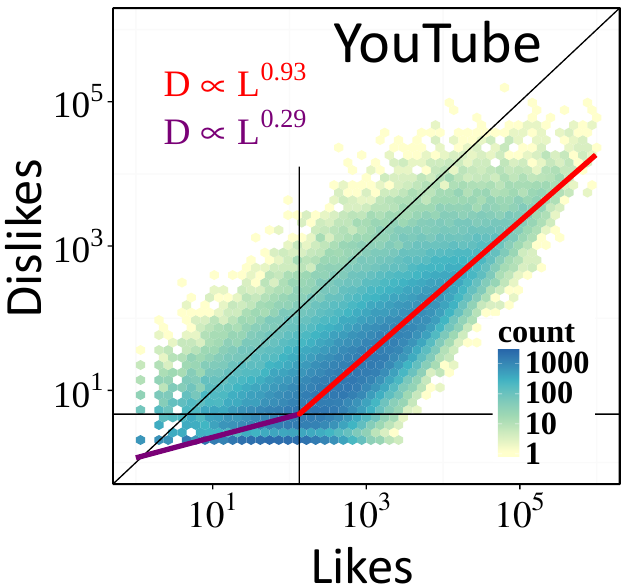
When the Filter Bubble Bursts: Collective Evaluation Dynamics in Online Communities
|
[2016]
|
|
Abisheva, Adiya;
Garcia, David;
Schweitzer, Frank
|
Proceedings of the 8th ACM Conference on Web Science
|
more» «less
|
Abstract
Through the analysis of collective upvotes and downvotes in multiple social media, we discover the bimodal regime of collective evaluations. When online content surpasses the local social context by reaching a threshold of collective attention, negativity grows faster with positivity, which serves as a trace of the burst of a filter bubble. To attain a global audience, we show that emotions expressed in online content has a significant effect and also play a key role in creating polarized opinions.
Remarks
Accepted as a poster.


A conceptual approach to model co-evolution of urban structures
|
[2016]
|
|
Schweitzer, Frank;
Nanumyan, Vahan
|
International Journal of Space Structures,
pages: 43-51,
volume: 31,
number: 1
|
more» «less
|
Abstract
Urban structures encompass settlements, characterized by the spatial distribution of built-up areas, and also transportation structures, to connect these built-up areas. These two structures are very different in their origin and function, fulfilling complementary needs: (1) to access space and (2) to occupy space. Their evolution cannot be understood by looking at the dynamics of urban aggregations and transportation systems separately. Instead, existing built-up areas feed back on the further development of transportation structures, and the availability of the latter feeds back on the future growth of urban aggregations. To model this co-evolution, we propose an agent-based approach that builds on existing agent-based models for the evolution of trail systems and urban settlements. The key element in these separate approaches is a generalized communication of agents by means of an adaptive landscape. This landscape is only generated by the agents, but once it exists, it feeds back on their further actions. The emerging trail system or urban aggregation results as a self-organized structure from these collective interactions. In our co-evolutionary approach, we couple these two separate models by means of meta-agents that represent humans with their different demands for housing and mobility. We characterize our approach as a statistical ensemble approach, which allows to capture the potential of urban evolution in a bottom-up manner, but can be validated against empirical observations.

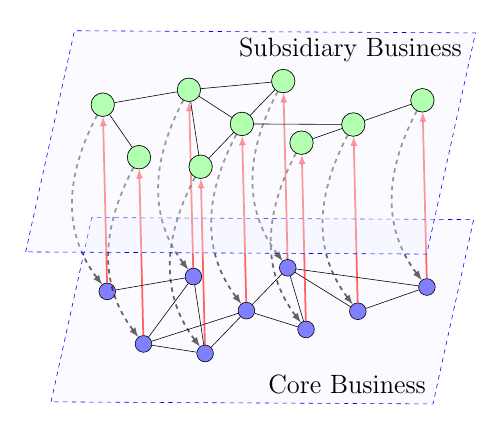
Systemic risk in multiplex networks with asymmetric coupling and threshold feedback
|
[2016]
|
|
Burkholz, Rebekka;
Leduc, Matt;
Garas, Antonios;
Schweitzer, Frank
|
Physica D,
pages: 64--72,
volume: 323-324
|
more» «less
|
Abstract
We study cascades on a two-layer multiplex network, with asymmetric feedback that depends on the coupling strength between the layers. Based on an analytical branching process approximation, we calculate the systemic risk measured by the final fraction of failed nodes on a reference layer. The results are compared with the case of a single layer network that is an aggregated representation of the two layers. We find that systemic risk in the two-layer network is smaller than in the aggregated one only if the coupling strength between the two layers is small. Above a critical coupling strength, systemic risk is increased because of the mutual amplification of cascades in the two layers. We even observe sharp phase transitions in the cascade size that are less pronounced on the aggregated layer. Our insights can be applied to a scenario where firms decide whether they want to split their business into a less risky core business and a more risky subsidiary business. In most cases, this may lead to a drastic increase of systemic risk, which is underestimated in an aggregated approach.

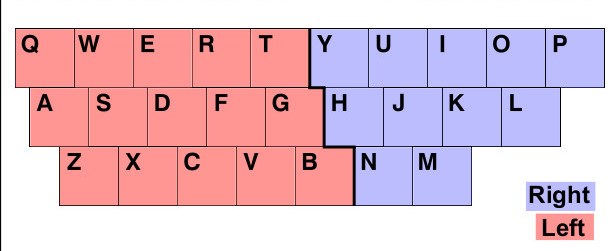
The QWERTY Effect on the Web: How Typing Shapes the Meaning of Words in Online Human-Computer Interaction
|
[2016]
|
|
Garcia, David;
Strohmaier, Markus
|
Proceedings of the 25th International Conference on World Wide Web
|
more» «less
|
Abstract
The QWERTY effect postulates that the keyboard layout influences word meanings by linking positivity to the use of the right hand and negativity to the use of the left hand. For example, previous research has established that words with more right hand letters are rated more positively than words with more left hand letters by human subjects in small scale experiments. In this paper, we perform large scale investigations of the QWERTY effect on the web. Using data from eleven web platforms related to products, movies, books, and videos, we conduct observational tests whether a hand-meaning relationship can be found in text interpretations by web users. Furthermore, we investigate whether writing text on the web exhibits the QWERTY effect as well, by analyzing the relationship between the text of online reviews and their star ratings in four additional datasets. Overall, we find robust evidence for the QWERTY effect both at the point of text interpretation (decoding) and at the point of text creation (encoding). We also find under which conditions the effect might not hold. Our findings have implications for any algorithmic method aiming to evaluate the meaning of words on the web, including for example semantic or sentiment analysis, and show the existence of "dactilar onomatopoeias" that shape the dynamics of word-meaning associations. To the best of our knowledge, this is the first work to reveal the extent to which the QWERTY effect exists in large scale human-computer interaction on the web.

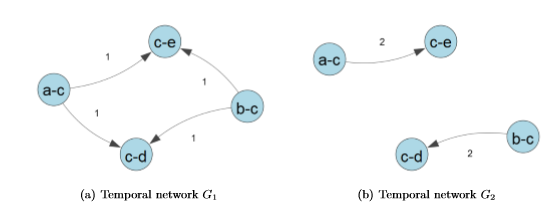
Higher-Order Aggregate Networks in the Analysis of Temporal Networks: Path structures and centralities
|
[2016]
|
|
Scholtes, Ingo;
Wider, Nicolas;
Garas, Antonios
|
European Physical Journal B,
pages: 1--15,
volume: 89,
number: 3
|
more» «less
|
Abstract
Recent research on temporal networks has highlighted the limitations of a static network perspective for our understanding of complex systems with dynamic topologies. In particular, recent works have shown that i) the specific order in which links occur in real-world temporal networks affects causality structures and thus the evolution of dynamical processes, and ii) higher-order aggregate representations of temporal networks can be used to analytically study the effect of these order correlations on dynamical processes. In this article we analyze the effect of order correlations on path-based centrality measures in real-world temporal networks. Analyzing temporal equivalents of betweenness, closeness and reach centrality in six empirical temporal networks, we first show that an analysis of the commonly used static, time-aggregated representation can give misleading results about the actual importance of nodes. We further study higher-order time-aggregated networks, a recently proposed generalization of the commonly applied static, time-aggregated representation of temporal networks. Here, we particularly define path-based centrality measures based on second-order aggregate networks, empirically validating that node centralities calculated in this way better capture the true temporal centralities of nodes than node centralities calculated based on the commonly used static (first-order) representation. Apart from providing a simple and practical method for the approximation of path-based centralities in temporal networks, our results highlight interesting perspectives for the use of higher-order aggregate networks in the analysis of time-stamped network data.

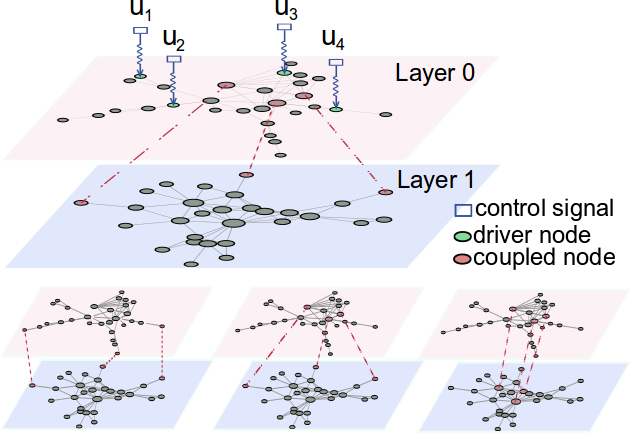
Value of peripheral nodes in controlling multilayer scale-free networks
|
[2016]
|
|
Zhang, Yan;
Garas, Antonios;
Schweitzer, Frank
|
Physical Review E,
pages: 012309,
volume: 93
|
more» «less
|
Abstract
We analyze the controllability of a two-layer network, where driver nodes can be chosen randomly only from one layer. Each layer contains a scale-free network with directed links and the node dynamics depends on the incoming links from other nodes. We combine the in-degree and out-degree values to assign an importance value w to each node, and distinguish between peripheral nodes with low w and central nodes with high w. Based on numerical simulations, we find that the controllable part of the network is larger when choosing low w nodes to connect the two layers. The control is as efficient when peripheral nodes are driver nodes as it is for the case of more central nodes. However, if we assume a cost to utilize nodes that is proportional to their overall degree, utilizing peripheral nodes to connect the two layers or to act as driver nodes is not only the most cost-efficient solution, it is also the one that performs best in controlling the two-layer network among the different interconnecting strategies we have tested.

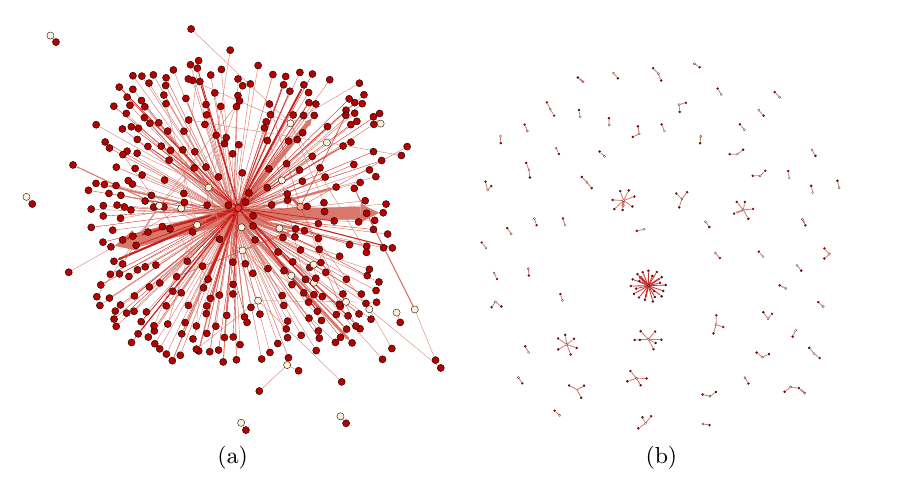
Emotions, Demographics and Sociability in Twitter Interactions
|
[2016]
|
|
Lerman, Kristina;
Arora, Megha;
Gallegos, Luciano;
Kumaraguru, Ponnurangam;
Garcia, David
|
nternational Conference in Web and Social Media (ICWSM)
|
more» «less
|
Abstract
The social connections, or ties, individuals create affect their life outcomes, for example, by providing novel information that leads to new jobs or career opportunities. A host of socioeconomic and cognitive factors are believed to affect social interactions, but few of these factors have been empirically validated. In this research work, we extracted a large corpus of data from a popular social media platform that consists of geo-referenced messages, or tweets, posted from a major US metropolitan area. We linked these tweets to US Census data through their locations. This allowed us to measure emotions expressed in tweets posted from a specific area, and also use that area's socioeconomic and demographic characteristics in the analysis. We extracted the structure of social interactions from the people mentioned in tweets from that area. We find that at an aggregate level, areas where social media users engage in stronger, less diverse online social interactions are those where they express more negative emotions, like sadness and anger. With respect to demographics, these areas have larger numbers of Hispanic residents, lower mean household income, and lower education levels. Conversely, areas with weaker, more diverse online interactions are associated with happier, more positive feelings and also have better educated, younger and higher-earning residents. Our work highlights the value of linking social media data to traditional data sources, such as US Census, to drive novel analysis of online behavior.

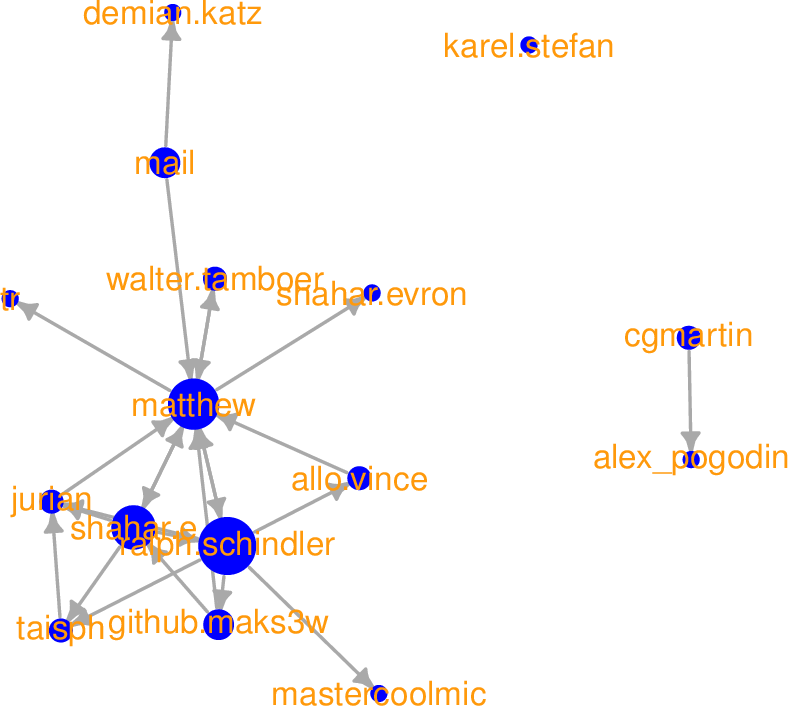
From Aristotle to Ringelmann: A large-scale analysis of team productivity and coordination in Open Source Software projects
|
[2016]
|
|
Scholtes, Ingo;
Mavrodiev, Pavlin;
Schweitzer, Frank
|
Empirical Software Engineering,
pages: 642-683,
volume: 21,
number: 2
|
more» «less
|
Abstract
Complex software development projects rely on the contribution of teams of developers, who are required to collaborate and coordinate their efforts. The productivity of such development teams, i.e., how their size is related to the produced output, is an important consideration for project and schedule management as well as for cost estimation. The majority of studies in empirical software engineering suggest that - due to coordination overhead - teams of collaborating developers become less productive as they grow in size. This phenomenon is commonly paraphrased as Brooks’ law of software project management, which states that “adding manpower to a software project makes it later”. Outside software engineering, the non-additive scaling of productivity in teams is often referred to as the Ringelmann effect, which is studied extensively in social psychology and organizational theory. Conversely, a recent study suggested that in Open Source Software (OSS) projects, the productivity of developers increases as the team grows in size. Attributing it to collective synergetic effects, this surprising finding was linked to the Aristotelian quote that “the whole is more than the sum of its parts”. Using a data set of 58 OSS projects with more than 580,000 commits contributed by more than 30,000 developers, in this article we provide a large-scale analysis of the relation between size and productivity of software development teams. Our findings confirm the negative relation between team size and productivity previously suggested by empirical software engineering research, thus providing quantitative evidence for the presence of a strong Ringelmann effect. Using fine-grained data on the association between developers and source code files, we investigate possible explanations for the observed relations between team size and productivity. In particular, we take a network perspective on developer-code associations in software development teams and show that the magnitude of the decrease in productivity is likely to be related to the growth dynamics of co-editing networks which can be interpreted as a first-order approximation of coordination requirements.
An ensemble perspective on multi-layer networks
|
[2016]
|
|
Wider, Nicolas;
Garas, Antonios;
Scholtes, Ingo;
Schweitzer, Frank
|
Interconnected Networks
|
more» «less
|
Abstract
We study properties of multi-layered, interconnected networks from an ensemble perspective, i.e. we analyze ensembles of multi-layer networks that share similar aggregate characteristics. Using a diffusive process that evolves on a multi-layer network, we analyze how the speed of diffusion depends on the aggregate characteristics of both intra- and inter-layer connectivity. Through a block-matrix model representing the distinct layers, we construct transition matrices of random walkers on multi-layer networks, and estimate expected properties of multi-layer networks using a mean-field approach. In addition, we quantify and explore conditions on the link topology that allow to estimate the ensemble average by only considering aggregate statistics of the layers. Our approach can be used when only partial information is available, like it is usually the case for real-world multi-layer complex systems.


Geography of Emotion: Where in a City are People Happier?
|
[2015]
|
|
Gallegos, Luciano;
Lerman, Kristina;
Huang, Arthur;
Garcia, David
|
Proceedings of the 25th international World Wide Web conference companion
|
more» «less
|
Abstract
Location-sharing services were built upon people's desire to share their activities and locations with others. By "checking-in" to a place, such as a restaurant, a park, gym, or train station, people disclose where they are, thereby providing valuable information about land use and utilization of services in urban areas. This information may, in turn, be used to design smarter, happier, more equitable cities. We use data from Foursquare location-sharing service to identify areas within a major US metropolitan area with many check-ins, i.e., areas that people like to use. We then use data from the Twitter microblogging platform to analyze the properties of these areas. Specifically, we have extracted a large corpus of geo-tagged messages, called tweets, from a major metropolitan area and linked them US Census data through their locations. This allows us to measure the sentiment expressed in tweets that are posted from a specific area, and also use that area's demographic properties in analysis. Our results reveal that areas with many check-ins are different from other areas within the metropolitan region. In particular, these areas have happier tweets, which also encourage people from other areas to commute longer distances to these places. These findings shed light on human mobility patterns, as well as how physical environment influences human emotions.

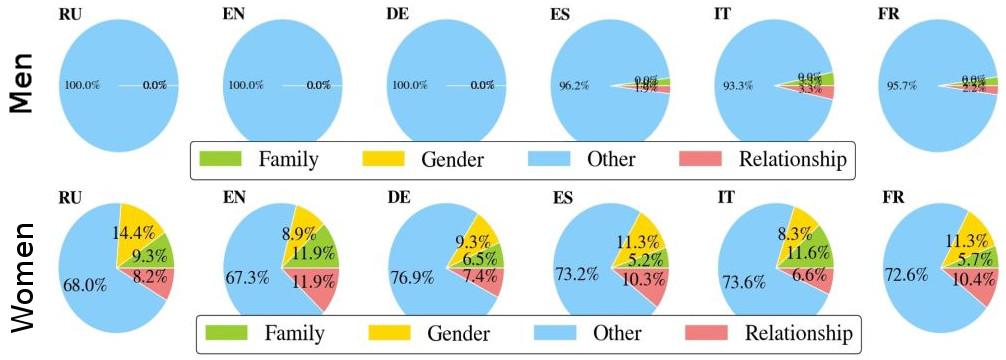
It's a Man's Wikipedia? Assessing Gender Inequality in an Online Encyclopedia
|
[2015]
|
|
Wagner, Claudia;
Garcia, David;
Jadidi, Mohsen;
Strohmaier, Markus
|
In Proceedings of the 9th International AAAI Conference on Weblogs and Social Media,
pages: 454-463
|
more» «less
|
Abstract
Wikipedia is a community-created encyclopedia that contains information about notable people from different countries, epochs and disciplines and aims to document the world’s knowledge from a neutral point of view. However, the narrow diversity of the Wikipedia editor community has the potential to introduce systemic biases such as gender biases into the content of Wikipedia. In this paper we aim to tackle a sub problem of this larger challenge by presenting and applying a computational method for assessing gender bias on Wikipedia along multiple dimensions. We find that while women on Wikipedia are covered and featured well in many Wikipedia language editions, the way women are portrayed starkly differs from the way men are portrayed. We hope our work contributes to increasing awareness about gender biases online, and in particular to raising attention to the different levels in which gender biases can manifest themselves on the web.


The effect of R&D collaborations on firms' technological positions
|
[2015]
|
|
Tomasello, Mario Vincenzo;
Tessone, Claudio Juan;
Schweitzer, Frank
|
In Proceedings of the 10th International Forum IFKAD 2015
|
more» «less
|
Abstract
We develop an agent-based model to reproduce the processes of link formation and knowledge exchange in a Research and Development (R&D) inter-organizational network. In our model, agents form links based on their network features, i.e. their belonging to one of the network's circles of influence and their previous alliance history, and then exchange knowledge with their partners, thus modifying their positions in a metric knowledge space. Furthermore, we validate the model against real data using a two-step approach. Through the Thomson Reuters SDC alliance dataset, we estimate the model parameters related to the link formation, thus reproducing the topology of the resulting R&D network. Subsequently, using the NBER data on firm patents, we estimate the parameters related to the knowledge exchange process, thus evaluating the rate at which firms exchange knowledge and the duration of the R&D alliances themselves. The underlying knowledge space that we consider in our real example is defined by IPC patent classes, allowing for a precise quantification of every firm's knowledge position. Our novel data-driven approach allows us to unveil the complex interdependencies between the firms' network embeddedness and their technological positions. Through the validation of our model, we find that real R&D alliances have a duration of around two years, and that the subsequent knowledge exchange occurs at a very low rate. Most of the alliances, indeed, have no consequence on the partners' knowledge positions: this suggests that a firm's position - evaluated through its patents - is rather a determinant than a consequence of its R&D alliances. Finally, we propose an indicator of collaboration performance for the whole network. We find that the real R&D network does not maximize such an indicator. Our study shows that there exist configurations that can be both realistic and optimized with respect to the collaboration performance. Effective policies to obtain an optimized collaboration network - as suggested by our model - would incentivize shorter R&D alliances and higher knowledge exchange rates, for instance including rewards for quick co-patenting by allied firms.
Tumor Invasion Optimization by Mesenchymal-Amoeboid Heterogeneity
|
[2015]
|
|
Hecht, Inbal;
Bar - El, Yasmin;
Balmer, Frederic;
Natan, Sari;
Tsarfaty, Ilan;
Schweitzer, Frank;
Ben - Jacob, Eshel
|
Scientific Reports,
pages: 10622,
volume: 5
|
more» «less
|
Abstract
Metastasizing tumor cells migrate through the surrounding tissue and extracellular matrix toward the blood vessels, in order to colonize distant organs. They typically move in a dense environment, filled with other cells. In this work we study cooperative effects between neighboring cells of different types, migrating in a maze-like environment with directional cue. Using a computerized model, we measure the percentage of cells that arrive to the defined target, for different mesenchymal/amoeboid ratios. Wall degradation of mesenchymal cells, as well as motility of both types of cells, are coupled to metabolic energy-like resource level. We find that indirect cooperation emerges in mid-level energy, as mesenchymal cells create paths that are used by amoeboids. Therefore, we expect to see a small population of mesenchymals kept in a mostly-amoeboid population. We also study different forms of direct interaction between the cells, and show that energy-dependent interaction strength is optimal for the migration of both mesenchymals and amoeboids. The obtained characteristics of cellular cluster size are in agreement with experimental results. We therefore predict that hybrid states, e.g. epithelial-mesenchymal, should be utilized as a stress-response mechanism.
Becoming popular: Interpersonal emotion regulation predicts relationship formation in real life social networks
|
[2015]
|
|
Niven, Karen;
Garcia, David;
Lowe, Ilmo Van Der;
Holman, David;
Mansell, Warren
|
Frontiers in Psychology,
volume: 6,
number: 1452
|
more» «less
|
Abstract
Building relationships is crucial for satisfaction and success, especially when entering new social contexts. In the present paper, we investigate whether attempting to improve others’ feelings helps people to make connections in new networks. In Study 1, a social network study following new networks of people for a twelve-week period indicated that use of interpersonal emotion regulation (IER) strategies predicted growth in popularity, as indicated by other network members’ reports of spending time with the person, in work and non-work interactions. In Study 2, linguistic analysis of the tweets from over 8000 Twitter users from formation of their accounts revealed that use of IER predicted greater popularity in terms of the number of followers gained. However, not all types of IER had positive effects. Behavioral IER strategies (which use behavior to reassure or comfort in order to regulate affect) were associated with greater popularity, while cognitive strategies (which change a person’s thoughts about his or her situation or feelings in order to regulate affect) were negatively associated with popularity. Our findings have implications for our understanding of how new relationships are formed, highlighting the important the role played by intentional emotion regulatory processes.

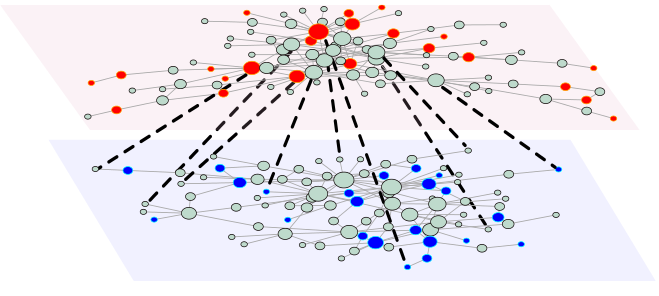
Reaction-Diffusion Processes on Interconnected Scale-Free Networks
|
[2015]
|
|
Garas, Antonios
|
Physical Review E,
pages: 020801(R),
volume: 92
|
more» «less
|
Abstract
We study the two-particle annihilation reaction A+B→∅ on interconnected scale-free networks, using different interconnecting strategies. We explore how the mixing of particles and the process evolution are influenced by the number of interconnecting links, by their functional properties, and by the interconnectivity strategies in use. We show that the reaction rates on this system are faster than what was observed in other topologies, due to the better particle mixing that suppresses the segregation effect, in line with previous studies performed on single scale-free networks.
A Complex Networks Perspective On Collaborative Software Engineering
|
[2015]
|
|
Cataldo, Marcelo;
Scholtes, Ingo;
Valetto, Giuseppe
|
ACS - Advances in Complex Systems,
pages: 1430001,
volume: 17,
number: 07n08
|
more» «less
|
Abstract
Large collaborative software engineering projects are interesting examples for evolving complex systems. The complexity of these systems unfolds both in evolving software structures, as well as in the social dynamics and organization of development teams. Due to the adoption of Open Source practices and the increasing use of online support infrastructures, large-scale data sets covering both the social and technical dimension of collaborative software engineering processes are increasingly becoming available. In the analysis of these data, a growing number of studies employ a network perspective, using methods and abstractions from network science to generate insights about software engineering processes. Featuring a collection of inspiring works in this area, with this topical issue, we intend to give an overview of state-of-the-art research. We hope that this collection of articles will stimulate downstream applications of network-based data mining techniques in empirical software engineering.

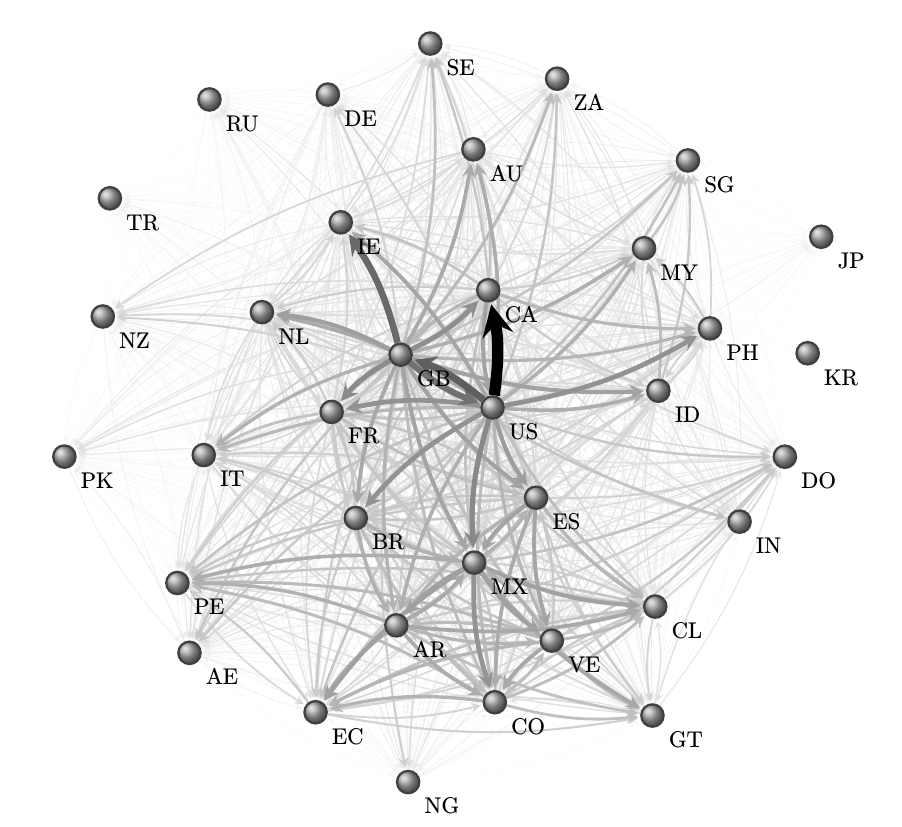
Quantifying the Economic and Cultural Biases of Social Media through Trending Topics
|
[2015]
|
|
Carrascosa, Juan Miguel;
Cuevas, Ruben;
Gonzalez, Roberto;
Azcorra, Arturo;
Garcia, David
|
PLOS ONE,
pages: e0134407,
volume: 10,
number: 7
|
more» «less
|
Abstract
Online social media has recently irrupted as the last major venue for the propagation of news and cultural content, competing with traditional mass media and allowing citizens to access new sources of information. In this paper, we study collectively filtered news and popular content in Twitter, known as Trending Topics (TTs), to quantify the extent to which they show similar biases known for mass media. We use two datasets collected in 2013 and 2014, including more than 300.000 TTs from 62 countries. The existing patterns of leader-follower relationships among countries reveal systemic biases known for mass media: Countries concentrate their attention to small groups of other countries, generating a pattern of centralization in which TTs follow the gradient of wealth across countries. At the same time, we find subjective biases within language communities linked to the cultural similarity of countries, in which countries with closer cultures and shared languages tend to follow each other’s TTs. Moreover, using a novel methodology based on the Google News service, we study the influence of mass media in TTs for four countries. We find that roughly half of the TTs in Twitter overlap with news reported by mass media, and that the rest of TTs are more likely to spread internationally within Twitter. Our results confirm that online social media have the power to independently spread content beyond mass media, but at the same time social media content follows economic incentives and is subject to cultural factors and language barriers.

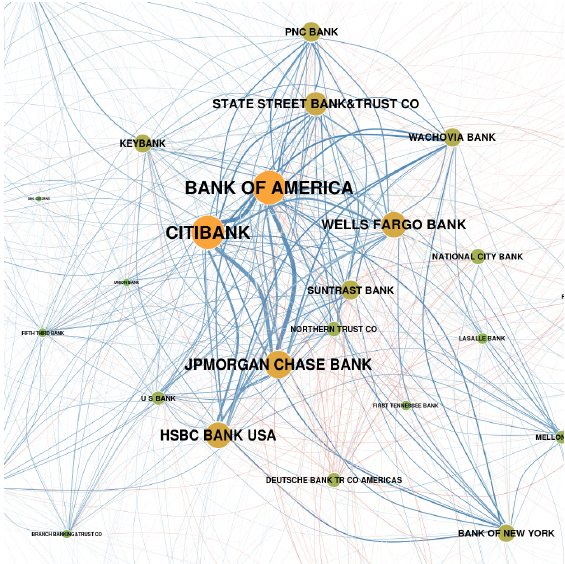
The Network of Counterparty Risk: Analysing Correlations in OTC Derivatives
|
[2015]
|
|
Nanumyan, Vahan;
Garas, Antonios;
Schweitzer, Frank
|
PLOS ONE,
pages: e0136638,
volume: 10
|
more» «less
|
Abstract
Counterparty risk denotes the risk that a party defaults in a bilateral contract. This risk not only depends on the two parties involved, but also on the risk from various other contracts each of these parties holds. In rather informal markets, such as the OTC (over-the-counter) derivative market, institutions only report their aggregated quarterly risk exposure, but no details about their counterparties. Hence, little is known about the diversification of counterparty risk. In this paper, we reconstruct the weighted and time-dependent network of counterparty risk in the OTC derivatives market of the United States between 1998 and 2012. To proxy unknown bilateral exposures, we first study the co-occurrence patterns of institutions based on their quarterly activity and ranking in the official report. The network obtained this way is further analysed by a weighted k-core decomposition, to reveal a core-periphery structure. This allows us to compare the activity-based ranking with a topology-based ranking, to identify the most important institutions and their mutual dependencies. We also analyse correlations in these activities, to show strong similarities in the behavior of the core institutions. Our analysis clearly demonstrates the clustering of counterparty risk in a small set of about a dozen US banks. This not only increases the default risk of the central institutions, but also the default risk of peripheral institutions which have contracts with the central ones. Hence, all institutions indirectly have to bear (part of) the counterparty risk of all others, which needs to be better reflected in the price of OTC derivatives.
Remarks
Find the Supporting Information at DOI:10.1371/journal.pone.0136638.s001

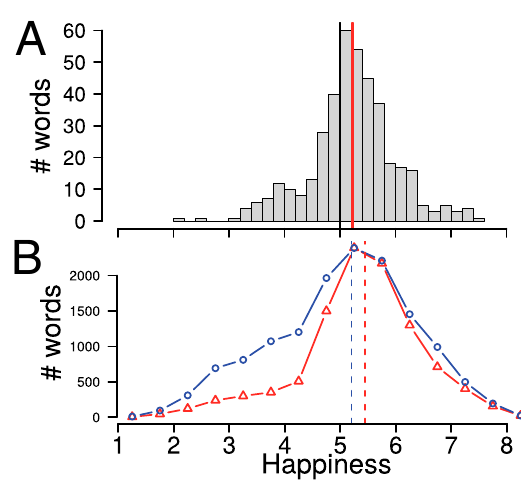
The language-dependent relationship between word happiness and frequency
|
[2015]
|
|
Garcia, David;
Garas, Antonios;
Schweitzer, Frank
|
Proceedings of the National Academy of Sciences,
pages: 201502909,
volume: 112,
number: 23
|
more» «less
|
Abstract
Dodds et al. (1) present a universal positivity bias—in 10 human languages—that they claim is independent of word frequency. This result contradicts previous findings (2, 3) in which a relationship between word happiness and frequency is reported for a variety of languages and large-scale datasets. To better understand this contradiction, we reanalyze the labMT (language assessment by Mechanical Turk) data produced in Dodds et al. (1) against a larger reference lexicon (3). Our reanalysis shows that the data used in Dodds et al. (1) does not support their claims.

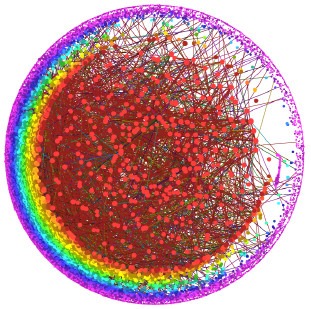
Emotions and Activity Profiles of Influential Users in Product Reviews Communities
|
[2015]
|
|
Tanase, Dorian;
Garcia, David;
Garas, Antonios;
Schweitzer, Frank
|
Frontiers in Physics,
volume: 3,
number: 87
|
more» «less
|
Abstract
Viral marketing seeks to maximize the spread of a campaign
through an online social network, often targeting influential nodes with high
centrality. In this article, we analyze behavioral aspects of influential
users in trust-based product reviews communities, quantifying emotional
expression, helpfulness, and user activity level. We focus on two independent
product review communities, Dooyoo and Epinions, in which
users can write product reviews and define trust links to filter product
recommendations. Following the patterns of social contagion processes, we
measure user social influence by means of the k-shell decomposition of trust
networks. For each of these users, we apply sentiment analysis to extract
their extent of positive, negative, and neutral emotional expression. In
addition, we quantify the level of feedback they received in their reviews,
the length of their contributions, and their level of activity over their
lifetime in the community. We find that users of both communities exhibit a
large heterogeneity of social influence, and that helpfulness votes and age
are significantly better predictors of the influence of an individual than
sentiment. The most active of the analyzed communities shows a particular
structure, in which the inner core of users is qualitatively different from
its periphery in terms of a stronger positive and negative emotional
expression. These results suggest that both objective and subjective aspects
of reviews are relevant to the communication of subjective experience.
Pro-Anorexia and Anti-Pro-Anorexia Videos on YouTube: Sentiment Analysis of User Responses
|
[2015]
|
|
Oksanen, Atte;
Garcia, David;
Sirola, Anu;
Näsi, Matti;
Kaakinen, Markus;
Keipi, Teo;
Räsänen, Pekka
|
Journal of Medical Internet Research,
pages: e2560,
volume: 11,
number: 17
|
more» «less
|
Abstract
Background: Pro-anorexia communities exist online and encourage harmful weight loss and weight control practices, often through emotional content that enforces social ties within these communities. User-generated responses to videos that directly oppose pro-anorexia communities have not yet been researched in depth.
Objective: The aim was to study emotional reactions to pro-anorexia and anti-pro-anorexia online content on YouTube using sentiment analysis.
Methods: Using the 50 most popular YouTube pro-anorexia and anti-pro-anorexia user channels as a starting point, we gathered data on users, their videos, and their commentators. A total of 395 anorexia videos and 12,161 comments were analyzed using positive and negative sentiments and ratings submitted by the viewers of the videos. The emotional information was automatically extracted with an automatic sentiment detection tool whose reliability was tested with human coders. Ordinary least squares regression models were used to estimate the strength of sentiments. The models controlled for the number of video views and comments, number of months the video had been on YouTube, duration of the video, uploader’s activity as a video commentator, and uploader’s physical location by country.
Results: The 395 videos had more than 6 million views and comments by almost 8000 users. Anti-pro-anorexia video comments expressed more positive sentiments on a scale of 1 to 5 (adjusted prediction [AP] 2.15, 95% CI 2.11-2.19) than did those of pro-anorexia videos (AP 2.02, 95% CI 1.98-2.06). Anti-pro-anorexia videos also received more likes (AP 181.02, 95% CI 155.19-206.85) than pro-anorexia videos (AP 31.22, 95% CI 31.22-37.81). Negative sentiments and video dislikes were equally distributed in responses to both pro-anorexia and anti-pro-anorexia videos.
Conclusions: Despite pro-anorexia content being widespread on YouTube, videos promoting help for anorexia and opposing the pro-anorexia community were more popular, gaining more positive feedback and comments than pro-anorexia videos. Thus, the anti-pro-anorexia content provided a user-generated counterforce against pro-anorexia content on YouTube. Professionals working with young people should be aware of the social media dynamics and versatility of user-generated eating disorder content online.

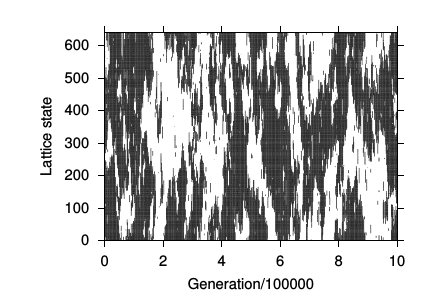
Neighborhood Approximations for Non-Linear Voter Models
|
[2015]
|
|
Schweitzer, Frank;
Behera, Laxmidhar
|
Entropy,
pages: 7658-7679,
volume: 17
|
more» «less
|
Abstract
Non-linear voter models assume that the opinion of an agent depends on the opinions of its neighbors in a non-linear manner. This allows for voting rules different from majority voting. While the linear voter model is known to reach consensus, non-linear voter models can result in the coexistence of opposite opinions. Our aim is to derive approximations to correctly predict the time dependent dynamics, or at least the asymptotic outcome, of such local interactions. Emphasis is on a probabilistic approach to decompose the opinion distribution in a second-order neighborhood into lower-order probability distributions. This is compared with an analytic pair approximation for the expected value of the global fraction of opinions and a mean-field approximation. Our reference case is averaged stochastic simulations of a one-dimensional cellular automaton. We find that the probabilistic second-order approach captures the dynamics of the reference case very well for different non-linearities, i.e., for both majority and minority voting rules, which only partly holds for the first-order pair approximation and not at all for the mean-field approximation. We further discuss the interesting phenomenon of a correlated coexistence, characterized by the formation of large domains of opinions that dominate for some time, but slowly change.

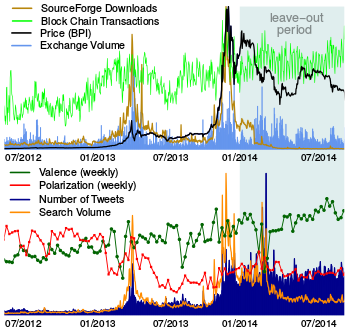
Social signals and algorithmic trading of Bitcoin
|
[2015]
|
|
Garcia, David;
Schweitzer, Frank
|
Royal Society Open Science,
volume: 2,
number: 150288
|
more» «less
|
Abstract
The availability of data on digital traces is growing to unprecedented sizes, but inferring actionable knowledge from large-scale data is far from being trivial. This is especially important for computational finance, where digital traces of human behaviour offer a great potential to drive trading strategies. We contribute to this by providing a consistent approach that integrates various datasources in the design of algorithmic traders. This allows us to derive insights into the principles behind the profitability of our trading strategies. We illustrate our approach through the analysis of Bitcoin, a cryptocurrency known for its large price fluctuations. In our analysis, we include economic signals of volume and price of exchange for USD, adoption of the Bitcoin technology and transaction volume of Bitcoin. We add social signals related to information search, word of mouth volume, emotional valence and opinion polarization as expressed in tweets related to Bitcoin for more than 3 years. Our analysis reveals that increases in opinion polarization and exchange volume precede rising Bitcoin prices, and that emotional valence precedes opinion polarization and rising exchange volumes. We apply these insights to design algorithmic trading strategies for Bitcoin, reaching very high profits in less than a year. We verify this high profitability with robust statistical methods that take into account risk and trading costs, confirming the long-standing hypothesis that trading-based social media sentiment has the potential to yield positive returns on investment.
Remarks
Online visualization at www.sg.ethz.ch/btc
Understanding Complex Systems: When Big Data meets Network Science
|
[2015]
|
|
Scholtes, Ingo
|
it - Information Technology,
pages: 252-256,
volume: 57,
number: 4
|
more» «less
|
Abstract
Better understanding and controlling complex systems has become a grand challenge not only for computer science, but also for the natural and social sciences. Many of these systems have in common that they can be studied from a network perspective. Consequently methods from network science have proven instrumental in their analysis. In this article, I introduce the macroscopic perspective that is at the heart of network science. Summarizing my recent research activities, I discuss how a combination of this perspective with Big Data methods can improve our understanding of complex systems.


Ideological and Temporal Components of Network Polarization in Online Political Participatory Media
|
[2015]
|
|
Garcia, David;
Abisheva, Adiya;
Schweighofer, Simon;
Serdult, Uwe;
Schweitzer, Frank
|
Policy and Internet,
pages: 46-79,
volume: 7,
number: 1
|
more» «less
|
Abstract
Political polarization is traditionally analyzed through the ideological stances of groups and parties, but it also has a behavioral component that manifests in the interactions between individuals. We present an empirical analysis of the digital traces of politicians in politnetz.ch, a Swiss online platform focused on political activity, in which politicians interact by creating support links, comments, and likes. We analyze network polarization as the level of intra-party cohesion with respect to inter-party connectivity, finding that supports show a very strongly polarized structure with respect to party alignment. The analysis of this multiplex network shows that each layer of interaction contains relevant information, where comment groups follow topics related to Swiss politics. Our analysis reveals that polarization in the layer of likes evolves in time, increasing close to the federal elections of 2011. Furthermore, we analyze the internal social network of each party through metrics related to hierarchical structures, information efficiency, and social resilience. Our results suggest that the online social structure of a party is related to its ideology, and reveal that the degree of connectivity across two parties increases when they are close in the ideological space of a multi-party system.


Sentiment cascades in the 15M movement
|
[2015]
|
|
Alvarez, Raquel;
Garcia, David;
Moreno, Yamir;
Schweitzer, Frank
|
EPJ Data Science,
volume: 4,
number: 6
|
more» «less
|
Abstract
Recent grassroots movements have suggested that online social networks might play a key role in their organization, as adherents have a fast, many-to-many, communication channel to help coordinate their mobilization. The structure and dynamics of the networks constructed from the digital traces of protesters have been analyzed to some extent recently. However, less effort has been devoted to the analysis of the semantic content of messages exchanged during the protest. Using the data obtained from a microblogging service during the brewing and active phases of the 15M movement in Spain, we perform the first large scale test of theories on collective emotions and social interaction in collective actions. Our findings show that activity and information cascades in the movement are larger in the presence of negative collective emotions and when users express themselves in terms related to social content. At the level of individual participants, our results show that their social integration in the movement, as measured through social network metrics, increases with their level of engagement and of expression of negativity. Our findings show that non-rational factors play a role in the formation and activity of social movements through online media, having important consequences for viral spreading.


Communication In Innovation Communities: An Analysis Of 100 Open Source Software Projects
|
[2014]
|
|
Geipel, Markus Michael;
Press, Kerstin;
Schweitzer, Frank
|
ACS - Advances in Complex Systems,
pages: 1550006,
volume: 17,
number: 07n08
|
more» «less
|
Abstract
We develop a model of innovation communities which allows us to address in a systematic way the influence of users and developers as well as communication between and within these groups. Based on this model, we derive a formal approach to quantify communication flows, community activity and community turnover. These measures are calculated using the data of 100 open source software projects. Our empirical analysis shows that: (i) Users play indeed a predominant role in communication, which points towards the vivid role of an active user community; (ii) communication is highly concentrated, which points towards the importance of active individuals and (iii) community turnover exhibits only little correlation with community segregation, which may allow to benefit from high turnover rates while keeping negative effects small. We argue that insight from this extensive analysis not only complements existing case studies, it also provides a reference frame to put these singular results into perspective when aiming at generalizations.

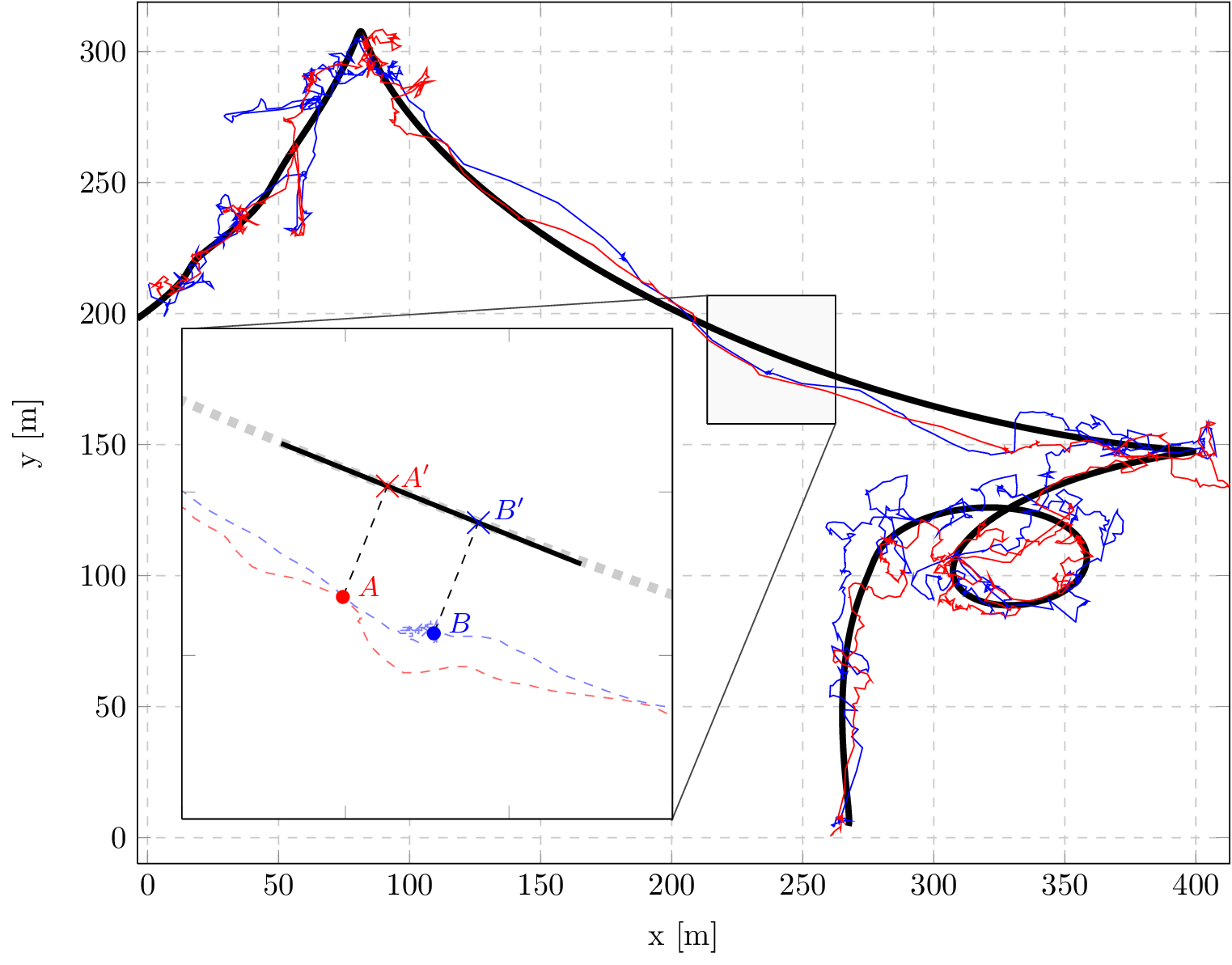
Dynamical coupling during collective animal motion
|
[2014]
|
|
Richardson, Tom O.;
Perony, Nicolas;
Tessone, Claudio Juan;
Bousquet, Christophe A.H.;
Manser, Marta B.;
Schweitzer, Frank
|
Submitted. arXiv:1311.1417
|
more» «less
|
Abstract
The measurement of information flows within moving animal groups has recently been a topic of considerable interest, and it has become clear that the individual(s) that drive collective movement may change over time, and that such individuals may not necessarily always lead from the front. However, methods to quantify the influence of specific individuals on the behaviour of other group members and the direction of information flow in moving group, are lacking on the level of empirical studies and theoretical models. Using high spatio-temporal resolution GPS trajectories of foraging meerkats, Suricata suricatta, we provide an information-theoretic framework to identify dynamical coupling between animals independent of their relative spatial positions. Based on this identification, we then compare designations of individuals as either drivers or responders against designations provided by the relative spatial position. We find that not only does coupling occur both from the frontal to the trailing individuals and vice versa, but also that the coupling direction is a non-linear function of the relative position. This provides evidence for (i) intermittent fluctuation of the coupling strength and (ii) alternation in the coupling direction within foraging meerkat pairs. The framework we introduce allows for a detailed description of the dynamical patterns of mutual influence between all pairs of individuals within moving animal groups. We argue that applying an information-theoretic perspective to the study of coordinated phenomena in animal groups will eventually help to understand cause and effect in collective behaviour.
Engineering and Mastering Interwoven Systems
|
[2014]
|
|
Tomforde, Sven;
Hähner, Jörg;
Seebach, Hella;
Reif, W. - E.;
Sick, Bernhard;
Wacker, Arno;
Scholtes, Ingo
|
Proceedings of ARCS 2014 - 27th International Conference on Architecture of Computing
|
more» «less
|
Abstract
Networked systems are becoming increasingly complex in development and operation. Due to this complexity, it is mostly impossible to follow a simple sequential design-deploy-use cycle. Instead, development and operation will become more evolutionary in nature. Additionally, one can observe that individual complex systems are coupled with each other, even though this has never been intended in the early development of these systems. As a result, we are facing interwoven systems – multiple open time-variant systems are coupled and interact having, e.g., different goals and objectives as well as changing system and communication structure. Based on and extending the idea of composing Systems of Systems, this article identifies challenges that are becoming increasingly apparent as the inevitable integration of systems progresses.

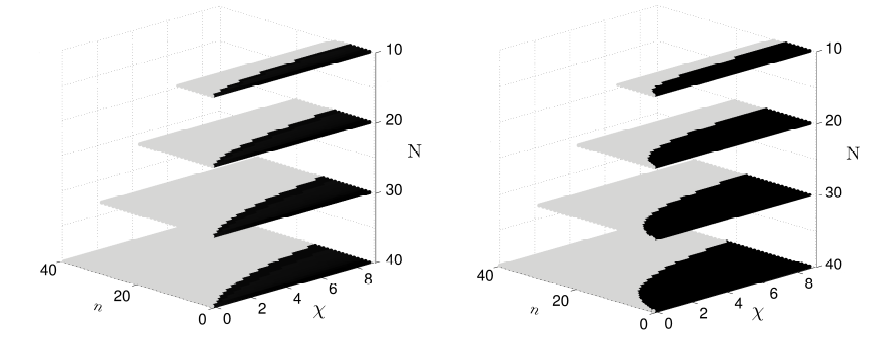
Quantifying the Impact of Leveraging and Diversification on Systemic Risk
|
[2014]
|
|
Tasca, Paolo;
Mavrodiev, Pavlin;
Schweitzer, Frank
|
Journal of Financial Stability,
pages: 43-52,
volume: 15,
number: 0
|
more» «less
|
Abstract
The excessive increase of leverage, i.e. the abuse of debt financing, is considered one of the primary factors in the default of financial institutions since it amplifies potential investment losses. On the other side, portfolio diversification acts to mitigate these losses. Systemic risk results from correlations between individual default probabilities that cannot be considered independent. Based on the structural framework by Merton (1974), we propose a model in which these correlations arise from overlaps in banks’ portfolios. Our main result is the finding of a critical level of diversification that separates two regimes: (i) a safe regime in which a properly chosen diversification strategy offsets the higher systemic risk engendered by increased leverage and (ii) a risky regime in which an inadequate diversification strategy and/or adverse market conditions, such as market size, market volatility and time horizon, cannot compensate the same increase in leverage. Our results are of relevance for financial regulators especially because the critical level of diversification may not coincide with the one that is individually optimal.

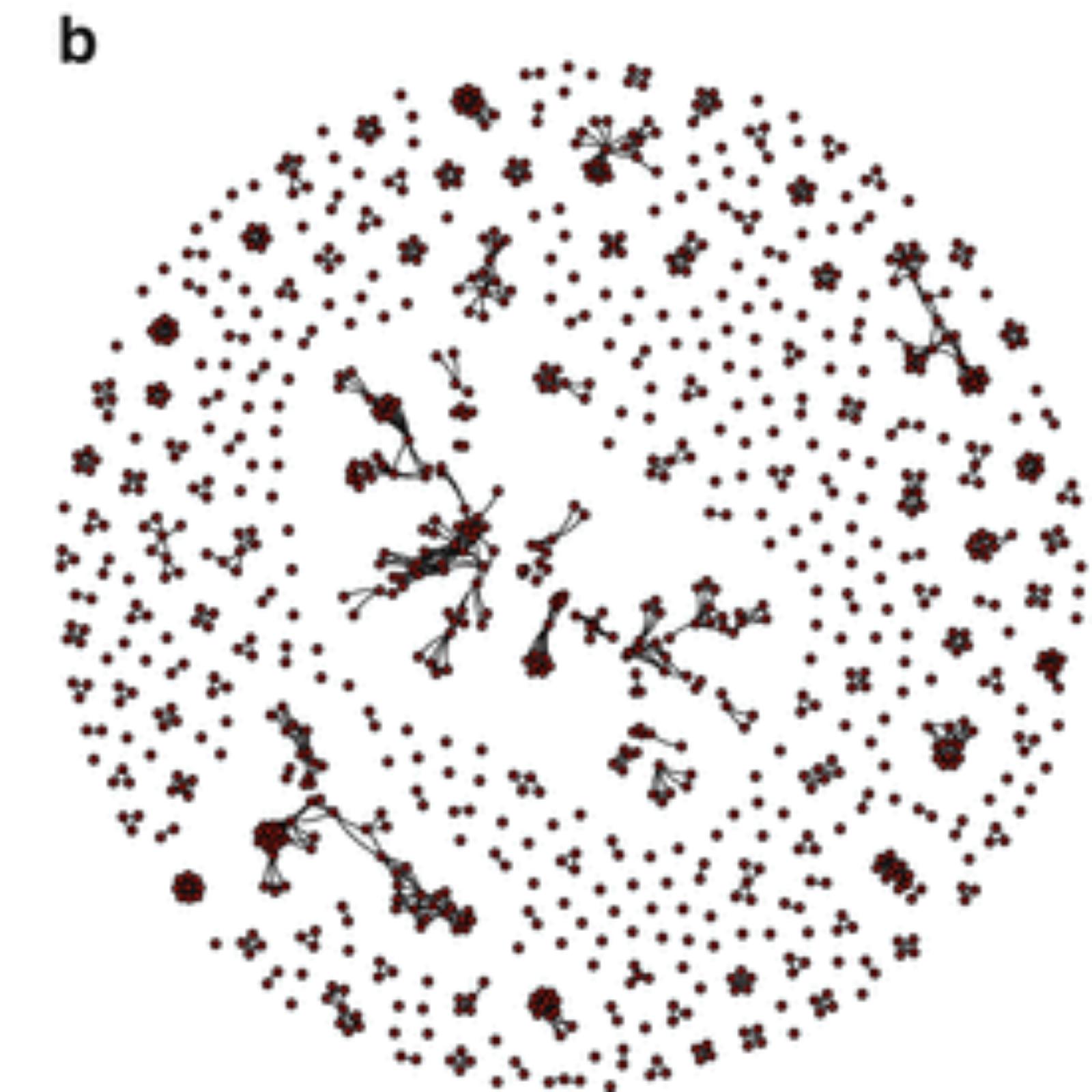
The Social Dimension of Information Ranking: A Discussion of Research Challenges and Approaches
|
[2014]
|
|
Schweitzer, Frank;
Scholtes, Ingo;
Pfitzner, Rene
|
Socioinformatics - The Social Impact of Interactions between Humans and IT
|
more» «less
|
Abstract
The extraction of relevant knowledge from the increasingly large amount
of information available in information repositories is one of the big challenges of our
time. Although it is clear that the social and the information layer of collaborative
knowledge spaces like the World Wide Web (WWW), scholarly publication databases
or Online Social Networks (OSNs) are inherently coupled and thus inseparable, the
question how the ranking and retrieval of information is influenced by the structure
and dynamics of the social systems that create it has been addressed at most partially.
In this talk, we will highlight associated research questions and challenges from an
ethical, social and computer science perspective and introduce a multiplex network
perspective that integrates both the social and the semantic layer of social information
systems.

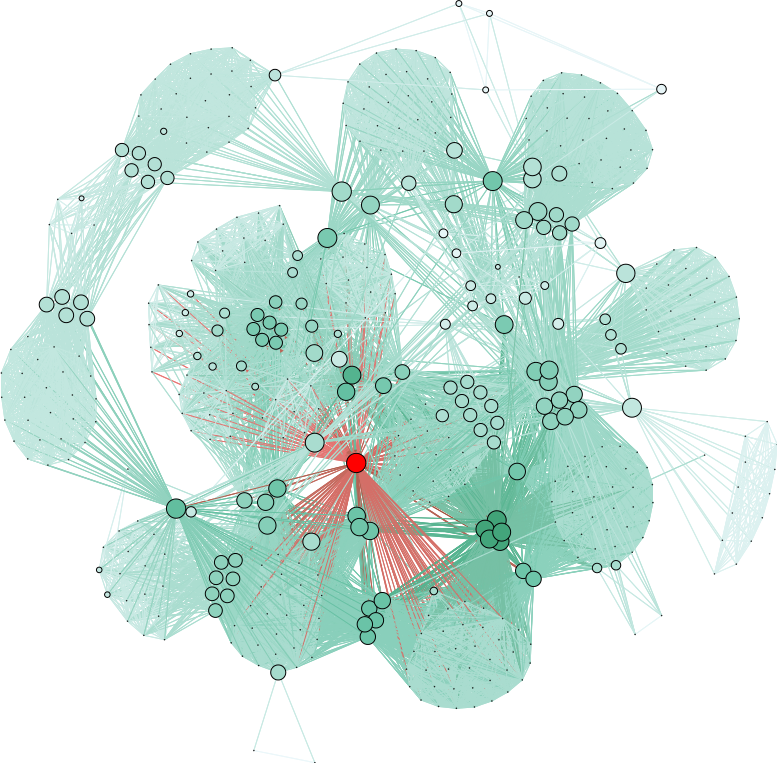
Predicting Scientific Success Based on Coauthorship Networks
|
[2014]
|
|
Sarigol, Emre;
Pfitzner, Rene;
Scholtes, Ingo;
Garas, Antonios;
Schweitzer, Frank
|
EPJ Data Science,
pages: 9,
volume: 3
|
more» «less
|
Abstract
We address the question to what extent the success of scientific articles is due to social influence. Analyzing a data set of over 100000 publications from the field of Computer Science, we study how centrality in the coauthorship network differs between authors who have highly cited papers and those who do not. We further show that a machine learning classifier, based only on coauthorship network centrality measures at time of publication, is able to predict with high precision whether an article will be highly cited five years after publication. By this we provide quantitative insight into the social dimension of scientific publishing - challenging the perception of citations as an objective, socially unbiased measure of scientific success.

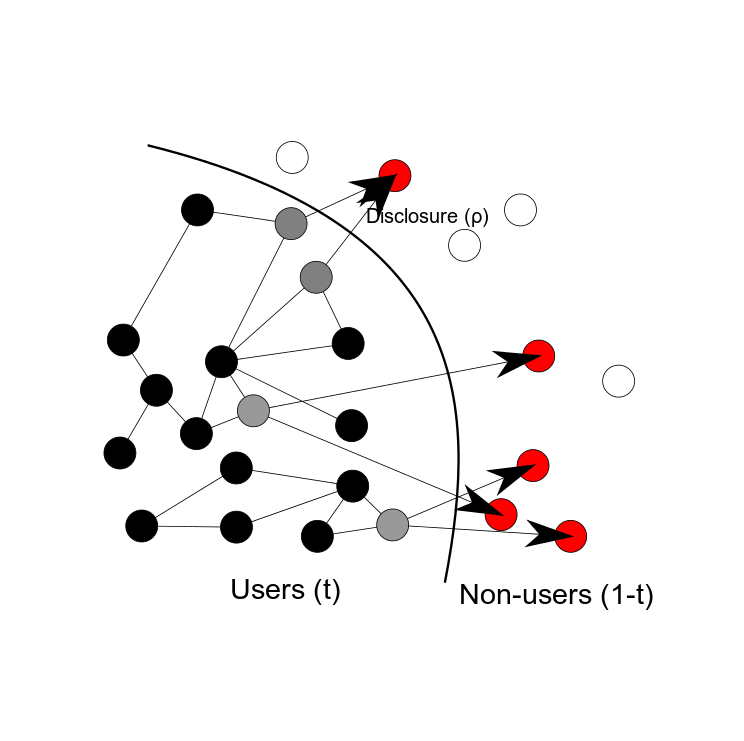
Online Privacy as a Collective Phenomenon
|
[2014]
|
|
Sarigol, Emre;
Garcia, David;
Schweitzer, Frank
|
In Proceedings of the 2nd Conference on Online Social Networks 2014,
pages: 95-105
|
more» «less
|
Abstract
The problem of online privacy is often reduced to individual decisions to hide or reveal personal information in online social networks (OSNs). However, with the increasing use of OSNs, it becomes more important to understand the role of the social network in disclosing personal information that a user has not revealed voluntarily: How much of our private information do our friends disclose about us, and how much of our privacy is lost simply because of online social interaction? Without strong technical effort, an OSN may be able to exploit the assortativity of human private features, this way constructing shadow profiles with information that users chose not to share. Furthermore, because many users share their phone and email contact lists, this allows an OSN to create full shadow profiles for people who do not even have an account for this OSN. We empirically test the feasibility of constructing shadow profiles of sexual orientation for users and non-users, using data from more than 3 Million accounts of a single OSN. We quantify a lower bound for the predictive power derived from the social network of a user, to demonstrate how the predictability of sexual orientation increases with the size of this network and the tendency to share personal information. This allows us to define a privacy leak factor that links individual privacy loss with the decision of other individuals to disclose information. Our statistical analysis reveals that some individuals are at a higher risk of privacy loss, as prediction accuracy increases for users with a larger and more homogeneous first-and second-order neighborhood of their social network. While we do not provide evidence that shadow profiles exist at all, our results show that disclosing of private information is not restricted to an individual choice, but becomes a collective decision that has implications for policy and privacy regulation.

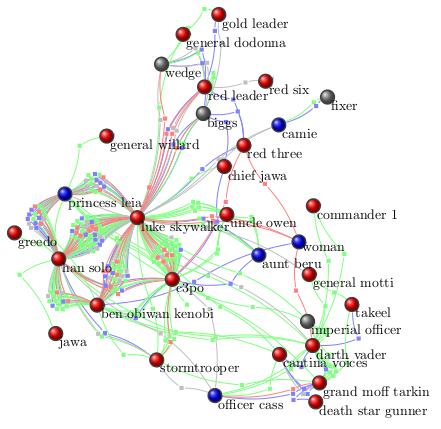
Gender Asymmetries in Reality and Fiction : The Bechdel Test of Social Media
|
[2014]
|
|
Garcia, David;
Weber, Ingmar;
Garimella, Rama Venkata Kiran
|
Proceedings of the International AAAI Conference on Weblogs and Social Media
|
more» «less
|
Abstract
The subjective nature of gender inequality motivates the analysis and comparison of data from real and fictional human interaction. We present a computational extension of the Bechdel test: A popular tool to assess if a movie contains a male gender bias, by looking for two female characters who discuss about something besides a man. We provide the tools to quantify Bechdel scores for both genders, and we measure them in movie scripts and large datasets of dialogues between users of MySpace and Twitter. Comparing movies and users of social media, we find that movies and Twitter conversations have a consistent male bias, which does not appear when analyzing MySpace. Furthermore, the narrative of Twitter is closer to the movies that do not pass the Bechdel test than to
those that pass it.
We link the properties of movies and the users that share trailers of those movies. Our analysis reveals some particularities of movies that pass the Bechdel test: Their trailers are less popular, female users are more likely to share them than male users, and users that share them tend to interact less with male users. Based on our datasets, we define gender independence measurements to analyze the gender biases of a society, as manifested through digital traces of online behavior. Using the profile information of Twitter users, we find larger gender independence for urban users in comparison to rural ones. Additionally, the asymmetry between genders is larger for parents and lower for students. Gender asymmetry varies across US states, increasing with higher average income and latitude. This points to the relation between gender inequality and social, economical, and cultural factors of a society, and how gender roles exist in both fictional narratives and public
online dialogues.

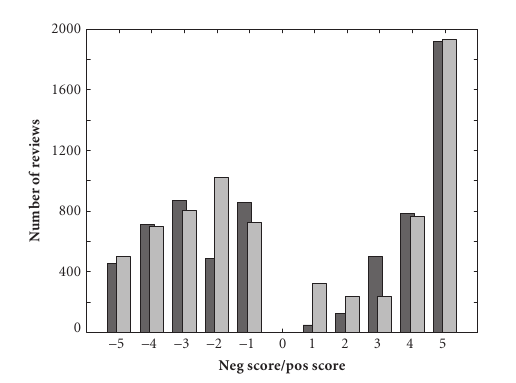
Modeling collective emotions in online social systems
|
[2014]
|
|
Garcia, David;
Garas, Antonios;
Schweitzer, Frank
|
Collective Emotions
|
more» «less
|
Abstract
Every day, millions of Internet users leave online traces that are publicly accessible. Data
about forum comments, video downloads, or product reviews provide a valuable insight
into human online behavior. The retrieval of datasets of unprecedented size may eventu-
ally also allow testing of hypotheses or validation of theories that have been developed in
the social sciences, for example, about preferences, social influence (Lorenz, 2009; Onnela
& Reed-Tsochas, 2010), trust, and cooperation (Walter, Battiston, Yildirim, & Schweitzer,
2011). This recent scientific development has led to the emerging field of computational
social science (Lazer et al., 2009) which combines methods and tools from different tech-
nical and social disciplines. Also, psychology can benefit from this development by get-
ting access to data without designing expensive experimental setups of limited size. For
example, the analysis of Twitter messages allows studying the influence of the circadian
cycles on human mood (Golder & Macy, 2011), and sentiment analysis of large-scale
datasets reveals patterns of emotional expression predicted by earlier theories (Garcia,
Garas, & Schweitzer, 2012).
Nestedness in networks: A theoretical model and some applications
|
[2014]
|
|
Koenig, Michael D;
Tessone, Claudio Juan;
Zenou, Yves
|
Theoretical Economics,
pages: 695-752,
volume: 9,
number: 3
|
more» «less
|
Abstract
We develop a dynamic network formation model that can explain the observed nestedness in real-world networks. Links are formed on the basis of agents’ centrality and have an exponentially distributed life time. We use stochastic stability to identify the networks to which the network formation process converges and find that they are nested split graphs. We completely determine the topological properties of the stochastically stable networks and show that they match features exhibited by real-world networks. Using four different network datasets, we empirically test our model and show that it fits well the observed networks.

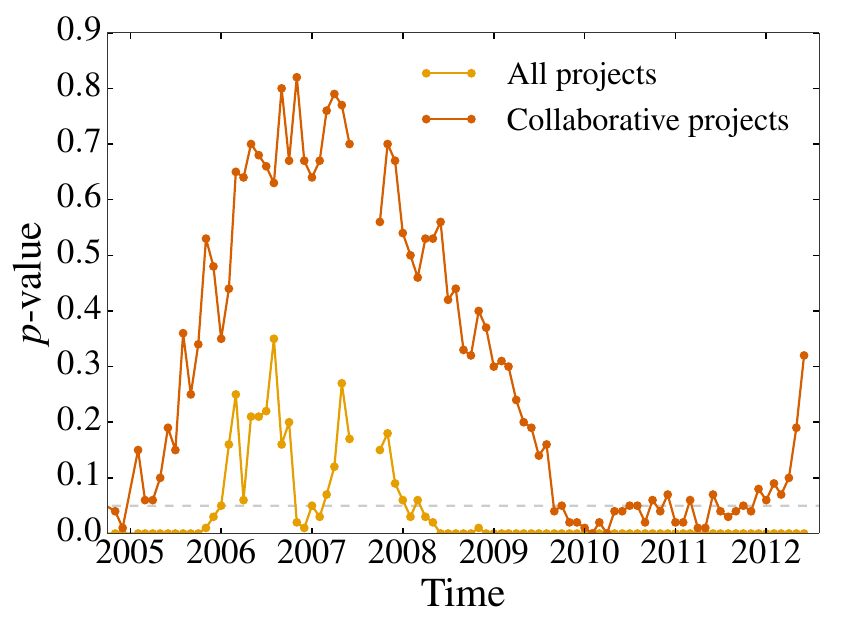
How do OSS projects change in number and size? A large-scale analysis to test a model of project growth
|
[2014]
|
|
Schweitzer, Frank;
Nanumyan, Vahan;
Tessone, Claudio Juan;
Xia, Xi
|
ACS - Advances in Complex Systems,
pages: 1550008,
volume: 17,
number: 07n08
|
more» «less
|
Abstract
Established open source software (OSS) projects can grow in size if new developers join, but also the number of OSS projects can grow if developers choose to found new projects. We discuss to what extent an established model for firm growth can be applied to the dynamics of OSS projects. Our analysis is based on a large-scale data set from SourceForge (SF) consisting of monthly data for 10 years, for up to 360,000 OSS projects and up to 340,000 developers. Over this time period, we find an exponential growth both in the number of projects and developers, with a remarkable increase of single-developer projects after 2009. We analyze the monthly entry and exit rates for both projects and developers, the growth rate of established projects and the monthly project size distribution. To derive a prediction for the latter, we use modeling assumptions of how newly entering developers choose to either found a new project or to join existing ones. Our model applies only to collaborative projects that are deemed to grow in size by attracting new developers. We verify, by a thorough statistical analysis, that the Yule–Simon distribution is a valid candidate for the size distribution of collaborative projects except for certain time periods where the modeling assumptions no longer hold. We detect and empirically test the reason for this limitation, i.e., the fact that an increasing number of established developers found additional new projects after 2009.

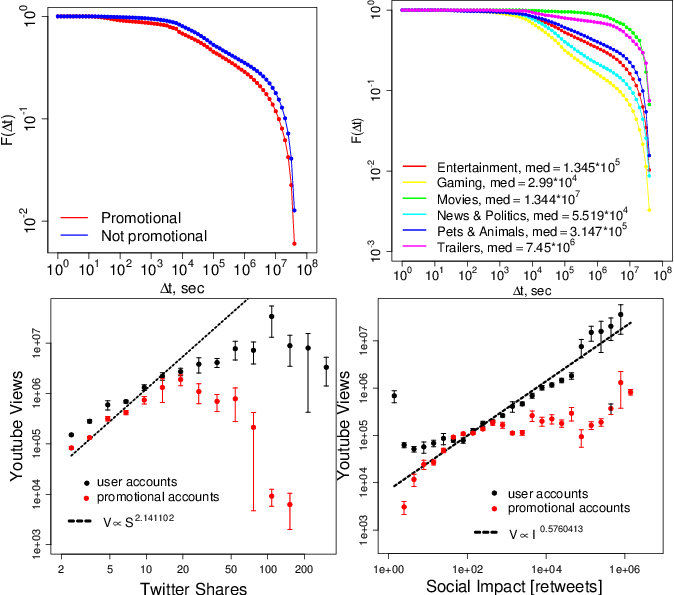
Who Watches ( and Shares ) What on YouTube ? And When ? Using Twitter to Understand YouTube Viewership
|
[2014]
|
|
Abisheva, Adiya;
Garimella, Venkata Rama Kiran;
Garcia, David;
Weber, Ingmar
|
WSDM 2014
|
more» «less
|
Abstract
We combine user-centric Twitter data with video-centric YouTube data to analyze who watches and shares what on YouTube. Combination of two data sets, with 87k Twitter users, 5.6mln YouTube videos and 15mln video sharing events, allows rich analysis going beyond what could be obtained with either of the two data sets individually. For Twitter, we generate user features relating to activity, interests and demographics. For YouTube, we obtain video features for topic, popularity and polarization. These two feature sets are combined through sharing events for YouTube URLs on Twitter. This combination is done both in a user-, a video-and a sharing-event-centric manner. For the user-centric analysis, we show how Twitter user features correlate both with YouTube features and with sharing-related features. As two examples, we show urban users are quicker to share than rural users and for some notions of "influence" influential users on Twitter share videos with a higher number of views. For the video-centric analysis, we find a superlinear relation between initial Twitter shares and the final amounts of views, showing the correlated behavior of Twitter. On user impact, we find the total amount of followers of users that shared the video in the first week does not affect its final popularity. However, aggregated user retweet rates serve as a better predictor for YouTube video popularity. For the sharing-centric analysis, we reveal existence of correlated behavior concerning the time between video creation and sharing within certain timescales, showing the time onset for a coherent response, and the time limit after which collective responses are extremely unlikely. We show that response times depend on video category, revealing that Twitter sharing of a video is highly dependent on its content. To the best of our knowledge this is the first large-scale study combining YouTube and Twitter data.

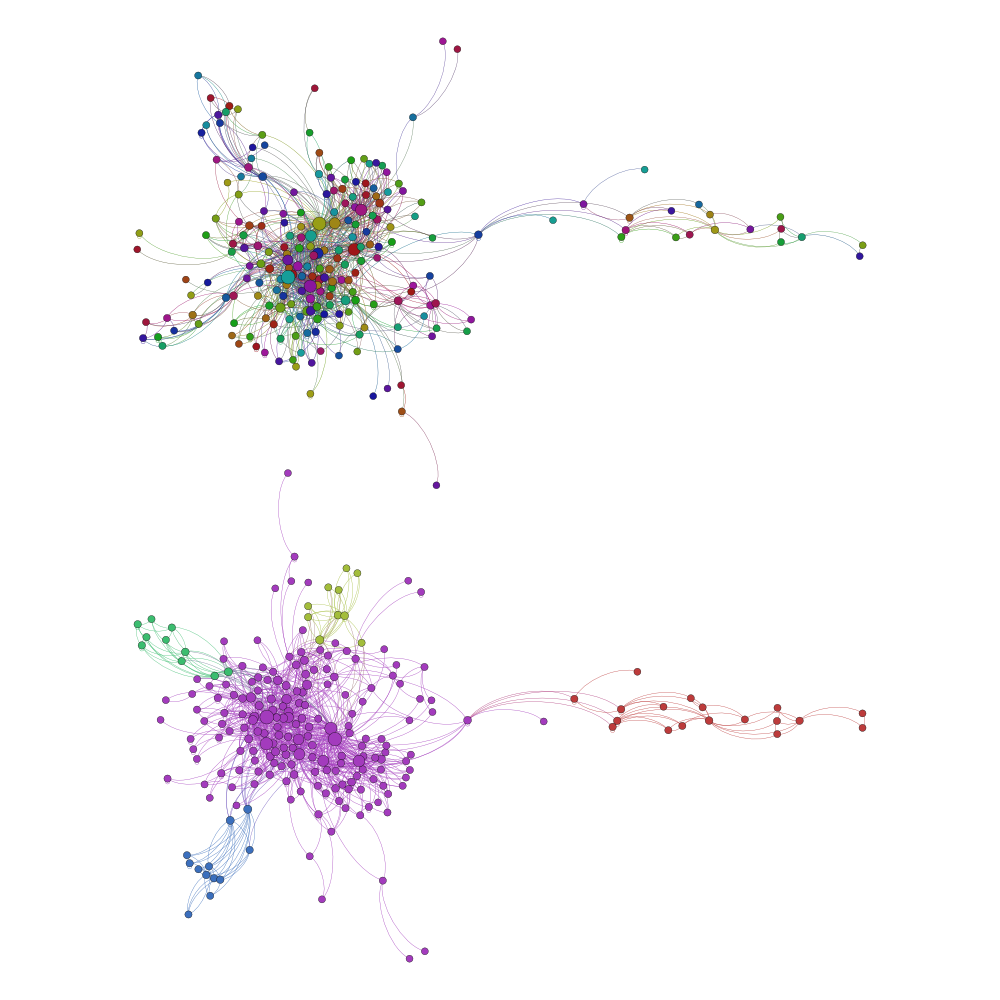
Automated Software Remodularization Based on Move Refactoring
|
[2014]
|
|
Zanetti, Marcelo Serrano;
Tessone, Claudio Juan;
Scholtes, Ingo;
Schweitzer, Frank
|
In Proceedings of the 13th International Conference on Modularity 2014,
pages: 73-84
|
more» «less
|
Abstract
Modular design is a desirable characteristic of complex software systems that can significantly improve their comprehensibility, maintainability and thus quality. While many software systems are initially created in a modular way, over time modularity typically degrades as components are reused outside the context where they were created. In this paper, we propose an automated strategy to remodularize software based on move refactoring, i.e. moving classes between packages without changing any other aspect of the source code. Taking a complex systems perspective, our approach is based on complex networks theory applied to the dynamics of software modular structures and its relation to an n-state spin model known as the Potts Model. In our approach, nodes are probabilistically moved between modules with a probability that nonlinearly depends on the number and module membership of their adjacent neighbors. The latter are defined by the underlying network of software dependencies. To validate our method, we apply it to a dataset of 39 Java open source projects in order to optimize their modularity. Comparing the source code generated by the developers with the optimized code resulting from our approach, we find that modularity (i.e. quantified in terms of a standard measure from the study of complex networks) improves on average by 166+-77 percent. In order to facilitate the application of our method in practical studies, we provide a freely available Eclipse plug-in.

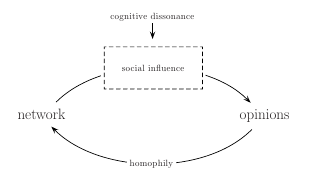
Dissonance minimization as a microfoundation of social influence in models of opinion formation
|
[2014]
|
|
Groeber, Patrick;
Lorenz, Jan;
Schweitzer, Frank
|
The Journal of Mathematical Sociology,
pages: 147-174,
volume: 38,
number: 3
|
more» «less
|
Abstract
Models of opinion formation are used to investigate many collective phenomena. While social influence often constitutes a basic mechanism, its implementation differs between the models. In this paper, we provide a general framework of social influence inspired by the social psychological concept of cognitive dissonance.We only premise that individuals strive to minimize dissonance resulting from different opinions compared to neighbor individuals in a given social network. Within a game theoretic context, we show that our concept of dissonance reduction exhibits the basic properties of a coordination process. We further show that different models of opinion formation can be represented as best response dynamics within our general framework. Thus, we offer a unifying perspective on heterogeneous models and link them to rational choice theory.
Editorial: Scientific networks and success in science
|
[2014]
|
|
Schweitzer, Frank
|
EPJ Data Science,
volume: 3,
number: 35
|
more» «less
|

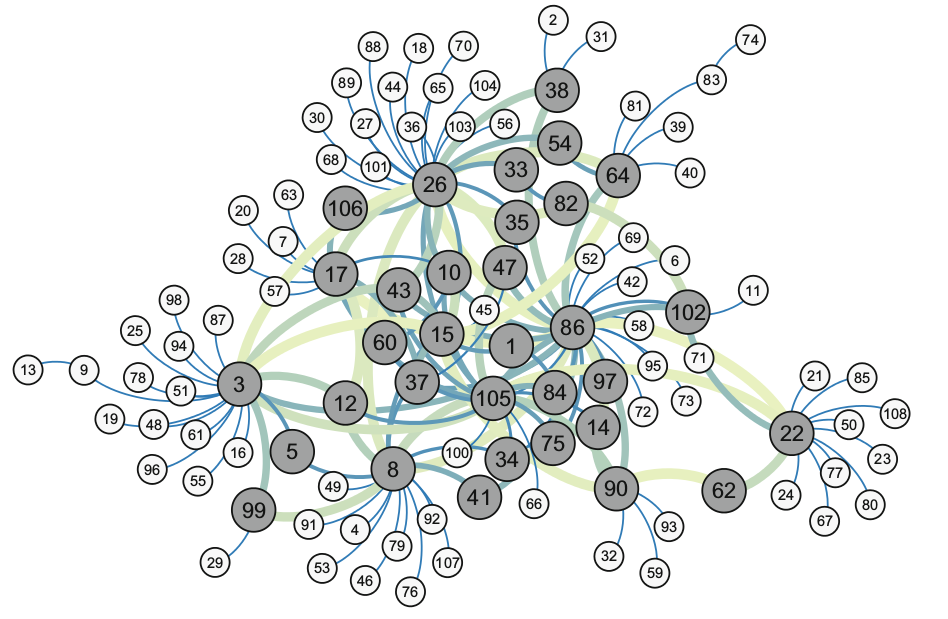
Social Network Analysis in the Enterprise: Challenges and Opportunities
|
[2014]
|
|
Burger, Valentin;
Hock, David;
Scholtes, Ingo;
Hofeld, Tobias;
Garcia, David;
Seufert, Michael
|
Socioinformatics-The Social Impact of Interactions between Humans and IT
|
more» «less
|
Abstract
Enterprise social software tools are increasingly being used to support the communication and collaboration between employees, as well as to facilitate the collaborative organisation of information and knowledge within companies. Not only do these tools help to develop and maintain an efficient social organisation, they also produce massive amounts of fine-grained data on collaborations, communication and other forms of social relationships within an enterprise. In this chapter, we argue that the availability of these data provides unique opportunities to monitor and analyse social structures and their impact on the success and performance of individuals, teams, communities and organisations. We further review methods from the planning, design and optimisation of telecommunication networks and discuss challenges arising when wanting to apply them to optimise the structure of enterprise social networks.

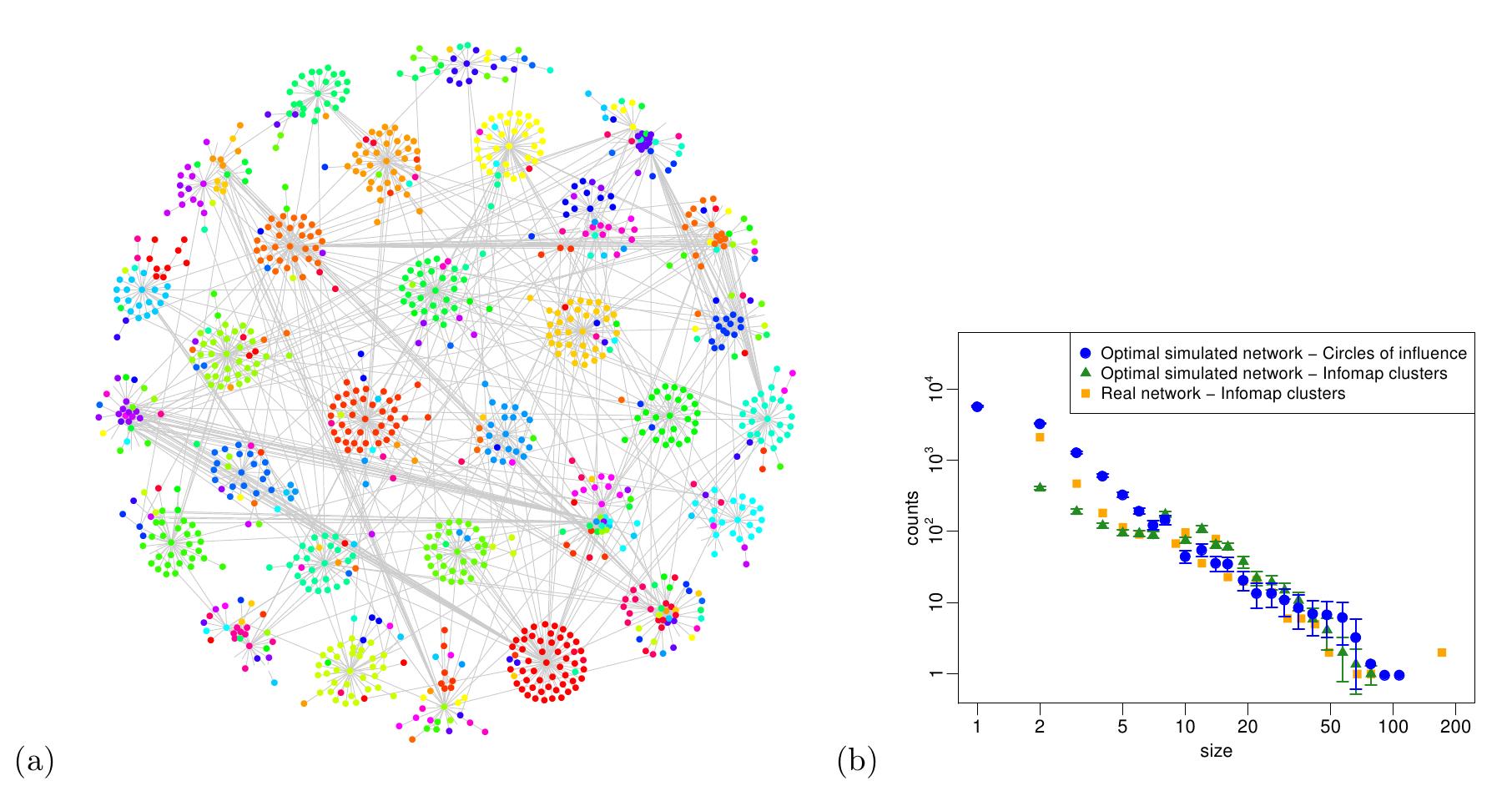
The Role of Endogenous and Exogenous Mechanisms in the Formation of R&D Networks
|
[2014]
|
|
Tomasello, Mario Vincenzo;
Perra, Nicola;
Tessone, Claudio Juan;
Karsai, M'arton;
Schweitzer, Frank
|
Scientific Reports,
pages: 5679,
volume: 4
|
more» «less
|
Abstract
We develop an agent-based model of strategic link formation in Research and Development (R&D) networks. Empirical evidence has shown that the growth of these networks is driven by mechanisms which are both endogenous to the system (that is, depending on existing alliances patterns) and exogenous (that is, driven by an exploratory search for newcomer firms). Extant research to date has not investigated both mechanisms simultaneously in a comparative manner. To overcome this limitation, we develop a general modeling framework to shed light on the relative importance of these two mechanisms. We test our model against a comprehensive dataset, listing cross-country and cross-sectoral R&D alliances from 1984 to 2009. Our results show that by fitting only three macroscopic properties of the network topology, this framework is able to reproduce a number of micro-level measures, including the distributions of degree, local clustering, path length and component size, and the emergence of network clusters. Furthermore, by estimating the link probabilities towards newcomers and established firms from the data, we find that endogenous mechanisms are predominant over the exogenous ones in the network formation, thus quantifying the importance of existing structures in selecting partner firms.

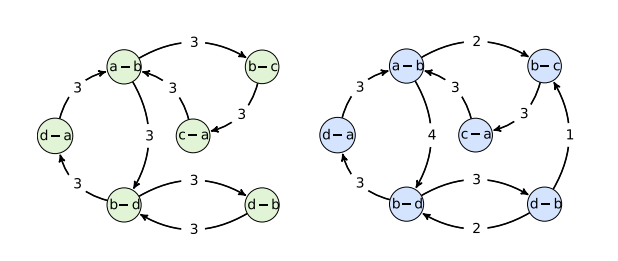
Causality-driven slow-down and speed-up of diffusion in non-Markovian temporal networks
|
[2014]
|
|
Scholtes, Ingo;
Wider, Nicolas;
Pfitzner, Rene;
Garas, Antonios;
Tessone, Claudio Juan;
Schweitzer, Frank
|
Nature Communications,
pages: 5024,
volume: 5
|
more» «less
|
Abstract
Recent research has highlighted limitations of studying complex systems with time-varying topologies from the perspective of static, time-aggregated networks. Non-Markovian characteristics resulting from the ordering of interactions in temporal networks were identified as one important mechanism that alters causality and affects dynamical processes. So far, an analytical explanation for this phenomenon and for the significant variations observed across different systems is missing. Here we introduce a methodology that allows to analytically predict causality-driven changes of diffusion speed in non-Markovian temporal networks. Validating our predictions in six data sets we show that compared with the time-aggregated network, non-Markovian characteristics can lead to both a slow-down or speed-up of diffusion, which can even outweigh the decelerating effect of community structures in the static topology. Thus, non-Markovian properties of temporal networks constitute an important additional dimension of complexity in time-varying complex systems.

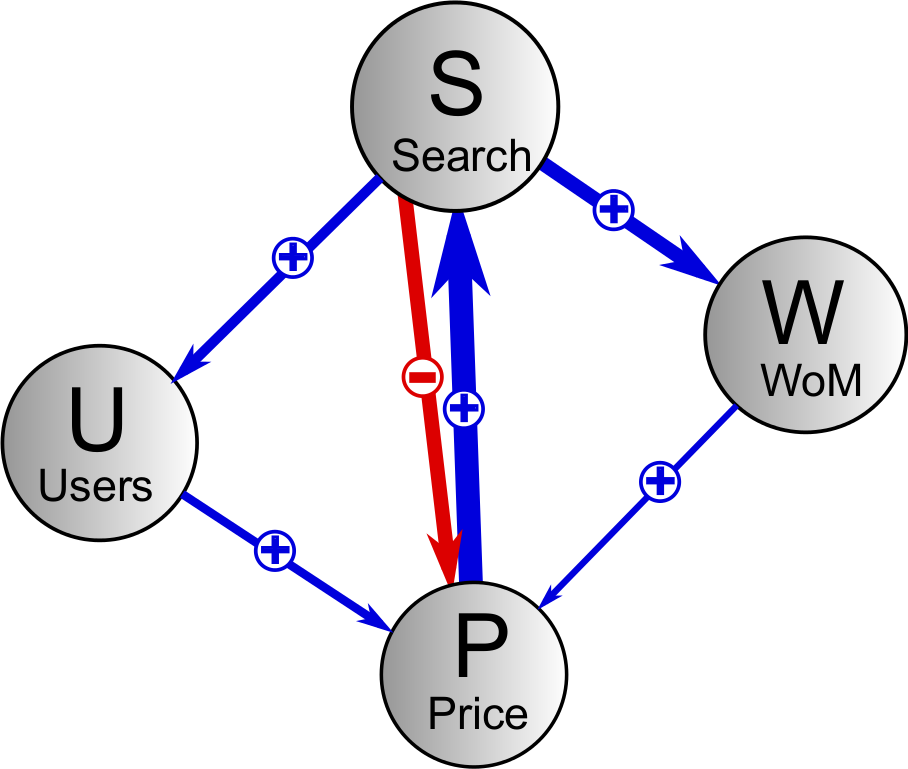
The digital traces of bubbles: Feedback cycles between socio-economic signals in the Bitcoin economy
|
[2014]
|
|
Garcia, David;
Tessone, Claudio Juan;
Mavrodiev, Pavlin;
Perony, Nicolas
|
Journal of the Royal Society Interface,
pages: 20140623,
volume: 11,
number: 99
|
more» «less
|
Abstract
What is the role of social interactions in the creation of price bubbles? Answering this question requires obtaining collective behavioural traces generated by the activity of a large number of actors. Digital currencies offer a unique possibility to measure socio-economic signals from such digital traces. Here, we focus on Bitcoin, the most popular cryptocurrency. Bitcoin has experienced periods of rapid increase in exchange rates (price) followed by sharp decline; we hypothesize that these fluctuations are largely driven by the interplay between different social phenomena. We thus quantify four socio-economic signals about Bitcoin from large datasets: price on online exchanges, volume of word-of-mouth communication in online social media, volume of information search and user base growth. By using vector autoregression, we identify two positive feedback loops that lead to price bubbles in the absence of exogenous stimuli: one driven by word of mouth, and the other by new Bitcoin adopters. We also observe that spikes in information search, presumably linked to external events, precede drastic price declines. Understanding the interplay between the socio-economic signals we measured can lead to applications beyond cryptocurrencies to other phenomena that leave digital footprints, such as online social network usage.

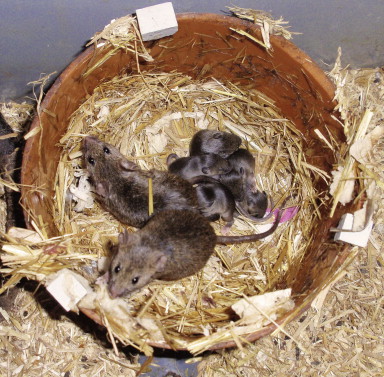
Nest attendance of lactating females in a wild house mouse population: Benefits associated with communal nesting
|
[2014]
|
|
Auclair, Yannick;
Koenig, Barbara;
Ferrari, Manuela;
Perony, Nicolas;
Lindholm, Anna K.
|
Animal Behaviour,
pages: 143-149,
number: 92
|
more» «less
|
Abstract
Among species providing uniparental care, the caring parent faces time constraints and may have to compromise offspring care/protection for self-maintenance. In most mammalian species females raise their offspring without receiving help from males. Communal nesting, when multiple females share a single nest where they rear their pups together, may have evolved as a mutually beneficial cooperative behaviour to reduce mothers' nest attendance without increasing the time their offspring are left alone. We tested this hypothesis using data collected in a free-living house mouse population where reproduction occurred in nest boxes and was closely monitored. Individuals were fitted with transponders allowing automatic recording of their location, and a genetic parentage analysis confirmed maternal identity. Compared to mothers raising their pups solitarily, communally nesting mothers spent less time inside their nest. Their pups, however, were left alone for a similar amount of time as solitarily raised pups. The time communal litters were left alone did not covary with the kinship of communally nesting females. These results indicate that communally nesting mothers can allocate more time to foraging or territorial defence without impairing the amount of maternal attention received by their offspring. Nevertheless, communally nesting mothers showed some overlap in their stays at the nest. Offspring may benefit from more regular meals while mothers may gain information on the partner's contribution to combined maternal care which could potentially prevent cheating.
Remarks
Featured Article in the June 2014 issue of Animal Behaviour (DOI: 10.1016/j.anbehav.2014.04.039).


Force-Directed Layout of Non-Markovian Temporal Networks
|
[2014]
|
|
Scholtes, Ingo
|
Working Paper,
pages: 1-11
|
more» «less
|
Abstract
When exploring the structure and function of such complex systems, the visualization of network topologies has become a standard technique.
Many - if not most - of the systems being considered are inherently dynamic and in recent years more and more data on their dynamics are becoming available in the form of so-called temporal networks.
We propose a simple mechanism that can be used to include temporal correlations present in longitudinal data on temporal networks in the layout of time-aggregated network structures.
We particularly focus on non-Markovian properties of contact sequences in temporal networks, i.e. the fact that future contacts not only depend on the current contact, but also on past contacts.
We demonstrate our approach by visualising a set of examples for temporal networks with non-Markovian properties.
The visualisations show that the resulting visualizations reveal important aspects like e.g. community structures of the dynamics which - although present in empirical data sets - a) are not represented in static, aggregate networks and b) cannot easily be seen even in dynamic visualizations of temporal networks.


Spatial Localization in Manufacturing: A Cross-Country Analysis
|
[2013]
|
|
Vitali, Stefania;
Napoletano, Mauro;
Fagiolo, Giorgio
|
Regional Studies,
pages: 1534-1554,
volume: 47,
number: 9
|
more» «less
|
Abstract
This paper employs a homogeneous-firm database to investigate industry localization in European countries. More specifically, it compares, across industries and countries, the predictions of two of the most popular localization indexes, that is, the Ellison and Glaeser index of 1997 and the Duranton and Overman index of 2005. Independently from the index used, it is found that localization is a pervasive phenomenon in all countries studied; and the degree of localization is very unevenly distributed across industries in each country. Furthermore, it is shown that in all countries localized sectors are mainly ‘traditional’ sectors or, if one controls for country industrial structures, science-based sectors. Moreover, it is found that the two indexes significantly diverge in predicting the intensity of localization of the same industry both across and within countries. In turn, these differences point to the different role played by pecuniary versus non-pecuniary externalities in driving firms' location decisions.

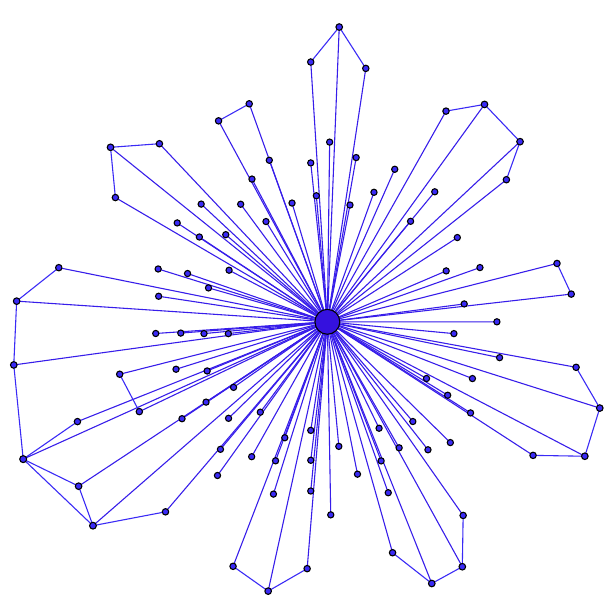
The social climbing game
|
[2013]
|
|
Bardoscia, Marco;
Luca, Giancarlo;
Livan, Giacomo;
Marsili, Matteo;
Tessone, Claudio Juan
|
Journal of Statistical Physics,
pages: 440-457,
volume: 151
|
more» «less
|
Abstract
The structure of a society depends, to some extent, on the incentives of the individuals they are composed of. We study a stylized model of this interplay, that suggests that the more individuals aim at climbing the social hierarchy, the more society's hierarchy gets strong. Such a dependence is sharp, in the sense that a persistent hierarchical order emerges abruptly when the preference for social status gets larger than a threshold. This phase transition has its origin in the fact that the presence of a well defined hierarchy allows agents to climb it, thus reinforcing it, whereas in a "disordered" society it is harder for agents to find out whom they should connect to in order to become more central. Interestingly, a social order emerges when agents strive harder to climb society and it results in a state of reduced social mobility, as a consequence of ergodicity breaking, where climbing is more difficult.
On the Benefits of Risk Diversification: The Individual and Social Perspectives
|
[2013]
|
|
Tasca, Paolo;
Battiston, Stefano
|
Deutsche Bundesbank/SAFE Conference on "Supervising Banks in Complex Financial Systems"
|
more» «less
|
Abstract
The recent credit crisis of 2007/08 has raised a debate about the so-called knife-edge properties of financial markets. The paper contributes to the debate shedding light on the controversial relation between risk-diversification and financial stability. We model a financial network where assets held by borrowers to meet their obligations, include claims against other borrowers and securities exogenous to the network. The balance-sheet approach is conjugated with a stochastic setting and by a mean-field approximation the law of motion of the system's fragility is derived. We show that diversification has an ambiguous effect and beyond a certain levels elicits financial instability. Moreover, we find that risk-sharing restrictions create a socially preferable outcome. Our findings have significant implications for future policy recommendation.


How can social herding enhance cooperation?
|
[2013]
|
|
Schweitzer, Frank;
Mavrodiev, Pavlin;
Tessone, Claudio Juan
|
ACS - Advances in Complex Systems,
pages: 1350017-1-1350017-22,
volume: 16
|
more» «less
|
Abstract
We study a system in which N agents have to decide between two strategies θ_(i) (i ∈ 1... N), for defection or cooperation, when interacting with other n agents (either spatial neighbors or randomly chosen ones). After each round, they update their strategy responding nonlinearly to two different information sources: (i) the payoff a_(i)(θ_(i), f_(i)) received from the strategic interaction with their n counterparts, (ii) the fraction f_(i) of cooperators in this interaction. For the latter response, we assume social herding, i.e. agents adopt their strategy based on the frequencies of the different strategies in their neighborhood, without taking into account the consequences of this decision. We note that f_(i) already determines the payoff, so there is no additional information assumed. A parameter ζ defines to what level agents take the two different information sources into account. For the strategic interaction, we assume a Prisoner's Dilemma game, i.e. one in which defection is the evolutionary stable strategy. However, if the additional dimension of social herding is taken into account, we find instead a stable outcome where cooperators are the majority. By means of agent-based computer simulations and analytical investigations, we evaluate the critical conditions for this transition towards cooperation. We find that, in addition to a high degree of social herding, there has to be a nonlinear response to the fraction of cooperators. We argue that the transition to cooperation in our model is based on less information, i.e. on agents which are not informed about the payoff matrix, and therefore rely on just observing the strategy of others, to adopt it. By designing the right mechanisms to respond to this information, the transition to cooperation can be remarkably enhanced.

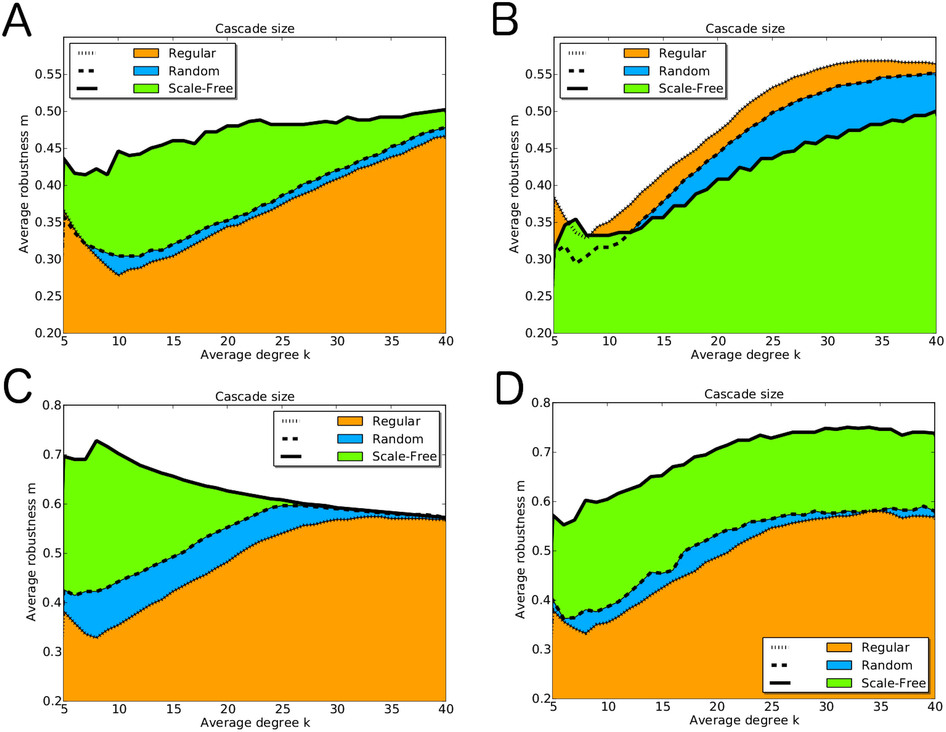
Default Cascades in Complex Networks: Topology and Systemic Risk
|
[2013]
|
|
Roukny, Tarik;
Bersini, Hugues;
Pirotte, Hugues;
Caldarelli, Guido;
Battiston, Stefano
|
Scientific Reports,
pages: 2759,
volume: 3
|
more» «less
|
Abstract
The recent crisis has brought to the fore a crucial question that remains still open: what would be the optimal architecture of financial systems? We investigate the stability of several benchmark topologies in a simple default cascading dynamics in bank networks. We analyze the interplay of several crucial drivers, i.e., network topology, banks' capital ratios, market illiquidity, and random vs targeted shocks. We find that, in general, topology matters only – but substantially – when the market is illiquid. No single topology is always superior to others. In particular, scale-free networks can be both more robust and more fragile than homogeneous architectures. This finding has important policy implications. We also apply our methodology to a comprehensive dataset of an interbank market from 1999 to 2011.


Enhancing consensus under opinion bias by means of hierarchical decision making
|
[2013]
|
|
Perony, Nicolas;
Pfitzner, Rene;
Scholtes, Ingo;
Tessone, Claudio Juan;
Schweitzer, Frank
|
ACS - Advances in Complex Systems,
pages: 1350020,
volume: 16
|
more» «less
|
Abstract
We study the role of hierarchical structures in a simple model of collective consensus formation based on the bounded confidence model with continuous individual opinions. For the particular variation of this model considered in this paper, we assume that a bias towards an extreme opinion is introduced whenever two individuals interact and form a common decision. As a simple proxy for hierarchical social structures, we introduce a two-step decision making process in which in the second step groups of like-minded individuals are replaced by representatives once they have reached local consensus, and the representatives in turn form a collective decision in a downstream process. We find that the introduction of such a hierarchical decision making structure can improve consensus formation, in the sense that the eventual collective opinion is closer to the true average of individual opinions than without it. In particular, we numerically study how the size of groups of like-minded individuals being represented by delegate individuals affects the impact of the bias on the final population-wide consensus. These results are of interest for the design of organisational policies and the optimisation of hierarchical structures in the context of group decision making.

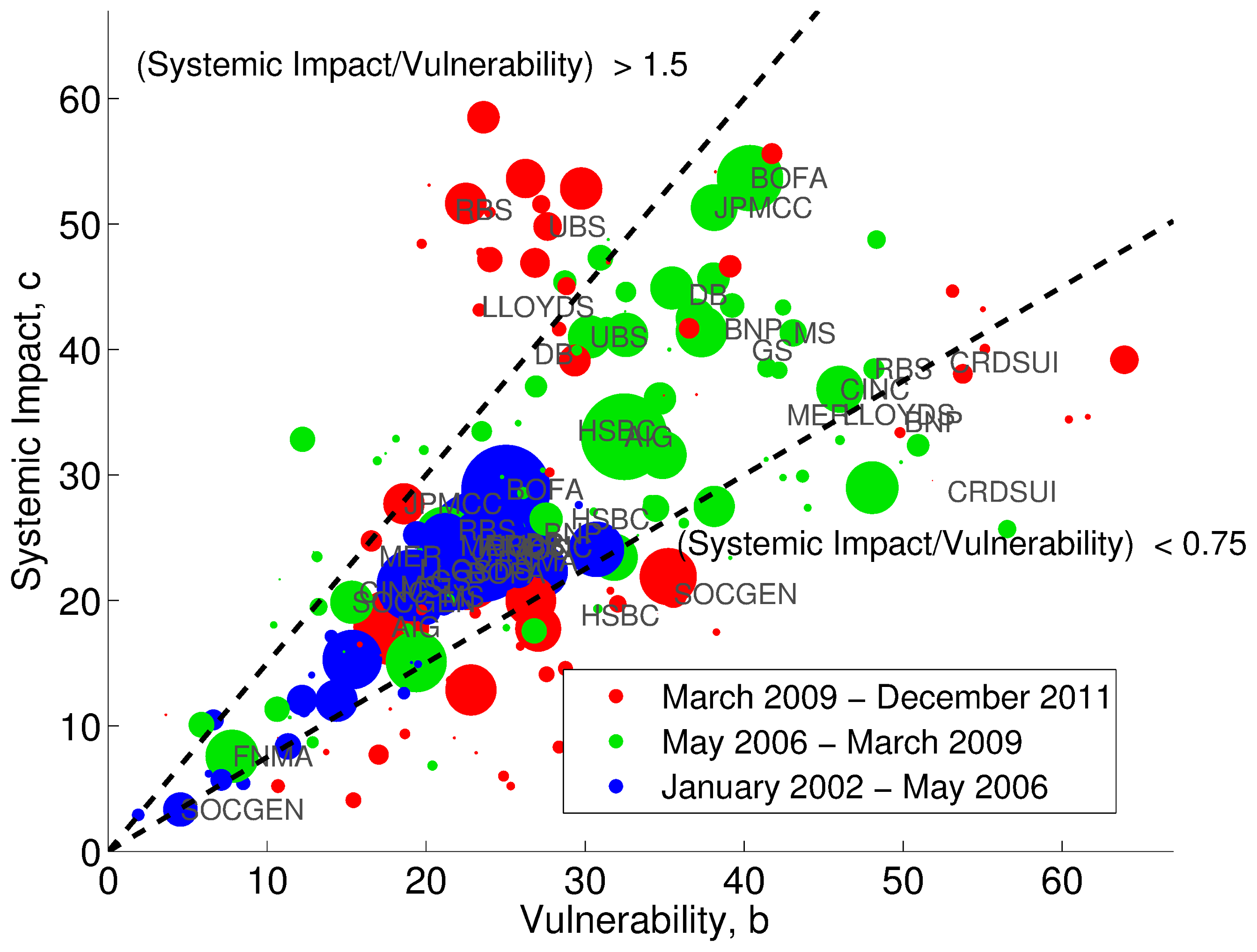
Credit default swaps drawup networks: Too interconnected to be stable?
|
[2013]
|
|
Kaushik, Rahul;
Battiston, Stefano
|
PLOS ONE,
pages: e61815,
volume: 8,
number: 7
|
more» «less
|
Abstract
We analyse time series of CDS spreads for a set of major US and European institutions in a period overlapping the recent financial crisis. We extend the existing methodology of epsilon-drawdowns to the one of joint epsilon-drawups, in order to estimate the conditional probabilities of spike-like co-movements among pairs of spreads. After correcting for randomness and finite size effects, we find that, depending on the period of time, 50% of the pairs or more exhibit high probabilities of joint drawups and the majority of spread series are trend-reinforced, i.e. drawups tend to be followed by drawups in the same series. We then carry out a network analysis by taking the probability of joint drawups as a proxy of financial dependencies among institutions. We introduce two novel centrality-like measures that offer insights on how both the systemic impact of each node as well as its vulnerability to other nodes' shocks evolve in time.
Resilience in Enterprise Social Networks
|
[2013]
|
|
Burger, Valentin;
Hofeld, Tobias;
Garcia, David;
Seufert, Michael;
Scholtes, Ingo;
Hock, David
|
In Proceedings of Informatik 2013, 43. Jahrestagung der Gesellschaft für Informatik e.V. (GI), Informatik angepasst an Mensch, Organisation und Umwelt, 16.-20. September 2013, Koblenz
|
more» «less
|
Abstract
The goal of human resource management is to ensure an effective company environment. Crucial for a good corporate culture is a comfortable atmosphere and positive social relationships between the employees. The interactions of the people and groups working in the company define their relationships and are reflected in the company's social network. Projections of such networks are Enterprise Social Networks which are more and more integrated in companies. These social networks can be a powerful tool to analyse the structure of a company and indicate potential problems. This extended abstract poses research questions to identify and quantify mechanisms that have an impact on the social network of a company to ensure resilience. To address these questions we make assumptions based on real-world observations for a subsequent model.

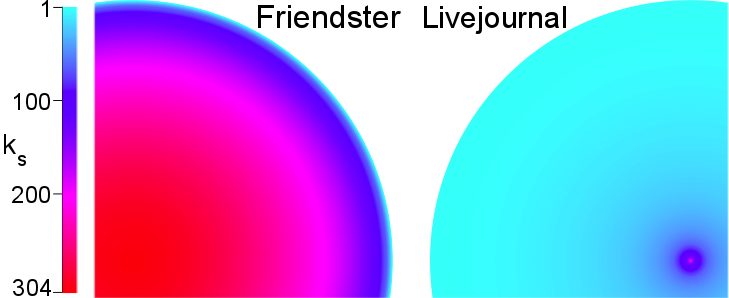
Social resilience in online communities: The autopsy of Friendster
|
[2013]
|
|
Garcia, David;
Mavrodiev, Pavlin;
Schweitzer, Frank
|
Proceedings of the 1st ACM Conference in Online Social Networks (COSN'13),
pages: 39-50
|
more» «less
|
Abstract
We empirically analyze five online communities: Friendster, Livejournal, Facebook, Orkut, Myspace, to identify causes for the decline of social networks. We define social resilience as the ability of a community to withstand changes. We do not argue about the cause of such changes, but concentrate on their impact. Changes may cause users to leave, which may trigger further leaves of others who lost connection to their friends. This may lead to cascades of users leaving. A social network is said to be resilient if the size of such cascades can be limited. To quantify resilience, we use the k-core analysis, to identify subsets of the network in which all users have at least k friends. These connections generate benefits (b) for each user, which have to outweigh the costs (c) of being a member of the network. If this difference is not positive, users leave. After all cascades, the remaining network is the k-core of the original network determined by the cost-to-benefit c/b ratio. By analysing the cumulative distribution of k-cores we are able to calculate the number of users remaining in each community. This allows us to infer the impact of the c/b ratio on the resilience of these online communities. We find that the different online communities have different k-core distributions. Consequently, similar changes in the c/b ratio have a different impact on the amount of active users. As a case study, we focus on the evolution of Friendster. We identify time periods when new users entering the network observed an insufficient c/b ratio. This measure can be seen as a precursor of the later collapse of the community. Our analysis can be applied to estimate the impact of changes in the user interface, which may temporarily increase the c/b ratio, thus posing a threat for the community to shrink, or even to collapse.

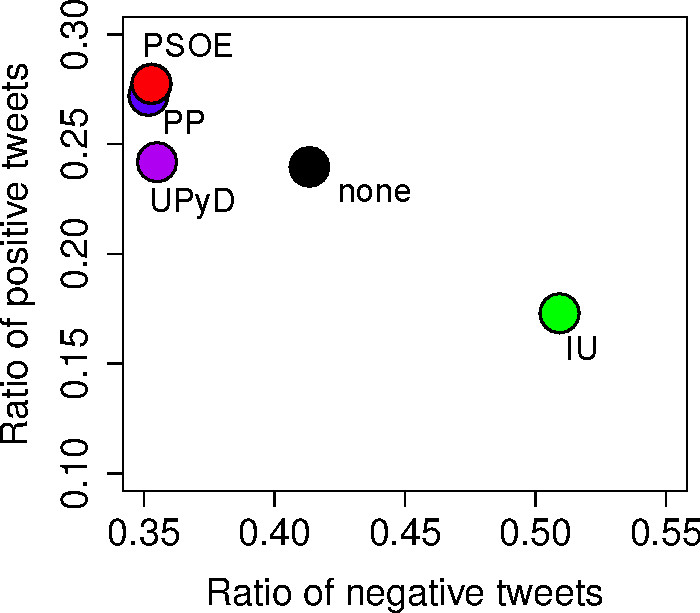
Political alignment and emotional expression in Spanish Tweets
|
[2013]
|
|
Garcia, David;
Thelwall, Mike
|
Workshop on Sentiment Analysis at SEPLN
|
more» «less
|
Abstract
We present a study political discourse and emotional expression through
a dataset of Spanish tweets. We analyze the political position of four major parties
through their Twitter activity, revealing that Twitter political discourse depends
on subjective perception, and resembles the political space of Spain. We propose
a simplified lexicon-based method to identify the topics of a tweet, which works
especially well to detect the political content of tweets. Furthermore, we adapted
SentiStrength to Spanish, by translating and converting an established lexicon of
word valence. Under certain design decisions, this tool performs better than random,
with ample room for improvement. Finally, we combined three datasets to analyze
the sentiment expressed in the political tweets of four major Spanish parties, finding
differences related to the status quo, and the Spanish political climate.

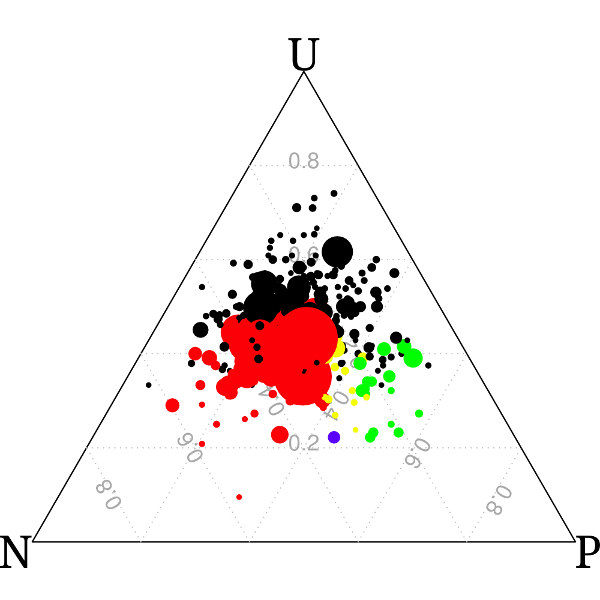
The Role of Emotions in Contributors Activity: A Case Study of the Gentoo Community
|
[2013]
|
|
Garcia, David;
Zanetti, Marcelo Serrano;
Schweitzer, Frank
|
In Proceedings of the International Conference on Social Computing and Its Applications,
pages: 410-417
|
more» «less
|
Abstract
We analyse the relation between the emotions and the activity of contributors in the Open Source Software project Gentoo. Our case study builds on extensive data sets from the project's bug tracking platform Bugzilla, to quantify the activity of contributors, and its mail archives, to quantify the emotions of contributors by means of sentiment analysis. The Gentoo project is known for a considerable drop in development performance after the sudden retirement of a central contributor. We analyse how this event correlates with the negative emotions, both in bilateral email discussions with the central contributor, and at the level of the whole community of contributors. We then extend our study to consider the activity patters on Gentoo contributors in general. We find that contributors are more likely to become inactive when they express strong positive or negative emotions in the bug tracker, or when they deviate from the expected value of emotions in the mailing list. We use these insights to develop a Bayesian classifier that detects the risk of contributors leaving the project. Our analysis opens new perspectives for measuring online contributor motivation by means of sentiment analysis and for real-time predictions of contributor turnover in Open Source Software projects.

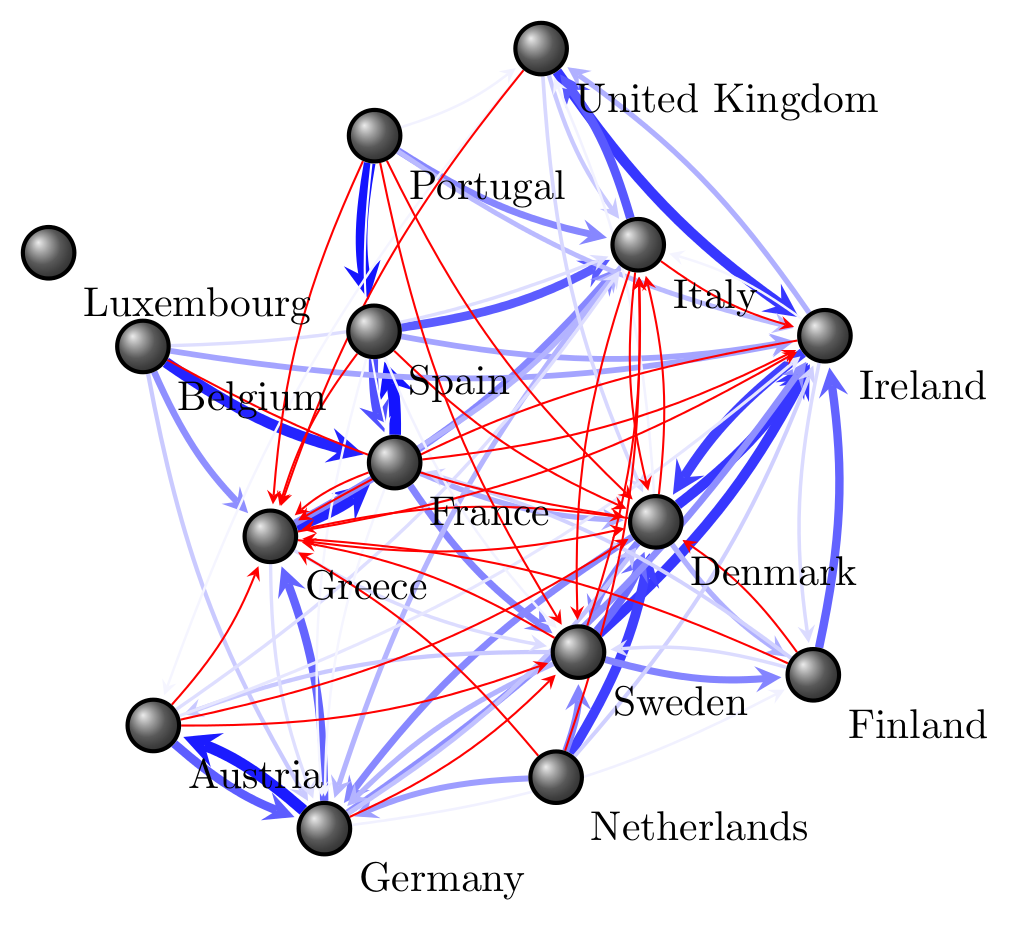
Measuring cultural dynamics through the Eurovision song contest
|
[2013]
|
|
Garcia, David;
Tanase, Dorian
|
ACS - Advances in Complex Systems,
pages: 33,
volume: 16,
number: 8
|
more» «less
|
Abstract
Measuring culture and its dynamics through surveys has important limitations, but the emerging eld of computational social science allows us to overcome them by analyzing large-scale datasets. In this article, we study cultural dynamics through the votes in the Eurovision song contest, which are decided by a crowd-based scheme in which viewers vote through mobile phone messages. Taking into account asymmetries and imperfect perception of culture, we measure cultural relations among European countries in terms of cultural anity. We propose the Friend-or-Foe coecient, a metric to measure voting biases among participants of a Eurovision contest. To validate how this metric represent cultural anity, we designed a model of a random, biased Eurovision contest. Simulations of this model show how our metrics can detect negative anities and serve as an estimator for positive anities. We apply this estimator to the historical set of Eurovision contests from 1975 to 2012, nding patterns of asymmetry and clustering in the resulting networks. Furthermore, we dene a measure of vote polarization that, when applied to empirical data, shows a sharp increase within countries of the EU during 2010 and 2011. As a result, we measure how the recent political decisions of EU states inuence the way their citizens relate to the culture of other EU members, leading to stronger cultural biases in the way they vote in the Eurovision song contest.


Damping sentiment analysis in online communication: Discussions, monologs and dialogs
|
[2013]
|
|
Thelwall, Mike;
Buckley, Kevan;
Paltoglou, George;
Skowron, Marcin;
Garcia, David;
Gobron, Stephane;
Ahn, Junghyun;
Kappas, Arvid;
Kuster, Dennis;
Janusz, A
|
In Proceedings of the 14th international conference on Computational Linguistics and Intelligent Text Processing
|
more» «less
|
Abstract
Sentiment analysis programs are now sometimes used to detect patterns of sentiment use over time in online communication and to help automated systems interact better with users. Nevertheless, it seems that no previouspublished study has assessed whether the position of individual texts within ongoing communication can be exploited to help detect their sentiments. This article assesses apparent sentiment anomalies in on-going communication – textsassigned significantly different sentiment strength to the average of previoustexts – to see whether their classification can be improved. The results suggestthat a damping procedure to reduce sudden large changes in sentiment can improve classification accuracy but that the optimal procedure will depend on thetype of texts processed.

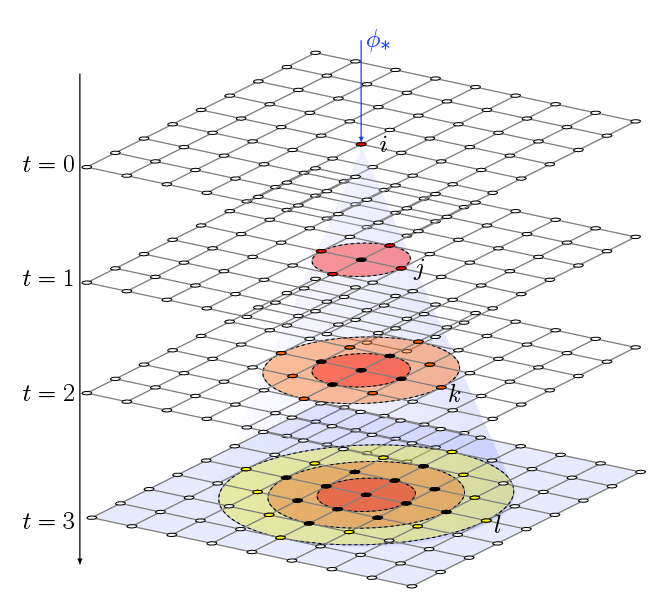
How big is too big? Critical shocks for systemic failure cascades
|
[2013]
|
|
Tessone, Claudio Juan;
Garas, Antonios;
Guerra, Beniamino;
Schweitzer, Frank
|
Journal of Statistical Physics,
pages: 765-783,
volume: 151,
number: 3
|
more» «less
|
Abstract
External or internal shocks may lead to the collapse of a system consisting of many agents. If the shock hits only one agent initially and causes it to fail, this can induce a cascade of failures among neighoring agents. Several critical constellations determine whether this cascade remains finite or reaches the size of the system, i.e. leads to systemic risk. We investigate the critical parameters for such cascades in a simple model, where agents are characterized by an individual threshold $$theta_i determining their capacity to handle a load $$alpha$$theta_i with 1-$$alpha being their safety margin. If agents fail, they redistribute their load equally to K neighboring agents in a regular network. For three different threshold distributions P($$theta), we derive analytical results for the size of the cascade, X(t), which is regarded as a measure of systemic risk, and the time when it stops. We focus on two different regimes, (i) EEE, an external extreme event where the size of the shock is of the order of the total capacity of the network, and (ii) RIE, a random internal event where the size of the shock is of the order of the capacity of an agent. We find that even for large extreme events that exceed the capacity of the network finite cascades are still possible, if a power-law threshold distribution is assumed. On the other hand, even small random fluctuations may lead to full cascades if critical conditions are met. Most importantly, we demonstrate that the size of the "big" shock is not the problem, as the systemic risk only varies slightly for changes of 10 to 50 percent of the external shock. Systemic risk depends much more on ingredients such as the network topology, the safety margin and the threshold distribution, which gives hints on how to reduce systemic risk.


Categorizing bugs with social networks: A case study on four open source software communities
|
[2013]
|
|
Zanetti, Marcelo Serrano;
Scholtes, Ingo;
Tessone, Claudio Juan;
Schweitzer, Frank
|
In Proceedings of the International Conference on Software Engineering,
pages: 1032-1041
|
more» «less
|
Abstract
Efficient bug triaging procedures are an important precondition for successful collaborative software engineering projects. Triaging bugs can become a laborious task particularly in open source software (OSS) projects with a large base of comparably inexperienced part-time contributors. In this paper, we propose an efficient and practical method to identify valid bug reports which a) refer to an actual software bug, b) are not duplicates and c) contain enough information to be processed right away. Our classification is based on nine measures to quantify the social embeddedness of bug reporters in the collaboration network. We demonstrate its applicability in a case study, using a comprehensive data set of more than 700, 000 bug reports obtained from the BUGZILLA installation of four major OSS communities, for a period of more than ten years. For those projects that exhibit the lowest fraction of valid bug reports, we find that the bug reporters’ position in the collaboration network is a strong indicator for the quality of bug reports. Based on this finding, we develop an automated classification scheme that can easily be integrated into bug tracking platforms and analyze its performance in the considered OSS communities. A support vector machine (SVM) to identify valid bug reports based on the nine measures yields a precision of up to 90.3% with an associated recall of 38.9%. With this, we significantly improve the results obtained in previous case studies for an automated early identification of bugs that are eventually fixed. Furthermore, our study highlights the potential of using quantitative measures of social organization in collaborative software engineering. It also opens a broad perspective for the integration of social network analysis in the design of support infrastructures.

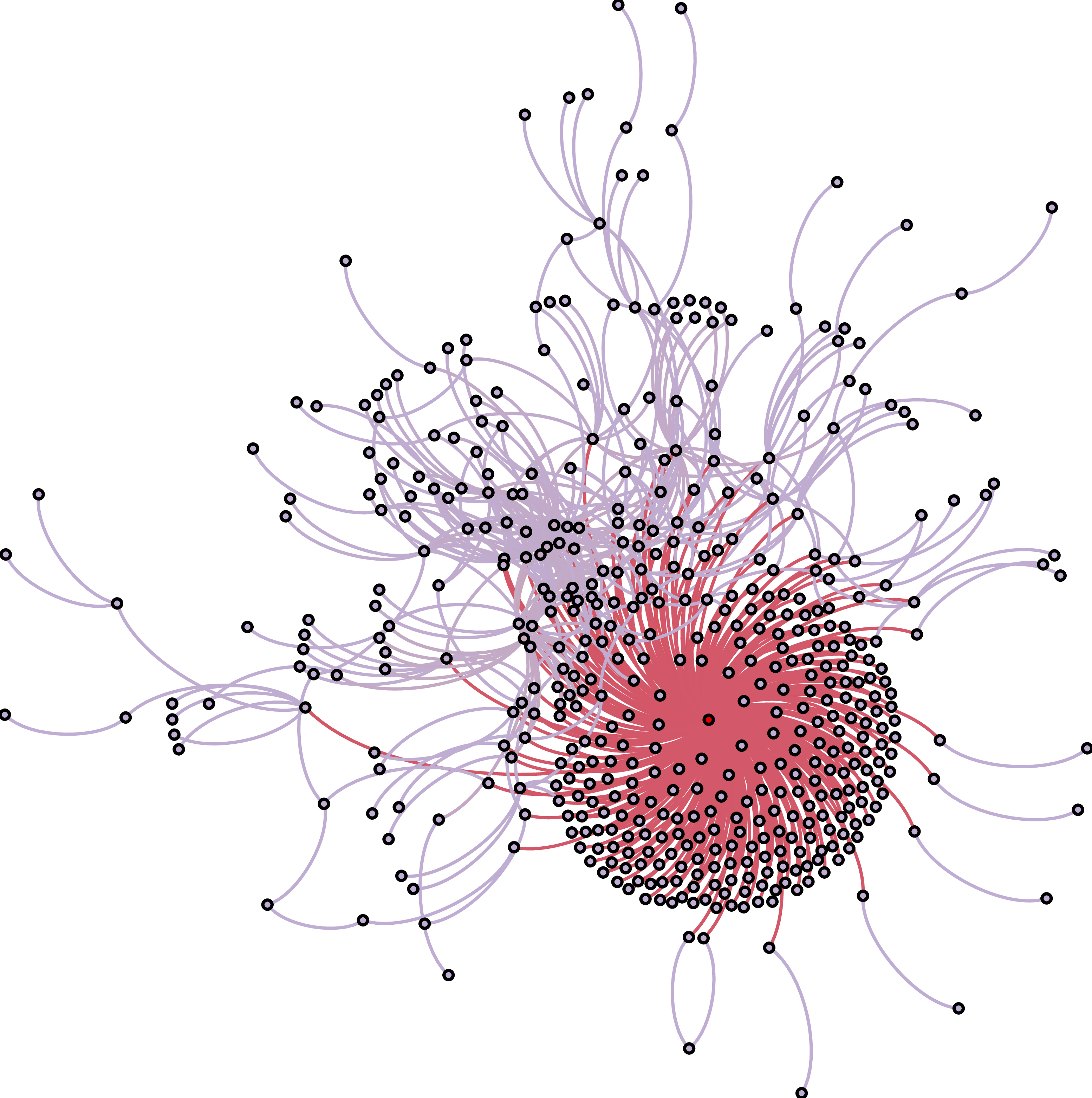
The rise and fall of a central contributor: Dynamics of social organization and performance in the Gentoo community
|
[2013]
|
|
Zanetti, Marcelo Serrano;
Scholtes, Ingo;
Tessone, Claudio Juan;
Schweitzer, Frank
|
In Proceedings of the International Workshop on Cooperative and Human Aspects of Software Engineering,
pages: 49-56
|
more» «less
|
Abstract
Social organization and division of labor crucially influence the performance of collaborative software engineering efforts. In this paper, we provide a quantitative analysis of the relation between social organization and performance in Gentoo, an Open Source community developing a Linux distribution. We study the structure and dynamics of collaborations as recorded in the project's bug tracking system over a period of ten years. We identify a period of increasing centralization after which most interactions in the community were mediated by a single central contributor. In this period of maximum centralization, the central contributor unexpectedly left the project, thus posing a significant challenge for the community. We quantify how the rise, the activity as well as the subsequent sudden dropout of this central contributor affected both the social organization and the bug handling performance of the Gentoo community. We analyze social organization from the perspective of network theory and augment our quantitative findings by interviews with prominent members of the Gentoo community which shared their personal insights.

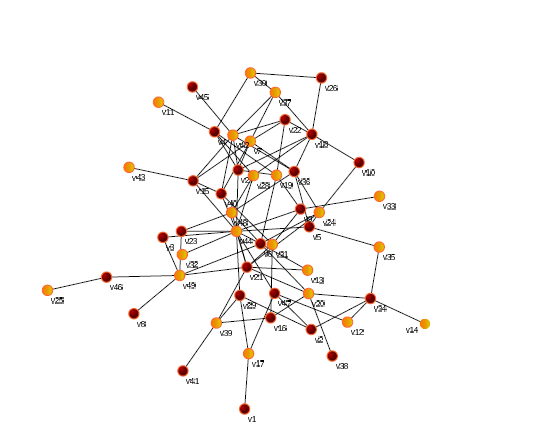
Evolution of controllability in interbank networks
|
[2013]
|
|
Delpini, Danilo;
Battiston, Stefano;
Riccaboni, Massimo;
Gabbi, Giampaolo;
Pammolli, Fabio;
Caldarelli, Guido
|
Scientific reports,
pages: 1626,
volume: 3,
number: 1626
|
more» «less
|
Abstract
The Statistical Physics of Complex Networks has recently provided new theoretical tools for policy makers. Here we extend the notion of network controllability to detect the financial institutions, i.e. the drivers, that are most crucial to the functioning of an interbank market. The system we investigate is a paradigmatic case study for complex networks since it undergoes dramatic structural changes over time and links among nodes can be observed at several time scales. We find a scale-free decay of the fraction of drivers with increasing time resolution, implying that policies have to be adjusted to the time scales in order to be effective. Moreover, drivers are often not the most highly connected "hub" institutions, nor the largest lenders, contrary to the results of other studies. Our findings contribute quantitative indicators which can support regulators in developing more effective supervision and intervention policies.

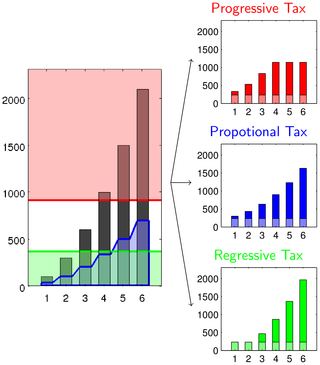
Redistribution spurs growth by using a portfolio effect on risky human capital
|
[2013]
|
|
Lorenz, Jan;
Paetzel, Fabian;
Schweitzer, Frank
|
PLOS ONE,
pages: e54904,
volume: 8,
number: 2
|
more» «less
|
Abstract
We demonstrate by mathematical analysis and systematic computer simulations that redistribution can lead to sustainable growth in a society. In accordance with economic models of risky human capital, we assume that dynamics of human capital is modeled as a multiplicative stochastic process which, in the long run, leads to the destruction of individual human capital. When agents are linked by fully redistributive taxation the situation might turn to individual growth in the long run. We consider that a government collects a proportion of income and reduces it by a fraction as costs for administration (efficiency losses). The remaining public good is equally redistributed to all agents. Sustainable growth is induced by redistribution despite the losses from the random growth process and despite administrative costs. Growth results from a portfolio effect. The findings are verified for three different tax schemes: proportional tax, taking proportionally more from the rich, and proportionally more from the poor. We discuss which of these tax schemes performs better with respect to maximize growth under a fixed rate of administrative costs, and the governmental income. This leads us to general conclusions about governmental decisions, the relation to public good games with free riding, and the function of taxation in a risk-taking society.
Complex Structures and Collective Dynamics in Networked Systems: A Tutorial
|
[2013]
|
|
Scholtes, Ingo;
Esch, Markus
|
In Proceedings of 7th IEEE International Conference on Self-Adaptive and Self-Organizing Systems, SASO 2013
|
more» «less
|
Abstract
The study of complex networks and collective dynamics occurring in biological, social and technical systems has experienced a massive surge of interest both from academia and industry. Many of the results on the mechanisms underlying the self-organized formation of complex dynamic networks in natural and man-made systems have been derived based on a statistical physics perspective. In this tutorial, we provide a basic introduction to this perspective which will help attendees to benefit from the vast literature on self-organization and self-adaptation phenomena available in the fields of network science and complex systems. We cover basic models and abstractions for the study of static complex networks as well as dynamical processes like, e.g., information diffusion, random walks, synchronization or the propagation of cascading failures. We further introduce recent advances in the study of dynamic (social) networks and demonstrate how the resulting methods can be practically applied in the engineering of self-organizing and self-adaptive distributed systems and protocols.

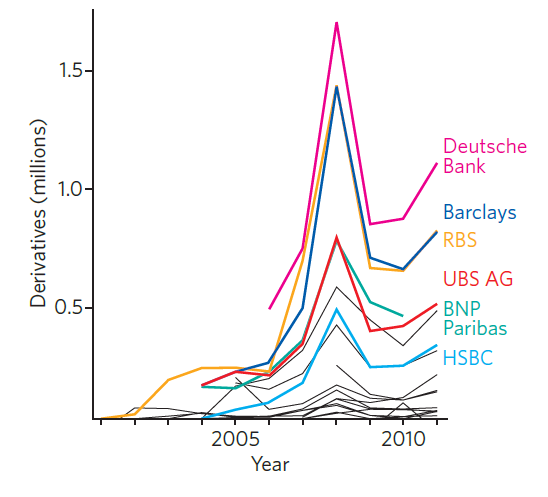
Complex derivatives
|
[2013]
|
|
Battiston, Stefano;
Caldarelli, Guido;
Georg, Co - Pierre;
May, Robert;
Stiglitz, Joseph
|
Nature Physics,
pages: 123-- 125,
volume: 9,
number: 3
|
more» «less
|
Abstract
The intrinsic complexity of the financial derivatives market has emerged as both an incentive to engage in it, and a key source of its inherent instability. Regulators now faced with the challenge of taming this beast may find inspiration in the budding science of complex systems.
The power to control
|
[2013]
|
|
Galbiati, Marco;
Delpini, Danilo;
Battiston, Stefano
|
Nature Physics,
pages: 126-- 128,
volume: 9,
number: 3
|
more» «less
|
Abstract
Understanding something of the complexity of a financial network is one thing, influencing the behaviour of that system is another. But new tools from network science define a notion of 'controllability' that, coupled with 'centrality', could prove useful to economists and financial regulators.


Bootstrapping Topological Properties and Systemic Risk of Complex Networks Using the Fitness Model
|
[2013]
|
|
Musmeci, Nicolo;
Battiston, Stefano;
Caldarelli, Guido;
Puliga, Michelangelo;
Gabrielli, Andrea
|
Journal of Statistical Physics,
pages: 720-734,
volume: 151,
number: 3-4
|
more» «less
|
Abstract
In this paper we present a novel method to reconstruct global topological properties of a complex network starting from limited information. We assume to know for all the nodes a non-topological quantity that we interpret as fitness. In contrast, we assume to know the degree, i.e. the number of connections, only for a subset of the nodes in the network. We then use a fitness model, calibrated on the subset of nodes for which degrees are known, in order to generate ensembles of networks. Here, we focus on topological properties that are relevant for processes of contagion and distress propagation in networks, i.e. network density and k-core structure, and we study how well these properties can be estimated as a function of the size of the subset of nodes utilized for the calibration. Finally, we also study how well the resilience to distress propagation in the network can be estimated using our method. We perform a first test on ensembles of synthetic networks generated with the Exponential Random Graph model, which allows to apply common tools from statistical mechanics. We then perform a second test on empirical networks taken from economic and financial contexts. In both cases, we find that a subset as small as 10 % of nodes can be enough to estimate the properties of the network along with its resilience with an error of 5 %.

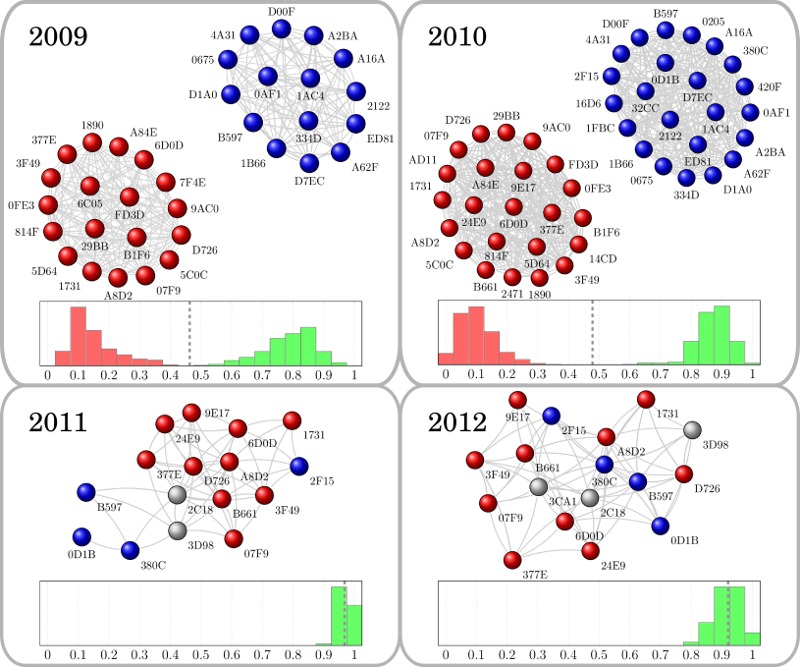
Bechstein's bats maintain individual social links despite a complete reorganisation of their colony structure
|
[2013]
|
|
Baigger, Anja;
Perony, Nicolas;
Leinert, Vera;
Melber, Markus;
Grunberger, Stefanie;
Fleischmann, Daniela;
Kerth, Gerald
|
Naturwissenschaften,
pages: 895-898,
volume: 100,
number: 9
|
more» «less
|
Abstract
Several social mammals, including elephants and some primates, whales and bats, live in multi-level societies that form temporary subgroups. Despite these fission-fusion dynamics, group members often maintain long-term bonds. However, it is unclear whether such individual links and the resulting stable social subunits continue to exist after a complete reorganisation of a society, e.g. following a population crash. Here we employed a weighted network analysis on 7109 individual roosting records collected over four years in a wild Bechstein's bat colony. We show that, in response to a strong population decline, the colony's two stable social subunits fused into a non-modular social network. Nevertheless, in the first year after the crash, long-term bonds were still detectable, suggesting that the bats remembered previous individual relationships. Our findings are important for understanding the flexibility of animal societies in the face of dramatic changes, and for the conservation of social mammals with declining populations.

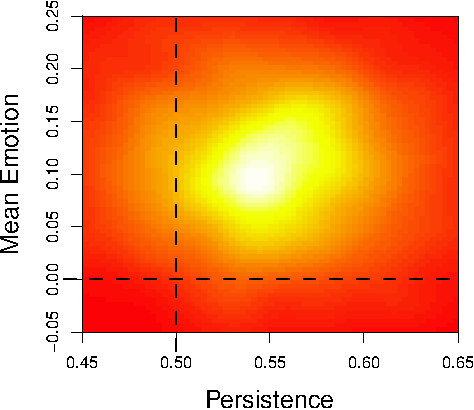
Dyads to Groups : Modeling Interactions with Affective Dialog Systems
|
[2013]
|
|
Rank, Stefan;
Skowron, Marcin;
Garcia, David
|
International Journal of Computational Linguistics Research,
pages: 22-- 32,
volume: 4,
number: 1
|
more» «less
|
Abstract
Affect Listeners are applied as tools for studying the role of emotions in online communication. They need to interact both in dyads as well as in group settings with multiple users. In this paper, we present the evolution of such affective dialog systems from a focus on dyadic interaction to multi-party interaction on chat networks. Starting from experiments on the use of these dialog systems in virtual dyadic settings, we outline the requirements, design and implementation decisions necessary to apply the systems to affective interactions with multiple users. Finally, we introduce two realisations of Interactive Affective Bots designed for such interaction scenarios that integrate modelling of individuals and groups as part of their decision mechanism.

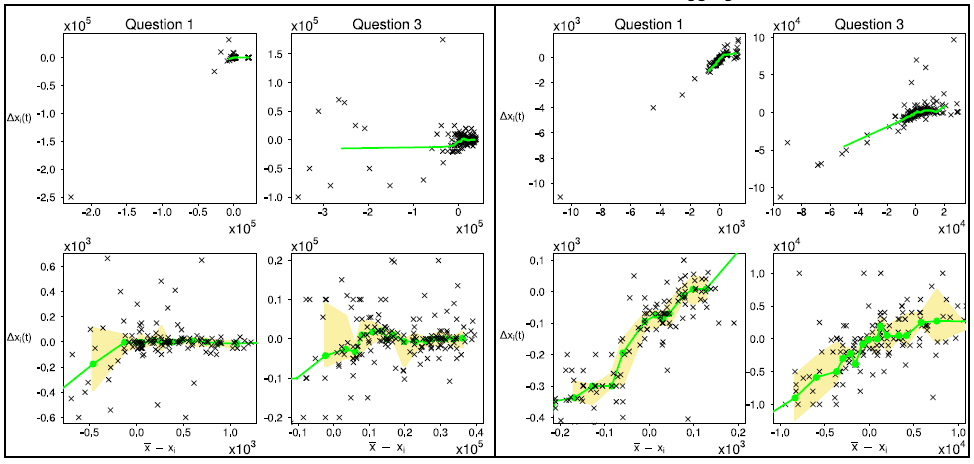
Quantifying the effects of social influence
|
[2013]
|
|
Mavrodiev, Pavlin;
Tessone, Claudio Juan;
Schweitzer, Frank
|
Scientific Reports,
volume: 3,
number: 1360
|
more» «less
|
Abstract
How do humans respond to indirect social influence when making decisions? We analysed an experiment where subjects had to repeatedly guess the correct answer to factual questions, while having only aggregated information about the answers of others. While the response of humans to aggregated information is a widely observed phenomenon, it has not been investigated quantitatively, in a controlled setting. We found that the adjustment of individual guesses depends linearly on the distance to the mean of all guesses. This is a remarkable, and yet surprisingly simple, statistical regularity. It holds across all questions analysed, even though the correct answers differ in several orders of magnitude. Our finding supports the assumption that individual diversity does not affect the response to indirect social influence. It also complements previous results on the nonlinear response in information-rich scenarios. We argue that the nature of the response to social influence crucially changes with the level of information aggregation. This insight contributes to the empirical foundation of models for collective decisions under social influence.

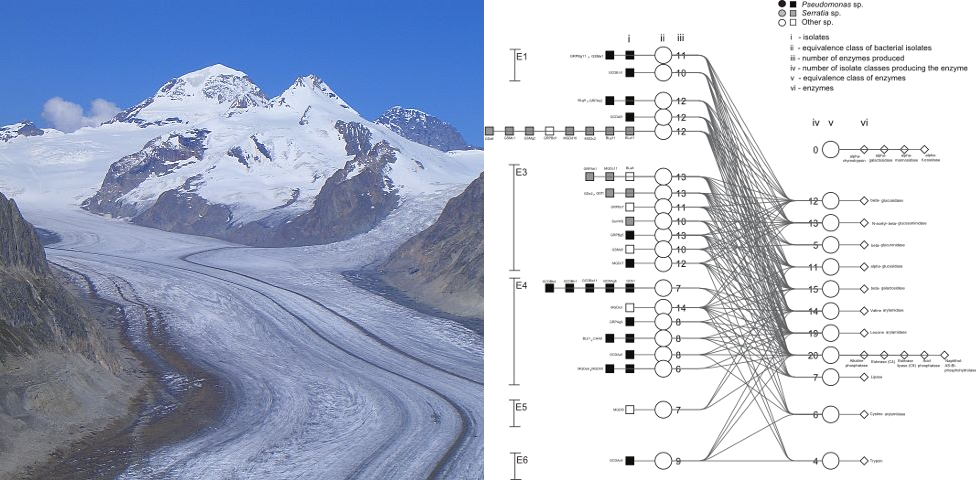
Use of a four-tiered graph to parse the factors leading to phenotypic clustering in bacteria: a case study based on samples from the Aletsch Glacier
|
[2013]
|
|
Svercel, Miroslav;
Filippini, Manuela;
Perony, Nicolas;
Rossetti, Valentina;
Bagheri, Homayoun C.
|
PLOS ONE,
pages: e65059,
volume: 8,
number: 5
|
more» «less
|
Abstract
An understanding of bacterial diversity and evolution in any environment requires knowledge of phenotypic diversity. In this study, the underlying factors leading to phenotypic clustering were analyzed and interpreted using a novel approach based on a four-tiered graph. Bacterial isolates were organized into equivalence classes based on their phenotypic profile. Likewise, phenotypes were organized in equivalence classes based on the bacteria that manifest them. The linking of these equivalence classes in a four-tiered graph allowed for a quick visual identification of the phenotypic measurements leading to the clustering patterns deduced from principal component analyses. For evaluation of the method, we investigated phenotypic variation in enzyme production and carbon assimilation of members of the genera Pseudomonas and Serratia, isolated from the Aletsch Glacier in Switzerland. The analysis indicates that the genera isolated produce at least six common enzymes and can exploit a wide range of carbon resources, though some specialist species within the pseudomonads were also observed. We further found that pairwise distances between enzyme profiles strongly correlate with distances based on carbon profiles. However, phenotypic distances weakly correlate with phylogenetic distances. The method developed in this study facilitates a more comprehensive understanding of phenotypic clustering than what would be deduced from principal component analysis alone.
Remarks
Miro Svercel, Manuela Filippini and Nicolas Perony contributed equally to the study.

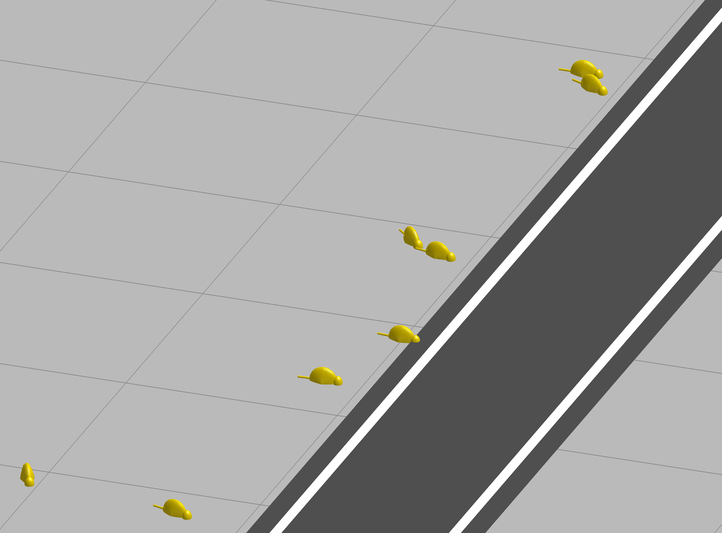
Why did the meerkat cross the road? Flexible adaptation of phylogenetically-old behavioural strategies to modern-day threats
|
[2013]
|
|
Perony, Nicolas;
Townsend, Simon W.
|
PLOS ONE,
pages: e52834,
volume: 8,
number: 2
|
more» «less
|
Abstract
Risk-sensitive adaptive spatial organisation during group movement has been shown to efficiently minimise the risks associated with external ecological threats. Whether animals can draw on such behaviours when confronted with man-made threats is generally less clear. We studied road-crossing in a wild, but habituated, population of meerkats living in the Kalahari Desert, South Africa. We found that dominant females, the core member in meerkat social systems, led groups to the road significantly more often than subordinates, yet were consistently less likely to cross first. Our results suggest that a reshuffling occurs in progression order when meerkat groups reach the road. By employing a simple model of collective movement, we have shown that risk aversion alone may be sufficient to explain this reshuffling, but that the risk aversion of dominant females toward road crossing is significantly higher than that of subordinates. It seems that by not crossing first, dominant females avoid occupying the most risky, exposed locations, such as at the front of the group – a potential selfish strategy that also promotes the long-term stability and hence reproductive output of their family groups. We argue that our findings support the idea that animals can flexibly apply phylogenetically-old behavioural strategies to deal with emerging modern-day problems.

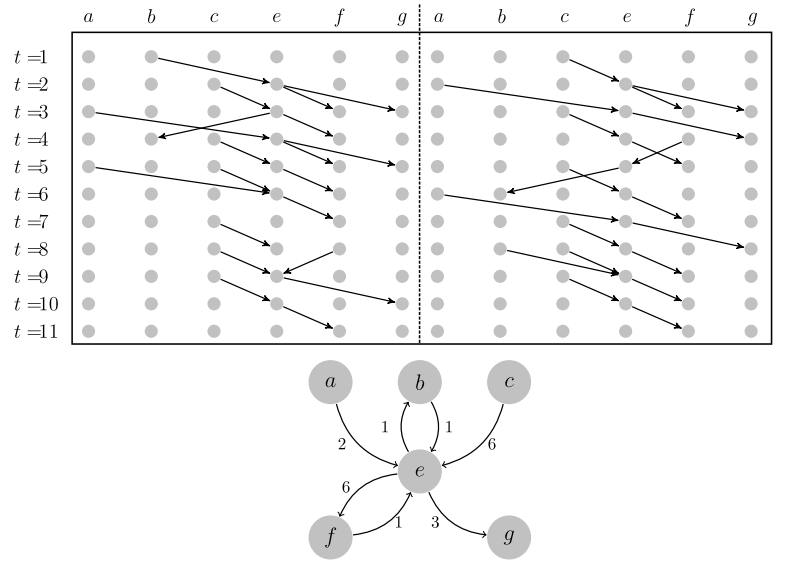
Betweenness preference: Quantifying correlations in the topological dynamics of temporal networks
|
[2013]
|
|
Pfitzner, Rene;
Scholtes, Ingo;
Garas, Antonios;
Tessone, Claudio Juan;
Schweitzer, Frank
|
Physical Review Letters,
pages: 198701,
volume: 110,
number: 19
|
more» «less
|
Abstract
Time-evolving interaction patterns studied in different contexts can be well represented bytemporal networks in which nodes are intermittently connected. In this Letter we introducethe notion of betweenness preference in the study of temporal networks. It captures how likelya certain node is to mediate interactions between particular pairs of its neighboring nodes.We argue that betweenness preference is an important correlation to consider in the analysisof temporal network data. In particular, it allows to assess to which extent paths existing intime-aggregated, static representations of temporal networks are actually feasible based onthe underlying sequence of interactions. We argue that betweenness preference correlationsare present in empirical data sets. We further show that neglecting betweenness preferencewill lead to significantly wrong statements about spreading dynamics in temporal networks.

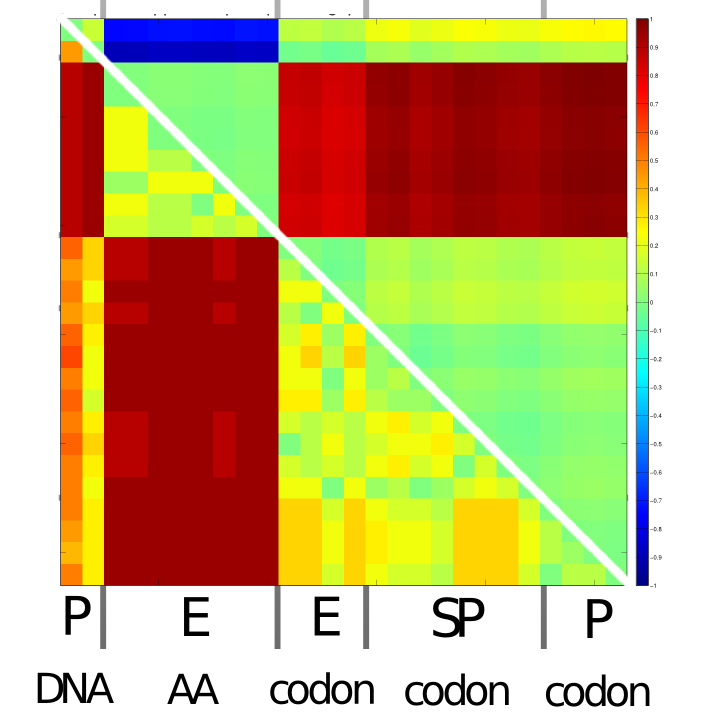
Codonphyml: Fast maximum likelihood phylogeny estimation under codon substitution models
|
[2013]
|
|
Zanetti, Marcelo Serrano;
Gil, Manuel;
Zoller, Stefan;
Anisimova, Maria
|
Molecular Biology and Evolution,
pages: 1270-1280,
volume: 30,
number: 6
|
more» «less
|
Abstract
Recently, Markov models of codon substitution have come into the spotlight. By incorporating the structure of the genetic code and the selection intensity at the protein level they provide a more realistic representation of protein-coding sequences than nucleotide or amino acid models. Thus, for protein-coding genes phylogenetic inference is expected to be more accurate under codon models. So far, phylogeny reconstruction under codon models has been elusive due to computational difficulties of dealing with high dimension matrices. Here we present a fast maximum likelihood package for phylogenetic inference, CodonPhyML offering hundreds of different codon models, the largest variety to date, for phylogeny inference by maximum likelihood. CodonPhyML is tested on simulated and real data, and is shown to offer excellent speed and convergence properties. In addition, CodonPhyML includes most recent fast methods for estimating phylogenetic branch supports, and provides an integral framework for models selection, including amino acid and DNA models.
Remarks
Zanetti and Gil contributed equally to the article.
Reconstructing a credit network
|
[2013]
|
|
Caldarelli, Guido;
Chessa, Alessandro;
Pammolli, Fabio;
Gabrielli, Andrea;
Puliga, Michelangelo
|
Nature Physics,
pages: 125-- 126,
volume: 9,
number: 3
|
more» «less
|
Abstract
The science of complex networks can be usefully applied in finance, although there is limited data available with which to develop our understanding. All is not lost, however: ideas from statistical physics make it possible to reconstruct details of a financial network from partial sets of information.

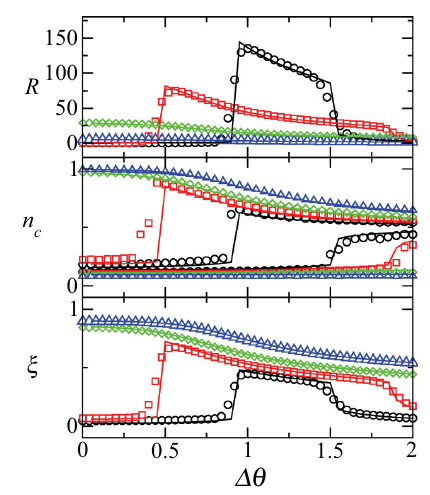
Diversity-induced resonance in the response to social norms
|
[2013]
|
|
Tessone, Claudio Juan;
Sanchez, Anxo;
Schweitzer, Frank
|
Physical Review E,
pages: 022803,
volume: 87
|
more» «less
|
Abstract
In this paper we focus on diversity-induced resonance, which was recently found in bistable, excitable, and other physical systems. We study the appearance of this phenomenon in a purely economic model of cooperating and defecting agents. An agent's contribution to a public good is seen as a social norm, so defecting agents face a social pressure, which decreases if free riding becomes widespread. In this model, diversity among agents naturally appears because of the different sensitivities towards the social norm. We study the evolution of cooperation as a response to the social norm (i) for the replicator dynamics and (ii) for the logit dynamics by means of numerical simulations. Diversity-induced resonance is observed as a maximum in the response of agents to changes in the social norm as a function of the degree of heterogeneity in the population. We provide an analytical, mean-field approach for the logit dynamics and find very good agreement with the simulations. From a socioeconomic perspective, our results show that, counterintuitively, diversity in the individual sensitivity to social norms may result in a society that better follows such norms as a whole, even if part of the population is less prone to follow them.

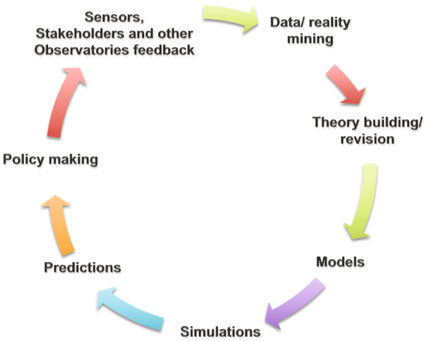
Exploratory of society
|
[2012]
|
|
Cederman, L. - E.;
Conte, R.;
Helbing, Dirk;
Nowak, A.;
Schweitzer, Frank;
Vespignani, Alessandro
|
The European Physical Journal Special Topics,
pages: 347-- 360,
volume: 214,
number: 1
|
more» «less
|
Abstract
A huge flow of quantitative social, demographic and behavioral data is becoming available that traces the activities and interactions of individuals, social patterns, transportation infrastructures and travel fluxes. This has caused, together with innovative computational techniques and methods for modeling social actions in hybrid (natural and artificial) societies, a qualitative change in the ways we model socio-technical systems. For the first time, society can be studied in a comprehensive fashion that addresses social and behavioral complexity. In other words we are in the position to envision the development of large data and computational cyber infrastructure defining an exploratory of society that provides quantitative anticipatory, explanatory and scenario analysis capabilities ranging from emerging infectious disease to conflict and crime surges. The goal of the exploratory of society is to provide the basic infrastructure embedding the framework of tools and knowledge needed for the design of forecast/anticipatory/crisis management approaches to socio technical systems, supporting future decision making procedures by accelerating the scientific cycle that goes from data generation to predictions.
Modularity, Dependence and Change
|
[2012]
|
|
Geipel, Markus Michael
|
Advances in Complex Systems,
pages: 22,
volume: 15,
number: 6
|
more» «less
|
Abstract
Technological artifacts such as software often comprise a large number of modules; more than twenty thousand in the case of the Java software Eclipse. While on the micro-level this system is modular, how should the building blocks be arranged on the macro-level? In the literature this question has mainly been addressed with the same arguments already used to advocate modularity on the micro-level: Dependencies should be minimized as they impede optimization and flexibility of the system. In contrast to this I argue that along with a change from the micro view to the macro view also the argumentation has to change. In this paper, I analyze the theoretical ramifications of dependency between modules on the macro-level. In particular, I argue that macro-level dependencies are first weak dependencies, and second, foster flexibility and change efficiency. This argumentation is supported by an empirical analysis of 35 software architectures. Data show that dependency relations seldom cause change propagation. Furthermore, high dependency in the architecture negatively correlates with the occurrence of large change events. Thus, higher interdependency is associated with higher evolvability and more efficient change.

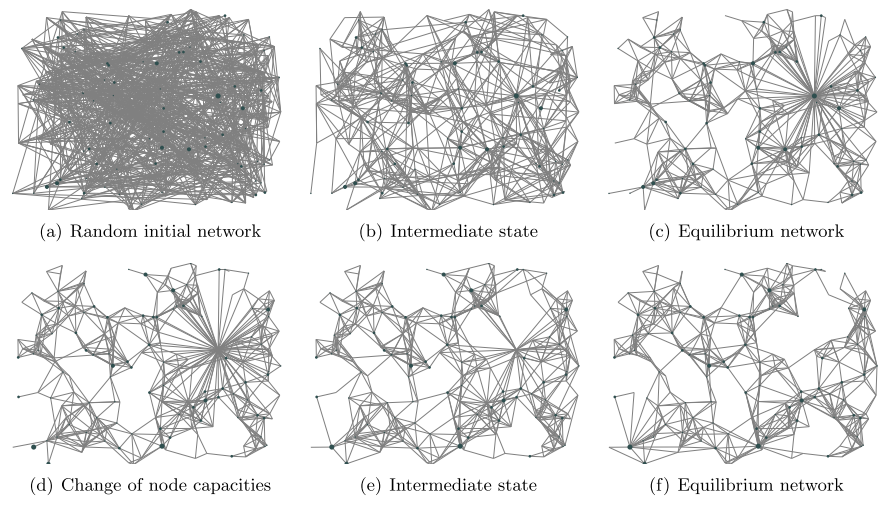
Organic design of massively distributed systems: A complex networks perspective
|
[2012]
|
|
Scholtes, Ingo;
Tessone, Claudio Juan
|
Informatik Spektrum,
pages: 1-- 12,
volume: 35,
number: 2
|
more» «less
|
Abstract
The vision of Organic Computing addresses challenges that arise in the design of future information systems that are comprised of numerous, heterogeneous, resource-constrained and error-prone components. The notion organic highlights the idea that, in order to be manageable, such systems should exhibit self-organization, self-adaptation and self-healing characteristics similar to those of biological systems. In recent years, the principles underlying these characteristics are increasingly being investigated from the perspective of complex systems science, particularly using the conceptual framework of statistical physics and statistical mechanics. In this article, we review some of the interesting relations between statistical physics and networked systems and discuss applications in the engineering of organic overlay networks with predictable macroscopic properties.

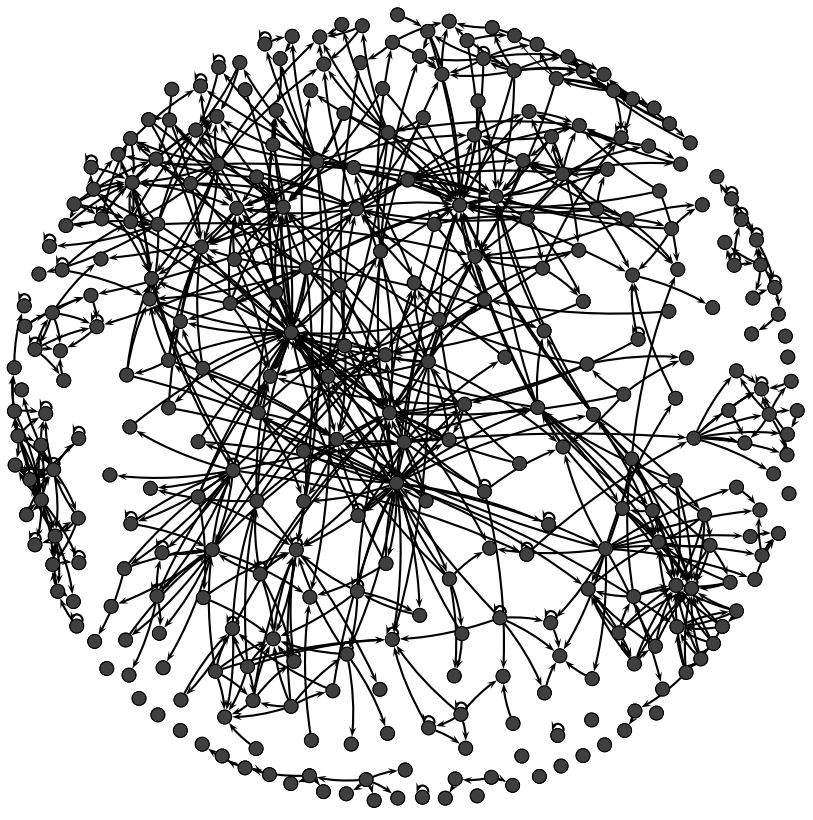
The Link between Dependency and Cochange: Empirical Evidence
|
[2012]
|
|
Geipel, Markus Michael;
Schweitzer, Frank
|
IEEE Transactions on Software Engineering,
pages: 1432-1444,
volume: 38,
number: 6
|
more» «less
|
Abstract
We investigate the relationship between class dependency and change propagation (cochange) in software written in Java. On the one hand, we find a strong correlation between dependency and cochange. Furthermore, we provide empirical evidence for the propagation of change along paths of dependency. These findings support the often alleged role of dependencies as propagators of change. On the other hand, we find that approximately half of all dependencies are never involved in cochanges and that the vast majority of cochanges pertain to only a small percentage of dependencies. This means that inferring the cochange characteristics of a software architecture solely from its dependency structure results in a severely distorted approximation of cochange characteristics. Any metric which uses dependencies alone to pass judgment on the evolvability of a piece of Java software is thus unreliable. As a consequence, we suggest to always take both the change characteristics and the dependency structure into account when evaluating software architecture.

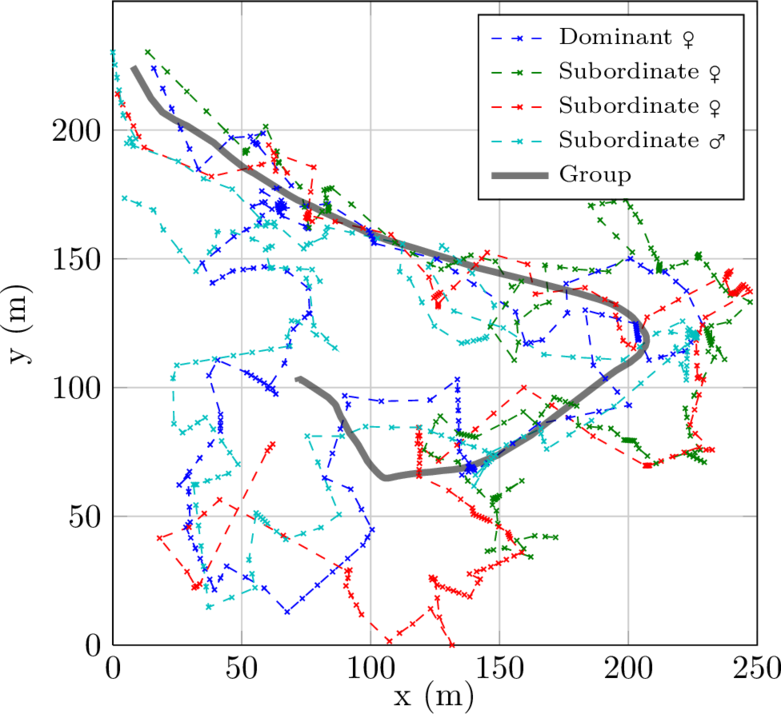
"Take me to your leader!": Inferring leadership in animal groups on the move
|
[2012]
|
|
Perony, Nicolas;
Richardson, Thomas R.;
Manser, Marta B.;
Schweitzer, Frank
|
Proceedings of the Thirteenth International Conference on the Simulation and Synthesis of Living Systems (Artificial Life 13)
|
more» «less
|
Remarks
Extended abstract
An economic and financial exploratory
|
[2012]
|
|
Cincotti, S;
Sornette, Didier;
Treleaven, P;
Battiston, Stefano;
Caldarelli, Guido;
Hommes, C;
Kirman, A
|
The European physical journal. Special topics,
pages: 361-- 400,
volume: 214,
number: 1
|
more» «less
|
Abstract
This paper describes the vision of a European Exploratory for economics and finance using an interdisciplinary consortium of economists, natural scientists, computer scientists and engineers, who will combine their expertise to address the enormous challenges of the 21st century. This Academic Public facility is intended for economic modelling, investigating all aspects of risk and stability, improving financial technology, and evaluating proposed regulatory and taxation changes. The European Exploratory for economics and finance will be constituted as a network of infrastructure, observatories, data repositories, services and facilities and will foster the creation of a new cross-disciplinary research community of social scientists, complexity scientists and computing (ICT) scientists to collaborate in investigating major issues in economics and finance. It is also considered a cradle for training and collaboration with the private sector to spur spin-offs and job creations in Europe in the finance and economic sectors. The Exploratory will allow Social Scientists and Regulators as well as Policy Makers and the private sector to conduct realistic investigations with real economic, financial and social data. The Exploratory will (i) continuously monitor and evaluate the status of the economies of countries in their various components, (ii) use, extend and develop a large variety of methods including data mining, process mining, computational and artificial intelligence and every other computer and complex science techniques coupled with economic theory and econometric, and (iii) provide the framework and infrastructure to perform what-if analysis, scenario evaluations and computational, laboratory, field and web experiments to inform decision makers and help develop innovative policy, market and regulation designs.


Liaisons Dangereuses: Increasing Connectivity, Risk Sharing, and Systemic Risk
|
[2012]
|
|
Battiston, Stefano;
Gatti, Domenico Delli;
Gallegati, Mauro;
Greenwald, Bruce C. N.;
Stiglitz, Joseph E.
|
Journal of Economic Dynamics and Control,
pages: 1121-- 1141,
volume: 36,
number: 8
|
more» «less
|
Abstract
The recent financial crisis poses the challenge to understand how systemic risk arises endogenously and what architecture can make the financial system more resilient to global crises. This paper shows that a financial network can be most resilient for intermediate levels of risk diversification, and not when this is maximal, as generally thought so far. This finding holds in the presence of the financial accelerator, i.e. when negative variations in the financial robustness of an agent tend to persist in time because they have adverse effects on the agent's subsequent performance through the reaction of the agent's counterparties.

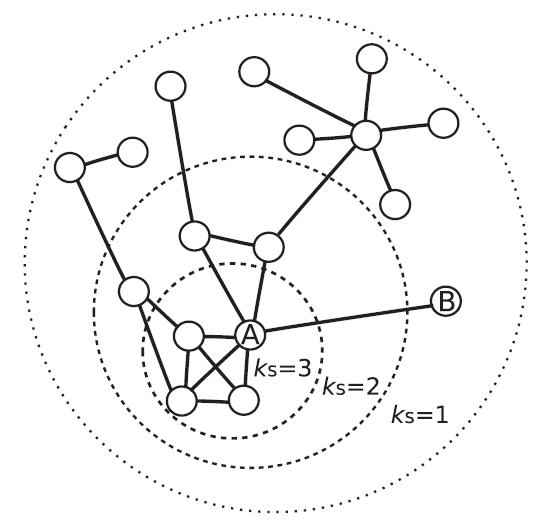
A k-shell decomposition method for weighted networks
|
[2012]
|
|
Garas, Antonios;
Schweitzer, Frank;
Havlin, Shlomo
|
New Journal of Physics,
pages: 083030,
volume: 14,
number: 8
|
more» «less
|
Abstract
We present a generalized method for calculating the k-shell structure of weighted networks. The method takes into account both the weight and the degree of a network, in such a way that in the absence of weights we resume the shell structure obtained by the classic k-shell decomposition. In the presence of weights, we show that the method is able to partition the network in a more refined way, without the need of any arbitrary threshold on the weight values. Furthermore, by simulating spreading processes using the susceptible-infectious-recovered model in four different weighted real-world networks, we show that the weighted k-shell decomposition method ranks the nodes more accurately, by placing nodes with higher spreading potential into shells closer to the core. In addition, we demonstrate our new method on a real economic network and show that the core calculated using the weighted k-shell method is more meaningful from an economic perspective when compared with the unweighted one.

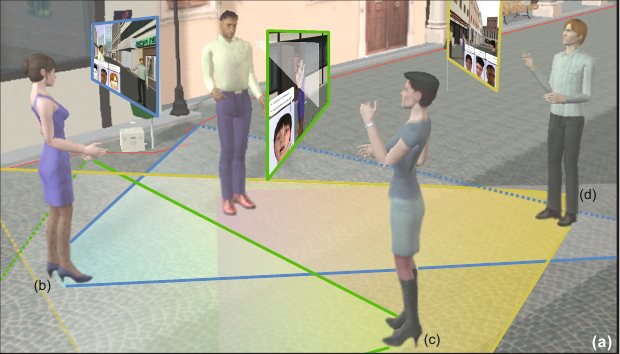
An event-based architecture to manage virtual human non-verbal communication in 3d chatting environment
|
[2012]
|
|
Gobron, Stephane;
Ahn, Junghyun;
Garcia, David;
Silvestre, Quentin;
Thalmann, Daniel;
Boulic, Ronan
|
Proceedings of the VII Conference on Articulated Motion and Deformable Objects 2012
|
more» «less
|
Abstract
Non-verbal communication (NVC) makes up about two-thirds of all communication between two people or between one speaker and a group of listeners. However, this fundamental aspect of communicating is mostly omitted in 3D social forums or virtual world oriented games. This paper proposes an answer by presenting a multi-user 3D-chatting system enriched with NVC relative to motion. This event-based architecture tries to recreate a context by extracting emotional cues from dialogs and derives virtual human potential body expressions from that event triggered context model. We structure the paper by expounding the system architecture enabling the modeling NVC in a multi-user 3D-chatting environment. There, we present the transition from dialog-based emotional cues to body language, and the management of NVC events in the context of a virtual reality client-server system. Finally, we illustrate the results with graphical scenes and a statistical analysis representing the increase of events due to NVC.

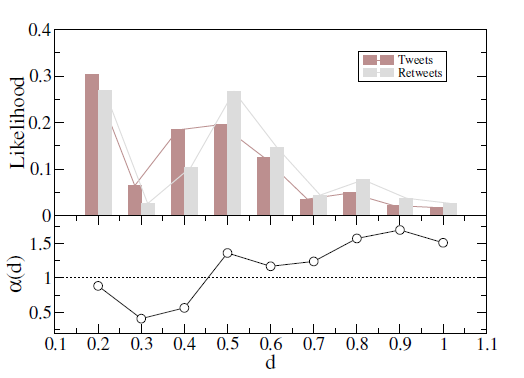
Emotional divergence influences information spreading in Twitter
|
[2012]
|
|
Pfitzner, Rene;
Garas, Antonios;
Schweitzer, Frank
|
Sixth International AAAI Conference on Weblogs and Social Media,
pages: 2-- 5
|
more» «less
|
Abstract
We analyze data about the micro-blogging site Twitter using sentiment extraction techniques. From an information per- spective, Twitter users are involved mostly in two processes: information creation and subsequent distribution (tweeting), and pure information distribution (retweeting), with pro- nounced preference to the first. However a rather substantial fraction of tweets are retweeted. Here, we address the role of the sentiment expressed in tweets for their potential after- math. We find that although the overall sentiment (polarity) does not influence the probability of a tweet to be retweeted, a new measure called emotional divergence does have an im- pact. In general, tweets with high emotional diversity have a better chance of being retweeted, hence influencing the dis- tribution of information.

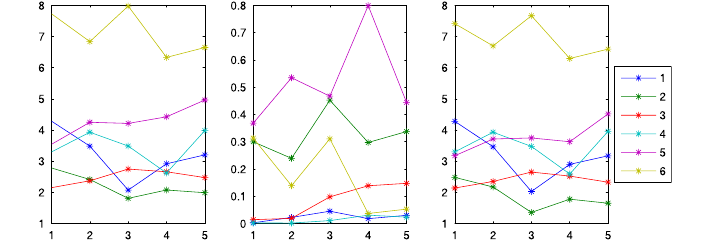
Effects of social influence on the wisdom of crowds
|
[2012]
|
|
Mavrodiev, Pavlin;
Tessone, Claudio Juan;
Schweitzer, Frank
|
In Proceedings of the conference on Collective Intelligence 2012
|
more» «less
|
Abstract
Wisdom of crowds refers to the phenomenon that the aggregate prediction or forecast of a group of individuals can be surprisingly more accurate than most individuals in the group, and sometimes - than any of the individuals comprising it. This article models the impact of social influence on the wisdom of crowds. We build a minimalistic representation of individuals as Brownian particles coupled by means of social influence. We demonstrate that the model can reproduce results of a previous empirical study. This allows us to draw more fundamental conclusions about the role of social influence: In particular, we show that the question of whether social influence has a positive or negative net effect on the wisdom of crowds is ill-defined. Instead, it is the starting configuration of the population, in terms of its diversity and accuracy, that directly determines how beneficial social influence actually is. The article further examines the scenarios under which social influence promotes or impairs the wisdom of crowds.


The efficiency and stability of R&D networks
|
[2012]
|
|
Koenig, Michael D;
Battiston, Stefano;
Napoletano, Mauro;
Schweitzer, Frank
|
Games and Economic Behavior,
pages: 694-713,
volume: 75,
number: 2
|
more» «less
|
Abstract
We investigate the efficiency and stability of R&D networks in a model with network-dependent indirect spillovers. We show that the efficient network structure critically depends on the marginal cost of R&D collaborations. When the marginal cost is low, the complete graph is efficient, while high marginal costs imply that the efficient network is asymmetric and has a nested structure. Regarding the stability of network structures, we show the existence of both symmetric and asymmetric equilibria. The efficient network is stable for small industry size and small cost. In contrast, for large industry size, there is a wide region of cost in which the efficient network is not stable. This implies a divergence between efficiency and stability in large industries.

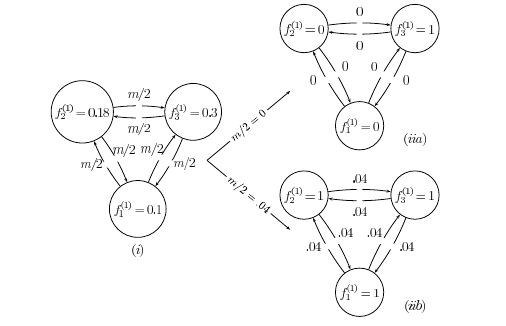
Optimal migration promotes the outbreak of cooperation in heterogeneous populations
|
[2012]
|
|
Schweitzer, Frank;
Behera, Laxmidhar
|
ACS - Advances in Complex Systems,
pages: 1250059,
volume: 15,
number: supp01
|
more» «less
|
Abstract
We consider a population of agents that are heterogeneous with respect to (i) their strategy when interacting ng times with other agents in an iterated prisoners dilemma game, (ii) their spatial location on K different islands. After each generation, agents adopt strategies proportional to their average payoff received. Assuming a mix of two cooperating and two defecting strategies, we first investigate for isolated islands the conditions for an exclusive domination of each of these strategies and their possible coexistence. This allows to define a threshold frequency for cooperation that, dependent on ng and the initial mix of strategies, describes the outbreak of cooperation in the absense of migration. We then allow migration of a fixed fraction of the population after each generation. Assuming a worst case scenario where all islands are occupied by defecting strategies, whereas only one island is occupied by cooperators at the threshold frequency, we determine the optimal migration rate that allows the outbreak of cooperation on all islands. We further find that the threshold frequency divided by the number of islands, i.e. the relative effort for invading defecting islands with cooperators decreases with the number of islands. We also show that there is only a small bandwidth of migration rates, to allow the outbreak of cooperation. Larger migration rates destroy cooperation.


A tunable mechanism for identifying trusted nodes in large scale distributed networks
|
[2012]
|
|
Chandra, Joydeep;
Scholtes, Ingo;
Ganguly, Niloy;
Schweitzer, Frank
|
Proceedings of 11th IEEE International Conference on Trust, Security and Privacy in Computing and Communications (TrustCom 2012)
|
more» «less
|
Abstract
In this paper, we propose a simple randomized
protocol for identifying trusted nodes based on personalized
trust in large scale distributed networks. The problem of
identifying trusted nodes, based on personalized trust, in a
large network setting stems from the huge computation and
message overhead involved in exhaustively calculating and
propagating the trust estimates by the remote nodes. However,
in any practical scenario, nodes generally communicate with
a small subset of nodes and thus exhaustively estimating the
trust of all the nodes can lead to huge resource consumption.
In contrast, our mechanism can be tuned to locate a desired
subset of trusted nodes, based on the allowable overhead, with
respect to a particular user. The mechanism is based on a
simple exchange of random walk messages and nodes counting
the number of times they are being hit by random walkers
of nodes in their neighborhood. Simulation results to analyze
the effectiveness of the algorithm show that using the proposed
algorithm, nodes identify the top trusted nodes in the network
with a very high probability by exploring only around 45% of
the total nodes, and in turn generates nearly 90% less overhead
as compared to an exhaustive trust estimation mechanism,
named TrustWebRank. Finally, we provide a measure of the
global trustworthiness of a node; simulation results indicate
that the measures generated using our mechanism differ by
only around 0.6% as compared to TrustWebRank.

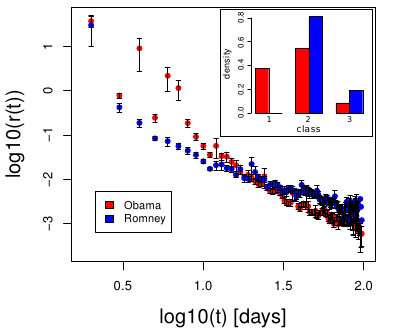
Political polarization and popularity in online participatory media : An integrated approach
|
[2012]
|
|
Garcia, David;
Mendez, Fernando;
Serdult, Uwe;
Schweitzer, Frank
|
In Proceedings of the Proceedings of the first edition workshop on Politics, elections and data - PLEAD '12
|
more» «less
|
Abstract
We present our approach to online popularity and its applications to political science, aiming at the creation of agentbased models that reproduce patterns of popularity in participatory media. We illustrate our approach analyzing a dataset from Youtube, composed of the view statistics and
comments for the videos of the U.S. presidential campaigns of 2008 and 2012. Using sentiment analysis, we quantify the collective emotions expressed by the viewers, finding that democrat campaigns elicited more positive collective emotions than republican campaigns. Techniques from computational social science allow us to measure virality of the videos of each campaign, to find that democrat videos are shared faster but republican ones are remembered longer inside the community. Last we present our work in progress in voting advice applications, and our results analyzing the
data from choose4greece.com. We show how we assess the policy differences between parties and their voters, and how voting advice applications can be extended to test our agentbased models.

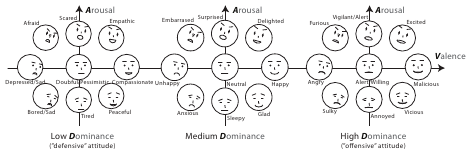
An nvc emotional model for conversational virtual humans in a 3d chatting environment
|
[2012]
|
|
Ahn, Junghyun;
Gobron, Stephane;
Garcia, David;
Silvestre, Quentin;
Thalmann, Daniel;
Bulic, Ronan
|
Proceedings of the VII Conference on Articulated Motion and Deformable Objects 2012
|
more» «less
|
Abstract
This paper proposes a new emotional model for Virtual Humans (VHs) in a conversational environment. As a part of a multi-users emotional 3D-chatting system, this paper focus on how to formulate and visualize the flow of emotional state defined by the Valence-ArousalDominance (VAD) parameters. From this flow of emotion over time, we successfully visualized the change of VHs’ emotional state through the proposed emoFaces and emoMotions. The notion of Non-Verbal Communication (NVC) was exploited for driving plausible emotional expressions during conversation. With the help of a proposed interface, where a user can parameterize emotional state and flow, we succeeded to vary the emotional expressions and reactions of VHs in a 3D conversation scene.

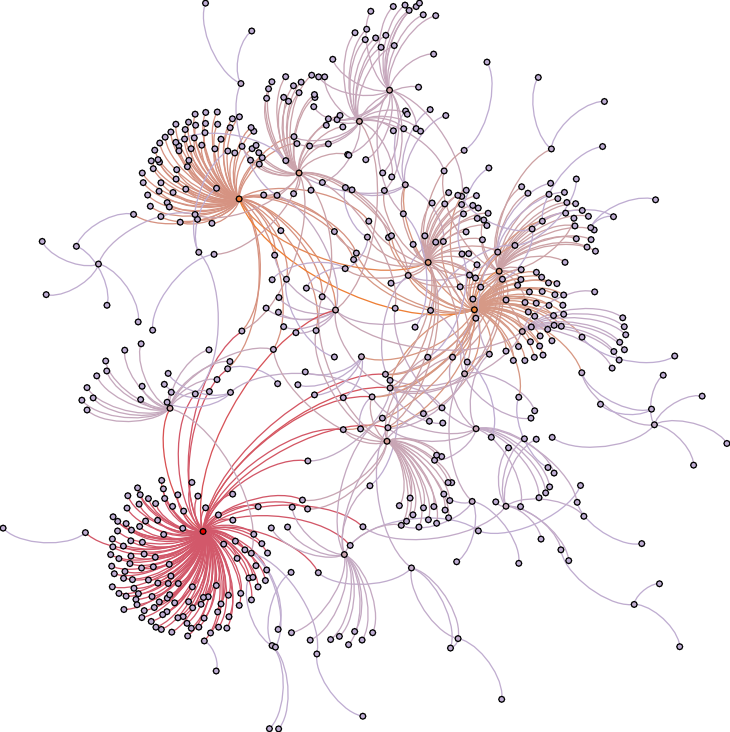
A quantitative study of social organisation in open source software communities
|
[2012]
|
|
Zanetti, Marcelo Serrano;
Sarigol, Emre;
Scholtes, Ingo;
Tessone, Claudio Juan;
Schweitzer, Frank
|
In Proceedings of the 2012 Imperial College Computing Student Workshop
|
more» «less
|
Abstract
The success of open source projects crucially depends on the voluntary contributions of a suf-
ficiently large community of users. Apart from the mere size of the community, interesting
questions arises when looking at the evolution of structural features of collaborations between
community members. In this article, we discuss several network analytic proxies that can be
used to quantify different aspects of the social organisation in social collaboration networks. We
particularly focus on measures that can be related to the cohesiveness of the communities, the
distribution of responsibilities and the resilience against turnover of community members. We
present a comparative analysis on a large-scale data set that covers the full history of collabor-
ations between users of 14 major open source software communities. Our analysis covers both
aggregate and time-evolving measures and highlights differences in the social organisation across
communities. We argue that our results are a promising first step towards the definition of
suitable, potentially multi-dimensional, resilience and risk indicators for open source software
communities.

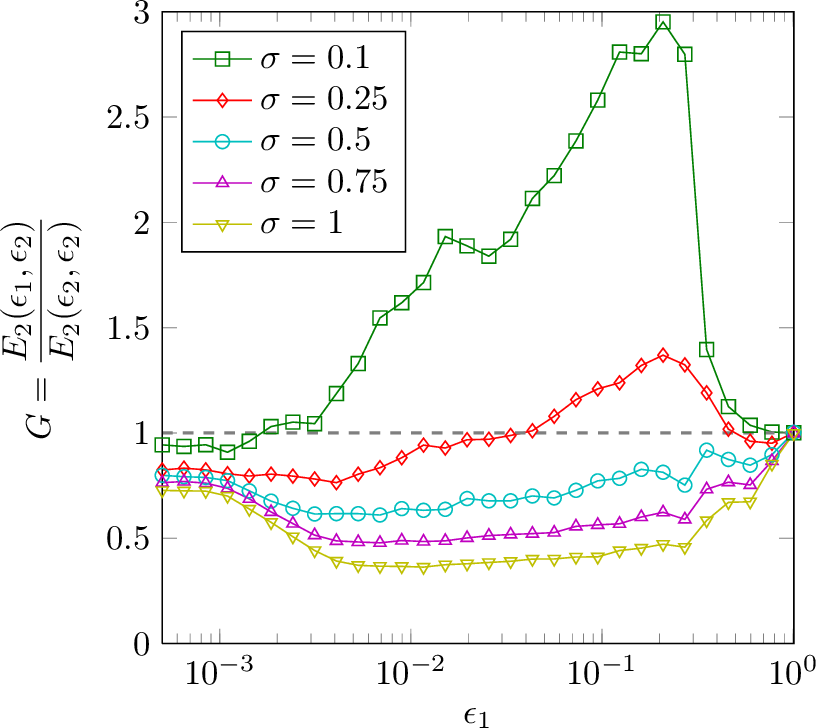
Hierarchical consensus formation reduces the influence of opinion bias
|
[2012]
|
|
Perony, Nicolas;
Pfitzner, Rene;
Scholtes, Ingo;
Schweitzer, Frank;
Tessone, Claudio Juan
|
In ECMS 2012 - Proceedings of the 26th European Conference on Modelling and Simulation
|
more» «less
|
Abstract
We study the role of hierarchical structures in a simple model of collective consensus formation based on the bounded confidence model with continuous individual opinions. For the particular variation of this model considered in this paper, we assume that a bias towards an extreme opinion is introduced whenever two individuals interact and form a common decision. As a simple proxy for hierarchical social structures, we introduce a two-step decision making process in which in the second step groups of like-minded individuals are replaced by representatives once they have reached local consensus, and the representatives in turn form a collective decision in a downstream process. We find that the introduction of such a hierarchical decision making structure can improve consensus formation, in the sense that the eventual collective opinion is closer to the true average of individual opinions than without it. In particular, we numerically study how the size of groups of like-minded individuals being represented by delegate individuals affects the impact of the bias on the final population-wide consensus. These results are of interest for the design of organisational policies and the optimisation of hierarchical structures in the context of group decision making.


Time-explicit graphs: A framework for dynamic network analysis
|
[2012]
|
|
Pfitzner, Rene;
Scholtes, Ingo;
Tessone, Claudio Juan;
Garas, Antonios;
Schweitzer, Frank
|
Extended Poster Abstract at Summer School "Modeling and Analysis of Novel Mechanisms in Future Internet Applications", Würzburg
|
more» «less
|
Abstract
When dealing with networks of several kind, network theory provides the theoretical framework and the practical tools to analyze them. Mostly analysis focuses on steady networks, i.e. networks with fixed topology. However, real-world scenarios often deal with (highly) dynamic topologies. As of today, the question of how to investigate such scenarios, e.g. defining a meaningful notion of “temporal centrality”, has generally not been answered. In this poster we present research pointing out the obstacles arising in this endeavor as well as a possible framework to address those issues, which we call time-explicit graphs.
Market Procyclicality and Systemic Risk
|
[2012]
|
|
Tasca, Paolo;
Battiston, Stefano
|
SSRN Electronic Journal
|
more» «less
|
Abstract
We model the systemic risk associated with the so-called balance-sheet amplification mechanism in a system of banks with interlocked balance sheets and with positions in real-economy-related assets. Our modeling framework integrates a stochastic price dynamics with an active balance-sheet management aimed to maintain the Value-at-Risk at a target level. We find that a strong compliance with capital requirements, usually alleged to be procyclical, does not increase systemic risk unless the asset market is illiquid. Conversely, when the asset market is illiquid, even a weak compliance with capital requirements increases significantly systemic risk. Our findings have implications in terms of possible macro-prudential policies to mitigate systemic risk.
Default Cascades: When Does Risk Diversification Increase Stability?
|
[2012]
|
|
Battiston, Stefano;
Delli Gatti, Domenico;
Gallegati, Mauro;
Greenwald, Bruce C. N.;
Stiglitz, Joseph E.
|
Journal of Financial Stability,
pages: 138-- 149,
volume: 8,
number: 3
|
more» «less
|
Abstract
Software development depends on many factors, including technical, human and social aspects. Due to the complexity of this dependence, a unifying framework must be defined and for this purpose we adopt the complex networks methodology. We use a data-driven approach based on a large collection of open source software projects extracted from online project development platforms. The preliminary results presented in this article reveal that the network perspective yields key insights into the sustainability of software development.

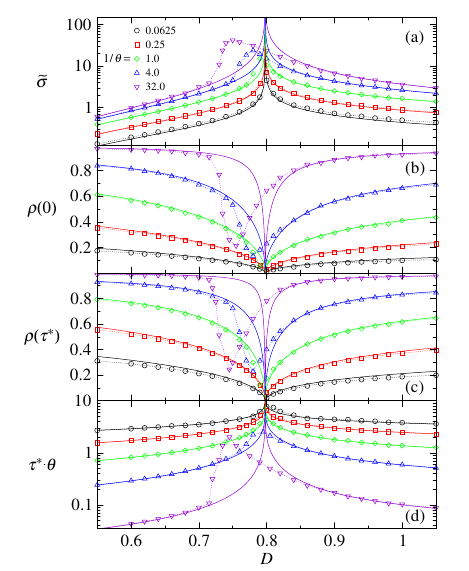
Noise-induced volatility of collective dynamics
|
[2012]
|
|
Harras, Georges;
Tessone, Claudio Juan;
Sornette, Didier
|
Physical Review E,
pages: 011150,
volume: 85,
number: 1
|
more» «less
|
Abstract
Noise-induced volatility refers to a phenomenon of increased level of fluctuations in the collective dynamics of bistable units in the presence of a rapidly varying external signal, and intermediate noise levels. The archetypical signature of this phenomenon is that –beyond the increase in the level of fluctuations– the response of the system becomes uncorrelated with the external driving force, making it different from stochastic resonance. Numerical simulations and an analytical theory of a stochastic dynamical version of the Ising model on regular and random networks demonstrate the ubiquity and robustness of this phenomenon, which is argued to be a possible cause of excess volatility in financial markets, of enhanced effective temperatures in a variety of out-of-equilibriumsystems and of strong selective responses of immune systems of complex biological organisms. Extensive nu-merical simulations are compared with a mean-field theory for different network topologies.

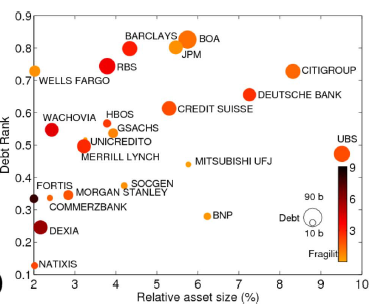
DebtRank: Too Central to Fail? Financial Networks, the FED and Systemic Risk
|
[2012]
|
|
Battiston, Stefano;
Puliga, Michelangelo;
Kaushik, Rahul;
Tasca, Paolo;
Caldarelli, Guido
|
Scientific Reports,
pages: 541,
volume: 2
|
more» «less
|
Abstract
Systemic risk, here meant as the risk of default of a large portion of the financial system, depends on the network of financial exposures among institutions. However, there is no widely accepted methodology to determine the systemically important nodes in a network. To fill this gap, we introduce, DebtRank, a novel measure of systemic impact inspired by feedback-centrality. As an application, we analyse a new and unique dataset on the USD 1.2 trillion FED emergency loans program to global financial institutions during 2008-2010. We find that a group of 22 institutions, which received most of the funds, form a strongly connected graph where each of the nodes becomes systemically important at the peak of the crisis. Moreover, a systemic default could have been triggered even by small dispersed shocks. The results suggest that the debate on too-big-to-fail institutions should include the even more serious issue of too-central-to-fail.

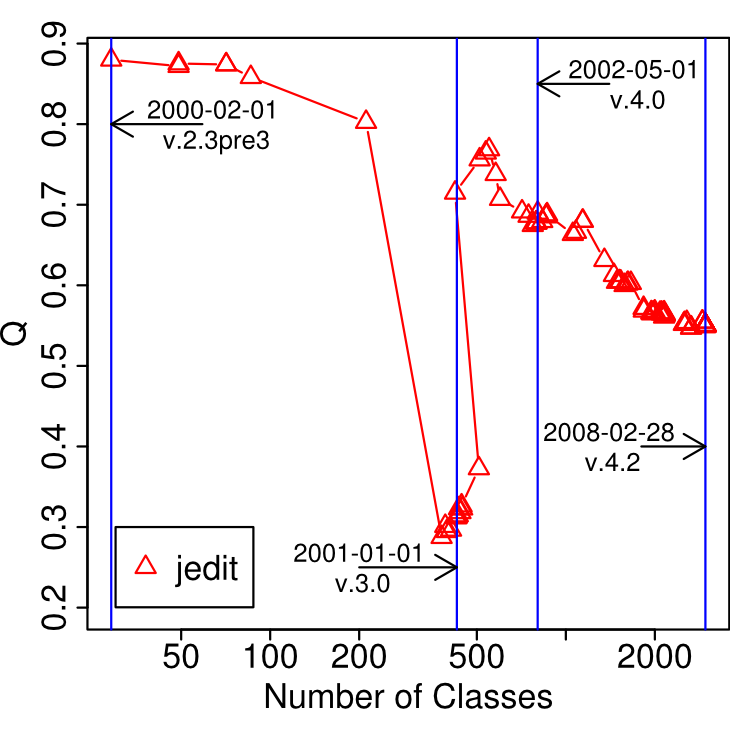
The co-evolution of socio-technical structures in sustainable software development: Lessons from the open source software communities
|
[2012]
|
|
Zanetti, Marcelo Serrano
|
ICSE '12 Proceedings of the 34th International Conference on Software Engineering,
pages: 1587-1590
|
more» «less
|
Abstract
Software development depends on many factors, including technical, human and social aspects. Due to the complexity of this dependence, a unifying framework must be defined and for this purpose we adopt the complex networks methodology. We use a data-driven approach based on a large collection of open source software projects extracted from online project development platforms. The preliminary results presented in this article reveal that the network perspective yields key insights into the sustainability of software development.
Editorial
|
[2012]
|
|
Schweitzer, Frank;
Vespignani, Alessandro
|
EPJ Data Science,
pages: 1,
volume: 1,
number: 1
|
more» «less
|
Abstract
Science is changing, all the time. Some consider external factors to be the major driving force, such as new discoveries, or new technologies that provide deeper insights into known systems. Others consider internal factors to be more important, such as the never-ending search for eternal truths or, at least, for the theoretical unification of diverse observations. Yet others believe that science is a social endeavor and its evolution is governed by forces very similar to those that cause fashions to change, with new research topics seeming to catch our attention and established topics falling out of vogue. We have come to believe that all of these arguments apply, and that the various impacts on scientific progress are even mutually dependent. Fashionable topics co-evolve with technological advances, as do new discoveries with overarching theories.

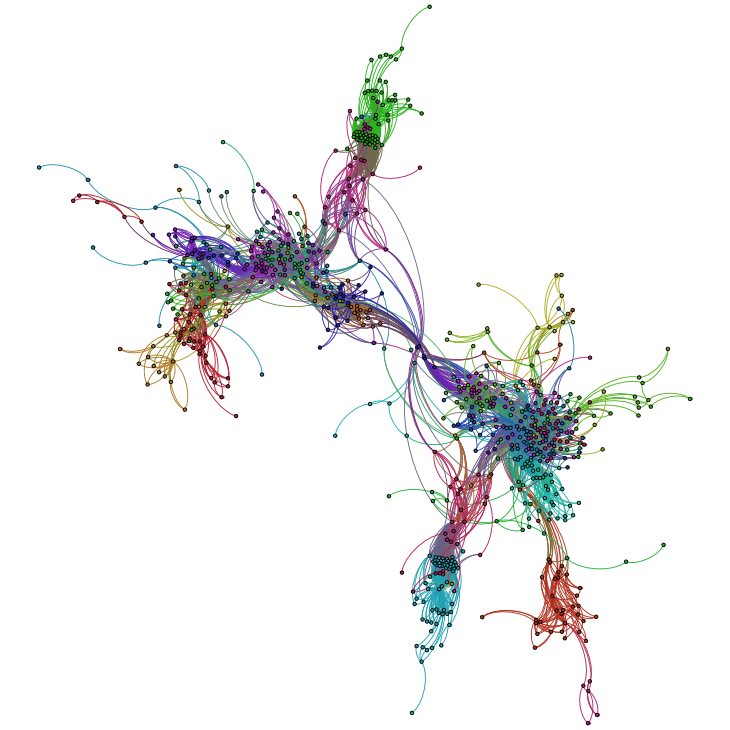
A network perspective on software modularity
|
[2012]
|
|
Zanetti, Marcelo Serrano;
Schweitzer, Frank
|
Architecture of Computing Systems (ARCS) Workshops 2012
|
more» «less
|
Abstract
Modularity is a desirable characteristic for software systems. In this article we propose to use a quantitative method from complex network sciences to estimate the coherence between the modularity of the dependency network of large open source Java projects and their decomposition in terms of Java packages. The results presented in this article indicate that our methodology offers a promising and reasonable quantitative approach with potential impact on software engineering processes.

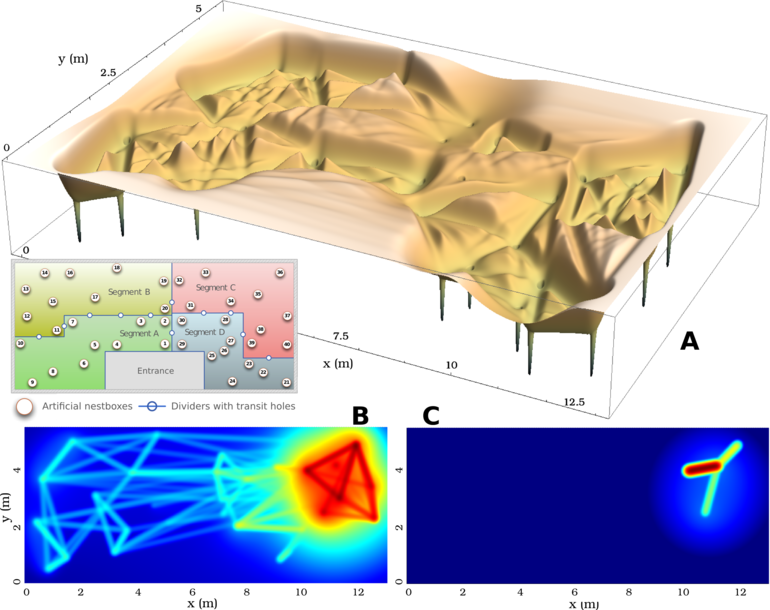
How random is social behaviour? Disentangling social complexity through the study of a wild house mouse population
|
[2012]
|
|
Perony, Nicolas;
Tessone, Claudio Juan;
Koenig, Barbara;
Schweitzer, Frank
|
PLOS Computational Biology,
pages: e1002786,
volume: 8,
number: 11
|
more» «less
|
Abstract
From the synchronised beauty of fish schools to the rigorous hierarchy of ant colonies, animals often display awe-inspiring collective behaviour. In recent years, principles of statistical physics have helped to unveil some simple mechanisms behind the emergence of such collective dynamics. Among the most elementary tools used to explain group behaviour are random processes, a typical example being the so-called “random walk”. In this paper, we have developed a framework based on such random assumptions to study the spatial and social structure of a population of wild house mice. We introduce the concept of perceptual landscape to describe the spatial behaviour of animals, whilst including all sensory and social constraints they are subject to: the perceptual landscape effectively maps the environment of animals as they perceive it. By applying our assumptions to a multi-agent model, we are able to reveal that much of the high-level social behaviour observed in the mouse population can indeed be explained through the many interactions of randomly moving individuals. This raises the question of how much of what we often regard as complex natural phenomena may, in fact, be the result of exceedingly simple forces.

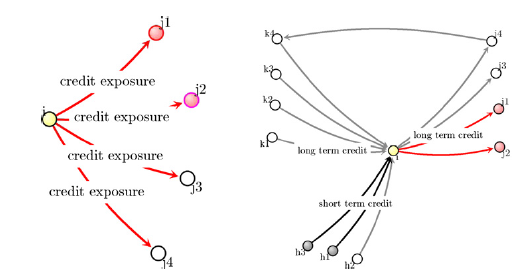
Default cascades: When does risk diversification increase stability?
|
[2012]
|
|
Battiston, Stefano;
Gatti, Domenico Delli;
Gallegati, Mauro;
Greenwald, Bruce;
Stiglitz, Joseph E.
|
Journal of Financial Stability,
pages: 138-- 149,
volume: 8,
number: 3
|
more» «less
|
Abstract
We explore the dynamics of default cascades in a network of credit interlink-ages in which each agent is at the same time a borrower and a lender. When some counterparties of an agent default, the loss she experiences amounts to her total exposure to those counterparties. A possible conjecture in this context is that individual risk diversification across more numerous counterparties should make also systemic defaults less likely. We show that this view is not always true. In particular, the diversification of credit risk across many borrowers has ambiguous effects on systemic risk in the presence of mechanisms of loss amplifications such as in the presence of potential runs among the short-term lenders of the agents in the network.


Positive words carry less information than negative words
|
[2012]
|
|
Garcia, David;
Garas, Antonios;
Schweitzer, Frank
|
EPJ Data Science,
pages: 3,
volume: 1
|
more» «less
|
Abstract
We show that the frequency of word use is not only determined by the word length [1] and the average information content [2], but also by its emotional content.We have analysed three established lexica of affective word usage in English, German, and Spanish, to verify that these lexica have a neutral, unbiased, emotional content. Taking into account the frequency of word usage, we find that words with a positive emotional content are more frequently used. This lends support to Pollyanna hypothesis [3] that there should be a positive bias in human expression. We also find that negative words contain more information than positive words, as the informativeness of a word increases uniformly with its valence decrease. Our findings support earlier conjectures about (i) the relation between word frequency and information content, and (ii) the impact of positive emotions on communication and social links.

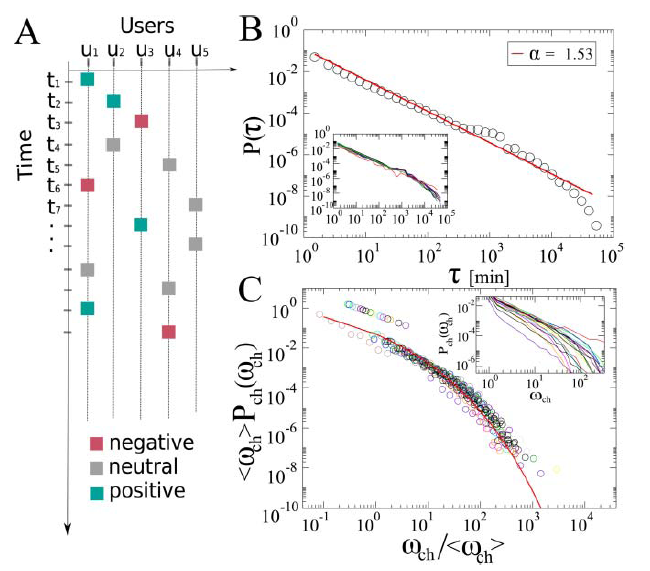
Emotional persistence in online chatting communities
|
[2012]
|
|
Garas, Antonios;
Garcia, David;
Skowron, Marcin;
Schweitzer, Frank
|
Scientific Reports,
pages: 402,
volume: 2
|
more» «less
|
Abstract
How do users behave in online chatrooms, where they instantaneously read and write posts? We analyzed about 2.5 million posts covering various topics in Internet relay channels, and found that user activity patterns follow known power-law and stretched exponential distributions, indicating that online chat activity is not different from other forms of communication. Analysing the emotional expressions (positive, negative, neutral) of users, we revealed a remarkable persistence both for individual users and channels. I.e. despite their anonymity, users tend to follow social norms in repeated interactions in online chats, which results in a specific emotional “tone” of the channels. We provide an agent-based model of emotional interaction, which recovers qualitatively both the activity patterns in chatrooms and the emotional persistence of users and channels. While our assumptions about agent's emotional expressions are rooted in psychology, the model allows to test different hypothesis regarding their emotional impact in online communication.

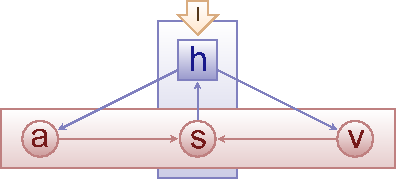
Modeling online collective emotions
|
[2012]
|
|
Garcia, David;
Schweitzer, Frank
|
Proceedings of the 2012 workshop on Data-driven user behavioral modelling and mining from social media-DUBMMSM '12, CIKM2012
|
more» «less
|
Abstract
A common phenomenon on the Internet is the appearance of collective emotions, in which many users share an emotional state. Online communities allow users to emotionally interact with large amounts of other users, creating collective states faster than in offline interaction. We present our modeling framework for collective emotions in online communities. This framework allows the analysis and design of agent-based models, including the dynamics of psychological states under emotional interaction. We illustrate the applications of our framework through an overview of two different models. Based on this framework, our first model of emotions in product reviews communities reproduces the empirical distribution of emotions towards products in Amazon. The second model within our framework reproduces the emergence of emotional persistence at the individual and collective level. This persistence pattern is similar to the one revealed by our statistical analysis of IRC chatrooms. Further applications of our framework aim at reproducing collective features of emotions in a variety of online communities.

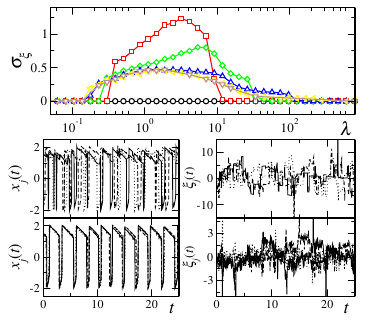
Synchronised firing induced by network dynamics in excitable systems
|
[2012]
|
|
Tessone, Claudio Juan;
Zanette, Damian H.
|
Europhysics Letters,
pages: 68006,
volume: 99,
number: 6
|
more» «less
|
Abstract
We study the collective dynamics of an ensemble of coupled identical FitzHugh-Nagumo elements in their excitable regime. We show that collective firing, where all the elements perform their individual firing cycle synchronously, can be induced by random changes in the interaction pattern. Specifically, on a sparse evolving network where, at any time, each element is connected with at most one partner, collective firing occurs for intermediate values of the rewiring frequency. Thus, network dynamics can play the role of noise and connectivity in inducing this kind of self-organised behaviour in highly disconnected systems which, otherwise, would not allow for the spreading of coherent evolution.

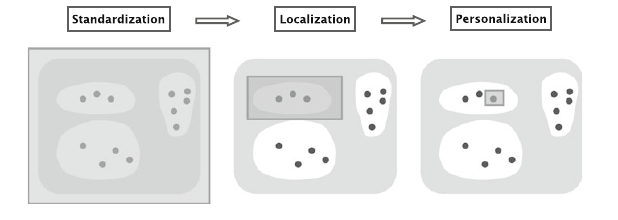
Moving recommender systems from on-line commerce to retail stores
|
[2012]
|
|
Walter, Frank Edward;
Battiston, Stefano;
Yildirim, Mahir;
Schweitzer, Frank
|
Information Systems and e-Business Management,
pages: 367-- 393,
volume: 10,
number: 3
|
more» «less
|
Abstract
The increasing diversity of consumers’ demand, as documented by the debate on the long tail of the distribution of sales volume across products, represents a challenge for retail stores. Recommender systems offer a tool to cope with this challenge. The recent developments in information technology and ubiquitous computing makes it feasible to move recommender systems from the on-line commerce, where they are widely used, to retail stores. In this paper, we aim to bridge the management literature and the computer science literature by analysing a number of issues that arise when applying recommender systems to retail stores: these range from the format of the stores that would benefit most from recommender systems to the impact of coverage and control of recommender systems on customer loyalty and competition among retail stores.

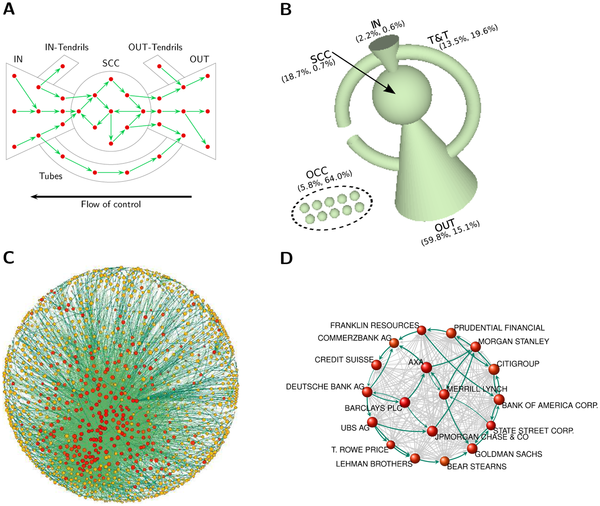
The network of global corporate control
|
[2011]
|
|
Vitali, Stefania;
Glattfelder, James B.;
Battiston, Stefano
|
PLOS ONE,
pages: 1-- 6,
volume: 6,
number: 10
|
more» «less
|
Abstract
The structure of the control network of transnational corporations affects global market competition and financial stability. So far, only small national samples were studied and there was no appropriate methodology to assess control globally. We present the first investigation of the architecture of the international ownership network, along with the computation of the control held by each global player. We find that transnational corporations form a giant bow-tie structure and that a large portion of control flows to a small tightly-knit core of financial institutions. This core can be seen as an economic "super-entity" that raises new important issues both for researchers and policy makers.


Tweetgames: A framework for Twitter-based collaborative social online games
|
[2011]
|
|
Esch, Markus;
Kovacheva, Aleksandrina;
Scholtes, Ingo;
Rothkugel, Steffen
|
In Proceedings of the 7th International Conference on Collaborative Computing (CollaborateCom 2011), Orlando, FL, USA
|
more» «less
|
Abstract
Today social networks and microblogging services attract much attention and their importance and pervasion is constantly increasing. This trend is fostered by the increasing prevalence of mobile internet devices, which enable users to be online every time and everywhere. A popular kind of applications provided via social network platforms are games. While existing social network games basically realize common online game principles where each user controls a single game entity and acts on its own behalf, this paper presents a framework for the creation of a novel kind of social online games. The idea is to enable games where users do not act as individual game entities, instead groups of users control one game entity whose behavior emerges from the collective behavior of all group members. The framework is based on the microblogging service Twitter and users interact with the game via Twitter messages. These collaborative social online games are not just an innovative social network application, the intention of our framework is rather to provide a useful and powerful tool to complex social network researchers to study emergent and collective user behavior on a large scale utilizing the huge user base of a social network service like Twitter. In addition to presenting the idea of collaborative social online games along with the so-called TweetGame framework, this paper presents a sample application that has already been realized on top of this framework as proof of concept.


Trust as the basis of coalition formation in electronic marketplaces
|
[2011]
|
|
Walter, Frank Edward
|
ACS - Advances in Complex Systems,
pages: 111-- 131,
volume: 14,
number: 2
|
more» «less
|
Abstract
Despite the fact that social networks are ubiquitous on the Internet, only few websites exploit the potential of combining user communities and online marketplaces. Not many platforms allow users to engage in a phenomenon called “group buying”—buyers joining groups, or coalitions, to bundle their purchasing power towards sellers.We argue that this may be due to a lack of face-to-face interaction on the Internet; often, users do not know which other users to trust, which makes them suspicious of engaging in online business, in particular if many unknown other parties are involved. This situation, however, can be alleviated by leveraging the social networks of users: based on who a user knows and is connected to, a trust metric — for example, the TrustWebRank metric developed by us — can be computed to assess who else may be considered trustworthy to that user. In this paper, we build a simple agent-based model of coalition formation among agents in the setting of group buying in an electronic marketplace. In this model, agents use their trust relationships in order to determine who to form coalitions with. We show that this leads agents to experience high utility and that agents are able to learn who is trustworthy and who is not, even when they have no initial knowledge about the trustworthiness of other agents. This work may provide the foundation for a real-world application of an online coalition formation platform for e-commerce built on a social networking platform such as Facebook.
Editorial: Agents and multi-agent systems
|
[2011]
|
|
Schweitzer, Frank;
Taylor, Matthew E.
|
ACS - Advances in Complex Systems,
pages: iii-- iv,
volume: 14,
number: 2
|
more» «less
|
Abstract
The agent concept is one of the very few concepts which have been able to cross the borders of scientific disciplines, finding applications not only in computer science and artificial intelligence, but also in biology, economics, engineering, and the social sciences. Thus it is only natural that the research frontiers in this fast growing field develop along interdisciplinary problems. These include the ability of agents to evolve, e.g. through adaptation and learning, but also the emergence of systemic properties which result from the interplay of large numbers of agents, rather than from carefully designed single agent behavior.


Agent-based modeling of intracellular transport
|
[2011]
|
|
Birbaumer, Mirko;
Schweitzer, Frank
|
The European Physical Journal B,
pages: 245-- 255,
volume: 82,
number: 3
|
more» «less
|
Abstract
We develop an agent-based model of the motion and pattern formation of vesicles. These intracellular particles can be found in four different modes of (undirected and directed) motion and can fuse with other vesicles. While the size of vesicles follows a log-normal distribution that changes over time due to fusion processes, their spatial distribution gives rise to distinct patterns. Their occurrence depends on the concentration of proteins which are synthesized based on the transcriptional activities of some genes. Hence, differences in these spatio-temporal vesicle patterns allow indirect conclusions about the (unknown) impact of these genes. By means of agent-based computer simulations we are able to reproduce such patterns on real temporal and spatial scales. Our modeling approach is based on Brownian agents with an internal degree of freedom, $θ$, that represents the different modes of motion. Conditions inside the cell are modeled by an effective potential that differs for agents dependent on their value $θ$. Agent’s motion in this effective potential is modeled by an overdampted Langevin equation, changes of $θ$ are modeled as stochastic transitions with values obtained from experiments, and fusion events are modeled as space-dependent stochastic transitions. Our results for the spatio-temporal vesicle patterns can be used for a statistical comparison with experiments. We also derive hypotheses of how the silencing of some genes may affect the intracellular transport, and point to generalizations of the model.

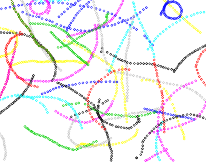
Testing an agent-based model of bacterial cell motility: How nutrient concentration affects speed distribution
|
[2011]
|
|
Garcia, Victor;
Birbaumer, Mirko;
Schweitzer, Frank
|
The European Physical Journal B,
pages: 235-- 244,
volume: 82,
number: 3-4
|
more» «less
|
Abstract
We revisit a recently proposed agent-based model of active biological motion and compare its predictions with own experimental findings for the speed distribution of bacterial cells, Salmonella typhimurium. Agents move according to a stochastic dynamics and use energy stored in an internal depot for metabolism and active motion. We discuss different assump-tions of how the conversion from internal to kinetic energy d(v) may depend on the actual speed, to conclude that d2v$ξ$ with either $ξ$ = 2 or 1 < $ξ$ < 2 are promising hypotheses. To test these, we compare the model’s prediction with the speed distribution of bacteria which were obtained in media of different nutrient concentration and at different times. We find that both hypotheses are in line with the experimental observations, with $ξ$ between 1.67 and 2.0. Regarding the influence of a higher nutrient concentration, we conclude that the take-up of energy by bacterial cells is indeed increased. But this energy is not used to increase the speed, with 40µm/s as the most probable value of the speed distribution, but is rather spend on metabolism and growth.

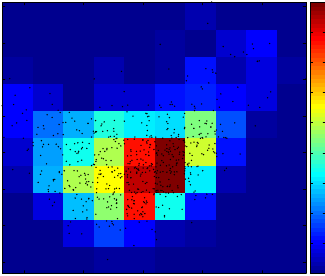
Emotions in product reviews – empirics and models
|
[2011]
|
|
Garcia, David;
Schweitzer, Frank
|
Proceedings of 2011 IEEE International Conference on Privacy, Security, Risk, and Trust, and IEEE International Conference on Social Computing, PASSAT/SocialCom,
pages: 483--488
|
more» «less
|
Abstract
Online communities provide Internet users with means to overcome some information barriers and constraints, such as the difficulty to gather independent information about products and firms. Product review communities allow customers to share their opinions and emotions after the purchase of a product. We introduce a new dataset of product reviews from Amazon.com, with emotional information extracted by sentiment detection tools. Our statistical analysis of this data provides evidence for the existence of polemic reviews, as well as for the coexistence of positive and negative emotions inside reviews. We find a strong bias towards large values in the expression of positive emotions, while negative ones are more evenly distributed. We identified different time dynamics of the creation of reviews dependent on the presence of marketing and word of mouth effects. We define an agent-based model of the users of product review communities using a modeling framework for online emotions. This model can reproduce the scenarios of response to external influences, as well as some properties of the distributions of positive and negative emotions expressed in product reviews. This analysis and model can provide guidelines to manufacturers on how to increase customer satisfaction and how to measure the emotional impact of marketing campaigns through reviews data.

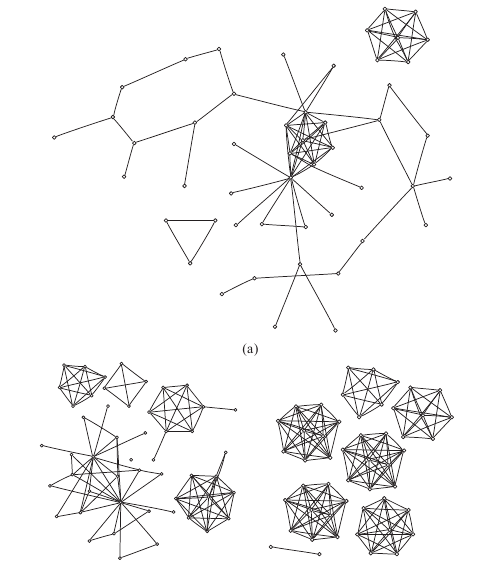
Recombinant knowledge and the evolution of innovation networks
|
[2011]
|
|
Koenig, Michael D;
Battiston, Stefano;
Napoletano, Mauro;
Schweitzer, Frank
|
Journal of Economic Behavior & Organization,
pages: 145–164,
volume: 79,
number: 3
|
more» «less
|
Abstract
We introduce a new model for the evolution of networks of firms exchanging knowledge in R&D partnerships. Innovation is assumed to result from the recombination of knowledge among firms in an R&D intensive industry. The decision of two firms to establish a new partnerships or to terminate an existing one, is based on their marginal revenues and costs, which in turn depend on the position they occupy in the network. Moreover, the formation of a collaboration has significant external effects on the other firms in the same connected component of the network. We show that this decentralized partner selection process leads to the existence of multiple equilibrium structures. Finally, by means of computer simulations, we study the properties of the emerging equilibrium networks and we show that they reproduce the stylized facts of R&D networks.


Sustainable growth in complex networks
|
[2011]
|
|
Tessone, Claudio Juan;
Geipel, Markus Michael;
Schweitzer, Frank
|
Europhysics Letters,
pages: 58005,
volume: 96,
number: 5
|
more» «less
|
Abstract
Based on the analysis of the dependency network in 18 Java projects, we develop a novel model of network growth which considers both preferential attachment and the addition of new nodes with a heterogeneous distribution of their initial degree, k0. Empirically we find that the cumulative distributions of initial and final degrees in the network follow power law behaviours: 1−P(k0)∝k1−$α$ as a function of the network size, we find empirically K(N)∝N$β$,where $β$ ∈[1.25, 2] (for small N), while converging to $β$ ∼1 for large N. This indicates a transition from a growth regime with increasing network density towards a sustainable regime, which prevents a collapse due to 0 ,and 1−P(k)∝k1−$γ$, respectively. For the total number of links ever increasing dependencies. Our theoretical framework allows us to predict relations between the exponents $α$, $β$, $γ$, which also link issues of software engineering and developer activity. These relations are verified by means of computer simulations and empirical investigations. They indicate that the growth of real Open Source Software networks occurs on the edge between two regimes, which are dominated either by the initial degree distribution of added nodes, or by the preferential attachment mechanism. Hence, the heterogeneous degree distribution of newly added nodes, found empirically, is essential to describe the laws of sustainable growth in networks.
Statistical classification of cascading failures in power grids
|
[2011]
|
|
Pfitzner, Rene;
Turitsyn, Konstantin;
Chertkov, Michael
|
Power and Energy Society General Meeting 2011,
pages: 1-- 8
|
more» «less
|
Abstract
We introduce a new microscopic model of the outages in transmission power grids. This model accounts for the automatic response of the grid to load fluctuations that take place on the scale of minutes, when the optimum power flow adjustments and load shedding controls are unavailable. We describe extreme events, initiated by load fluctuations, which cause cascading failures of loads, generators and lines. Our model is quasi-static in the causal, discrete time and sequential resolution of individual failures. The model, in its simplest realization based on the Directed Current description of the power flow problem, is tested on three standard IEEE systems consisting of 30, 39 and 118 buses. Our statistical analysis suggests a straightforward classification of cascading and islanding phases in terms of the ratios between average number of removed loads, generators and links. The analysis also demonstrates sensitivity to variations in line capacities. Future research challenges in modeling and control of cascading outages over real-world power networks are discussed.
Controlled Tripping of Overheated Lines Mitigates Power Outages
|
[2011]
|
|
Pfitzner, Rene;
Turitsyn, Konstantin;
Chertkov, Michael
|
|
|
more» «less
|
Abstract
We study the evolution of fast blackout cascades in the model of the Polish (transmission) power grid (2700 nodes and 3504 transmission lines). The cascade is initiated by a sufficiently severe initial contingency tripping. It propagates via sequential trippings of many more overheated lines, islanding loads and generators and eventually arriving at a fixed point with the surviving part of the system being power-flow-balanced and the rest of the system being outaged. Utilizing an improved form of the quasi-static model for cascade propagation introduced in our earlier study (Statistical Classification of Cascading Failures in Power Grids, IEEE PES GM 2011), we analyze how the severity of the cascade depends on the order of tripping overheated lines. Our main observation is that the order of tripping has a tremendous effect on the size of the resulting outage. Finding the "best" tripping, defined as causing the least damage, constitutes a difficult dynamical optimization problem, whose solution is most likely computationally infeasible. Instead, here we study performance of a number of natural heuristics, resolving the next switching decision based on the current state of the grid. Overall, we conclude that controlled intentional tripping is advantageous in the situation of a fast developing extreme emergency, as it provides significant mitigation of the resulting damage.


Geography versus topology in the european ownership network
|
[2011]
|
|
Vitali, Stefania;
Battiston, Stefano
|
New Journal of Physics,
pages: 63021,
volume: 13,
number: 6
|
more» «less
|
Abstract
In this paper, we investigate the network of ownership relationships among European firms and its embedding in the geographical space.We carry out a detailed analysis of geographical distances between pairs of nodes, connected by edges or by shortest paths of varying length. In particular, we study the relation between geographical distance and network distance in comparison with a random spatial network model. While the distribution of geographical distance can be fairly well reproduced, important deviations appear in the network distance and in the size of the largest strongly connected component. Our results show that geographical factors allow us to capture several features of the network, while the deviations quantify the effect of additional economic factors at work in shaping the topology. The analysis is relevant to other types of geographically embedded networks and sheds light on the link formation process in the presence of spatial constraints.


Web search queries can predict stock market volumes
|
[2011]
|
|
Bordino, Ilaria;
Battiston, Stefano;
Caldarelli, Guido;
Cristelli, Matthieu;
Ukkonen, Antti;
Weber, Ingmar
|
PLOS-ONE,
pages: e40014,
volume: 7,
number: 7
|
more» «less
|
Abstract
We live in a computerized and networked society where many of our actions leave a digital trace and affect other people's actions. This has lead to the emergence of a new data-driven research field: mathematical methods of computer science, statistical physics and sociometry provide insights on a wide range of disciplines ranging from social science to human mobility. A recent important discovery is that search engine traffic (i.e., the number of requests submitted by users to search engines on the www) can be used to track and, in some cases, to anticipate the dynamics of social phenomena. Successful examples include unemployment levels, car and home sales, and epidemics spreading. Few recent works applied this approach to stock prices and market sentiment. However, it remains unclear if trends in financial markets can be anticipated by the collective wisdom of on-line users on the web. Here we show that daily trading volumes of stocks traded in NASDAQ-100 are correlated with daily volumes of queries related to the same stocks. In particular, query volumes anticipate in many cases peaks of trading by one day or more. Our analysis is carried out on a unique dataset of queries, submitted to an important web search engine, which enable us to investigate also the user behavior. We show that the query volume dynamics emerges from the collective but seemingly uncoordinated activity of many users. These findings contribute to the debate on the identification of early warnings of financial systemic risk, based on the activity of users of the www.

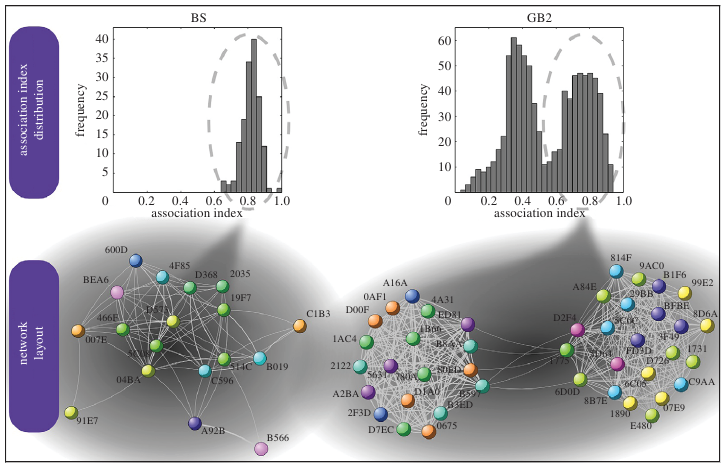
Bats are able to maintain long-term social relationships despite the high fission-fusion dynamics of their groups.
|
[2011]
|
|
Kerth, Gerald;
Perony, Nicolas;
Schweitzer, Frank
|
Proceedings of the Royal Society B: Biological Sciences,
pages: 2761-2767,
volume: 278,
number: 1719
|
more» «less
|
Abstract
Elephants, dolphins, as well as some carnivores and primates maintain social links despite their frequent splitting and merging in groups of variable composition, a phenomenon known as fission-fusion. Information on the dynamics of social links and interactions among individuals is of high importance to the understanding of the evolution of animal sociality, including that of humans. However, detailed long-term data on such dynamics in wild mammals with fully known demography and kin structures are scarce. Applying a weighted network analysis on 20 500 individual roosting observations over 5 years, we show that in two wild Bechstein's bat colonies with high fission-fusion dynamics, individuals of different age, size, reproductive status and relatedness maintain long-term social relationships. In the larger colony, we detected two stable subunits, each comprising bats from several family lineages. Links between these subunits were mainly maintained by older bats and persisted over all years. Moreover, we show that the full details of the social structure become apparent only when large datasets are used. The stable multi-level social structures in Bechstein's bat colonies resemble that of elephants, dolphins and some primates. Our findings thus may shed new light on the link between social complexity and social cognition in mammals.
Remarks
Gerald Kerth and Nicolas Perony contributed equally to the study.
Featured in Science Editor's Choice (DOI: 10.1126/science.331.6023.1366-d).
Among the Proc. R. Soc. B most-read articles in February 2011.
Reply to Farrell: Improved individual estimation success can imply collective tunnel vision
|
[2011]
|
|
Rauhut, Heiko;
Lorenz, Jan;
Schweitzer, Frank;
Helbing, Dirk
|
Proceedings of the National Academy of Sciences (PNAS),
pages: E626,
volume: 108,
number: 36
|
more» «less
|
Abstract
Analyzing the data of the wisdom of crowd experiment by Lorenz et al. (1), Farrell (2) points out that information exchange improves individual estimates of answers to factual questions. He furthermore suggests that information exchange increases individual rewards and that this comes with an increase in confidence in their estimates. However, it has to be noted that individual rewards were revealed only after subjects specified their confidence. [This also shows that the reference to Danchin et al. (3) is not fitting, because in the foraging example, subjects were constantly aware of the external metric, namely the success of the foraging activities of other individuals.] Moreover, although the original experiment was designed to study social interaction effects, Farrell applies a psychological perspective. In fact, Farrell's commentary (2) focuses on individual-level effects, whereas Lorenz et al. (1) concentrated on group-level effects and show how aggregating micro-outcomes can lead to unexpected macro-level effects.

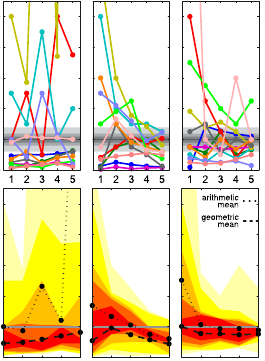
How social influence can undermine the wisdom of crowd effect
|
[2011]
|
|
Lorenz, Jan;
Rauhut, Heiko;
Schweitzer, Frank;
Helbing, Dirk
|
Proceedings of the National Academy of Sciences (PNAS),
pages: 9020-- 9025,
volume: 108,
number: 22
|
more» «less
|
Abstract
Social groups can be remarkably smart and knowledgeable when their averaged judgements are compared with the judgements of individuals. Already Galton [Galton F (1907) Nature 75:7] found evidence that the median estimate of a group can be more accu-rate than estimates of experts. This wisdom of crowd effect was recently supported by examples from stock markets, political elections, and quiz shows [Surowiecki J (2004) The Wisdom of Crowds]. In contrast, we demonstrate by experimental evidence (N = 144) that even mild social influence can undermine the wisdom of crowd effect in simple estimation tasks. In the exper-iment, subjects could reconsider their response to factual ques-tions after having received average or full information of the responses of other subjects. We compare subjects’ convergence of estimates and improvements in accuracy over five consecutive estimation periods with a control condition, in which no informa-tion about others’ responses was provided. Although groups are initially “wise,” knowledge about estimates of others narrows the diversity of opinions to such an extent that it undermines the wisdom of crowd effect in three different ways. The “social influence effect” diminishes the diversity of the crowd without improvements of its collective error. The “range reduction effect” moves the position of the truth to peripheral regions of the range of estimates so that the crowd becomes less reliable in providing expertise for external observers. The “confidence ef-fect” boosts individuals’ confidence after convergence of their estimates despite lack of improved accuracy. Examples of the revealed mechanism range from misled elites to the recent global financial crisis.
Sind die Physiker schuld an der Finanzkrise?
|
[2011]
|
|
Schweitzer, Frank
|
Physik Journal,
pages: 3,
volume: 10,
number: 4
|
more» «less
|
Abstract
Seit den 1990er-Jahren sind Physikerinnen und Physiker vermehrt in Banken, Versicherungen, im Fondsmanagement und in Unternehmensberatungen tätig – ein Trend, der weiterhin anhält und auch international zu beobachten ist. Sind sie qualifiziert für diese anspruchsvollen Aufgaben und kennen sie die Konsequenzen ihres Handelns? Oder werden ihre analytischen Fähigkeiten, ihr Talent zur Datenanalyse und zur Modellierung komplizierter Systeme überschätzt? Sind Physiker gar Schuld an der weltweiten Finanzkrise?

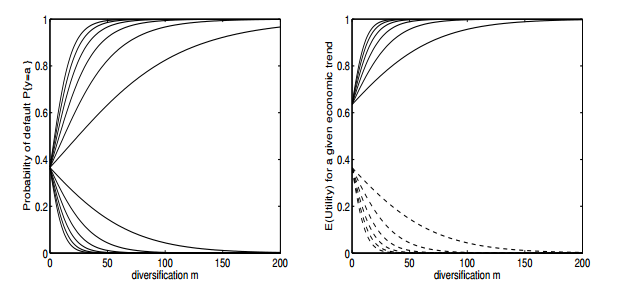
Diversification and Financial Stability
|
[2011]
|
|
Tasca, Paolo;
Battiston, Stefano
|
SSRN Electronic Journal,
pages: 11-- 001
|
more» «less
|
Abstract
The recent credit crisis of 2007/08 has raised a debate about the so-called knife-edge properties of financial markets. The paper contributes to the debate shedding light on the controversial relation between risk-diversification and financial stability. We model a financial network where assets held by borrowers to meet their obligations, include claims against other borrowers and securities exogenous to the network. The balance-sheet approach is conjugated with a stochastic setting and by a mean-field approximation the law of motion of the system's fragility is derived. We show that diversification has an ambiguous effect and beyond a certain levels elicits financial instability. Moreover, we find that risk-sharing restrictions create a socially preferable outcome. Our findings have significant implications for future policy recommendation.


Network evolution based on centrality
|
[2011]
|
|
Koenig, Michael D;
Tessone, Claudio Juan
|
Physical Review E,
pages: 056108,
volume: 84,
number: 5
|
more» «less
|
Abstract
We study the evolution of networks when the creation and decay of links are based on the position of nodes in the network measured by their centrality. We show that the same network dynamics arise under various centrality measures, and solve analytically the network evolution. During the complete evolution, the network is characterized by nestedness: the neighborhood of a node is contained in the neighborhood of the nodes with larger degree.We find a discontinuous transition in the network density between hierarchical and homogeneous networks, depending on the rate of link decay. We also show that this evolution mechanism leads to double power-law degree distributions, with interrelated exponents.

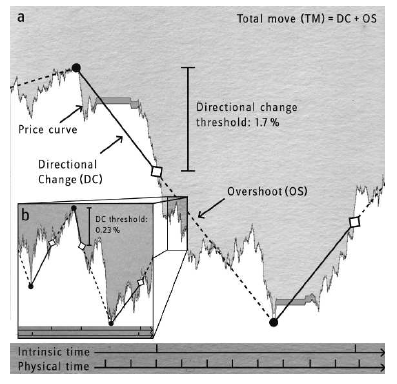
Patterns in high-frequency fx data : Discovery of 12 empirical scaling laws
|
[2011]
|
|
Glattfelder, James B.;
Dupuis, A.;
Olsen, R. B.
|
Quantitative Finance,
pages: 599-- 614,
volume: 11,
number: 4
|
more» «less
|
Abstract
We have discovered 12 independent new empirical scaling laws in foreign exchange data-series that hold for close to three orders of magnitude and across 13 currency ex-change rates. Our statistical analysis crucially depends on an event-based approach that measures the relationship between different types of events. The scaling laws give an accurate estimation of the length of the price-curve coastline, which turns out to be surprisingly long. The new laws substantially extend the catalogue of stylised facts and sharply constrain the space of possible theoretical explanations of the mar-ket mechanisms.

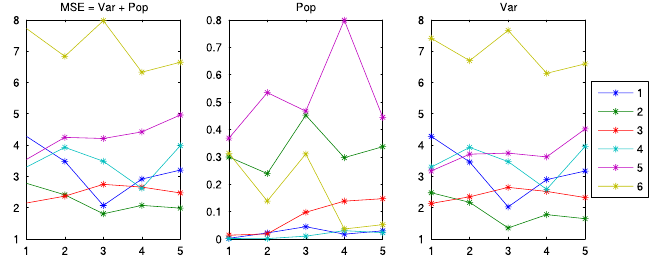
The wisdom of crowds in one mind : How individuals can simulate the knowledge of diverse societies to reach better decisions
|
[2011]
|
|
Rauhut, Heiko;
Lorenz, Jan
|
Journal of Mathematical Psychology,
pages: 191-- 197,
volume: 55,
number: 2
|
more» «less
|
Abstract
The joint knowledge of many diverse individuals can outperform experts in estimation and decision-making problems. This wisdom of the crowd has been demonstrated in different societal areas such as internet search engines, political elections or stock markets. Recently, psychologists argued that humans may even simulate a diverse society in their own minds by drawing different answers from their brain (Vul & Pashler, 2008). The underlying idea is that individuals can access different knowledge areas in their brain, whose joint evaluation yields better estimates than their separate consideration. This article presents a mathematical treatment of the wisdom of crowds and two potential mechanisms to quantify the wisdom of crowds in one mind. The implications of both methods are analyzed and applied to new experimental data (N = 144), which contain five consecutive estimates from the same individuals. The theoretical and empirical analysis demonstrates limitations of the wisdom of crowds in one mind: Asking oneself several times is on average less powerful than asking only one other individual. This is due to the smaller diversity of estimates of similar individuals and the larger average bias to which they converge. Further, individuals cannot perform independent draws from an ‘‘internal distribution’’. Hence, there may be other mechanisms at work such as talking oneself into believing initial guesses or eliciting progressively wilder ones. ©2010
The Structure of Financial Networks
|
[2010]
|
|
Battiston, Stefano;
Glattfelder, James B.;
Garlaschelli, Diego;
Lillo, F;
Caldarelli, Guido
|
Network Science,
pages: 131-- 163
|
more» «less
|
Abstract
We present here an overview of the use of networks in Finance and Economics. We show how this approach enables us to address important questions as, for example, the structure of control chains in financial systems, the systemic risk associated with them and the evolution of trade between nations. All these results are new in the field and allow for a better understanding and modelling of different economic systems.

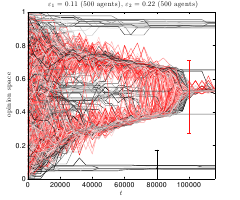
Heterogeneous bounds of confidence: Meet, discuss and find consensus!
|
[2010]
|
|
Lorenz, Jan
|
Inter Science Complexity,
pages: 43-- 52,
volume: 15,
number: 4
|
more» «less
|
Abstract
Models of continuous opinion dynamics under bounded confidence show a sharp transition between a consensus and a polarization phase at a critical global bound of confidence. In this paper, heterogeneous bounds of confidence are studied. The surprising result is that a society of agents with two different bounds of confidence (open-minded and closed-minded agents) can find consensus even when both bounds of confidence are significantly below the critical bound of confidence of a homogeneous society. The phenomenon is shown by examples of agent-based simulation and by numerical computation of the time evolution of the agents density. The result holds for the bounded confidence model of Deffuant, Weisbuch and others (Weisbuch, G. et al; Meet, discuss, and segregate!, Complexity, 2002, 7, 55-- 63), as well as for the model of Hegselmann and Krause (Hegselmann, R., Krause, U.; Opinion Dynamics and Bounded Confidence, Models, Analysis and Simulation, Journal of Artificial Societies and Social Simulation, 2002, 5, 2). Thus, given an average level of confidence, diversity of bounds of confidence enhances the chances for consensus. The drawback of this enhancement is that opinion dynamics becomes suspect to severe drifts of clusters, where open-minded agents can pull closed-minded agents towards another cluster of closed-minded agents. A final consensus might thus not lie in the center of the opinion interval as it happens for uniform initial opinion distributions under homogeneous bounds of confidence. It can be located at extremal locations. This is demonstrated by example. This also show that the extension to heterogeneous bounds of confidence enriches the complexity of the dynamics tremendously.

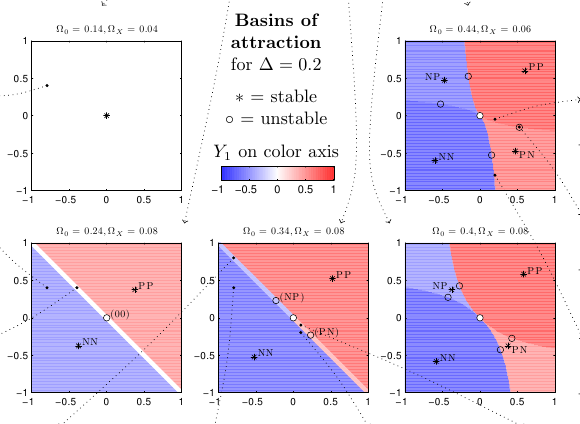
Tipping diffusivity in information accumulation systems: More links, less consensus
|
[2010]
|
|
Shin, J. K.;
Lorenz, Jan
|
Journal of Statistical Mechanics: Theory and Experiment,
pages: P06005-- P06020,
volume: 2010,
number: 06
|
more» «less
|
Abstract
Assume two different communities each of which maintain their respective opinions mainly because of the weak interaction between them. In such a case, it is an interesting problem to find the necessary strength of inter-community interaction in order for the two communities to reach a consensus. In this paper, the information accumulation system (IAS) model is applied to investigate the problem. With the application of the IAS model, the opinion dynamics of the two-community problem is found to belong to a wider class of two-species problems appearing in population dynamics or in the competition of two languages, for all of which the governing equations can be described in terms of coupled logistic maps. Tipping diffusivity is defined as the maximal inter-community interaction such that the two communities maintain different opinions. For a problem with a simple community structure and homogeneous individuals, the tipping diffusivity is calculated theoretically. As a conclusion of the paper, the convergence of the two communities to the same value is less possible the more overall interaction, intra-community and inter-community, takes place. This implies, for example, that the increase in the interaction between individuals caused by the development of modern communication tools, such as Facebook and Twitter, does not necessarily improve the tendency towards global convergence between different communities. If the number of internal links increases by a factor, the number of inter-community links must be increased by an even higher factor, in order for consensus to be the only stable attractor.
Editorial: Sozio- und Ökonophysik sind etablierte Forschungsfelder
|
[2010]
|
|
Schweitzer, Frank
|
Physik in unserer Zeit,
pages: 3,
volume: 6,
number: 41
|
more» «less
|
Abstract
Das Ganze ist mehr als die Summe seiner Teile“, lehrte schon Aristoteles. Wenn sich die „Teile“ zusammenschließen und miteinander in Wechselwirkung treten, entsteht also etwas Neues für das Gesamtsystem. Dieses lässt sich nicht auf den Beitrag der einzelnen Teile reduzieren. Die Wissenschaftstheorie bezeichnet diesen Vorgang als Emergenz. Damit wird zumeist ein Mehrwert für das Ganze generiert: Die Leitfähigkeit von Metallen entsteht, sofern eine kritische Mindestanzahl von Atomen beteiligt ist – ein typisches Beispiel aus der Physik. In biologischen Systemen schließen sich Zellen zu Organismen mit neuer Funktionalität zusammen, in der Volkswirtschaft generieren Produktion und Warenaustausch einer Vielzahl von Akteuren einen Mehrwert im ökonomischen Sinne, der die Grundlage des Wachstums bildet.

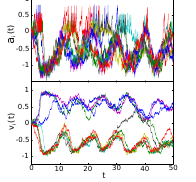
An agent-based model of collective emotions in online communities
|
[2010]
|
|
Schweitzer, Frank;
Garcia, David
|
The European Physical Journal B,
pages: 533-- 545,
volume: 77,
number: 4
|
more» «less
|
Abstract
We develop an agent-based framework to model the emergence of collective emotions, which is applied to online communities. Agent’s individual emotions are described by their valence and arousal. Using the concept of Brownian agents, these variables change according to a stochastic dynamics, which also considers the feedback from online communication. Agents generate emotional information, which is stored and distributed in a field modeling the online medium. This field affects the emotional states of agents in a non-linearmanner.We derive conditions for the emergence of collective emotions, observable in a bimodal valence distribution. Dependent on a saturated or a superlinear feedback between the information field and the agent’s arousal, we further identify scenarios where collective emotions only appear once or in a repeated manner. The analytical results are illustrated by agent-based computer simulations. Our framework provides testable hypotheses about the emergence of collective emotions, which can be verified by data from online communities.
Dilemmas of partial cooperation
|
[2010]
|
|
Stark, Hans - Ulrich
|
Evolution,
pages: 2458-2465,
volume: 64,
number: 8
|
more» «less
|
Abstract
Related to the often applied cooperation models of social dilemmas, we deal with scenarios in which defection dominates cooperation, but an intermediate fraction of cooperators, that is, “partial cooperation,” would maximize the overall performance of a group of individuals. Of course, such a solution comes at the expense of cooperators that do not profit from the overall maximum. However, because there are mechanisms accounting for mutual benefits after repeated interactions or through evolutionary mechanisms, such situations can constitute “dilemmas” of partial cooperation. Among the 12 ordinally distinct, symmetrical 2 × 2 games, three (barely considered) variants are correspondents of such dilemmas. Whereas some previous studies investigated particular instances of such games, we here provide the unifying framework and concisely relate it to the broad literature on cooperation in social dilemmas. Complementing our argumentation, we study the evolution of partial cooperation by deriving the respective conditions under which coexistence of cooperators and defectors, that is, partial cooperation, can be a stable outcome of evolutionary dynamics in these scenarios. Finally, we discuss the relevance of such models for research on the large biodiversity and variation in cooperative efforts both in biological and social systems.
From assortative to dissortative networks: The role of capacity constraints
|
[2010]
|
|
Konig, Michael D;
Tessone, Claudio Juan;
Zenou, Yves
|
Advances in Complex Systems (ACS),
pages: 483,
volume: 13,
number: 4
|
more» «less
|
Abstract
We consider a dynamic model of network formation where agents form and sever links based on the centrality of their potential partners.We show that the existence of capacity constrains in the amount of links an agent can maintain introduces a transition from dissortative to assortative networks. This effect can shed light on the distinction between technological and social networks as it gives a simple mechanism explaining how and why this transition occurs.


Does ignorance promote norm compliance?
|
[2010]
|
|
Groeber, Patrick;
Rauhut, Heiko
|
Computational and Mathematical Organization Theory,
pages: 1-- 28,
volume: 16,
number: 1
|
more» «less
|
Abstract
A large extent of undetected norm violations may have positive effects for society. If many norm violations are hidden, society seems to be in good order so that actors are more willing to comply with the norms themselves. In this sense, igno-rance promotes norm compliance.We challenge this view by arguing that in scenar-ios, in which norms are controlled and enforced by third parties who receive rewards for their success, the opposite is true: Ignorance promotes norm violations. The rea-son is that unsuspicious inspectors who believe that little hidden norm violations are committed will spend less effort for detection, some formerly detected norm viola-tions will go undetected, norm targets will be less deterred from the lower detection probability and will commit more norm violations over time. This article develops a respective mathematical model and confirms the above described intuition.

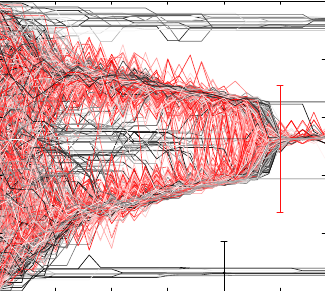
On conditions for convergence to consensus
|
[2010]
|
|
Lorenz, Jan;
Lorenz, Dirk A.
|
IEEE Transactions on Automatic Control,
pages: 1651-- 1656,
volume: 55,
number: 7
|
more» «less
|
Abstract
A new theorem on conditions for convergence to consensus of a multiagent time-dependent time-discrete dynamical system is presented. The theorem is build up on the notion of averaging maps. We compare this theorem to results by Moreau (IEEE Transactions on Automatic Control, vol. 50, no. 2, 2005) about set-valued Lyapunov theory and convergence under switching communication topologies. We give examples that point out differences of approaches including examples where Moreau's theorem is not applicable but ours is. Further on, we give examples that demonstrate that the theory of convergence to consensus is still not complete.

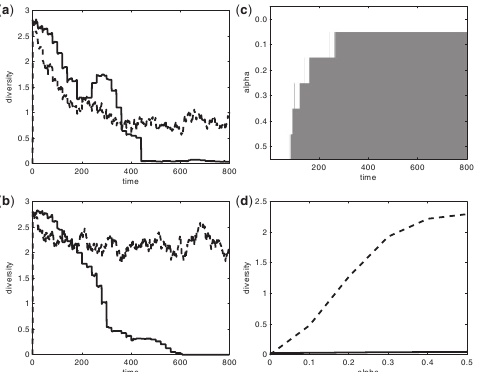
Vanishing hands? On the link between product and organization architecture
|
[2010]
|
|
Press, Kerstin;
Geipel, Markus Michael
|
Industrial and Corporate Change,
pages: 1493-- 1514,
volume: 19,
number: 5
|
more» «less
|
Abstract
The present article investigates whether modular product architectures deliver better and more differentiated products, given their production in disintegrated and integrated settings. A theoretic model benchmarks the performance of disin-tegration and integration for different degrees of product modularity by measur-ing both product quality and differentiation. In line with conventional wisdom, (nearly) modular products befit disintegration insofar as disintegration increases quality. However, disintegration only leads to greater product differentiation than integration if there is substantial entry and exit. These findings—albeit developed with stylised models of disintegration and integration—provide a possible explan-ation for empirical results showing a decrease in product variety when modular products were produced by independent manufacturers (disintegration). Moreover, the model results predict that industries with limited entry and exit as well as strong winner-take-all dynamics tend to incur a loss in variety if modular products are produced in a disintegrated setting.

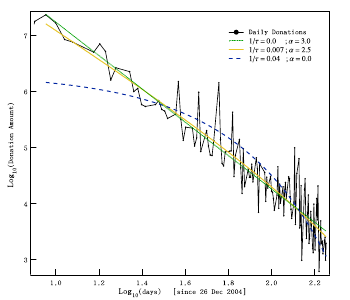
Power law signature of media exposure in human response waiting time distributions
|
[2010]
|
|
Crane, Riley;
Schweitzer, Frank;
Sornette, Didier
|
Physical Review E,
pages: 1-- 6,
volume: 81,
number: 5
|
more» «less
|
Abstract
We study the humanitarian response to the destruction brought by the tsunami generated by the Sumatra earthquake of December 26, 2004, as measured by donations, and find that it decays in time as a power law ~ 1/t^(alpha) with alpha = 2.5 + /-0.1. This behavior is suggested to be the rare outcome of a priority queuing process in which individuals execute tasks at a rate slightly faster than the rate at which new tasks arise. We believe this to be the first empirical evidence documenting this recently predicted regime, and provide additional independent evidence that suggests it arises as a result of the intense focus placed on this donation "task" by the media.

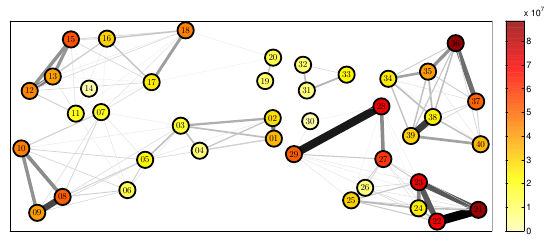
A stochastic model of social interaction in wild house mice
|
[2010]
|
|
Perony, Nicolas;
Koenig, Barbara;
Schweitzer, Frank
|
Proceedings of the European Conference on Complex Systems 2010
|
more» «less
|
Abstract
We investigate to what extent the interaction dynamics of a population of wild
house mouse (Mus musculus domesticus) in their environment can be explained
by a simple stochastic model. We use a Markov chain model to describe the transitions
of mice in a discrete space of nestboxes, and implement a multi-agent simulation of the
model. We find that some important features of our behavioural dataset can be
reproduced using this simplified stochastic representation, and discuss
the improvements that could be made to our model in order to increase the accuracy
of its predictions. Our findings have implications for the understanding of the
complexity underlying social behaviour in the animal kingdom and the cognitive
requirements of such behaviour.

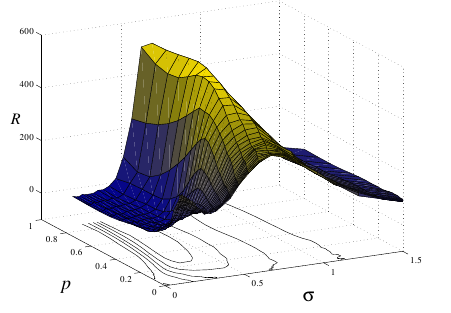
Diversity-induced resonance in a model for opinion formation
|
[2009]
|
|
Tessone, Claudio Juan;
Toral, Raul
|
The European Physical Journal B,
pages: 549-- 555,
volume: 71,
number: 4
|
more» «less
|
Abstract
We study an opinion formation model that takes into account that individuals have diverse preferences when forming their opinion regarding a particular issue. We show that the system exhibits a phenomenon called "diversity-induced resonance"[Tessone et al. Phys. Rev. Lett. 97, 194101 (2006)], by which an external influence (for example advertising, or fashion trends) is better followed by populations having the right degree of diversity in their preferences, rather than others where the individuals are identical or have too different preferences. We support our findings by numerical simulations of the model and a mean-field type analytical theory.

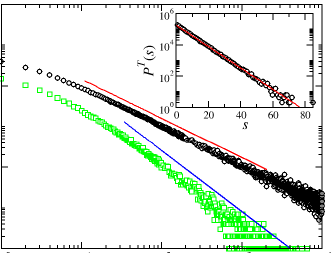
Critical behaviour in an evolutionary ultimatum game with social structure
|
[2009]
|
|
Eguiluz, Victor M.;
Tessone, Claudio Juan
|
ACS - Advances in Complex Systems,
pages: 221-- 232,
volume: 12,
number: 2
|
more» «less
|
Abstract
Experimental studies have shown the ubiquity of altruistic behavior in human societies. The social structure is a fundamental ingredient to understand the degree of altruism displayed by the members of a society, in contrast to individual-based features, like for example age or gender, which have been shown not to be relevant to determine the level of altruistic behavior. We explore an evolutionary model aiming to delve how altruistic behavior is affected by social structure. We investigate the dynamics of interacting individuals playing the Ultimatum Game with their neighbors given by a social network of interaction. We show that a population self-organizes in a critical state where the degree of altruism depends on the topology characterizing the social structure. In general, individuals offering large shares but in turn accepting large shares, are removed from the population. In heterogeneous social networks, individuals offering intermediate shares are strongly selected in contrast to random homogeneous networks where a broad range of offers, below a critical one, is similarly present in the population.
Editorial: Complex networks
|
[2009]
|
|
Scalas, Enrico;
Schweitzer, Frank
|
ACS - Advances in Complex Systems,
pages: 1,
volume: 12,
number: 01
|
more» «less
|
Abstract
This topical issue features regular submissions to Advances in Complex Systems focusing on ‘Complex Networks’ from different perspectives. They have been selected by the editors to appear together in this issue, to highlight current research trends.
‘Complex Networks’ is a booming research area for quite a few years now. Since the work of Watts and Strogatz on ‘small world networks’ published in 1998 (a paper for which Google Scholar lists 7417 citations as of 14th February 2009), a networkmania has exploded in many applied fields of science. This led to the rediscovery of various results already present in the mathematical literature on graphs. However, the increasing interest on networks also led to the rediscovery of some gems in sociology, including the work of Granovetter on social networks already published in 1973.
Today, research on complex networks has expanded to various branches of science, ranging from biology to transportation, from economics to linguistics. Hence, it is becoming a truly interdisciplinary endeavor. It is worth noticing that the research in these areas is increasingly driven by available data, in addition to extending theoretical concepts to characterize these networks.


From Graph Theory to Models of Economic Networks. A Tutorial
|
[2009]
|
|
Koenig, Michael D;
Battiston, Stefano
|
Networks, Topology and Dynamics: Theory and Applications to Economics and Social Systems
|
more» «less
|
Abstract
Networks play an important role in a wide range of economic phenomena. Despite this fact, standard economic theory rarely considers economic networks explicitly in its analysis. However, a major innovation in economic theory has been the use of methods stemming from graph theory to describe and study relations between economic agents in networks. This recent development has lead to a fast increase in theoretical research on economic networks. In this tutorial, we introduce the reader to some basic concepts used in a wide range of models of economic networks.

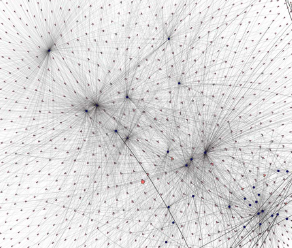
Backbone of complex networks of corporations: The flow of control
|
[2009]
|
|
Glattfelder, James B.;
Battiston, Stefano
|
Physical Review E,
pages: 36104,
volume: 80,
number: 3
|
more» «less
|
Abstract
We present a methodology to extract the backbone of complex networks based on the weight and direction of links, as well as on non-topological properties of nodes. We show how the methodology can be applied in general to networks in which mass or energy is flowing along the links. In particular, the procedure enables us to address important questions in economics, namely, how control and wealth are structured and concentrated across national markets. We report on the first cross-country investigation of ownership networks, focusing on the stock markets of 48 countries around the world. On the one hand, our analysis confirms results expected on the basis of the literature on corporate control, namely, that in Anglo-Saxon countries control tends to be dispersed among numerous shareholders. On the other hand, it also reveals that in the same countries, control is found to be highly concentrated at the global level, namely, lying in the hands of very few important shareholders. Interestingly, the exact opposite is observed for European countries. These results have previously not been reported as they are not observable without the kind of network analysis developed here.


How groups can foster consensus: The case of local cultures
|
[2009]
|
|
Groeber, Patrick;
Schweitzer, Frank;
Press, Kerstin
|
Journal of Aritifical Societies and Social Simulation,
pages: 1-- 22,
volume: 12,
number: 2
|
more» «less
|
Abstract
A local culture denotes a commonly shared behaviour within a cluster of firms. Similar to social norms or conventions, it is an emergent feature resulting from the firms' interaction in an economic network. To model these dynamics, we consider a distributed agent population, representing e.g. firms or individuals. Further, we build on a continuous opinion dynamics model with bounded confidence ($ epsilon$), which assumes that two agents only interact if differences in their behaviour are less than $ epsilon$. Interaction results in more similarity of behaviour, i.e. convergence towards a common mean. This framework is extended by two major concepts: (i) The agent's in-group consisting of acquainted interaction partners is explicitly taken into account. This leads to an effective agent behaviour reflecting that agents try to continue to interact with past partners and thus to keep sufficiently close to them. (ii) The in-group network structure changes over time, as agents can form new links to other agents with sufficiently close effective behaviour or delete links to agents no longer close in behaviour. Thus, our model provides a feedback mechanism between the agents' behaviour and their in-group structure. Studying its consequences by means of agent-based computer simulations, we find that for narrow-minded agents (low $ epsilon$) the additional feedback helps to find consensus more often, whereas for open-minded agents (high $ epsilon$) this does not hold. This counterintuitive result is explained by simulations of the network evolution.
Economic Networks: What do we know and What do we need to know?
|
[2009]
|
|
Schweitzer, Frank;
Fagiolo, Giorgio;
Sornette, Didier;
Vega - Redondo, Fernando;
White, Douglas R.
|
Advances in Complex Systems,
pages: 407-- 422,
volume: 12,
number: 04
|
more» «less
|
Abstract
We examine the emergent field of economic networks and explore its ability to shed light on the global and volatile economy where credit, ownership, innovation, invest-ment, and virtually every other economic activity is carried at a scale and scope that respects no geographical, organizational, or political boundaries. In this context, the study of economic networks and their dynamics must reflect the vast complexity of the interaction patterns and integrate it with a realistic account of the incentives and information that govern agents’ behavior. The interplay of both has been shown to pro-duce metastabilities, system crashes, and emergent structures in ways that are yet only poorly understood. Meeting this exciting scientific challenge requires a combination of time-series analysis, complexity theory, and simulation with the analytical tools that have been developed by game theory, as well as graph and matrix theories. We argue that this will help achieving a better integration of theory and data models and provide a better understanding of the potentials and risks of modern economic systems.

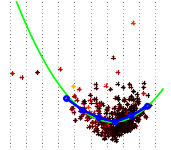
Universality in movie rating distributions
|
[2009]
|
|
Lorenz, Jan
|
The European Physical Journal B,
pages: 251-- 258,
volume: 71,
number: 2
|
more» «less
|
Abstract
In this paper histograms of user ratings for movies (1,...,10) are analysed. The evolving stabilised shapes of histograms follow the rule that all are either double-or triple-peaked. Moreover, at most one peak can be on the central bins 2,...,9 and the distribution in these bins looks smooth `Gaussian-like’ while changes at the extremes (1 and 10) often look abrupt. It is shown that this is well approximated under the assumption that histograms are confined and discretised probability density functions of L'evy skew $α$-stable distributions. These distributions are the only stable distributions which could emerge due to a generalized central limit theorem from averaging of various independent random variables as which one can see the initial opinions of users. Averaging is also an appropriate assumption about the social process which underlies the process of continuous opinion formation. Surprisingly, not the normal distribution achieves the best fit over histograms observed on the web, but distributions with fat tails which decay as power-laws with exponent –(1 + $α$) . The scale and skewness parameters of the L'evy skew $α$-stable distributions seem to depend on the deviation from an average movie (with mean about 7.6). The histogram of such an average movie has no skewness and is the most narrow one. If a movie deviates from average the distribution gets broader and skew. The skewness pronounces the deviation. This is used to construct a one parameter fit which gives some evidence of universality in processes of continuous opinion dynamics about taste.

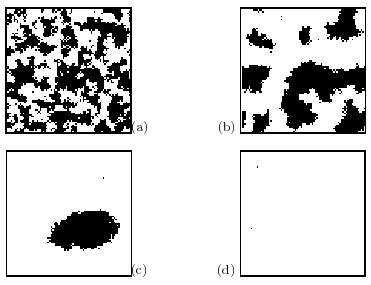
Nonlinear voter models: The transition from invasion to coexistence
|
[2009]
|
|
Schweitzer, Frank;
Behera, Laxmidhar
|
The European Physical Journal B,
pages: 301-- 318,
volume: 67,
number: 3
|
more» «less
|
Abstract
In nonlinear voter models the transitions between two states depend in a nonlinear manner on the frequencies of these states in the neighborhood. We investigate the role of these nonlinearities on the global outcome of the dynamics for a homogeneous network where each node is connected to $m = 4$ neighbors. The paper unfolds in two directions. We first develop a general stochastic framework for frequency dependent processes from which we derive the macroscopic dynamics for key variables, such as global frequencies and correlations. Explicite expressions for both the mean-field limit and the pair approximation are obtained. We then apply these equations to determine a phase diagram in the parameter space that distinguishes between different dynamic regimes. The pair approximation allows us to identify three regimes for nonlinear voter models: (i) complete invasion, (ii) random coexistence, and-- most interestingly-- (iii) correlated coexistence. These findings are contrasted with predictions from the mean-field phase diagram and are confirmed by extensive computer simulations of the microscopic dynamics.

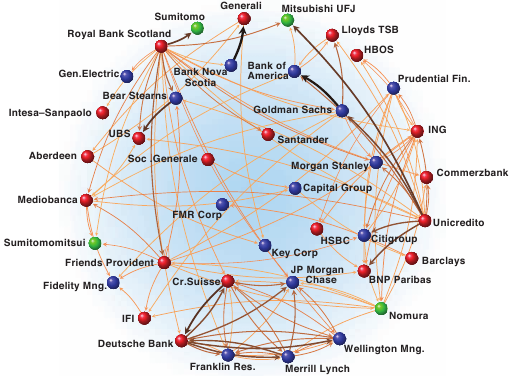
Economic networks: The new challenges
|
[2009]
|
|
Schweitzer, Frank;
Fagiolo, Giorgio;
Sornette, Didier;
Vega - Redondo, Fernando;
Vespignani, Alessandro;
White, Douglas R.
|
Science (New York, N.Y.),
pages: 422-- 425,
volume: 325,
number: 5939
|
more» «less
|
Abstract
The current economic crisis illustrates a critical need for new and fundamental understanding of the structure and dynamics of economic networks. Economic systems are increasingly built on interdependencies, implemented through trans-national credit and investment networks, trade relations, or supply chains that have proven difficult to predict and control. We need, therefore, an approach that stresses the systemic complexity of economic networks and that can be used to revise and extend established paradigms in economic theory. This will facilitate the design of policies that reduce conflicts between individual interests and global efficiency, as well as reduce the risk of global failure by making economic networks more robust.


Impact of aging on the evolution of cooperation in the spatial prisoner's dilemma game
|
[2009]
|
|
Szolnoki, Attila;
Perc, Matjaz;
Szabo, Gyoergy;
Stark, Hans Ulrich
|
Physical Review E,
pages: 1-- 7,
volume: 80,
number: 2
|
more» «less
|
Abstract
Aging is always present, tailoring our interactions with others, and postulating a finite lifespan during which we are able to exercise them. We consider the prisoner’s dilemma game on a square lattice and examine how quenched age distributions and different aging protocols influence the evolution of cooperation when taking the life experience and knowledge accumulation into account as time passes. In agreement with previous studies, we find that a quenched assignment of age to players, introducing heterogeneity to the game, substantially promotes cooperative behavior. Introduction of aging and subsequent death as a coevolutionary process may act detrimental on cooperation but enhances it efficiently if the offspring of individuals that have successfully passed their strategy is considered newborn. We study resulting age distributions of players and show that the heterogeneity is vital—yet insufficient—for explaining the observed differences in cooperator abundance on the spatial grid. The unexpected increment of cooperation levels can be explained by a dynamical effect that has a highly selective impact on the propagation of cooperator and defector states.

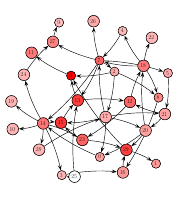
Modeling evolving innovation networks
|
[2009]
|
|
Koenig, Michael D;
Battiston, Stefano;
Schweitzer, Frank
|
Innovation Networks . New Approaches in Modelling and Analyzing
|
more» «less
|
Abstract
We develop a new framework for modeling innovation networks which evolve over time. The nodes in the network represent firms, whereas the directed links represent unilateral interactions between the firms. Both nodes and links evolve according to their own dynamics and on different time scales. The model assumes that firms produce knowledge based on the knowledge exchange with other firms, which involves both costs and benefits for the participating firms. In order to increase their knowledge production, firms follow different strategies to create and/or to delete links with other firms. Dependent on the information firms take into account for their decision, we find the emergence of different network structures. We analyze the conditions for the existence of these structures within a mathematical approach and underpin our findings by extensive computer simulations which show the evolution of the networks and their equilibrium state. In the discussion of the results, particular attention is given to the emergence of direct and indirect reciprocity in knowledge exchange, which refers to the emergence of cycles in the network structure. In order to motivate our modeling framework, in the first part of the chapter we give a broad overview of existing literature from economics and physics. This shows that our framework bridges and extends two different lines of research, namely the study of equilibrium networks with simple topologies and the dynamic approach of hypercycle models.

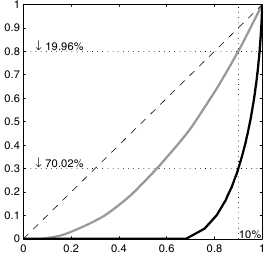
Software change dynamics: Evidence from 35 Java projects
|
[2009]
|
|
Geipel, Markus Michael;
Schweitzer, Frank
|
Proceedings of the the 7th joint meeting of the European software engineering conference and the ACM SIGSOFT symposium on The foundations of software engineering
|
more» «less
|
Abstract
In this paper we investigate the relationship between class dependency and change propagation in Java software. By analyzing 35 large Open Source Java projects, we find that in the majority of the projects more than half of the dependencies are never involved in change propagation. Furthermore, our analysis shows that only a few dependencies are transmitting the majority of change propagation events. An additional analysis reveals that this concentration cannot be explained by the different ages of the dependencies. The conclusion is that the dependency structure alone is a poor measure for the change dynamics. This contrasts with current literature.
Editorial: The complex systems section of EPJ B
|
[2009]
|
|
Schweitzer, Frank
|
The European Physical Journal B,
pages: 269-- 270,
volume: 67,
number: 3
|
more» «less
|
Abstract
EPJ B now receives more than 1000 submissions per year, and accounting for almost half of these, the ‘Complex Systems’ section has become popular to a degree where we are proud to offer you for the first time a regular issue of the journal containing original papers only from this area. They were not specially submitted for this issue, but instead were all recently accepted and selected from among our growing set of regular submissions from the fields of statistical, nonlinear and interdisciplinary physics.


Personalised and Dynamic Trust in Social Networks
|
[2009]
|
|
Walter, Frank Edward;
Battiston, Stefano;
Schweitzer, Frank
|
Proceedings of the third ACM conference on Recommender systems,
pages: 197-- 204
|
more» «less
|
Abstract
We propose a novel trust metric for social networks which is suitable for application in recommender systems. It is personalised and dynamic and allows to compute the indirect trust between two agents which are not neighbours based on the direct trust between agents that are neighbours. In analogy to some personalised versions of PageRank, this metric makes use of the concept of feedback centrality and overcomes some of the limitations of other trust metrics.In particular, it does not neglect cycles and other patterns characterising social networks, as some other algorithms do. In order to apply the metric to recommender systems, we propose a way to make trust dynamic over time. We show by means of analytical approximations and computer simulations that the metric has the desired properties. Finally, we carry out an empirical validation on a dataset crawled from an Internet community and compare the performance of a recommender system using our metric to one using collaborative filtering.

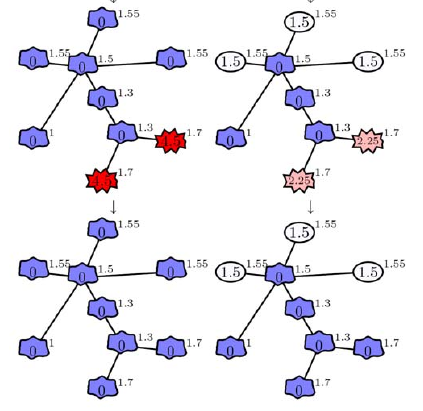
Systemic risk in a unifying framework for cascading processes on networks
|
[2009]
|
|
Lorenz, Jan;
Battiston, Stefano;
Schweitzer, Frank
|
The European Physical Journal B,
pages: 441-- 460,
volume: 71,
number: 4
|
more» «less
|
Abstract
We introduce a general framework for models of cascade and contagion processes on networks, to identify their commonalities and differences. In particular, models of social and financial cascades, as well as the fiber bundle model, the voter model, and models of epidemic spreading are recovered as special cases. To unify their description, we define the net fragility of a node, which is the difference between its fragility and the threshold that determines its failure. Nodes fail if their net fragility grows above zero and their failure increases the fragility of neighbouring nodes, thus possibly triggering a cascade. In this framework, we identify three classes depending on the way the fragility of a node is increased by the failure of a neighbour. At the microscopic level, we illustrate with specific examples how the failure spreading pattern varies with the node triggering the cascade, depending on its position in the network and its degree. At the macroscopic level, systemic risk is measured as the final fraction of failed nodes, X∗,and for each of the three classes we derive a recursive equation to compute its value. The phase diagram of X∗ as a function of the initial conditions, thus allows for a prediction of the systemic risk as well as a comparison of the three different model classes. We could identify which model class leads to a first-order phase transition in systemic risk, i.e. situations where small changes in the initial conditions determine a global failure. Eventually, we generalize our framework to encompass stochastic contagion models. This indicates the potential for further generalizations.


A complementary view on the growth of directory trees
|
[2009]
|
|
Geipel, Markus Michael;
Tessone, Claudio Juan;
Schweitzer, Frank
|
The European Physical Journal B,
pages: 641-- 648,
volume: 71,
number: 4
|
more» «less
|
Abstract
Trees are a special sub-class of networks with unique properties, such as the level distribution which has often been overlooked.We analyse a general tree growth model proposed by Klemm et al. [Phys. Rev. Lett. 95, 128701 (2005)] to explain the growth of user-generated directory structures in computers. The model has a single parameter q which interpolates between preferential attachment and random growth. Our analysis results in three contributions: first, we propose a more efficient estimation method for q based on the degree distribution, which is one specific representation of the model. Next, we introduce the concept of a level distribution and analytically solve the model for this representation. This allows for an alternative and independent measure of q.We argue that, to capture real growth processes, the q estimations from the degree and the level distributions should coincide. Thus, we finally apply both representations to validate the model with synthetically generated tree structures, as well as with collected data of user directories. In the case of real directory structures, we show that q measured from the level distribution are incompatible with q measured from the degree distribution. In contrast to this, we find perfect agreement in the case of simulated data. Thus, we conclude that the model is an incomplete description of the growth of real directory structures as it fails to reproduce the level distribution. This insight can be generalised to point out the importance of the level distribution for modeling tree growth.
Editorial: Risk, markets, games, and networks
|
[2009]
|
|
Schweitzer, Frank;
Battiston, Stefano;
Tessone, Claudio Juan
|
The European Physical Journal B,
pages: 439-- 440,
volume: 71,
number: 4
|
more» «less
|
Abstract
The 20 research articles collected in this issue share, in addition to their topical relations, one important feature: they present results obtained from research groups associated in the COST action P10 ‘Physics of Risk’. COST is an intergovernmental framework for ‘European Cooperation in Science and Technology’, allowing the coordination of research on a European level. The action P10 was funded between September 2003 and June 2008 and involved more than 80 scientists in 21 countries across Europe. The main objective of the action was to apply methods developed in statistical physics to accomplish a new quantitative understanding of the assessment of risk. This way it departed from usual activities in the field of risk management. In fact, in recent years statistical physics has successfully contributed to many interdisciplinary fields ranging from regulatory networks in biology to financial market models. Therefore, a transfer of methods and tools from statistical physics into the area of risk assessment should be a promising endeavour.
Decelerating microdynamics can accelerate macrodynamics in the voter model
|
[2008]
|
|
Tessone, Claudio Juan;
Schweitzer, Frank
|
Physical Review Letters,
pages: 1-- 4,
volume: 101,
number: 1
|
more» «less
|
Abstract
For the voter model, we study the effect of a memory-dependent transition rate. We assume that the transition of a spin into the opposite state decreases with the time it has been in its current state. Counterintuitively, we find that the time to reach a macroscopically ordered state can be accelerated by slowing down the microscopic dynamics in this way. This holds for different network topologies, including fully connected ones. We find that the ordering dynamics is governed by two competing processes which either stabilize the majority or the minority state. If the first one dominates, it accelerates the ordering of the system. The conclusions of this Letter are not restricted to the voter model, but remain valid to many other spin systems as well.

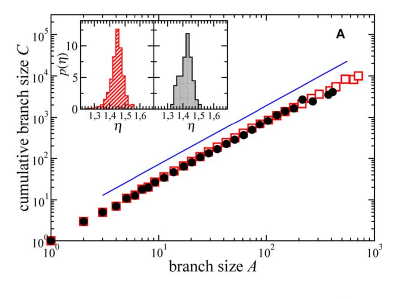
Universal scaling in the branching of the tree of life
|
[2008]
|
|
Herrada, E Alejandro;
Tessone, Claudio Juan;
Klemm, Konstantin;
Eguiluz, Victor M.;
Hernandez - Garcia, Emilio;
Duarte, Carlos M
|
PLOS ONE,
pages: e2757,
volume: 3,
number: 7
|
more» «less
|
Abstract
Understanding the patterns and processes of diversification of life in the planet is a key challenge of science. The Tree of Life represents such diversification processes through the evolutionary relationships among the different taxa, and can be extended down to intra-specific relationships. Here we examine the topological properties of a large set of interspecific and intraspecific phylogenies and show that the branching patterns follow allometric rules conserved across the different levels in the Tree of Life, all significantly departing from those expected from the standard null models. The finding of non-random universal patterns of phylogenetic differentiation suggests that similar evolutionary forces drive diversification across the broad range of scales, from macro-evolutionary to micro-evolutionary processes, shaping the diversity of life on the planet.

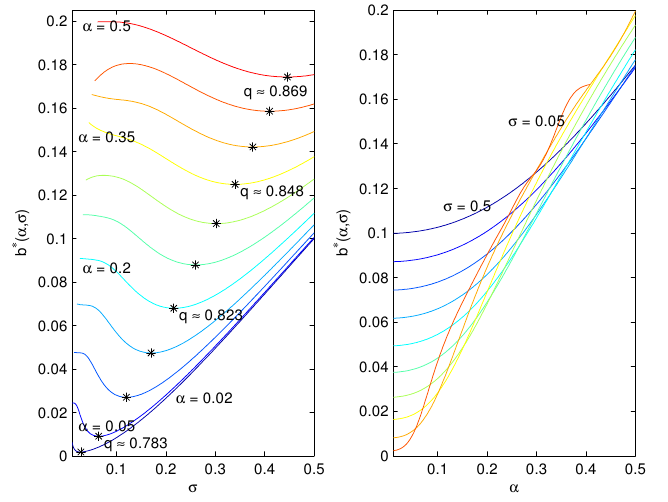
Systemic risk in a network fragility model analyzed with probability density evolution of persistent random walks
|
[2008]
|
|
Lorenz, Jan;
Battiston, Stefano
|
Networks and Heterogeneous Media,
pages: 185,
volume: 3,
number: 2
|
more» «less
|
Abstract
We study the mean field approximation of a recent model of cascades on networks relevant to the investigation of systemic risk control in financial networks. In the model, the hypothesis of a trend reinforcement in the stochastic process describing the fragility of the nodes, induces a trade-off in the systemic risk with respect to the density of the network. Increasing the average link density, the network is first less exposed to systemic risk, while above an intermediate value the systemic risk increases. This result offers a simple explanation for the emergence of instabilities in financial systems that get increasingly interwoven. In this paper, we study the dynamics of the probability density function of the average fragility. This converges to a unique stable distribution which can be computed numerically and can be used to estimate the systemic risk as a function of the parameters of the model.

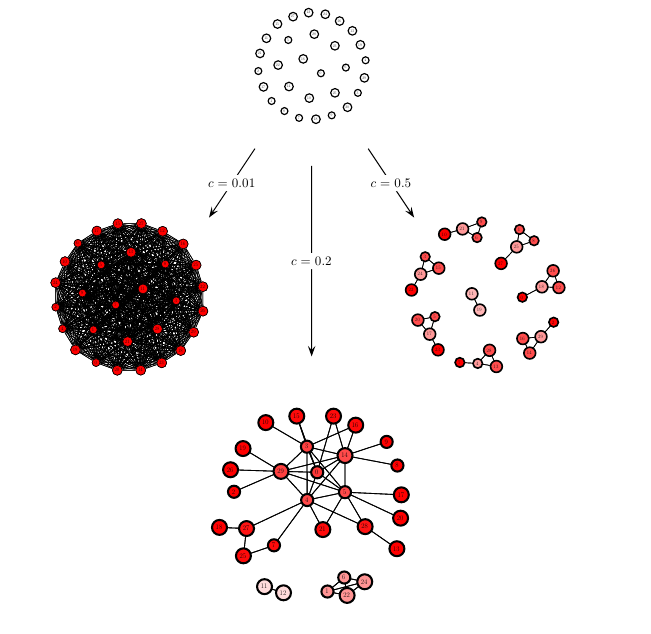
On Algebraic Graph Theory and the Dynamics of Innovation Networks
|
[2008]
|
|
Koenig, Michael D;
Battiston, Stefano;
Napoletano, Mauro;
Schweitzer, Frank
|
Networks and Heterogeneous Media,
pages: 201-- 219,
volume: 3,
number: 2
|
more» «less
|
Abstract
We investigate some of the properties and extensions of a dynamic innovation network model recently introduced in [Koenig et al. Games and Eco. Beh. 75-2 p694-p713 (2012)]. In the model, the set of efficient graphs ranges, depending on the cost for maintaining a link, from the complete graph to the (quasi-) star, varying within a well defined class of graphs. However, the interplay between dynamics on the nodes and topology of the network leads to equilibrium networks which are typically not efficient and are characterized, as observed in empirical studies of R&D networks, by sparseness, presence of clusters and heterogeneity of degree. In this paper, we analyze the relation between the growth rate of the knowledge stock of the agents from R&D collaborations and the properties of the adjacency matrix associated with the network of collaborations. By means of computer simulations we further investigate how the equilibrium network is affected by increasing the evaluation time $ tau$ over which agents evaluate whether to maintain a link or not. We show that only if $ tau$ is long enough, efficient networks can be obtained by the selfish link formation process of agents, otherwise the equilibrium network is inefficient. This work should assist in building a theoretical framework of R&D networks from which policies can be derived that aim at fostering efficient innovation networks.
A Model of a Trust-based Recommendation System in a Social Network
|
[2008]
|
|
Walter, Frank Edward;
Battiston, Stefano;
Schweitzer, Frank
|
JAAMAS,
pages: 57-- 74,
volume: 16,
number: 1
|
more» «less
|
Abstract
In this paper, we present a model of a trust-based recommendation system on a social network. The idea of the model is that agents use their social network to reach information and their trust relationships to filter it. We investigate how the dynamics of trust among agents affect the performance of the system by comparing it to a frequency-based recommendation system. Furthermore, we identify the impact of network density, preference heterogeneity among agents, and knowledge sparseness to be crucial factors for the performance of the system. The system self-organises in a state with performance near to the optimum; the performance on the global level is an emergent property of the system, achieved without explicit coordination from the local interactions of agents.

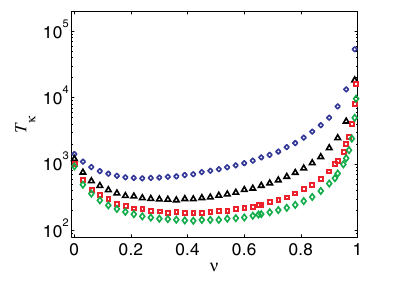
Slower is faster: Fostering consensus formation by heterogeneous interia
|
[2008]
|
|
Tessone, Claudio Juan;
Schweitzer, Frank
|
ACS - Advances in Complex Systems,
pages: 551-563,
volume: 11,
number: 4
|
more» «less
|
Abstract
We investigate an extension of the voter model in which voters are equipped with an individual inertia to change their opinion. This inertia depends on the persistence time of a voter's current opinion (ageing). We focus on the case of only two different inertia values: zero if a voter just changed towards a new opinion and nu otherwise. We are interested in the average time to reach consensus, i.e. the state in which all voters have adopted the same opinion. Adding inertia to the system means to slow down the dynamics at the voter's level, which should presumably lead to a slower consensus formation. As an unexpected outcome of our inertial voter dynamics, there is a parameter region of nu where an increasing inertia leads to a faster consensus formation. These results rest on the heterogeneity of voters which evolves through the described ageing. In a control setting of homogeneous inertia values, we only find monotonously increasing consensus times. In the paper, we present dynamical equations for the mean-field case which allow for analytical insight into the observed slower-is-faster effect.
Managing Complexity: Insights, Concepts, Applications
|
[2008]
|
|
Battiston, Stefano;
Delli Gatti, Domenico;
Gallegati, Mauro
|
|
|
more» «less
|
Abstract
In this chapter, we present a model recently introduced in [14, 16] and we discuss the features of a networked economy in which N firms are organised in M production levels. Each firm at a certain level is supplied by a subset of firms in the upper level (suppliers) and supplies a subset of the firms in the lower level (customers). The bottom level consists of retailers, i.e., firms that sell in the consumer market. The top level consists of firms that provide primary goods to the other firms. Firms are connected by means of two mech-anisms: (i) the output of supplier firms is an input for customer firms; (ii) supplier firms extend trade credit to customers (as it is typically the case in reality). However, in the model, the trade credit contract is only implicitly sketched: we neither design the optimal trade credit scheme nor look for the optimal amount of trade credit a customer firm should require. Instead, we focus on the mechanisms of propagation of bankruptcy .
Alternating cooperation strategies in a route choice game: Theory, experiments, and effects of a learning scenario
|
[2008]
|
|
Stark, Hans Ulrich;
Helbing, Dirk;
Schoenhof, Martin;
Holyst, Janusz A.
|
Games, Rationality, and Behaviour
|
more» «less
|
Abstract
In this paper, we present experimental investigations on a day-to-day route choice scenario. Here, the equilibrium outcome is, according to real traffic observations, fair (equal for all users) but induces an inefficient usage of network capacity. Optimal usage would be characterized by some users winning and some losing in comparison to the equilibrium state. Coherent alternating cooperation strategies can be a suitable solution but they require innovation and group coordination in addition to cooperativeness. In these points, our work differs considerably from other contributions observing the emergence of cooperation in social dilemmas. By classifying the two-person variant of our experiments among the symmetrical 2x2 games we show the situation of the Route Choice Game not to not addressed by the literature so far. Although the equilibrium outcome in this setup is “strongly stable”, in our experiments we find eminent empirical evidence of alternating cooperation and, thereby, observed persistent utilization of the system optimum that is not profitable for all individuals. The transition to this optimal configuration can be well described by quantitative considerations that are presented in the paper. Furthermore, the straight success of a learning scenario indicates that the collective innovation of alternating strategies may be the most critical challenge to the individuals instead of just learning to be cooperative. Presumably, this also holds for other social dilemma situations.


Are Output Growth-Rate Distributions Fat-Tailed? Some Evidence from OECD Countries
|
[2008]
|
|
Fagiolo, Giorgio;
Roventini, Andrea;
Napoletano, Mauro
|
Journal of Applied Econometrics,
pages: 639-- 669,
volume: 23
|
more» «less
|
Abstract
This work explores some distributional properties of aggregate output growth-rate time series. We show that, in the majority of OECD countries, output growth-rate distributions are well-approximated by symmetric exponential-power densities with tails much fatter than those of a Gaussian. Fat tails robustly emerge in output growth rates independently of: (i) the way we measure aggregate output; (ii) the family of densities employed in the estimation; (iii) the length of time lags used to compute growth rates. We also show that fat tails still characterize output growth-rate distributions even after one washes away outliers, autocorrelation and heteroscedasticity.

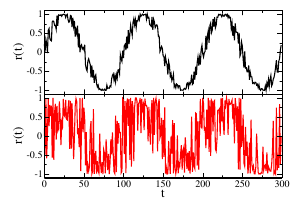
Risk-seeking versus risk-avoiding investments in noisy periodic environments
|
[2008]
|
|
Navarro - Barrientos, Jesus Emeterio;
Walter, Frank Edward;
Schweitzer, Frank
|
International Journal of Modern Physics C,
pages: 971-- 994,
volume: 19,
number: 6
|
more» «less
|
Abstract
We study the performance of various agent strategies in an artificial investment scenario. Agents are equipped with a budget, x(t), and at each time step invest a particular fraction, q(t), of their budget. The return on investment (RoI), r(t), is characterized by a periodic function with different types and levels of noise. Risk-avoiding agents choose their fraction q(t) proportional to the expected positive RoI, while risk-seeking agents always choose a maximum value qmax if they predict the RoI to be positive (“everything on red”). In addition to these different strategies, agents have different capabilities to predict the future r(t), dependent on their internal complexity. Here, we compare “zero-intelligent” agents using technical analysis (such as moving least squares) with agents using reinforcement learning or genetic algorithms to predict r(t). The performance of agents is measured by their average budget growth after a certain number of time steps. We present results of extensive computer simulations, which show that, for our given artificial environment, (i) the risk-seeking strategy outperforms the risk-avoiding one, and (ii) the genetic algorithm was able to find this optimal strategy itself, and thus outperforms other prediction approaches considered.


Investments in random environments
|
[2008]
|
|
Navarro - Barrientos, Jesus Emeterio;
Cantero, Ruben;
Rodrigues, Joao F.;
Schweitzer, Frank
|
Physica A,
pages: 2035-- 2046,
volume: 387,
number: 8-9
|
more» «less
|
Abstract
We present analytical investigations of a multiplicative stochastic process that models a simple investor dynamics in a random environment. The dynamics of the investor's budget, $x(t)$, depends on the stochasticity of the return on investment, $r(t)$, for which different model assumptions are discussed. The fat-tail distribution of the budget is investigated and compared with theoretical predictions. Weare mainly interested in the most probable value $x_mp$ of the budget that reaches a constant value over time. Based on an analytical investigation of the dynamics, we are able to predict $x_mp^stat$. We find a scaling law that relates the most probable value to the characteristic parameters describing the stochastic process. Our analytical results are confirmed by stochastic computer simulations that show a very good agreement with the predictions.

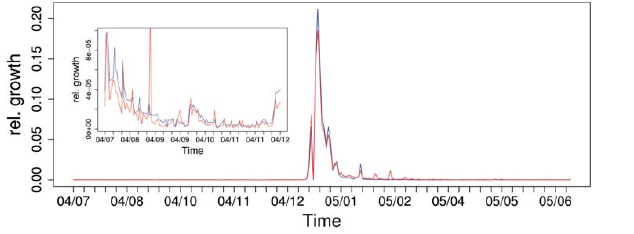
The epidemics of donations: Logistic growth and power-laws.
|
[2008]
|
|
Schweitzer, Frank;
Mach, Robert
|
PLOS ONE,
pages: e1458,
volume: 3,
number: 1
|
more» «less
|
Abstract
This paper demonstrates that collective social dynamics resulting from individual donations can be well described by an epidemic model. It captures the herding behavior in donations as a non-local interaction between individual via a time-dependent mean field representing the mass media. Our study is based on the statistical analysis of a unique dataset obtained before and after the tsunami disaster of 2004. We find a power-law behavior for the distributions of donations with similar exponents for different countries. Even more remarkably, we show that these exponents are the same before and after the tsunami, which accounts for some kind of universal behavior in donations independent of the actual event. We further show that the time-dependent change of both the number and the total amount of donations after the tsunami follows a logistic growth equation. As a new element, a time-dependent scaling factor appears in this equation which accounts for the growing lack of public interest after the disaster. The results of the model are underpinned by the data analysis and thus also allow for a quantification of the media influence.

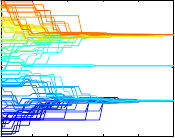
Opinion dynamics: The effect of the number of peers met at once
|
[2008]
|
|
Urbig, Diemo;
Lorenz, Jan
|
Journal of Artificial Societies and Social Simulation,
pages: 1-- 27,
volume: 11,
number: 2 4
|
more» «less
|
Abstract
The opinion dynamics model introduced by Deffuant and Weisbuch as well as the one by Hegselmann and Krause are rather similar. In both models individuals are assumed to have opinions about an issue, they meet and discuss, and they may adapt their opinions towards the other agents` opinions or may ignore each other if their positions are too different. Both models differ with respect to the number of peers they meet at once. Furthermore the model by Deffuant and Weisbuch has a convergence parameter that controls how fast agents adapt their opinions. By defining the reversed parameter as self-support we can extend the applicability of this parameter to scenarios with more than one interaction partner. We investigate the effects of changing the number of peers met at once, which is done for different population sizes, and the effects of changing the self-support. For describing the dynamics we look at different statistics, i.e. number of cluster, number of major clusters, and Gini coefficient.

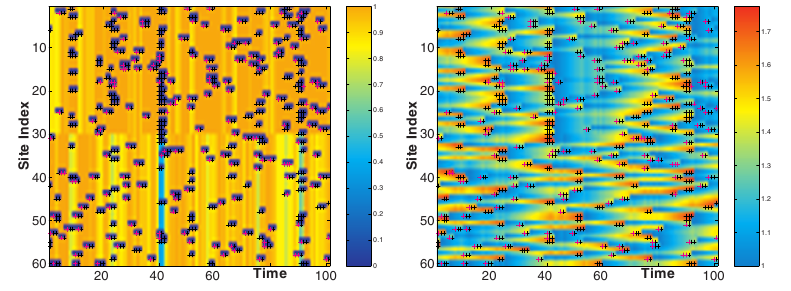
Trade Credit Networks and systemic risk
|
[2008]
|
|
Battiston, Stefano;
Delli Gatti, Domenico;
Gallegati, Mauro
|
Understanding Complex Systems,
pages: 219-- 239,
volume: 2008
|
more» «less
|
Abstract
In this chapter, we present a model recently introduced in [14, 16] and we discuss the features of a networked economy in which N firms are organised in M production levels. Each firm at a certain level is supplied by a subset of firms in the upper level (suppliers) and supplies a subset of the firms in the lower level (customers). The bottom level consists of retailers, i.e., firms that sell in the consumer market. The top level consists of firms that provide primary goods to the other firms. Firms are connected by means of two mech-anisms: (i) the output of supplier firms is an input for customer firms; (ii) supplier firms extend trade credit to customers (as it is typically the case in reality). However, in the model, the trade credit contract is only implicitly sketched: we neither design the optimal trade credit scheme nor look for the optimal amount of trade credit a customer firm should require. Instead, we focus on the mechanisms of propagation of bankruptcy .

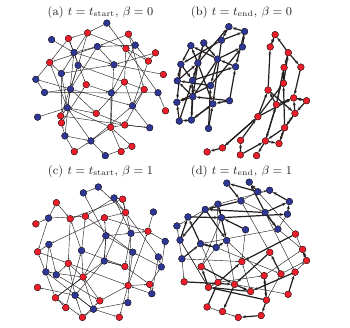
Coping with information overload through trust-based networks
|
[2008]
|
|
Walter, Frank Edward;
Battiston, Stefano;
Schweitzer, Frank
|
Managing Complexity: Insights, concepts, Applications
|
more» «less
|
Abstract
Over the recent decade, the Internet has conquered people’s homes and life: they pursue an increasing amount of activities on the World Wide Web and this has fundamentally impacted the lifestyle of society. For example, people use their computers for communication with others, to buy and sell products on-line, to search for information, and to carry out many more tasks. Along this development, so far unknown ways of marketing, trading and information sharing are booming. This situation is made possible by a set of related emerging technologies centred around the Internet – just to mention a few: collaborative work and information sharing environments, peer-to-peer networks, and rating, recommendation, and reputation systems. At the economic level, the impact of these technologies is already very high and it is expected to grow even more in the future. The Internet has become a social network, “linking people, organisations, and knowledge” [2] and it has taken the role of a platform on which people pursue an increasing amount of tasks that they have usually only done in the real-world. An approach looking at these emerging technologies and their effects from a complex systems perspective can, as wewill show in this chapter, be very useful.

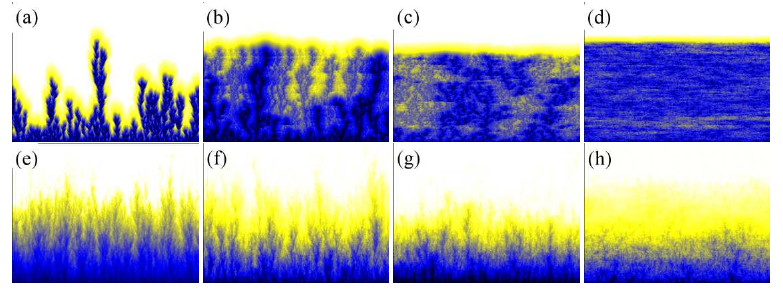
Chaotic synchronizations of spatially extended systems as nonequilibrium phase transitions.
|
[2008]
|
|
Cencini, Massimo;
Tessone, Claudio Juan;
Tornell, Aaron
|
Chaos (Woodbury, N.Y.),
pages: 037125,
volume: 18,
number: 3
|
more» «less
|
Abstract
Two replicas of spatially extended chaotic systems synchronize to a common spatio-temporal chaotic state when coupled above a critical strength. As a prototype of each single spatio-temporal chaotic system a lattice of maps interacting via power-law coupling is considered. Furthermore, each unit in the one-dimensional chain is linked to the corresponding one in the replica via a local coupling. The synchronization transition is studied as a nonequilibrium phase transition, and its critical properties are analyzed at varying the spatial interaction range as well as the nonlinearity of the dynamical units composing each system. In particular, continuous and discontinuous local maps are considered. In both cases the transitions are of the second order with critical indices varying with the exponent characterizing the interaction range. For discontinuous maps it is numerically shown that the transition belongs to the anomalous directed percolation (ADP) family of universality classes, previously identified for Levy-flight spreading of epidemic processes. For continuous maps, the critical exponents are different from those characterizing ADP, but apart from the nearest-neighbor case, the identification of the corresponding universality classes remains an open problem. Finally, to test the influence of deterministic correlations for the studied synchronization transitions, the chaotic dynamical evolutions are substituted by suitable stochastic models. In this framework and for the discontinuous case, it is possible to derive an effective Langevin description that corresponds to that proposed for ADP.

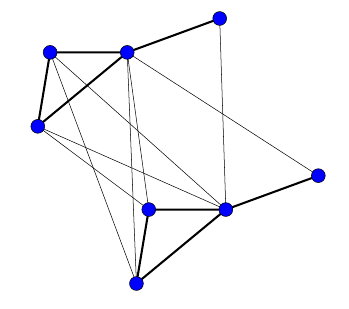
Global firing induced by network disorder in ensembles of active rotators
|
[2008]
|
|
Tessone, Claudio Juan;
Zanette, Damian H.;
Toral, Raul
|
The European Physical Journal B,
pages: 319-- 326,
volume: 62,
number: 3
|
more» «less
|
Abstract
We study the influence of repulsive interactions on an ensemble of coupled excitable rotators. We find that a moderate fraction of repulsive interactions can trigger global firing of the ensemble. The regime of global firing, however, is suppressed in sufficiently large systems if the network of repulsive interactions is fully random, due to self-averaging in its degree distribution. We thus introduce a model of partially random networks with a broad degree distribution, where self-averaging due to size growth is absent. In this case, the regime of global firing persists for large sizes. Our results extend previous work on the constructive effects of diversity in the collective dynamics of complex systems.

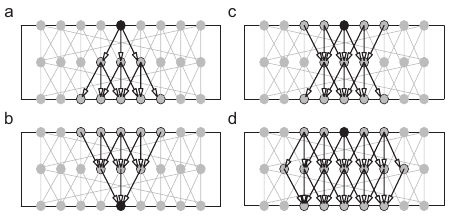
Credit chains and bankruptcy propagation in production networks
|
[2007]
|
|
Battiston, Stefano;
Delli Gatti, Domenico;
Gallegati, Mauro;
Greenwald, Bruce;
Stiglitz, Joseph E.
|
Journal of Economic Dynamics and Control,
pages: 2061-- 2084,
volume: 31,
number: 6
|
more» «less
|
Abstract
We present a simple model of a production network in which firms are linked by supplier–customer relationships involving extension of trade–credit. Our aim is to identify the minimal set of mechanisms which reproduce qualitatively the main stylized facts of industrial demography, such as firms’ size distribution, and, at the same time, the correlation, over time and across firms, of output, growth and bankruptcies. The behavior of aggregate variables can be traced back to the direct firm–firm interdependence. In this paper, we assume that the number of firms is constant and the network has a periodic static structure. But the framework allows further extensions to investigate which network structures are more robust against domino effects and, if the network is let to evolve in time, which structures emerge spontaneously, depending on the individual strategies for orders and delivery.

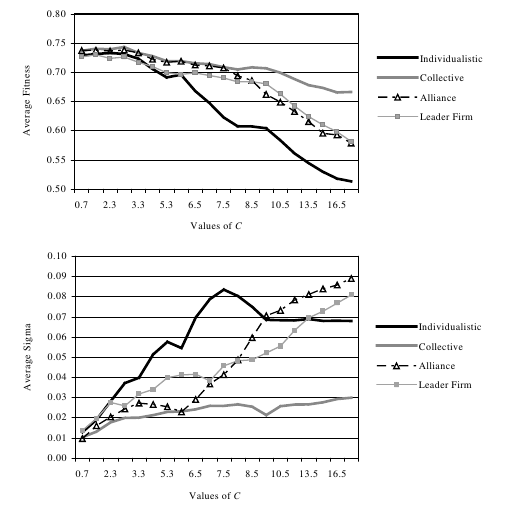
Divide and conquer? The role of governance for the adaptability of industrial districts
|
[2007]
|
|
Press, Kerstin
|
ACS - Advances in Complex Systems,
pages: 73-- 92,
volume: 10,
number: 1
|
more» «less
|
Abstract
This paper develops a simulation model of the behavior of industrial districts in the face of changes in their environment. By applying Kauffman's N/K-C model to the question of optimum governance in industrial districts facing an external shock, the paper sheds light on the optimum co-ordination mechanism among agents in interdependent industrial networks. Simulation results indicate that collective governance structures with agents adjusting for the sake of the district as a whole perform best in adaptation, whereas individualistic governance modes deliver the worst results. Alliance and leader firm governance forms position themselves in-between these two extremes. However, both modes of governance can be preferable to the collective one if the observation and punishment mechanisms in the district's local culture are not strong enough to impose solidarity among its agents. In this case, a prisoner's dilemma emerges and the collective governance form is replaced by the inferior individualistic one. Through these results, the model highlights the link between governance and district adaptability. It provides an explanation for the trend in Italian districts towards more hierarchical governance structures. Moreover, the identification of the role played by governance structure for district adaptability in changing environments could serve as guidance for future research.

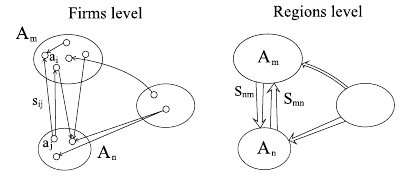
The Network of Inter-regional Direct Investment Stocks across Europe
|
[2007]
|
|
Battiston, Stefano;
Rodrigues, Joao F.;
Zeytinoglu, Hamza
|
ACS - Advances in Complex Systems,
pages: 29-- 51,
volume: 10,
number: 1
|
more» «less
|
Abstract
We propose a methodological framework to study the dynamics of inter-regional investment flow in Europe from a Complex Networks perspective, an approach with recent proven success in many fields including economics. In this work we study the network of investment stocks in Europe at two different levels: first, we compute the inward-outward investment stocks at the level of firms, based on ownership shares and number of employees; then we estimate the inward-outward investment stock at the level of regions in Europe, by aggregating the ownership network of firms, based on their headquarter location. Despite the intuitive value of this approach for EU policy making in economic development, to our knowledge there are no similar works in the literature yet. In this paper we focus on statistical distributions and scaling laws of activity, investment stock and connectivity degree both at the level of firms and at the level of regions. In particular we find that investment stock of firms is power law distributed with an exponent very close to the one found for firm activity. On the other hand investment stock and activity of regions turn out to be log-normal distributed. At both levels we find scaling laws relating investment to activity and connectivity. In particular, we find that investment stock scales with connectivity in a similar way as has been previously found for stock market data, calling for further investigations on a possible general scaling law holding true in economical networks.

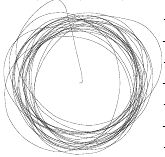
Modeling vortex swarming in daphnia
|
[2007]
|
|
Mach, Robert ;
Schweitzer, Frank
|
Bulletin of mathematical biology,
pages: 539-- 562,
volume: 69,
number: 2
|
more» «less
|
Abstract
Based on experimental observations in Daphnia, we introduce an agent-based model for the motion of single and swarms of animals. Each agent is described by a stochastic equation that also considers the conditions for active biological motion. An environmental potential further reflects local conditions for Daphnia, such as attraction to light sources. This model is sufficient to describe the observed cycling behavior of single Daphnia. To simulate vortex swarming of many Daphnia, i.e. the collective rotation of the swarm in one direction, we extend the model by considering avoidance of collisions. Two different ansatzes to model such a behavior are developed and compared. By means of computer simulations of a multi-agent system we show that local avoidance-as a special form of asymmetric repulsion between animals-leads to the emergence of a vortex swarm. The transition from uncorrelated rotation of single agents to the vortex swarming as a function of the swarm size is investigated. Eventually, some evidence of avoidance behavior in Daphnia is provided by comparing experimental and simulation results for two animals.


The nature of production and organisation An N/K model of modularity, (dis)integration and performance
|
[2007]
|
|
Press, Kerstin;
Geipel, Markus Michael;
Schweitzer, Frank
|
Druid: appropriability, proximity, routines and innovation
|
more» «less
|
Abstract
This paper investigates the link between product modularity and (dis)integration. A theoretic model benchmarks relative performance of (dis)integration for different degrees of modularity. As in existing work, (nearly) modular production processes befit disintegration while non-modular ones require integration. However, modularity and disintegration only lead to greater product differentiation if there is competition. Empirical evidence is then used to investigate, whether the link between product modularity and disintegration is encompassing or whether a role for some large, integrated firms (systems integrators) remains. This aspect is found to depend on the type of industry studied.

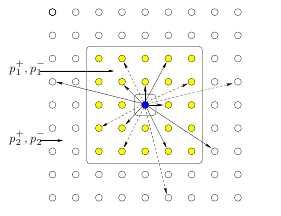
Coexistence of social norms based on in-and out-group interactions
|
[2007]
|
|
Groeber, Patrick;
Fent, Thomas;
Schweitzer, Frank
|
ACS - Advances in Complex Systems,
pages: 271-- 286,
volume: 10,
number: 2
|
more» «less
|
Abstract
The question how social norms can emerge from microscopic interactions between individuals is a key problem in social sciences to explain collective behavior. In this paper we propose an agent-based model to show that randomly distributed social behavior by way of local interaction converges to a state with a multimodal distribution of behavior. This can be interpreted as a coexistence of different social norms, a result that goes beyond previous investigations. The model is discrete in time and space, behavior is characterized in a continuous state space. The adaptation of social behavior by each agent is based on attractive and repulsive forces caused by friendly and adversary relations among agents. The model is analyzed both analytically and by means of spatio-temporal computer simulations. It provides conditions under which we find convergence towards a single norm, coexistence of two opposing norms, and coexistence of a multitude of norms. For the latter case, we also show the evolution of the spatio-temporal distribution of behavior.

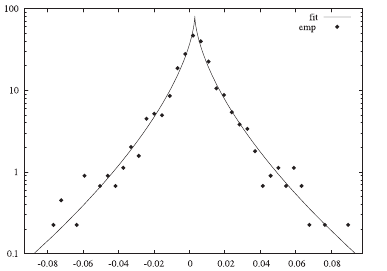
How do output growth-rate distributions look like? Some cross-country, time-series evidence
|
[2007]
|
|
Fagiolo, Giorgio;
Napoletano, Mauro;
Roventini, Andrea
|
The European Physical Journal B,
pages: 205-- 211,
volume: 57,
number: 2
|
more» «less
|
Abstract
This paper investigates the statistical properties of within-country gross domestic product (GDP) and industrial production (IP) growth-rate distributions. Many empirical contributions have re-cently pointed out that cross-section growth rates of firms, industries and countries all follow Laplace distributions. In this work, we test whether also within-country, time-series GDP and IP growth rates can be approximated by tent-shaped distributions. We fit output growth rates with the exponential-power (Subbotin) family of densities, which includes as particular cases both Gaussian and Laplace distributions. We find that, for a large number of OECD (Organization for Economic Cooperation and Development) countries including the US, both GDP and IP growth rates are Laplace distributed. Moreover, we show that fat-tailed distributions robustly emerge even after controlling for outliers, autocorrelation and het-eroscedasticity.

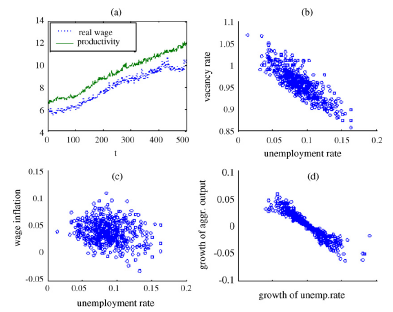
Industrial dynamics, fiscal policy and R&D: Evidence from a computational experiment
|
[2007]
|
|
Russo, A.;
Catalano, M.;
Gaffeo, E.;
Gallegati, Mauro;
Napoletano, Mauro
|
Journal of Economic Behavior & Organization,
pages: 426-- 447,
volume: 64,
number: 3-4
|
more» «less
|
Abstract
We present an agent-based computational model in which bounded rational firms and workers trade on fully decentralized markets for final goods and labor by means of random matching protocols. The model replicates several macroeconomic phenomena regularly observed in the data, with aggregate features emerging from the localized interactions of individual entities. The model is then used as a computational laboratory to run an experiment on the role of fiscal policy in increasing macroeconomic performance.
Review of Biology, Sociology, Geology by Computational Physicists (Monograph Series on Nonlinear Science and Complexity)
|
[2007]
|
|
Schweitzer, Frank;
Geipel, Markus Michael
|
JASSS-The Journal of artificial societes and social simulation,
volume: 10,
number: 1
|
more» «less
|

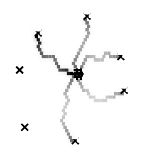
Multi-agent approach to the self-organization of networks
|
[2007]
|
|
Schweitzer, Frank
|
Understanding and Managing Complex Agent-Based Dynamical Networks
|
more» «less
|
Abstract
Is it possible to link a set of nodes without using preexisting positional information or any kind of long-range attraction of the nodes? Can the process of generating positional information, i.e. the detection of ``unknown'' nodes and the estabishment of chemical gradients, \emph{and} the process of network formation, i.e. the establishment of links between nodes, occur in parallel, on a comparable time scale, as a process of co-evolution? The paper discusses a model where the generation of relevant information for establishing the links between nodes results from the interaction of many \emph{agents}, i.e. subunits of the system that are capable of performing some activities. Their collective interaction is based on (indirect) communication, which also includes memory effects and the dissemination of information in the system. The relevant (``pragmatic'') information that leads to the establishment of the links then emerges from an evolutionary interplay of selection and reamplification.

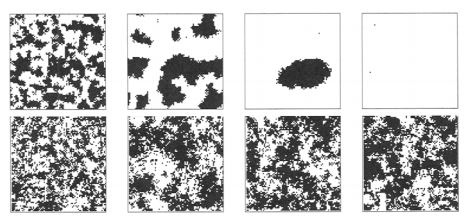
Collective decisions in multi-agent systems
|
[2007]
|
|
Schweitzer, Frank
|
Advancing Social Simulation: The First World Congress
|
more» «less
|
Abstract
Decision making, in a simple sense, means a selection among alternatives. It is one of the fundamental processes in economics but also in social systems. If these systems consist of many interacting elements — which we call agents here — the system dynamics may be described on two different levels: the microscopic level, where the decisions of the individual agents occur and the macroscopic level where a certain collective behavior can be observed.

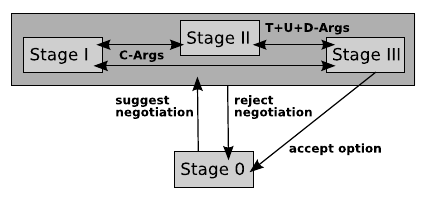
A generic framework for argumentation-based negotiation
|
[2007]
|
|
Geipel, Markus Michael;
Weiss, Gerhard
|
Lecture Notes in Computer Science,
pages: 209-- 223,
volume: 4676
|
more» «less
|
Abstract
Past years have witnessed a growing interest in automated negotiation as a coordination mechanism for interacting agents. This paper presents a generic, problem-and domain-independent frame-work for argumentation-based negotiation that covers both essential agent-internal and external components relevant to automated negotia-tion. This framework, called Negotiation Situation Specification Scheme (N3S), is both suited as a guideline for implementing negotiation sce-narios as well as integrating available approaches that address selective aspects of negotiation. In particular, N3S contributes to the state of the art in automated negotiation by identifying and relating basic argument types and negotiation stages in a structured and formal way.

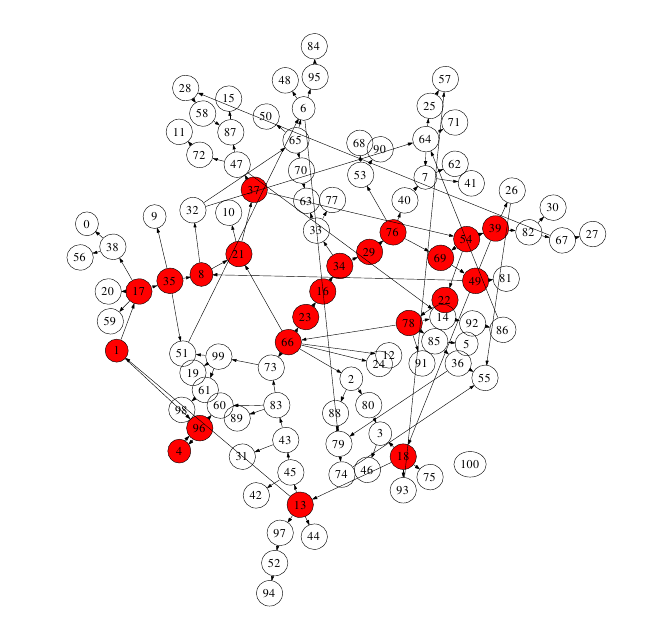
Aggregate dynamics in an evolutionary network model
|
[2007]
|
|
Seufert, A. M.;
Schweitzer, Frank
|
International Journal of Modern Physics C,
pages: 1659-- 1674,
volume: 18,
number: 10
|
more» «less
|
Abstract
We analyze a model of interacting agents (e.g. prebiotic chemical species) which are represented by nodes of a network, whereas their interactions are mapped onto directed links between these nodes. On a fast time scale, each agent follows an eigendynamics based on catalytic support from other nodes, whereas on a much slower time scale the network evolves through selection and mutation of its nodes-agent. In the first part of the paper, we explain the dynamics of the model by means of characteristic snapshots of the network evolution and confirm earlier findings on crashes and recoveries in the network structure. In the second part, we focus on the aggregate behavior of the network dynamics. We show that the disruptions in the network structure are smoothed out, so that the average evolution can be described by a growth regime followed by a satura-tion regime, without an initial random regime. For the saturation regime, we obtain a logarithmic scaling between the average connectivity per node ls and a parameter m, describing the average incoming connectivity, which is independent of the system size N.


From production networks to geographical economics
|
[2007]
|
|
Weisbuch, Gerard;
Battiston, Stefano
|
Journal of Economic Behavior and Organization,
pages: 448-- 469,
volume: 64,
number: 3-4
|
more» «less
|
Abstract
Although standard economics textbooks are seldom interested in production networks, modern economies are more and more based upon supplier/customer interactions.Onecan consider entire sectors of theeconomy as generalised supply chains.We will take this view in the present paper and study under which conditions local failures to produce or simply to deliver can result in avalanches of shortage and bankruptcies and in localisation of the economic activity.We will showthat a large class of models exhibit scale free distributions of production and wealth among firms and that regions of high production are localised.


Continuous opinion dynamics under bounded confidence: A survey
|
[2007]
|
|
Lorenz, Jan
|
International Journal of Modern Physics C,
pages: 1819-- 1838,
volume: 18,
number: 12
|
more» «less
|
Abstract
Models of continuous opinion dynamics under bounded confidence have been presented independently by Krause and Hegselmann and by Deffuant et al in 2000. They have raised a fair amount of attention in the communities of social simulation, sociophysics and complexity science. The researchers working on it come from disciplines as physics, mathematics, computer science, social psychology and philosophy. Agents hold continuous opinions which they can gradually adjust if they hear the opinions of others. The idea of bounded confidence is that agents only interact if they are close in opinion to each other. Usually, the models are analyzed with agent-based simulations in a Monte-Carlo style, but they can also be reformulated on the agent's density in the opinion space in a master-equation style. This paper is to present the agent-based and density-based modeling frameworks including the cases of multidimensional opinions and heterogeneous bounds of confidence; second, to give the bifurcation diagrams of cluster configuration in the homogeneous model with uniformly distributed initial opinions; third to review the several extensions and the evolving phenomena which have been studied so far; and fourth to state some basic open questions.


Emergence and Evolution of Coalitions in Buyer-Seller Networks
|
[2007]
|
|
Walter, Frank Edward;
Battiston, Stefano;
Schweitzer, Frank
|
Emergent Intelligence of Networked Agents
|
more» «less
|
Abstract
We investigate the dynamics of the creation, development, and breakup of social networks formed by coalitions of agents. As an application, we consider coalition formation in a consumer electronic market. In our model, agents have benefits and costs from establishing a social network by participating in a coalition. Buyers benefit in terms of volume discount and better match of their preferences. Sellers benefit in terms of better predictability of sales volumes. The model allows us to investigate the stability and size of the coalitions as well as the performance of the market in terms of utility of the agents. We find that the system exhibits three different dominating regimes: individual purchasing behaviour, i.e., no social network exists among the agents, formation of several heterogenous coalitions, i.e., a number of social networks which are not connected, as well as condensation to a giant coalition, i.e., a social network involving all agents.

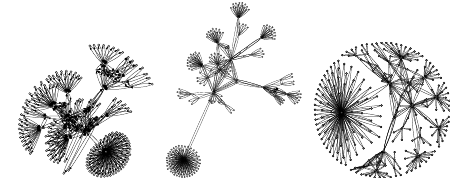
Self-organization applied to dynamic network layout
|
[2007]
|
|
Geipel, Markus Michael
|
International Journal of Modern Physics C,
pages: 1537-- 1549,
volume: 18,
number: 10
|
more» «less
|
Abstract
As networks and their structure have become a major field of research, a strong demand for network visualization has emerged. We address this challenge by formalizing the well established spring layout in terms of dynamic equations. We thus open up the design space for new algorithms. Drawing from the knowledge of systems design, we derive a layout algorithm that remedies several drawbacks of the original spring layout. This new algorithm relies on the balancing of two antagonistic forces. We thus call it $$em arf for "attractive and repulsive forces". It is, as we claim, particularly suited for a dynamic layout of smaller networks ($n < 10^3$). We back this claim with several application examples from on going complex systems research.


When does defection pay? The stability of institutional arrangements in clusters
|
[2007]
|
|
Press, Kerstin
|
Journal of Economic Interaction and Coordination,
pages: 67-- 84,
volume: 2,
number: 1
|
more» «less
|
Abstract
The present paper investigates cluster adjustment to changing economic environments by focussing on the role and stability of institutional arrangements in their local culture. It postulates two idealtypical local cultures where firms act in the common (collective) or in their own interest (egoistic). By comparing adjustment performance and stability for both types, the model finds that clusters in very volatile environments are unlikely to exhibit collective local cultures as these are unstable and provide only limited benefits for adjustment performance. Clusters facing more stable environments are more likely to show collective local cultures as these increase adjustment performance and are more stable against individual defection. Both findings suggest that collective local cultures in clusters can be relatively stable for limited environment volatility.
Konkurrenz, Selektion und Innovation in oekonomischen Systemen
|
[2006]
|
|
Schweitzer, Frank;
Gerald, Silverberg
|
Irreversible Prozesse und Selbstorganisation
|
more» «less
|
Abstract
Bereits in den 1970er Jahren hat Ebeling gezeigt, dass Modelle der praebiotischen Evolution auch zur Beschreibung oekonomischer Systeme herangezogen werden koennen. Insbesondere konnten aus der Formalisierung von oekonomischen Theorien (Mehrwerttheorie von Marx, Innovationsdynamik von Nelson und Winter) Gleichungen fuer die Konkurrenz von Produzenten bzw. Technologien hergeleitet werden. Diese Ergebnisse werden hier zusammengefasst und gewuerdigt. Im zweiten Teil des Aufsatzes diskutieren wir neuere Ansaetze, um Innovation und Selektion in oekonomischen Systemen zu modellieren-wohei die Beziehungen zu Netzwerken und zu biologischen Evolutionsmodellen im Vordergund stehen.
The skeleton of the Shareholders Networks
|
[2006]
|
|
Caldarelli, Guido;
Battiston, Stefano;
Garlaschelli, Diego;
Takayasu, Hideki
|
Practical Fruits of Econophysics
|
more» «less
|
Impact of Trust on the Performance of a Recommendation System in a Social Network
|
[2006]
|
|
Battiston, Stefano;
Walter, Frank Edward;
Schweitzer, Frank
|
Proceedings of the Workshop on Trust at the Fifth International Joint Conference on Autonomous Agents and Multi-Agent Systems (AAMAS'06)
|
more» «less
|
Abstract
Social agents naturally use their social and professional networks to filter information
by trustworthiness. In this paper, we present a model of an automated distributed recom-
mendation system on a social network and we investigate how the dynamics of trust among
agents affect the performance of the system. Agents search their social network for recom-
mendations on items to be consumed and the propagation of the query through agents at
several degrees of separation enhances the efficiency of their search. Moreover, agents have
heterogeneous preferences so that trust between neighbours can be used to filter information
coming from remote agents. We identify the range of the density of the network and the
degree of heterogeneity of agent preferences in which trust improves the performance of the
recommendation system.


Modelling smooth and uneven cross-sectoral growth patterns : An identification problem
|
[2006]
|
|
Napoletano, Mauro;
Roventini, Andrea;
Sapio, Sandro
|
Economics Bulletin,
pages: 1-- 8,
volume: 15,
number: 6
|
more» «less
|
Abstract
This paper shows that the available stylized facts on productivity dynamics, such as persistent cross-sectoral heterogeneity, do not allow to solve an identification problem regarding the impact of common drivers-such as General Purpose Technologies (GPTs)-on economic growth. The evidence of persistently heterogeneous productivity performances is consistent both with a GPT-driven model, and with a model characterized by purely independent and idiosyncratic sectoral dynamics. These results are obtained within a simple theoretical framework, and illustrated with reference to measures of concentration of the sectoral contributions to aggregate total factor productivity growth.

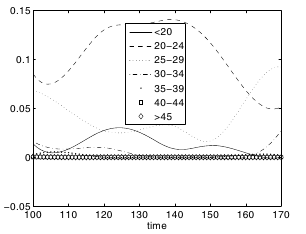
An agent-based simulation model of age-at-marriage norms
|
[2006]
|
|
Diaz, Belinda Aparicio;
Fent, Thomas
|
Agent-Based Computational Modelling: Applications in Demography, Social, Economic and Environmental Sciences
|
more» «less
|
Abstract
In this Chap. we analyse an agent-based model designed to understand the dynamics of the intergenerational transmission of age-at-marriage norms. A norm in this context is an acceptable age interval to get married. We assume that this age-interval is defined at the individual level and the individuals’ age-at-marriage norms are transmitted from parents to their children. We compare four different transmission mechanisms to investigate the long term persistence or disappearance of norms under different regimes of transmission. Our work is an extension of [4] that introduces a one-sex non-overlapping-generations version of an age-at-marriage model. Here we investigate whether their results also hold in a more complex setup. Therefore, we explicitly take into account heterogeneity with respect to age and sex. Moreover, we also include the timing of union formation and fertility into our model. To create a more realistic model of the evolution of age norms the characteristics of the agents are extended, some new parameters are added to the model and the age-at-marriage norms are split into two sex-specific age-at-marriage norms. A comparison of the results with those of the original model gives information about how additional characteristics and new parameters can influence the evolution of age-at-marriage norms.

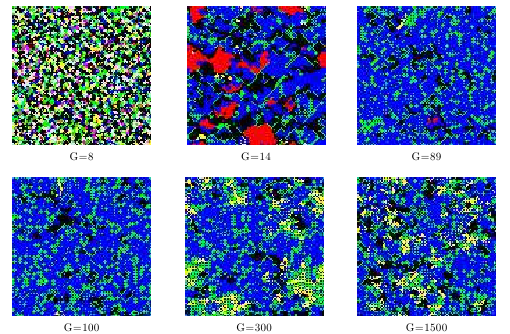
Agents with heterogeneous strategies interacting in a spatial IPD
|
[2005]
|
|
Schweitzer, Frank;
Mach, Robert ;
Heinz, Muehlenbein
|
Lecture Notes in Economics and Mathematical Systems
|
more» «less
|
Abstract
We use a spatial iterated Prisoner’s Dilemma game (IPD) to investigate the spatial-temporal evolution of heterogeneity in agents’ strategies. In our model, N agents are spatially distributed on a lattice and each agent is assumed to interact with her 4 local neighbors a number of ng times during each generation. If the agent has a one-step memory for the last action of each individual neighbor, this results in a total of eight different strategies for the game. After each generation, the agent will be replaced by an offspring that adopts the strategy of her most successful neighbor. The agents are heterogeneous in that they play different strategies dependent on (i) their past experience, (ii) their local neighborhood. The spatial-temporal distribution of these strategies is investigated by means of computer simulations on a cellular automaton. In particular, we study the incluence of ng on the dynamics of the global frequencies of the different strategies and the conditions for a stationary (frozen) or non-stationary (dynamic) coexistence of particular strategies on a spatial scale.

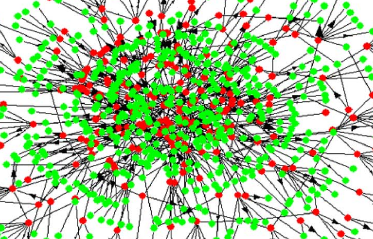
The scale-free topology of market investments
|
[2005]
|
|
Garlaschelli, Diego;
Battiston, Stefano;
Castri, Maurizio;
Servedio, Vito D. P.;
Caldarelli, Guido
|
Physica A: Statistical Mechanics and its Applications,
pages: 491-- 499,
volume: 350,
number: 2-4
|
more» «less
|
Abstract
We propose a network description of large market investments, where both stocks and shareholders are represented as vertices connected by weighted links corresponding to shareholdings. In this framework, the in-degree (kin) and the sum of incoming link weights (v) of an investor correspond to the number of assets held (portfolio diversification) and to the invested wealth (portfolio volume), respectively. An empirical analysis of three different real markets reveals that the distributions of both kin and v display power-law tails with exponents g and a: Moreover, we find that kin scales as a power-law function of v with an exponent b: Remarkably, despite the values of a; b and g differ across the three markets, they are always governed by the scaling relation b ¼ð1aÞ = ð1gÞ: We show that these empirical findings can be reproduced by a recent model relating the emergence of scale-free networks to an underlying Paretian distribution of ‘hidden’ vertex properties.

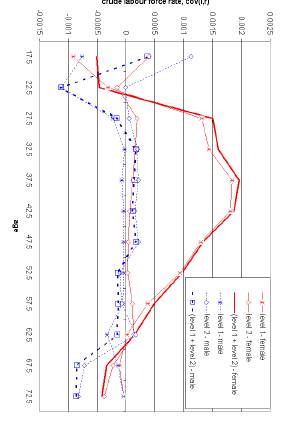
Decomposing the change in labour force indicators over time
|
[2005]
|
|
Prskawetz, Alexia;
Zagaglia, Barbara;
Fent, Thomas;
Skirbekk, Vegard
|
Demographic Research,
pages: 163-- 188,
volume: 13
|
more» «less
|
Abstract
In this paper we study changes in the size and the composition of the labour force in five selected OECD countries from 1983 through 2000. We apply a recent decomposition method to quantify the components of the change over time in the crude labour force rate and the mean age of the labour force. Our results show that the change in the crude labour force rate was dominated by the change in age-specific labour force participation rates. For the mean age of the labour force we find that for males the change in the age composition of the population predominately explains the overall change while the results for females are less clear-cut.
|























































































































































































































































































































































































































































































































































































































































































































































































































































































































































































